Poon Hill Trek: The Ultimate Guide
Poon Hill Trek is a short and classic one at the heart of Annapurna Sanctuary. But it offers magnificent mountain views along with a peek into Gurung culture.
The brief and easy trekking to Poon Hill is an excellent option for people who have a short time but desire to have an exclusive experience of the Himalayas. This trek is ideal for novice trekkers, especially for those with no prior experience in the foothills of the Himalayas.
Unlike most of the short treks , Poon Hill rewards you with the picturesque mountain vistas including Dhaulagiri, Nilgiri, Annapurna South, Annapurna I, Hiunchuli, Machhapuchhre, Lamjung Himal as well as Manaslu.
Poon Hill is considered one of the best viewpoints in the entire Annapurna region. The sunrise and sunset over the snow-capped massifs from atop Poon Hill is one of the best sights in the whole trek.
The tiny village of Ghandruk is another highlight of Poon Hill Trek. Famous for the warm hospitality of the locals and cultural insight of the town, Ghandruk is the second largest Gurung village in Nepal.
Table of Content

Highlights of Poon Hill Trek
- Visit the marvelous city of Pokhara.
- Relish the amphitheater-like view of the picturesque mountains, including Annapurna, Machhapuchhre, and Dhaulagiri.
- Explore the traditional Gurung village at Ghandruk and indulge in their rich culture.
- Traverse through the Himalayan trail decorated with crimson rhododendron.
- An easy and comfortable trek in the Annapurna Sanctuary.
Poon Hill Trek Facts
Getting there and away, start of the trek:.
The most popular option among some alternatives to starting Poon Hill Trek is to drive from Pokhara to Nayapul. The condition of the road to Nayapul is decent, compared to other outskirts of Nepal. The entire drive covers a total distance of 45.5 kilometers and takes around two hours.
As per your preference, you can either ride a local bus or a private car, taxi, or van to reach Nayapul. The local transportations are scheduled to leave every hour from Baglung Bus Park in Pokhara, and a public bus will charge you as little as US$ 2 per person.
If you choose to hire a taxi or van, it’ll cost you about US$ 35, but the drive will be relatively faster and comfortable.
End of the Trek:
Most of the trekkers conclude this trek with a drive from Ghandruk to Pokhara. You can catch a local bus or a local van from the Ghandruk Bus Stop. The cost of a local bus from Ghandruk to Pokhara is US$ 5 per person.
You can also take a local van from Ghandruk to Pokhara. The local van costs you around US$ 8 to 10 each person as per the number of passengers.
Alternative Route for Poon Hill Trek
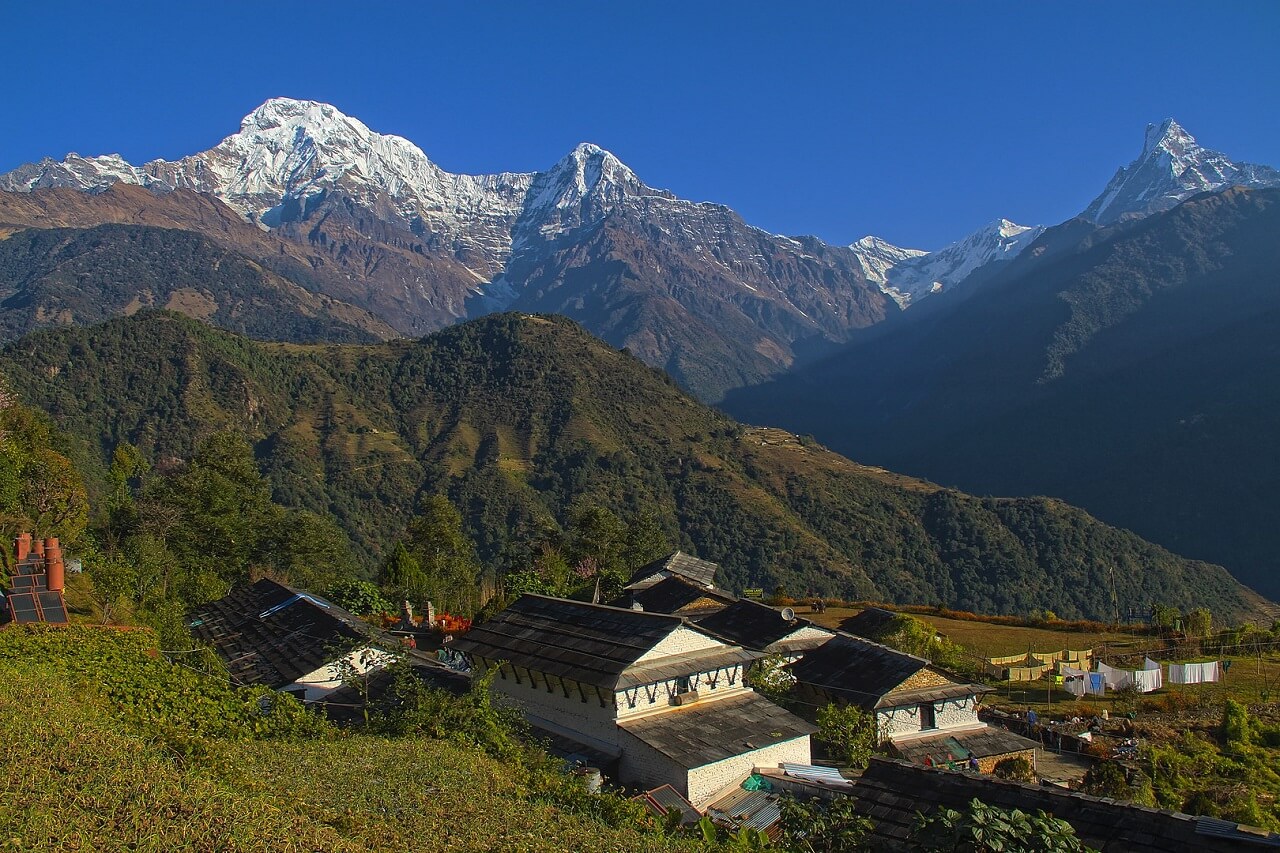
Ghandruk to Nayapul – 40km
This alternative option to Poon Hill follows the reversed route to that of the standard itinerary. On this route, you begin the adventure with a 3-hour drive from Pokhara to Ghandruk. You’ll trek through famous settlements like Tadapani and Ghorepani towards Poon Hill.
Furthermore, you descend via Ulleri towards Nayapul to end the trek. This route covers a total distance of 40km.
Nayapul to Kimche – 44km
If you take this route, you’ll follow the entire standard itinerary and walk to Kimche from Ghandruk instead of driving. This additional 4km is the only variation on this route option.
The trek begins with a drive to Nayapul then passes through the village of Ulleri and Ghorepani to arrive at Poon Hill. Then, the trail descends to Ghandruk via Tadapani and further leads to Kimche to end the trek.
Poon Hill Trek Outline Itinerary
Poon hill trek detailed itinerary, day 1: drive from pokhara to nayapul (1,070m) and trek to tikhedhunga.
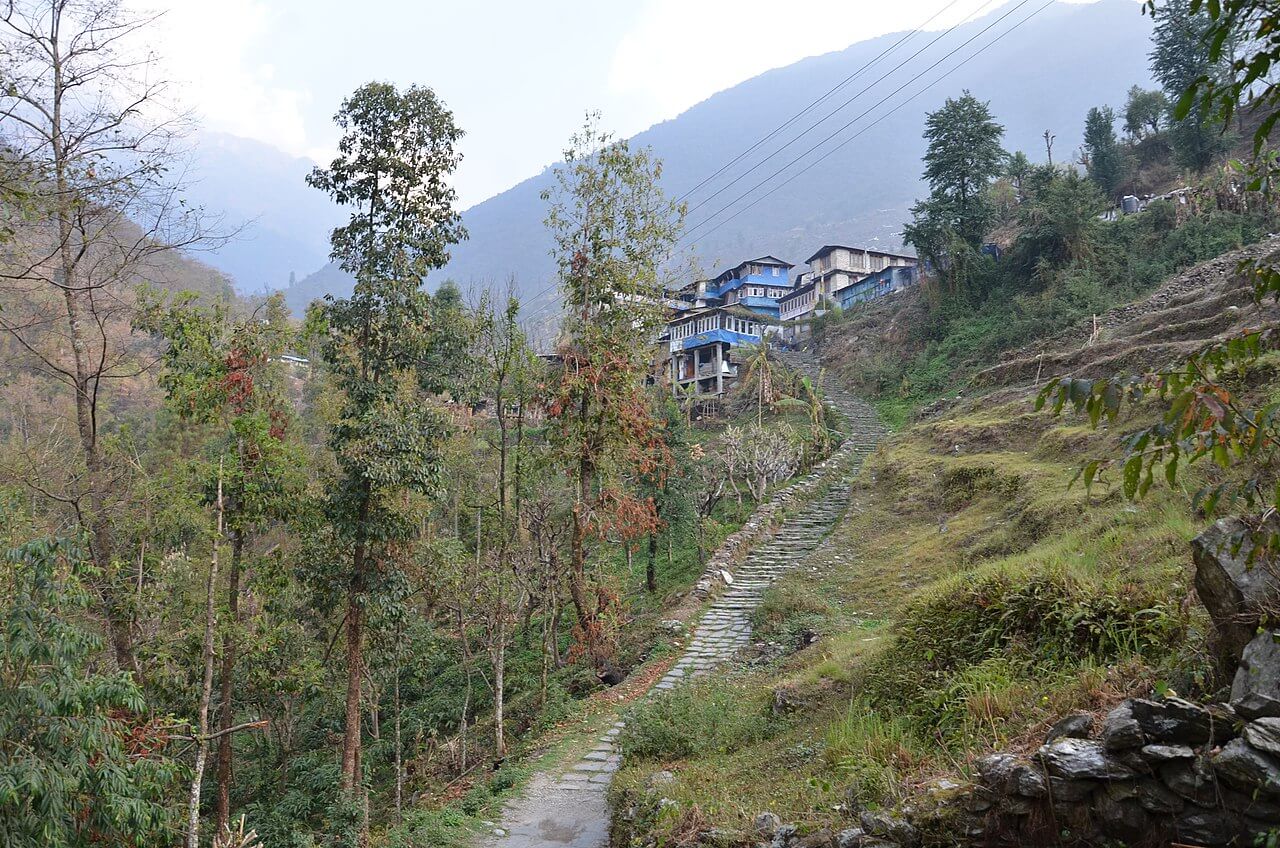
Begin the adventure with a 2-hour drive from the city of Pokhara to Nayapul. However, the bus ride may take slightly more time than expected. You can catch local buses every hour from Baglung Bus Park or can also take a local van to Nayapul.
The condition of the road is rough and twisted. Upon reaching Nayapul, you’ll start trekking through the small settlement alongside Modi Khola to Birethanti. Further, you climb through the rural villages to Tikhedhunga.
Day 2: Trek from Tikhedhunga to Ghorepani
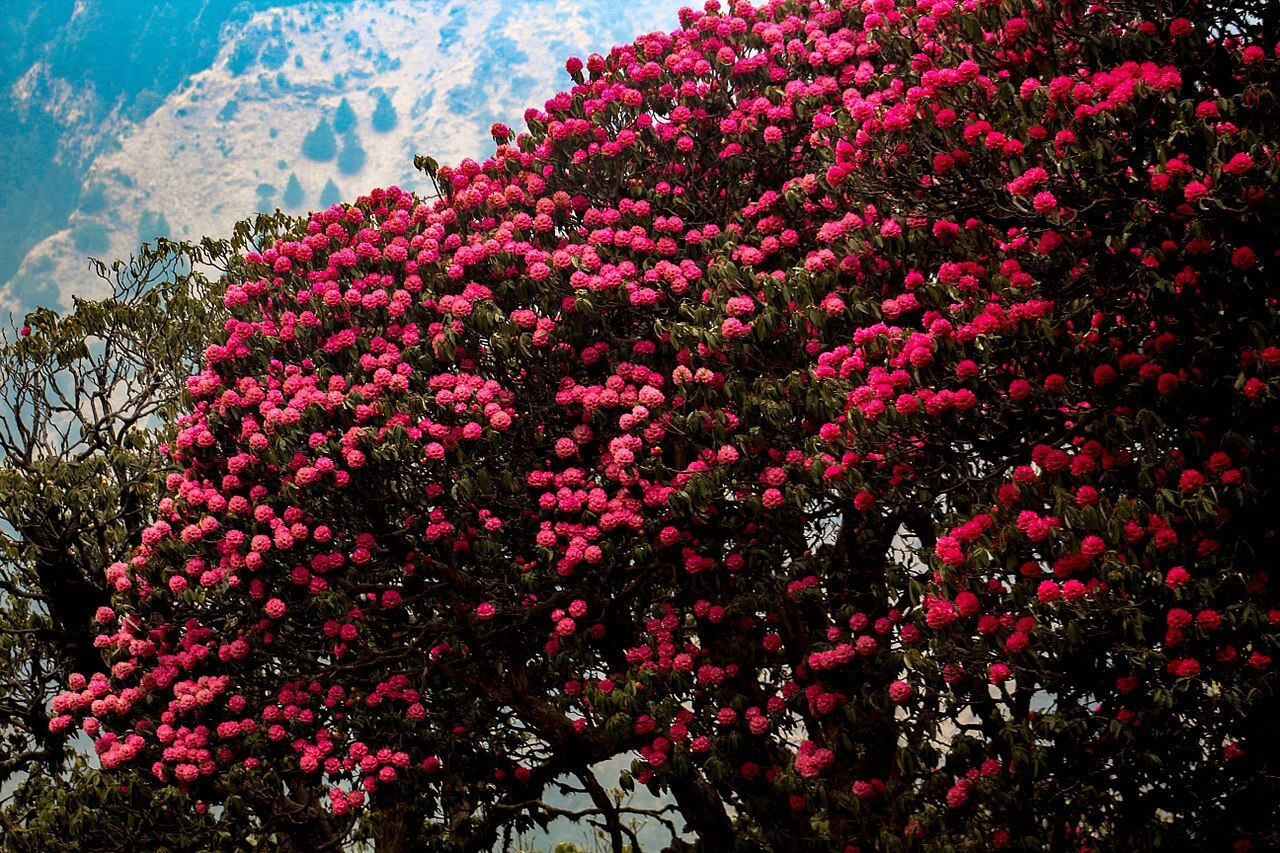
The trail is short but strenuous so start your day early in the morning. The day begins with a steep uphill from Tikhedhunga towards Ulleri. The trail leads to the dense forest passing small waterfalls, rivers, and villages.
After passing Ulleri, the trail is mostly gradual through the shades of rhododendron, pine, and oak trees. At Ghorepani, there’s a small checkpoint where they inspect your TIMS card and ACAP Permit. The temperature is not extremely cold in Ghorepani, but it is more windy and chilly compared to Tikhedhunga.
Day 3: Hike to Poon Hill (3,210m) and Trek to Tadapani
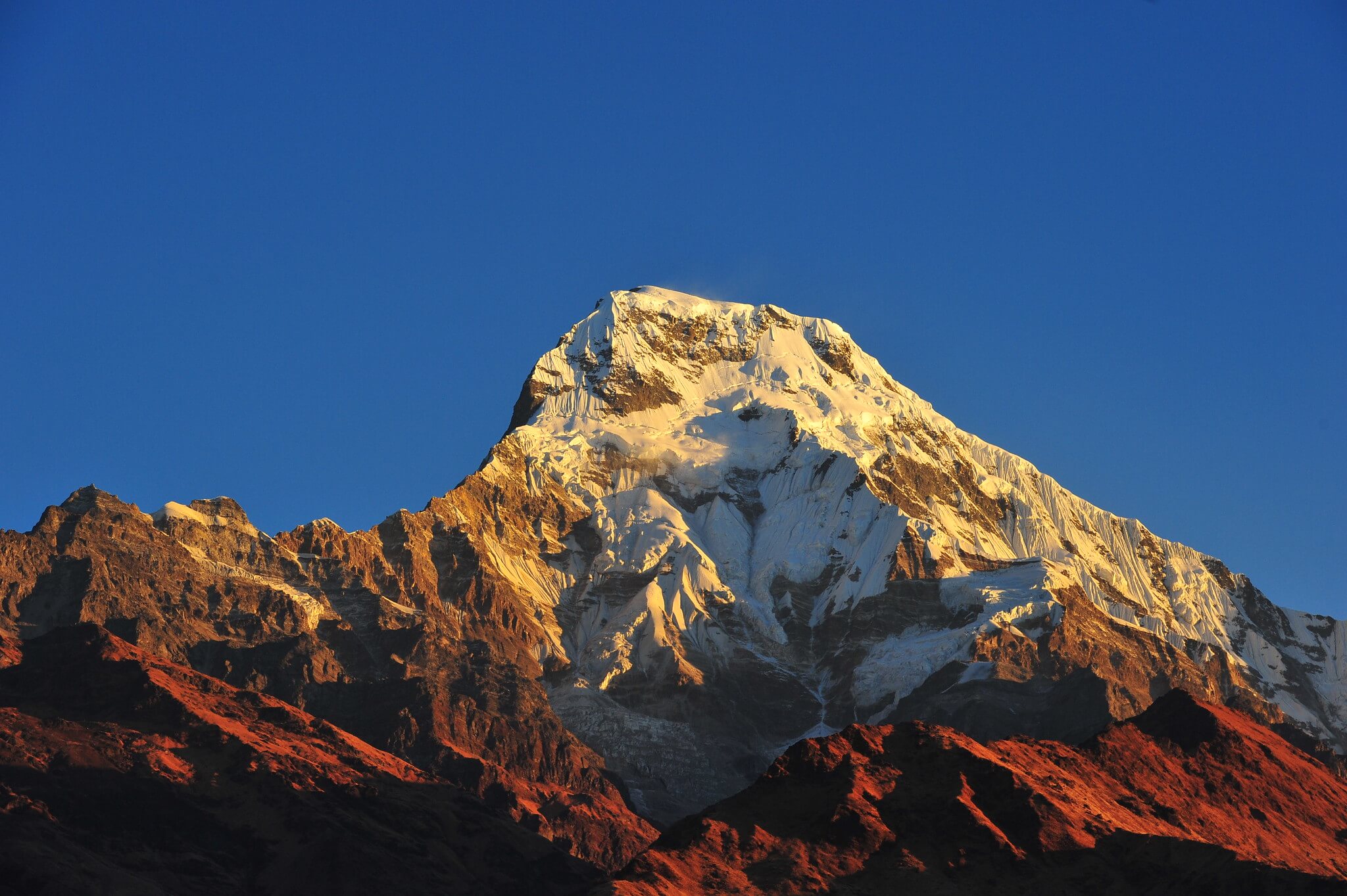
Today marks the highlight of the trek. It takes approximately 45 minutes to 1 hour to reach Poon Hill from Ghorepani. Poon Hill is a popular vantage point that offers incredible sunrise views along with a 360-degree panorama of the mountain ranges.
You’ll get to relish the beautiful spectacles of Annapurna, Machhapuchhre, Hiunchuli, Dhaulagiri, Manaslu, and Ganesh Himal. The trail climbs to Deurali with the magnificent sight of Annapurna and Dhaulagiri in the backdrop. After Deurali, the route goes steeply downhill through the dense forest until Tadapani.
Day 4: Trek from Tadapani to Ghandruk
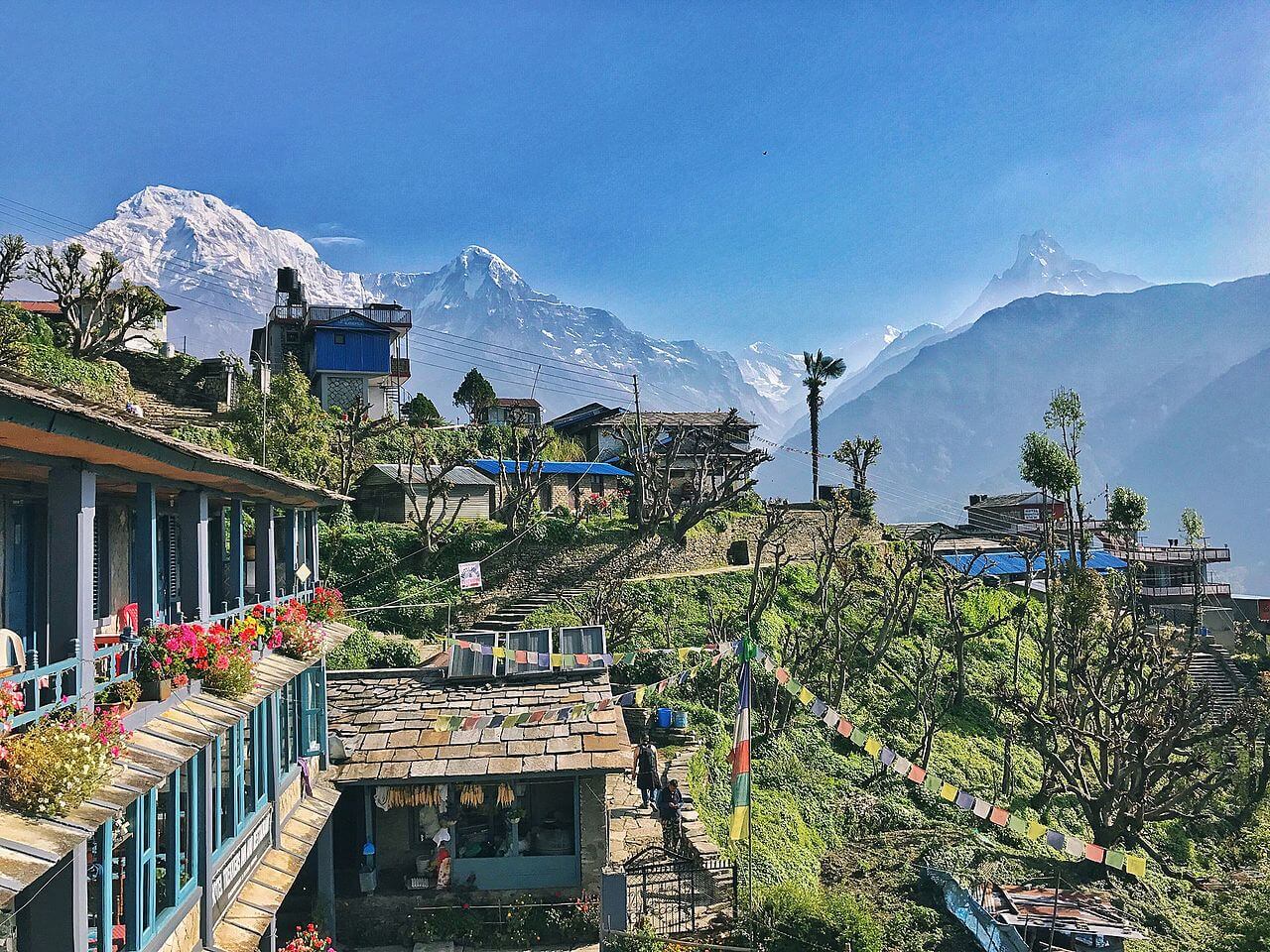
On this day, the route is mostly downhill through the shades of rhododendron forests to Ghandruk. Keep your eyes around the jungle as you may spot varieties of birds and animals along the trail.
Ghandruk is the second-largest Gurung settlement in Nepal. This village offers traditional insights and cultural experiences along with an incredible glimpse of the Himalayas.
Day 5: Drive from Ghandruk to Pokhara via Nayapul (1,070m)
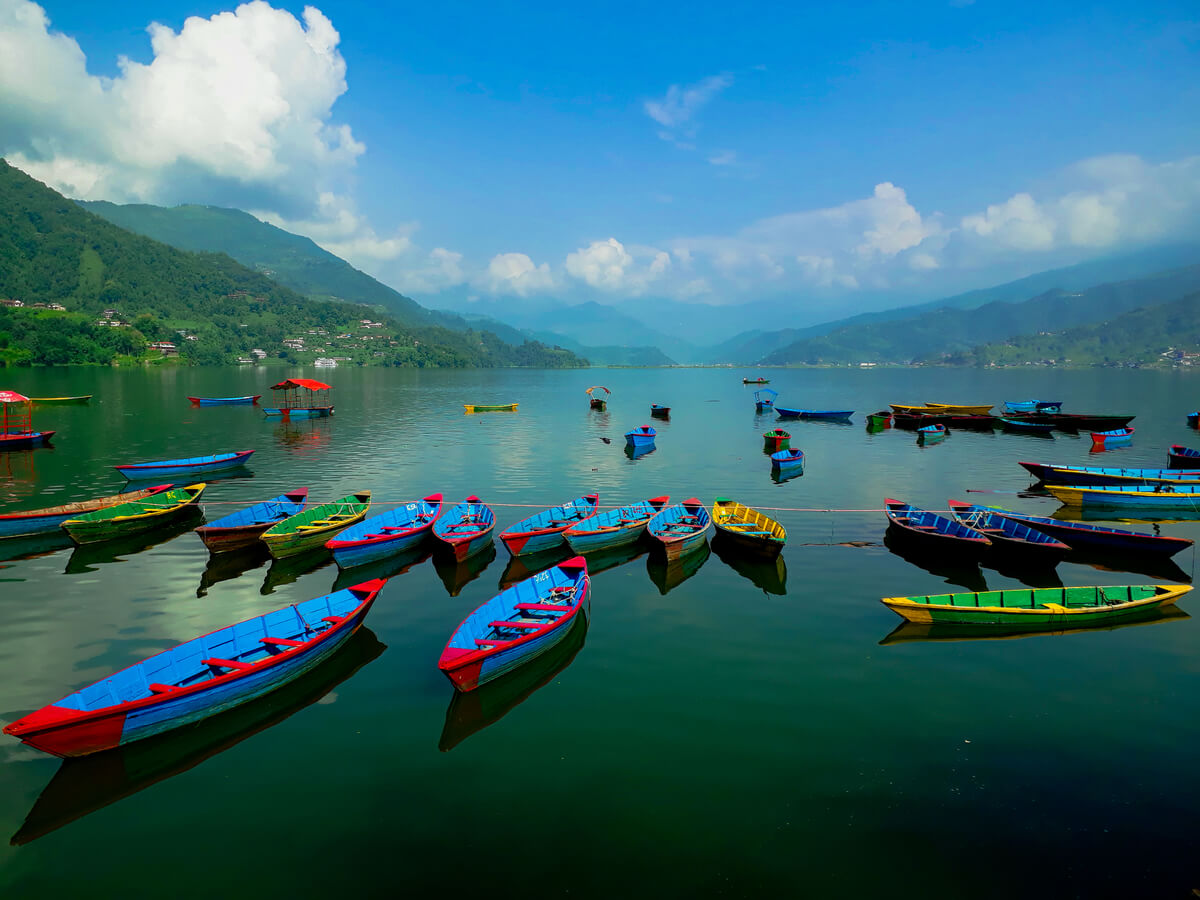
You can take a local bus or a van from Ghandruk to Pokhara. You’ll reach Pokhara in about two and a half hours if you take the local bus. A van will be a more comfortable and faster option, but they cost two or three times more money than the bus.
Poon Hill and Annapurna Extension
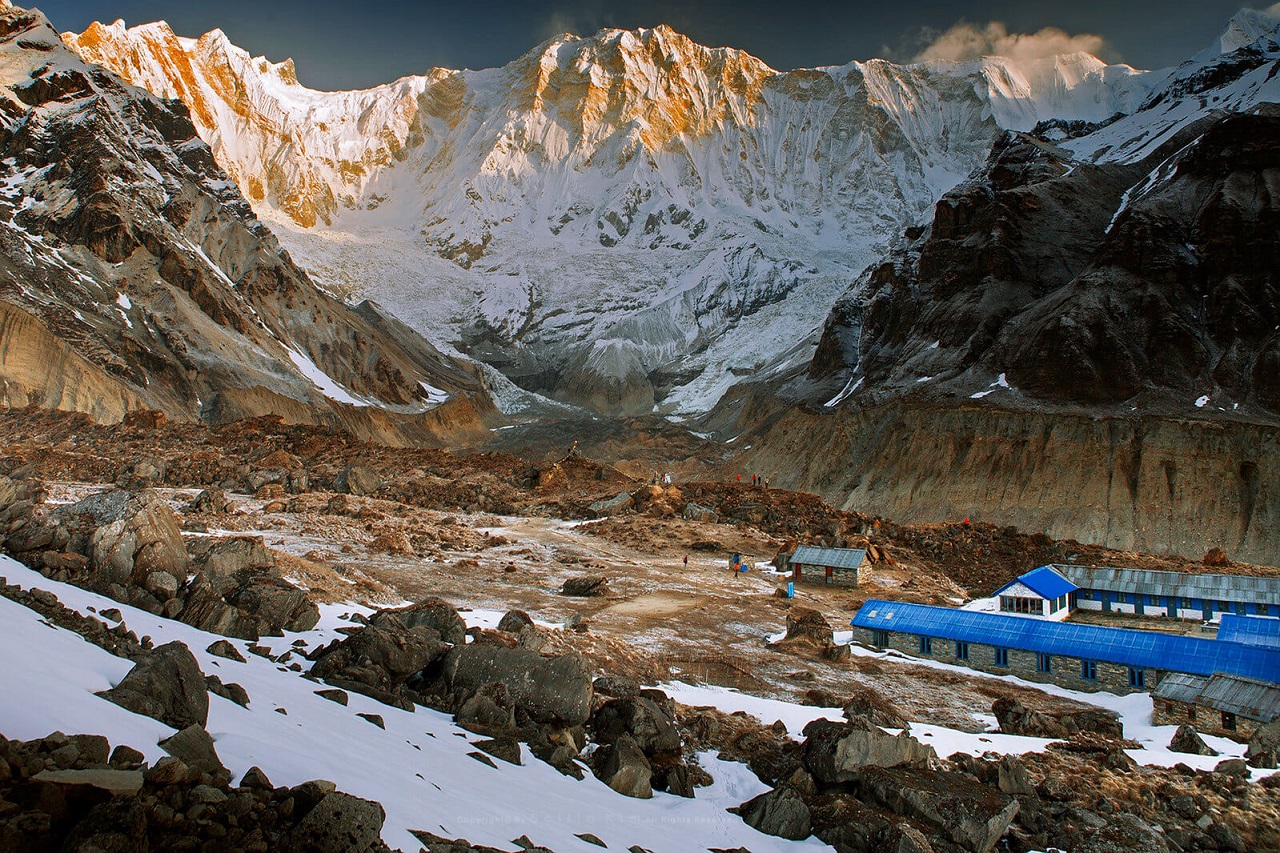
If you have enough time, you can extend this trek to the famous Annapurna Base Camp. This trek provides an opportunity to walk to the foothills of the Annapurna Massif.
Beginning the trek with a drive from Pokhara to Nayapul, you walk through several Gurung settlements to reach Poon Hill and then to Tadapani. After Tadapani, the route diverges to Chomrong connecting the Poon Hill Trek with the classic Annapurna Base Camp Trek.
It takes about EIGHT days to complete this extended itinerary stretching from 900 meters at Pokhara to 4,130 meters at Annapurna Base Camp (ABC).
Highlights of the Trek:
- Explore the beautiful valley of Pokhara.
- Relish the incredible view of snow-capped mountains including Annapurna, Machhapuchhre, and Dhaulagiri.
- Explore the second largest Gurung village at Ghandruk.
- Enjoy the majestic sunrise from Poon Hill.
Best Time to Trek Poon Hill
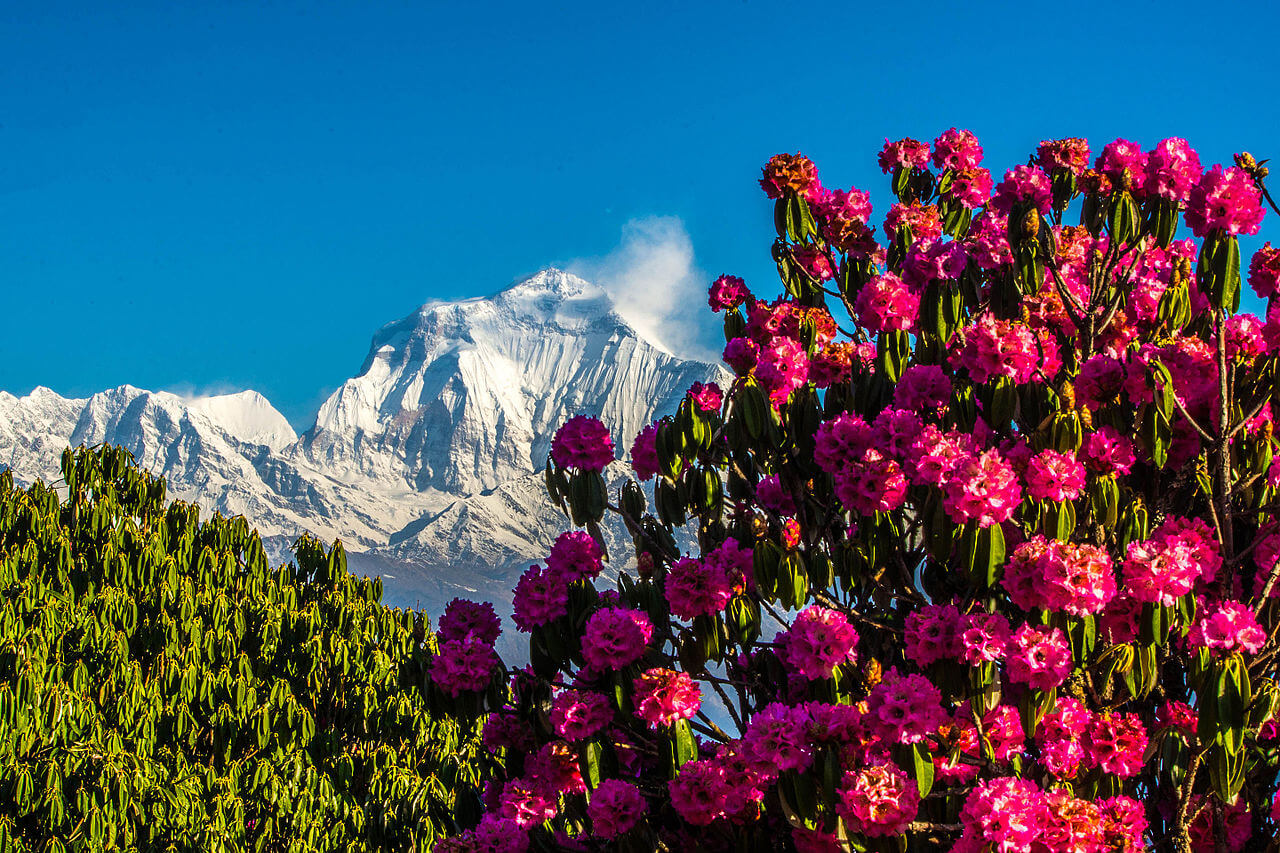
It is possible to trek to Poon Hill throughout the year. However, the weather and the view may not be clearer throughout the year. Autumn (September to November) and Spring (March to May) are the two best seasons to trek in this region.
The Autumn season is the most preferred time of the year to go to Poon Hill. The weather at this period stays moderate and consistent. The sky remains mostly clear with rewarding glimpses of the mountains and landscapes. However, the only drawback of traveling at this time is the crowded trail.
After Autumn, Spring is the second-best time to trek to Poon Hill. The weather turns slightly warm during this time of the year, and the sky gets a bit hazy compared to Autumn. But trekking at this period is highly advisable.
Winter (December to February) brings cold and harsh weather. While trekking in high elevations, winter means freezing trails and cold weather. The upper reaches, especially Ghorepani and Poon Hill, are usually covered with snow during the winter. Make sure to carry warm clothes and sleeping bags if you’re planning to go for trekking during winter.
Monsoon (June to August) is the least preferred time to trek in Nepal . At this period, the weather is unpredictable, and the trails are wet, and slippery due to the excessive rainfall. The sky is also hazy and covered in clouds, so this is not the right time to enjoy the views.
Here’s a table indicating the details of average temperature and rainfall of different places en-route to Poon Hill Trek:
Poon Hill Trek Difficulty
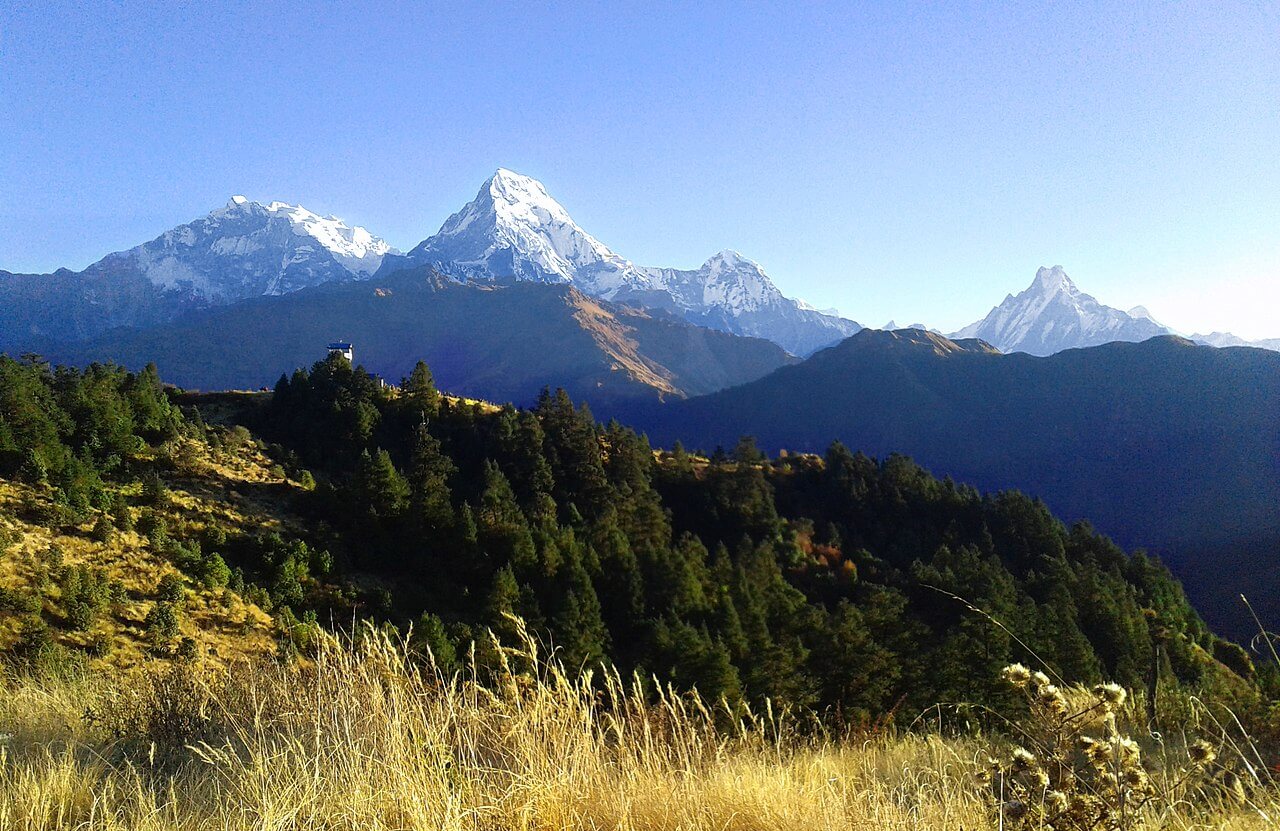
Poon Hill Trek is the most comfortable trek in the entire Annapurna region. Although this trek does not need any climbing or technical skills, the trek is not so simple like walking in a park. The first three days of the trek is steep and strenuous.
The entire trek covers approximately 40 to 44 kilometers depending on the route you choose. On average, you’ll have to walk for about 6 to 7 hours per day for a week. At the elevation of 3,210 meters, Poon Hill marks the highest elevation point of the trek. Although the risk of altitude sickness is slightly less, it is crucial to maintain fitness to protect from the AMS.
It is also vital to prepare well for the unforeseeable weather conditions. The weather in the mountains is always unpredictable and likely to change quickly. Therefore, pack all the essential gears for wet and cold weather.
Since you’ll be walking for long hours every day, invest in high-quality hiking boots. Although the experienced trekkers consider Poon Hill as an easy trek, it requires a certain level of physical fitness to complete the trek.
However, Poon Hill is comfortably doable, even for first-time trekkers. Most of the people consider it as the ideal destination for novice trekkers who wants to experience the Himalayas.
Poon Hill Trek Permit
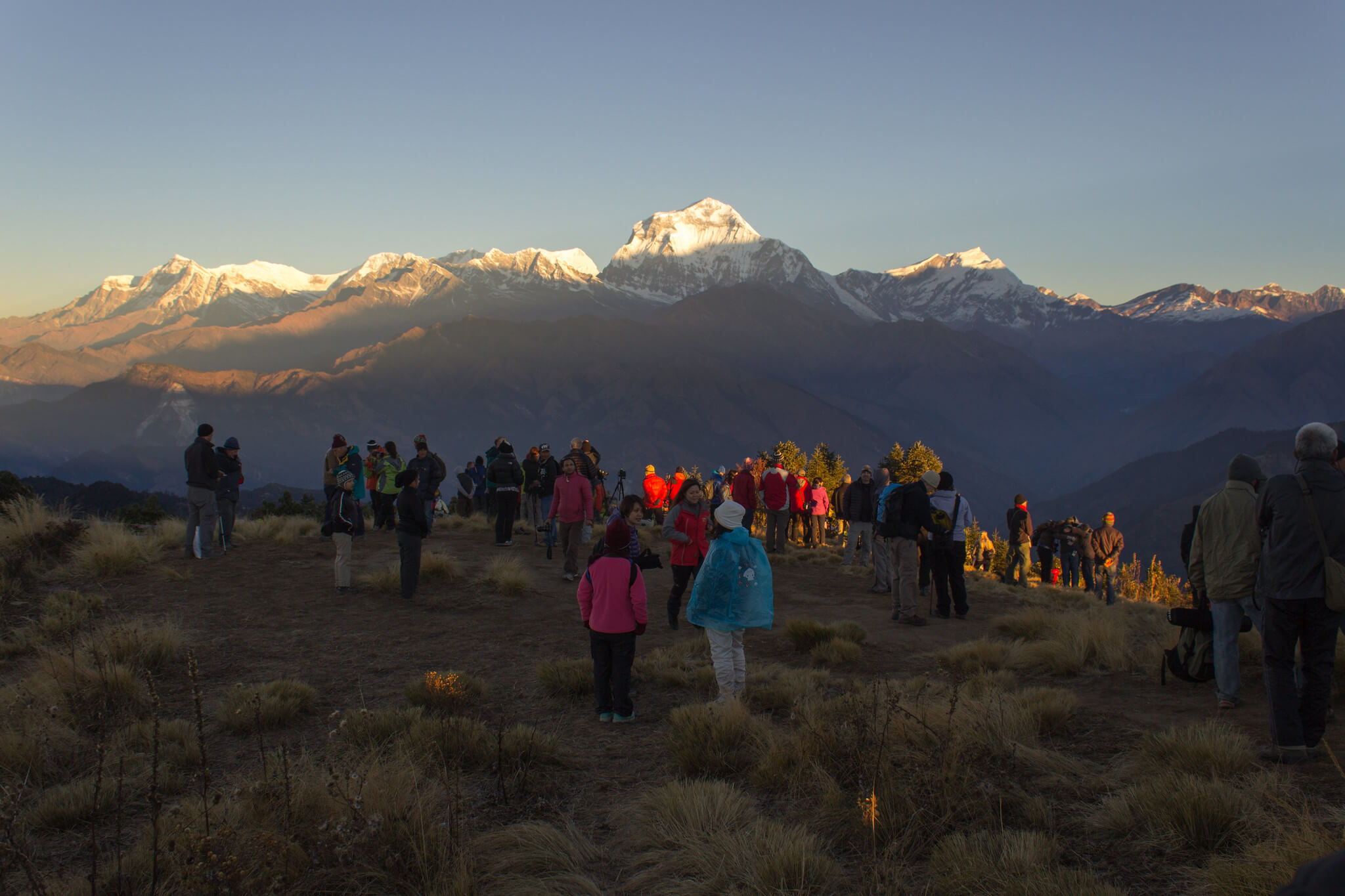
Like other treks in the Annapurna Sanctuary, Poon Hill Trek also requires two different permits — TIMS Card (Trekking Information Management System) and the ACAP permit (Annapurna Conservation Area Project). You do not require any restricted area permits to enter the area.
If you book your trek in an authorized travel company, they’ll take care of all the hassles of the permit for you. However, if you choose to trek independently, you can acquire TIMS Card from Nepal Tourism Board or Trekkers Agencies’ Association of Nepal (TAAN) Secretariat in Kathmandu. There are three types of TIMS Card; green for individual travellers, blue for organized group trekkers, and a pink one for SAARC nationals.
For ACAP Permit, you have to visit the Nepal Tourism Board in Kathmandu or Tourist Office in Fewa Damside, Pokhara.
For both TIMS Card and ACAP permits, you’ll need to have your passport, insurance details, passport size photos, and contact details of a person in Nepal.
To receive the TIMS Card:
- First, fill-up the form at the counter of the Tourist Information Center in Kathmandu or Pokhara.
- Submit your passport size photograph with the form. If you do not have printed photos, you can take a picture in the office without paying any charge.
- Submit the filled out form along with NPR.2000/US$ 18 each to the information center counter. Remember they only accept Nepalese Rupees, so make sure to exchange your dollars to NPR.
- Finally, get your TIMS Card.
To receive the ACAP Permit:
- Upon receiving your TIMS Card, get another permit form from the next room.
- Fill the necessary details.
- Submit the filled form with your passport, photos, and NPR. 3000/US$27 per person (payable in Nepalese Rupees only).
- Get your ACAP Permit.
Here’s the price of the permits required for Poon Hill Trek:
Insurance for the Trek
Although Poon Hill Trek is a short and easy trek compared to Everest or Annapurna Base Camp , it is essential to have travel insurance while trekking in this area. As it seems to be not necessary, but we highly recommend you to have proper travel insurance for this trek.
You may come across unpredictable situations — accidents and altitude sickness are quite common while trekking in the high Himalayas. You do not need to include helicopter evacuation in your policy. But, make sure to get an insurance that comprises all the medical charges, natural disasters, trip cancellation, and theft. Though there are very few decent travel insurance companies, we highly suggest you get it done from the World Nomads.
Guided VS Independent Trek
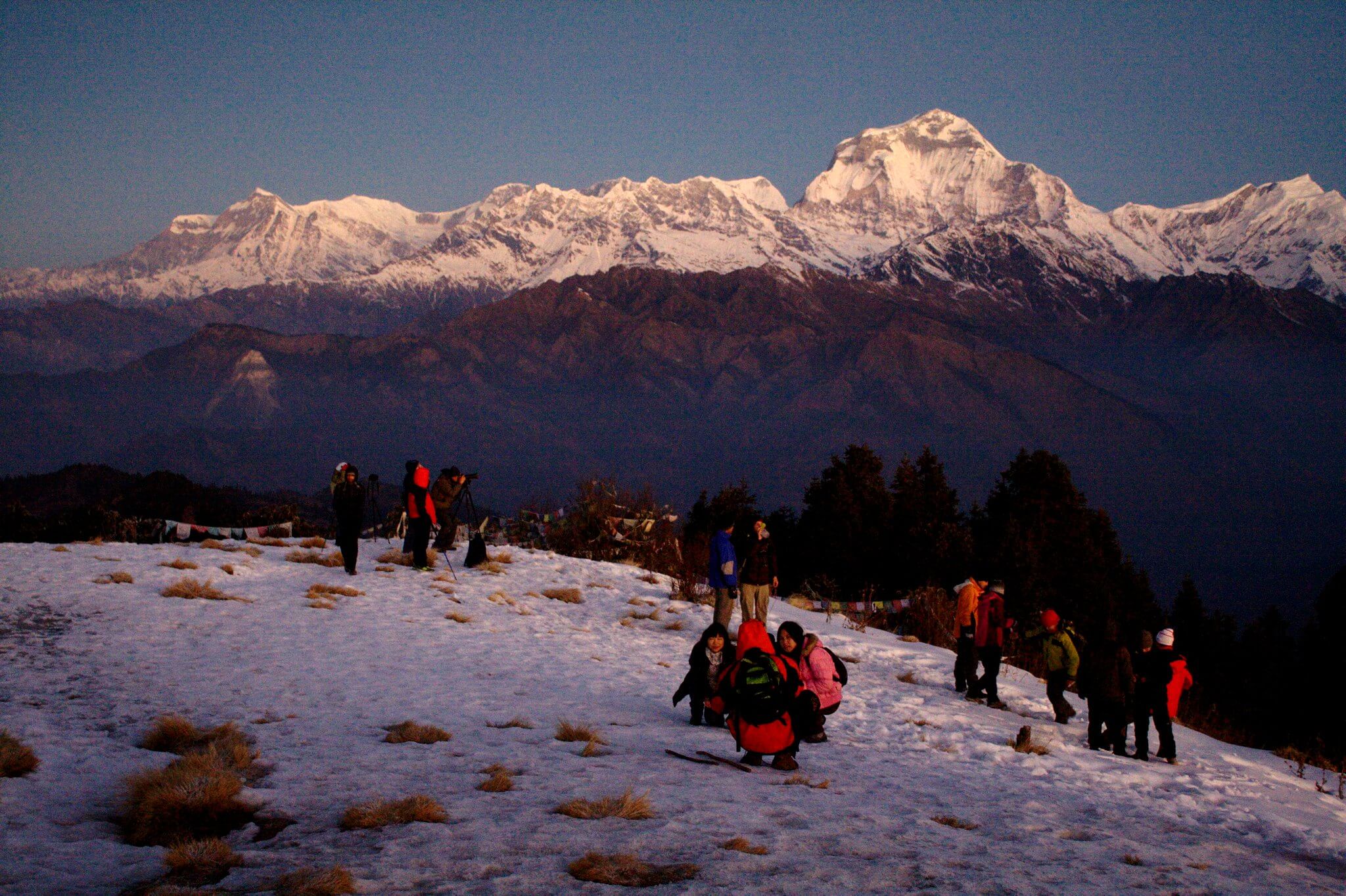
Independent Trek
You can trek both independently or with a guide as per your preference. If you choose to travel on your own, you’ll have to take care of all the hassles such as arranging transportation, accommodations, and carrying your backpacks. However, you’ll have the luxury of changing the plans and itinerary as per your wish.
You’ll meet plenty of locals and tourists throughout the trail and they’ll be happy to cooperate with you about the course. The chance of you getting lost in this route is minimal as there is only one path to Poon Hill.
- Relatively cheaper than guided trek.
- It is more adventurous as you’ll be responsible for all the logistics and planning.
- You’ll have the flexibility to make adjustments to your plans as per your wish.
- If you get into any trouble, you will not have anyone to accompany you.
- Planning all the logistics might be hectic.
Guided Trek
If you choose to travel with a guide and porter, they’ll help you arrange the permits, transportation, accommodations, and luggage. They’ll guide you throughout the trail and assist you in every situation.
The guide will plan the itinerary and all the arrangements for your trip, which means you won’t have the flexibility to change as per your wish.
- No need to worry about finding accommodation, planning the route, and carrying the extra weight.
- With a professional guide, you can learn about places, cultures, and food.
- Hiring a guide is spending more.
- It is slightly less adventurous.
Accommodation and Food
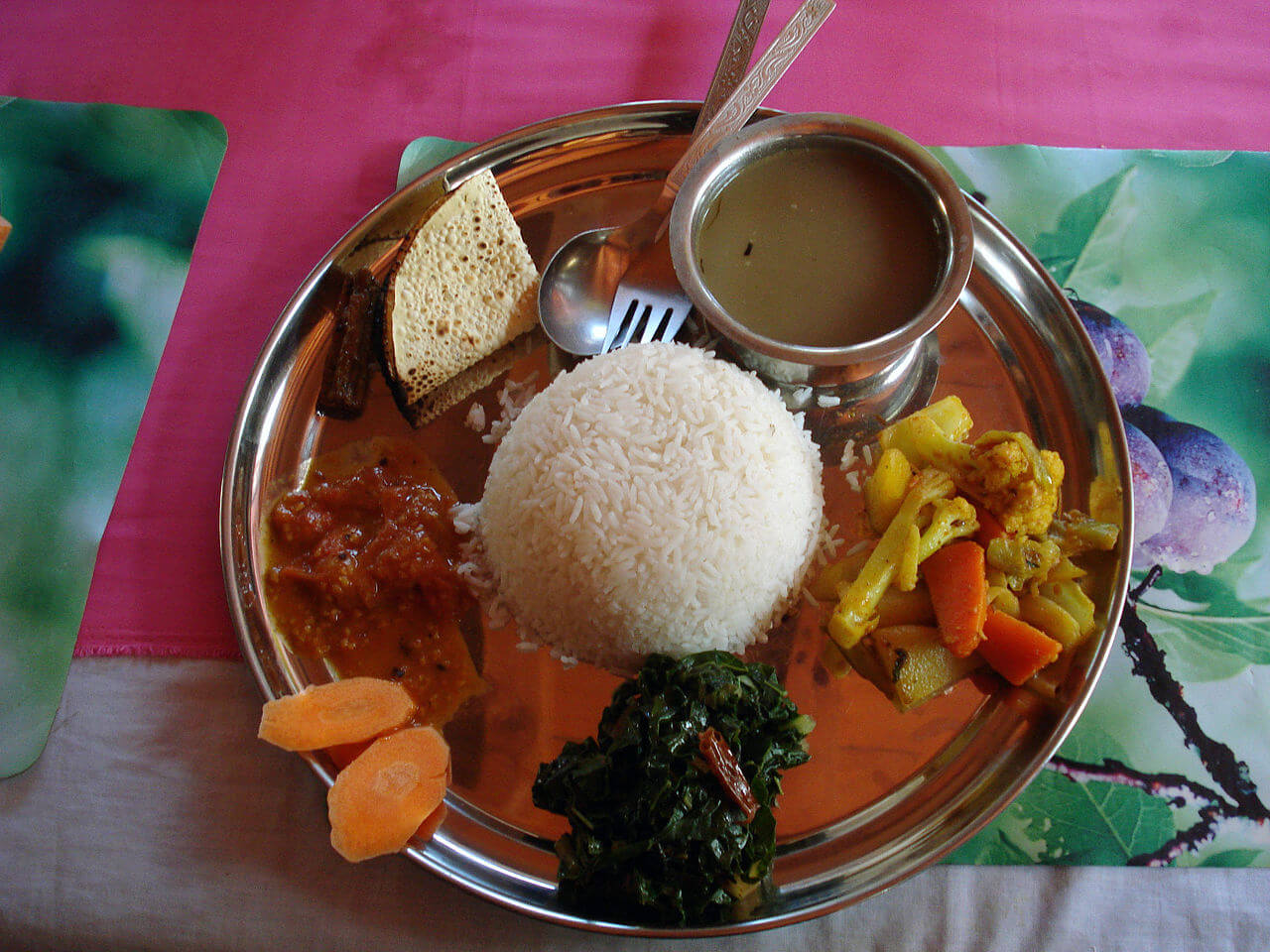
Plenty of hotels and comfortable teahouses are available throughout the trail to Poon Hill. Most of the teahouses are cozy, providing rooms, food, and basic amenities including wifi, hot shower, and charging facilities.
In Pokhara, there are many luxurious hotels to cater to services as per your needs and budget. But, once you start trekking, teahouses facilitate essential services of two single beds in a room, a thin mattress, a pair of bed sheets, and a cushion. The toilets are mostly on a sharing basis without running water. If you want to use additional facilities like the hot shower, wifi, and charging facilities, they may charge you extra bucks for it.
Teahouses also provide meals on their menu. Dal Bhat (Rice and Lentil) is the most popular food in the mountains. Most of the trekkers prefer Dal Bhat to other foods as the portion is quite sufficient to fill the hunger. They also serve a few western menu meals, but the taste may not be as good as a fancy restaurant.
Poon Hill Trek Cost
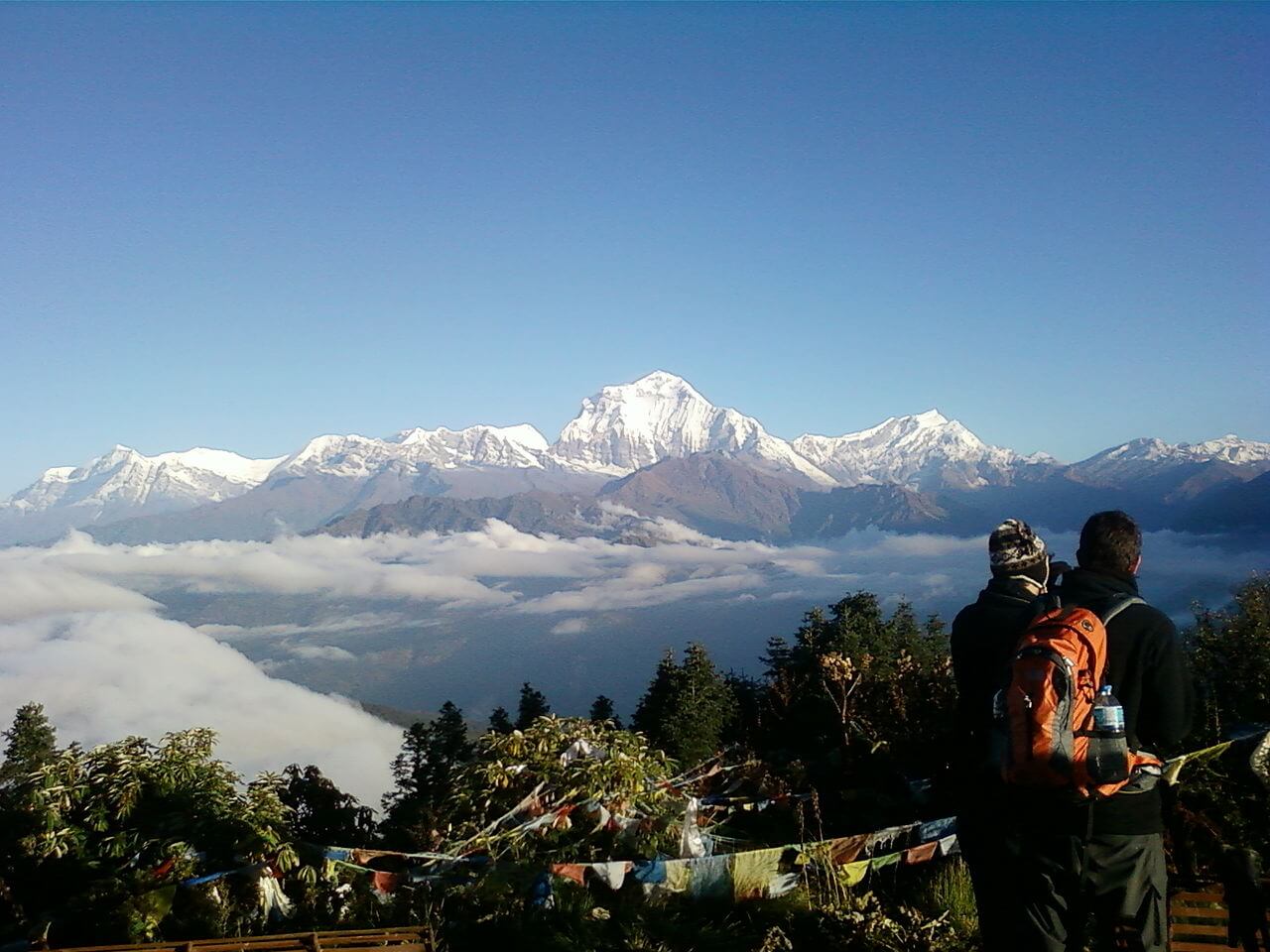
The total cost of the trek depends on different factors such as the total number of days, transportation, route option, and trekking season. As Poon Hill Trek is a short trek, the value of the entire trek is relatively cheaper than other commercial treks in Nepal. On average, a 5-day trip to Poon Hill prices about US$ 200-400, including accommodation, meals, and transportation.
Accommodation in Poon Hill Trek is comparatively cheap, ranging from US$ 2 to 3 on a sharing basis. However, the price of the rooms might go slightly higher during the peak season than at other times of the year. If you’re trekking independently, make sure to negotiate with the initial price as some of the teahouses may have space for discounts on the room charge.
Meals on the trail costs between US$ 4 to 6 as per the varieties. Meat items are more expensive than ordinary dishes. However, we highly recommend you not to have meat items along the trail.
Transportation is cheap and easy to get. If you choose to travel by local bus, the ride from Pokhara to Nayapul costs US$ 2 per person and ride from Ghandruk to Pokhara costs you US$ 4 to 5. The vans are two or three times dearer than the local bus.
The price of the TIMS Card is US$ 18 for an individual trekker and US$ 9 for travellers in a group. Likewise, the cost of the ACAP Permit is US$ 20 per head.
You need to pay extra US$ 1 to 2 for access to a WiFi connection. Similarly, it costs some US$ 1 to charge phone and camera batteries.
If you are planning to hire a licensed guide, you have to pay an additional US$ 20 to 25 per day. Hiring a porter will cost you US$16 to 20. If you want to hire a porter cum guide, they’ll charge you about US$ 18 to 20 per day.
Packing List for Poon Hill
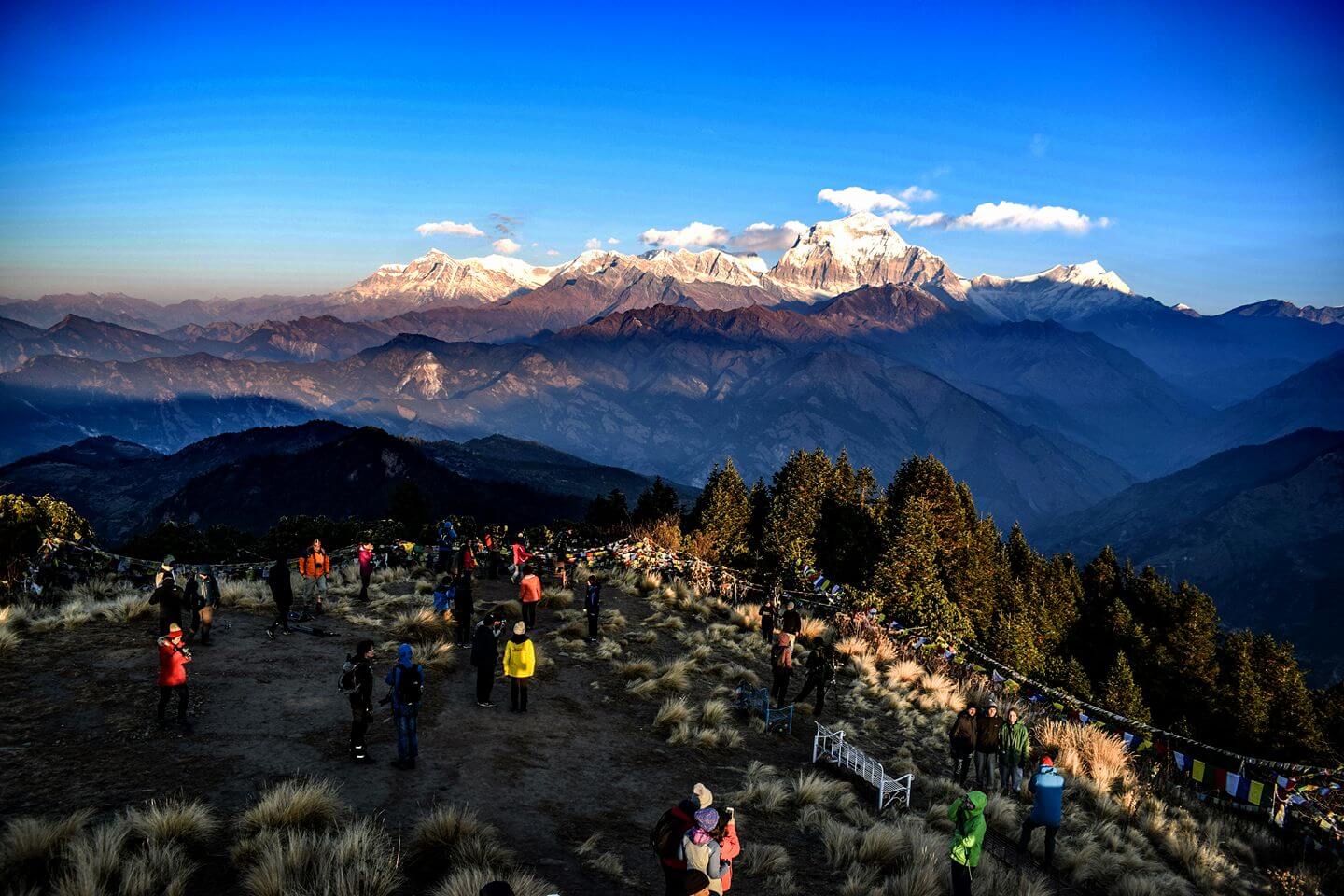
- Duffel Bags
- Trekking Shirt
- Trekking Trousers
- Down Jacket
- Waterproof Shell Jacket
- Breathable Underwear
- Hiking Boots
- Trainers/Sandals
- Hiking Socks
Head Wears:
- Sun Protection Hat
Important Accessories:
- Sleeping Bag
- Trekking Poles
- Water Bottle
- Basic Medical Kits
- UV Protection Sunglasses
- Water Purification Tablets
- Hand Sanitizers
- Sunscreen/Lip Balm
Network Information
Network coverage on the trail is pretty decent. Both NTC and Ncell services work fine throughout the trek but weak at Poon Hill. The network connection may not always be available at the vantage point of Poon Hill.
When it comes to mobile internet service, you can expect 3G data coverage in most parts of the trail. Most teahouses provide WiFi services with additional charges. WiFi is the most preferred way to stay connected with your friends and family. But the connection can get slower when the high number of users congest network traffic.
Useful Tips
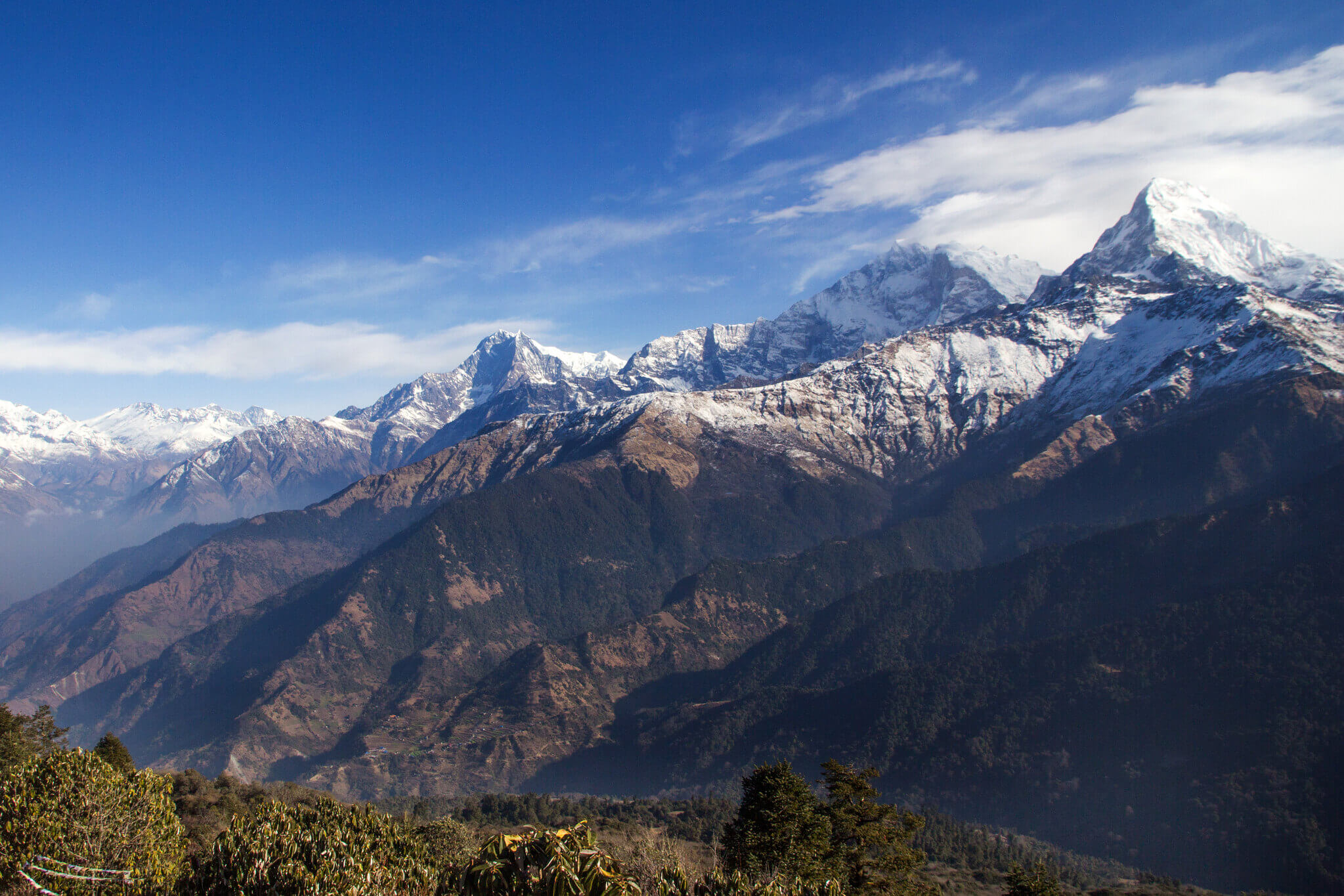
- Carry enough cash. There are no ATMs on the trail.
- Do not forget to carry a waterproof jacket.
- Make sure to carry your water bottle as you can’t buy bottled water on the trail.
- It is handy to bring a portable charger on the trek as charging facilities may not be reliable in the teahouses.
- Although Poon Hill Trek is an easy trek, it is something more. You’ll have to climb strenuous uphills while trekking to Poon Hill. Make sure to stay physically fit and engage in cardio-oriented exercise before the trek.
- Do not forget to carry a decent camera. You might capture the breathtaking sceneries along the trail.
Accommodation in Pokhara
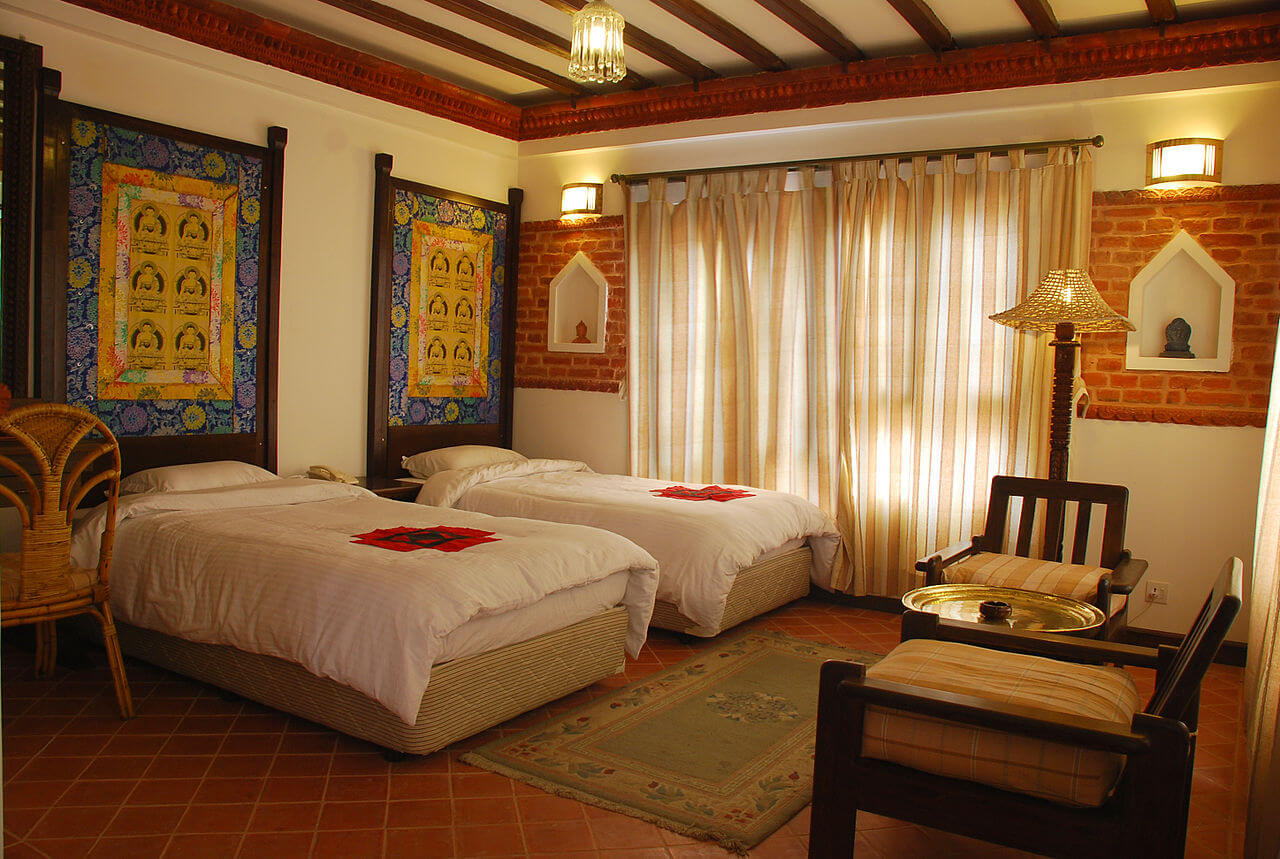
Recommended Travel Agencies
- Himalayas on Foot
- Mosaic Adventure
- Nepal Eco Adventure
- Magical Nepal
Recommended Books and Guidebooks
- Annapurna: A Trekker’s Guide
- Lonely Planet – Trekking in the Nepal Himalaya
- The Rough Guide to Nepal
- Into Thin Air
- High Adventure
FAQs About Poon Hill Trek
1. how fit do i need to go trekking in poon hill.
Poon Hill Trek is a short and easy one in the Annapurna region. Even novice trekkers with decent physical fitness can do this trek. If you can walk approximately 5 to 6 hours each day, you can trek easily.
2. Can I do Poon Hill Trek independently?
Yes, it is possible to trek to Poon Hill independently. Poon Hill Trek without a guide is a far cheaper and more flexible way to travel. However, it may be slightly difficult to trek on your own as you have to handle all the issues of the trip.
3. Is drinking water safe on the trek?
No, water from local sources and tap is not safe to drink. Additionally, bottled water is also not available to buy in Poon Hill Trek. Make sure to carry a water bottle with you and refill the water in the teahouses.
4. What is the standard of the accommodation on the trek?
The teahouses in Poon Hill Trek has standard accommodation services. Most of the lodges provide rooms with twin beds, attached bathrooms with running hot water. However, these teahouses may charge you extra bucks for wifi and charging facilities.
5. Is there any possibility of Acute Mountain Sickness?
Generally, altitude sickness occurs after you exceed the elevation of 3,000m above sea level. Poon Hill lies at an altitude of 3,210m. As you will spend a short period at the threat zone, the possibility is very minimal.
However, it is always better to stay precautious while trekking at high altitudes.
6. Do I need travel insurance for Poon Hill Trek?
Although Poon Hill Trek is relatively short and comfortable, it is advisable to have travel insurance for the trek. You only need basic insurance that covers at least medical costs, theft, accidents, and natural disasters.
Poon Hill Trek is a short and comfortable adventure through rhododendron forests to the vantage point that offers marvellous Himalayan panorama. If you hike to Poon Hill early in the morning, the sunrise over the mountains is a majestic sight to relish.
This trek offers you not only the mountain views but also the cultural experience of Gurung inhabitants.

The Poon Hill Trek Itinerary: one week in the Annapurnas
This post offers you the ultimate guide to the best one week Poon Hill trek itinerary. The Poon Hill trek, also known as the Ghorepani Poon Hill trek or the Annapurna Panorama, is one of the shortest multi-day hikes in Nepal .
Short, but sweet. Therefore it is perfect for those who don’t have the time for Everest or the whole Annapurna Circuit . The Poon Hill trek offers natural beauty, cultural diversity, rural villages and spectacular mountain views.
Why choose the Poon Hill trek?
While the Ghorepani Poon hill trek is still not a walk in the park, it is an easy hike for beginners. Perfect for families with children or those that are looking for an easygoing experience in Nepal .
The Poon hill trek goes through the lower foothills of the Annapurnas. Therefore, there is no risk of altitude sickness, yet there are plenty of views on the snow capped mountain peaks of the Annapurna’s. Most of them are well over 7000 meters high.
The highlight is seeing the sunrise at Poon Hill, the highest point of the trek. It offers the most beautiful panorama of the Annapurna’s and you can get there in only 2 days of hiking. The trail continues through terraced slopes, rice paddies, maize fields, lush forests and rural villages.
The Annapurna is a very multicultural area with different ethnic groups. Along the Poon hill trek you will mostly encounter Magar and Gurung people. Each group has their own language and cultural traditions.
The advantage of the Poon hill trek are the excellent tea houses and restaurants on the way. This means you can be very flexible in planning your Poon hill trek itinerary. It can be as short as 4 days or you can combine it with the Annapurna Circuit or the Annapurna Base Camp. It is then a great acclimatization trek before going to higher altitudes.
The Annapurna’s are one of the most popular areas for trekking in Nepal . If you are looking for a more off the beaten path short trek I can also recommend the Langtang Trek or the Jiri to Lukla trek .

The Poon Hill trek itinerary
I had a full week when I decided to do the Poon hill trek in February and therefore chose to add Chomrong to my itinerary. It adds just one extra day and Chomrong is a beautiful village located on the Annapurna Sanctuary trek. It is also possible to walk from Tadapani straight to Ghandruk and then back to Kimche/Nayapul.
In this Poon hill trek itinerary I mention every day the amount of time it took me from start to finish. I am a slow hiker though. I like to take frequent breaks to enjoy the beautiful views. If you are fit , you can probably do it in less time
Day 1: Pokhara – Nayapul – Tikhedunga
10 kilometers, 5 – 6 hours
This Poon hill trek itinerary starts at Nayapul. From Pokhara’s Baglung bus station there are frequent buses to Nayapul. The journey takes about 2 hours. From here it is a 30 minute walk or short jeep ride to Birethanti. Jeeps can now bring you all the way to Hille, but I prefered to walk.
After Birethanti it is an easy and gradual uphill walk towards Tikhedhunga. I thought it was very scenic as you walk past the Bhurungdi river through small villages and terraced farm fields. People are very friendly and always greet you with a smile. A great first day on the trail that seemed lightyears away from the hectic city of Kathmandu .

Day 3: Tikhedunga – Ghorepani
11 kilometers, 8 hours
The second day of the Poon hill trek itinerary is the most challenging day. You immediately start with a diificult 2 kilometer staircase up to Ulleri. There are more than 3000 steps. But even after Ulleri you keep climbing for the rest of the day. Sometimes rather steep, sometimes more gradual, but up it is. In total you will ascend more than 1300 meters.
The key to enjoy this day on your Poon hill trek itinerary is to start early and take it slow. Ulleri is a nice Magar village with plenty of teahouses for a break. After Ulleri you will enter lush forests with the occasional waterfall and blooming rhododendrons in spring.
I found this to be a very scenic part of the Poon hill trek, so don’t forget to look around you once in a while. It was during a small break that I spotted langur monkeys in the trees.
The gate of Ghorepani and the blue hotel roofs were a very welcome sight. That’s when I found out there is a lower and an upper Ghorepani. Although it was tempting to stay in the first lodge I came across, I pushed myself further to Upper Ghorepani to shorten the climb to Poon hill the next morning
Insider tip : Ghorepani is the highest village where you will sleep at night. Even in the warmer months of spring and summer it can be cold here, so bring warm clothes.

Day 4: Ghorepani – Poonhill – Tadapani
13 kilometers, 7 hours
The third day of the Poon hill trek itinerary is all about the sunset on Poon Hill. This means an early wake up around 3:30 AM. Even in the dark, the trail is easy to follow as there will be lots of other hikers. You can simply follow the lights of the headlamps.
I still felt my muscles from yesterday and they struggled with more climbing as well as the altitude. It took me a little bit over an hour to reach the top. Just in time for the sunrise.
Now I understood why this trek is also known as the Annapurna Panorama. Right in front of me I saw Mount Daulagiri (8167), Mount Manaslu (8156), Mount Annapurna II (7937), Machapuchre (6993) and other peaks well above 6000 meters.
Certainly the best breakfast view I ever had as I sat down with my snickers bar that I brought specially for this occasion. The incredible views continued on my hike along the mountain ridge towards Deurali.
After Deurali the trail goes downhill and enters the forests again. No Langur monkeys today, but views on Annapurna II and Machapuchare remained visible till I reach Tadapani.
Insider tips : a headlight torch and warm clothes are necessary for the early morning climb to Poonhill. There are no restaurants at poon hill itself so bring some snacks and a thermos opf tea for a breakfast picknick at the top.

Day 5: Tadapani – Chomrong
8 kilometers, 6 hours
This day is not in the original Poon hill trek itinerary. Most people head straight from Tadapani to Ghandruk and then back to Pokhara. I decided to add Chomrong to my Poon hill trek itinerary. I did not have time to include the whole Annapurna Sanctuary trek, but just wanted to have a little taste.
Did it taste like more? Yes, definitely. More views on the Annapurna mountain peaks are waiting for you in Chomrong. I would have loved to continue all the way to Annapurna Base Camp. Maybe next time?
What I also loved about this day was that the trail from Tadapani to Chomrong was less busy than the previous days. The only people I met were friendly locals that were working in the terraced fields.

Day 6: Chomrong – Ghandruk
10 kilometers, 6 hours
Today was more challenging than I thought. First there was a long descent, but after crossing the river I had to climb back up to Ghandruk. The views on Machapuchre kept me motivated till I reached Ghandruk.
Ghandruk is one of the largest Gurung villages in the Annapurna’s and gives you a wonderful insight into rural life in Nepal. The narrow alleyways are dotted with lodges and traditional farm houses. It is one of the most scenic villages on the Poon hill trek.

Day 7: Ghandruk – Nayapul
9 kilometers, 5 hours
From Ghandruk it is now a short hike of 2 kilometers to Kimche. There you can find transport to Birethanti, Nayapul and Pokhara.
Very few people still walk all the way to Nayapul, but I did not want to say goodbye to the mountains yet. Walking from Ghandruk to Nayapul is an easy gentle descent through the lush greenery of the modi khola river valley.
There is lots of nice scenery with rice paddies and villages. That said, you don’t miss out a lot if you do decide to take the bus. For me it was a bit of a culture shock to be back in a busy town like Nayapul. Within minutes I could catch a bus back to Pokhara.

The Poon Hill Trek Travel tips
The poon hill trek permits.
For the Poon hill trek you need two permits.
TIMS card : The Trekkers information management card is necessary for almost all treks in Nepal. You can get your TIMS card at the Tourism Board office at Bhrikuti Mandap in Kathmandu. Bring your passport and two passport size photos. The TIMS card costs 2000 nepalese rupees.
Annapurna Conservation Area permit : For the Poon hill trek you also need a national park entrance permit. I recommend you to get it as well at the Tourism Board Office at Bhrikuti Mandap in Kathmandu. This costs 3000 nepalese rupees.

Do I need a guide on the Poon Hill trek?
The Poon hill trek is easy to do without a guide. Unless you go off season there will be enough other hikers on the trail to keep you company. That said, the area around Poon hill has lots of different paths that cross each other, making it easy to get lost if you don’t pay attention.
I was with a friend that had done the hike before and knew the way. If you are alone and not that experienced you might want to consider joining a guided trek or hiring a guide, porter or porter guide.
In Nepal there is a clear distinction between a porter and a guide. A guide shows you the way and can tell you more about the history and the culture of the places you visit. A porter will only carry your luggage. Despite their heavy burden they often walk far in front of you and might have reached the lodge when you are only midway. A porterguide is less common, but does both.
If you prefer a female guide I can recommend the 3 sisters adventure trekking that works to empower women and trains women to become trekking guides in Nepal.
Update April 2023 : The Nepal Tourism Board issued a press release that trekking without a guide is no longer permitted from 1 April 2023 onwards. Trekkers planning to hike in Nepal’s National Parks where you normally need a TIM’s card should have a government licensed guide that is registered with the official Trekking Agency Association of Nepal (TAAN) . It is unclear yet how this rule will play out in practice. Everest issued a press release stating that they will not enforce it. Other areas do. However, there are no guidelines on how they are going to implement the ban on solo trekking .
Accomodation on the Poon Hill trek
Along the Poon hill trek there is plenty of accomodation and teahouses to choose from. They are basic and can’t be booked online beforehand. There is a first come first serve basis and some lodges are fully booked by big tour groups. In my experience there are enough lodges. There will always be a bed for you somewhere.
The prices of accomodation is incredibly cheap, sometimes even free, but they do expect you to order dinner and breakfast at their establishment.

Food on the Poon Hill trek
The good thing about tea house treks in Nepal is that however basic lodges might be, the food is often quite good if you stick to Nepali cuisine . Yes, many lodges try all kinds of international dishes to attract tourists, but in my opinion, often not the best choice.
When trekking in Nepal I eat Dahl bath at least once a day. This national dish of rice with lentils knows a huge variety in how it is prepared. Different vegetable curries from fermented spinach (gundruk) to roasted cauliflower and different pickles (aachar) to spice it up. Not one dahl bath is the same.
Other Nepali foods to try are Tibetan bread, Thukpa and Momo’s. On the Poon hill trek you also get a chance to taste Gurung cuisine. One of my favourite side dishes with dahl baath actually comes from the Gurung people. Gundruk is a curry made of fermented leafy vegetables. Dried meats (sukuti) are also very popular among the Gurungs. Definetly try dried buffalo (buff sukuti) if you get a chance.
When to hike the Poon Hill trek
The best time to go trekking in Nepal is spring and autumn, but Poon hill is even possible in winter. Although January and February will be too cold for high altitude treks, the poon hill trek is still a good option. I hiked in February and had clear blue skies every day. It is important to bring some warm clothes. As soon as the sun is gone it can get cold, especially at Ghorepani.
March, April and May are the warmer months before the monsoon. As the rainy season approaches it can become hot, dusty and humid. The blooming rhododendrons are a big highlight though when hiking around April.
June, July and August are the monsoon months. These are probably the worst time to hike the lower altitudes of the Annapurna’s. Not only because of the rain, but most of all, because of the leeches. Annoying as they can be, they are not dangerous. These months it is better to visit Jomsom and Muktinath, because they are in the rain shadow of the Annapurna’s.
September, October and November are the most popular months for trekking. Autumn brings clear blue skies and mild temperatures before the cold sets in, in December. Autumn is also a festive season with the celebration of Tihar and Dashain. Nepal’s biggest festivals and you will see families gathering together in the villages.

Altitude Sickness on the Poon Hill trek
The Poon hill trek has a very low chance of altitude sickness. The highest point is Poon Hill at 3250 meters high. Here you might experience some mild symptoms such as being tired and more easily out of breath. However, as you will descend to lower altitudes on the same day, this should not pose a problem.
Poon Hill Trek Books and Guides
Cicerone and Trailblazer both have excellent and comprehensive guides about treks in the Annapurnas including the Poon Hill trek. Another option is the Lonely Planet’s Trekking in the Nepal Himalayas guide.
Poon Hill Trek packing list
If you need to carry your own gear on a multi day trek, the advice is to bring as little as possible. The Poon hill trek is not a difficult trail. There is no need to bring a tent or food. Below a few things to consider
Sun protection : no matter what time of the year you will need to bring protection against the sun. Sunscreen and a hat are a must. There are stretches with little shadow
Rain protection : there is always a risk of rain. I brought a poncho along that protected both me and my backpack from the rain.
Sturdy shoes : There is no need for proffesional hiking boots. However, there are some rocky trails so do bring sturdy shoes that fit you well. It’s important you don’t bring brand new shoes. Make sure your shoes are tested and comfortable to prevent blisters.
Hiking socks : Besides good shoes, good hiking socks are key to prevent blisters. Merino wool socks are lightweight and dry quickly. Wrightsocks are specially designed with double layers to prevent blisters.
Layers : there can be a big difference in temperatures during the day and night. The best way to deal with this is to wear layers. As a base layer I bought merino wool tshirts at Decathlon. They are lightweight and dry quickly. I had a fleece vest as a midlayer and as the upper layer I had a windproof jacket.
Backpack : Your shoes and backpack are two things that will have a big influence on the comfort of your multi day trek. I recommend to go to an outdoor store to get some good advice to buy a backpack that fits your torso length and that is comfortable when you wear it. I own the Osprey Fairview trek 50 that I am very happy with.
Reusable water bottle : to prevent plastic waste I always bring a reusable water bottle with me and a water filter or steri pen.
Sustainable Travel on the Poon Hill Trek
The Poon Hill trek is one of the most popular hikes in Nepal. The trails become more crowded and pollution is a growing problem. Traveling sustainably to the Himalayas is essential to minimize your environmental impact and preserve the area’s natural beauty for future generations.
Support the local community : You can support the community by purchasing goods and services from local vendors. It is better to try Nepali Cuisine that uses local ingredients rather than imported foreign foods. Nepali food is vegetarian friendly and it is very easy to follow a vegetarian or vegan diet.
Stay in small scale sustainable hotels : It is also better to stay in locally-owned guesthouses or homestays to support the local economy directly. These accommodations often have a more positive impact on the environment compared to large hotels.
You can try to look for guesthouses or homestays that prioritizes sustainable practices. That said, environmental awareness is still low. It’s up to you to use water sparsely, turn off lights, air conditioning, and heating when leaving your accommodation.
Leave no trace principle : When hiking the Poon Hill Trek, stick to designated trails to protect the fragile alpine ecosystem. Straying off the marked paths can cause soil erosion and damage to plant life. If you are lucky enough to spot wildlife, observe quietly from a distance to prevent disruption to their habitats and help maintain their natural behaviors.
I encourage you to take all your trash back with you and dispose of it responsibly. In other words, leave no trace of your visit. Even better is when you bring something to pick up any of the trash that other people left behind.
To avoid single-use plastics, invest in reusable items. For example, you can bring your own water bottle with a filter. At last, use biodegradable and eco-friendly personal care products to minimize pollution of water sources.
Respect the culture : Besides environmental concerns it is also important to be sensitive of the community’s way of life. Nepal is a multicultural country and on the trail you will encounter different ethnic groups.
People will appreciate it, if you dress modestly. Learning a few basic phrases in Nepali, can go a long way in building meaningful connections and to learn more about the local culture. Not everybody is happy to have their picture taken. When in doubt, ask permission.
Disclaimer : This post with a travel guide about the Poon Hill trek in Nepal contains affiliate links. If you buy any service through any of my links, I will get a small commission at no extra cost to you. These earnings help me to keep Backpack Adventures alive! Thanks for your support!

Leave a Reply Cancel reply
Your email address will not be published. Required fields are marked *
- Kale by LyraThemes.com.
Create an account
Start your adventure today.
Already a member? Login

Poon Hill Trek – The Full Guide and Detailed Itinerary
Quick navigation, poon hill trek details, poon hill trek: detailed itinerary, poon hill trek map, best time to do the poon hill trek, accommodation on the poon hill trek, poon hill trek costs, poon hill trek tour, adventure travel insurance, recommended packing list for the poon hill trek, trekking in nepal articles, join our newsletter.
Get a weekly dose of discounts and inspiration for adventure lovers
Seeing a beautiful sunrise from an altitude of 3,210 m with all the majestic Himalayan ranges is worth every strenuous walk it took to get there. Such is the feeling you get after reaching the top of Poon Hill situated in the Annapurna region of Nepal.

- Difficulty: Easy to Moderate
- Highest Elevation: 3,210 m
- Elevation gain: approx. 1,730 m
- Elevation loss: approx. 1,281 m
- Time: 4–5 days
- Closest Major City: Pokhara
- Permits: TIMS Card, Annapurna Conservation Area Project Permit

The Poon Hill Trek is an unforgettable 4-day journey through the Himalayas. You’ll see views of the majestic mountains as soon as you leave Pokhara and head to the starting town of Nayapul. Along the way, you’ll walk along flat, paved roads, rocky terrain, about 3000 stone steps (yes, 3000), and through lush forests and fields of rhododendrons. Meet and engage with the locals by sharing a cup of chai in one of the many lodges. Spend your nights in basic teahouses with decent beds, delicious food (especially on Day 1), and unbelievable views. This trek will get your heart pumping, especially when faced with the challenge of climbing 3000 stairs or getting up at the crack of dawn to witness the sunrise from Poon Hill. This journey will be full of soul-warming moments and definitely worth the effort.

Day 1: Drive to Nayapul; Trek to Tikhedhunga
Start early as you drive approx. 40.0 km northwest from the lake city of Pokhara to Nayapul to begin your trek to Poon Hill. You can hire a jeep or take a bus from the Baglung Bus Park at Pokhara. If you want to have a comfortable ride, then hiring a jeep is recommended. On your way to Nayapul, you pass through Phedi, Naudanda, Kande and Lumle, and no doubt that the views from these places are indeed majestic. After almost an hour and a half drive, you reach Nayapul.
After you cross Nayapul, you reach Birethanti, where you come across many small markets selling you props required for your journey. It’s better if you stock up on some extra batteries and snack bars here as they might cost you a little extra as you go up. After descending further down from Birethanti, you move towards the first iron bridge and take the left trail that leads to Ghorepani (the right one leads you to Ghandruk). The iron bridge, below which the Modi river flows, is one of the many bridges you will encounter throughout the trek.
The trail is relatively flat and easy to walk with walking mostly through rocky terrains. You pass through a waterfall and then cross another suspension bridge to reach a Hindu temple in Ramghai. You can see a lot of local vendors selling fruits, vegetables and other items urging you to buy some of their products. Ramghai is a good place for a lunch stop as you get to see the beautiful green hills as you eat. From here, it is mostly climbing the rocky stairs though an easy one. The trail is filled with mules carrying loads of supplies, as it is one of the few ways of transporting good to higher lands. You might have to take occasional breaks to let the mules pass by. Many small lodges and restaurants can also be seen on the way.
After climbing for about 2 hours or so, you reach Tikhedhunga at 1,480 m . Tikhedhunga is a small yet beautiful settlement on the Ghorepani-Poon Hill trail where you get warm and quintessential hospitality. Stay in the Laxmi Guest House at Tikhedhunga. Although it is a basic teahouse for you to spend the night in, the bamboo grove house has everything you fancy. The sit-out area is the perfect place to sip a cup of coffee while enjoying the beauty of the surroundings. The rooms are simple yet comfortable. The toilets are shared. You can only charge your electronics in the dining hall, and a hot shower is provided for an extra price. The food is exceptionally good here compared to the other lodges in the area. Take a good rest as tomorrow is going to be a strenuous journey.

Day 2: Trek to Ghorepani
You don’t see much of the views or the sunrise from Tikhedhunga as the area is covered with numerous tall trees. Nevertheless, mornings are really glorious in the region where you’re far from all the traffic, dust and pollution. After a hearty breakfast, you start the most challenging part of the whole trek as you must climb more than 3000 stairs and the trail is a steep uphill for most parts of the day. An early start is recommended to reach the destination, Ghorepani, before the light is gone.
After walking for 5 minutes from Tikhedhunga, you come across one of the many suspension bridges you’ll be walking through today. The infamous steep stairs come within 20 minutes after you cross the bridge. It is going to be a long and hard day. So, buckle up and start steadily walking through the stairs. Don’t push too much as you’ll be out of breath soon, which will further add to your tiredness. Although dominated by mountain mules through most of the trail, it is a peaceful walk to Ghorepani. Pass through picturesque villages and settlements where the locals greet you and offer you to take a rest in their huts. There’s a school nearby, so you’ll be frequently accompanied by school kids exchanging smiles. The snow-capped mountains start to appear as you get closer to Ulleri ( 1,960 m ). Take a pit stop at a teahouse in Ulleri and congratulate yourself for enduring a steep trail, although the uphill doesn’t end here.
You walk through stone-paved trails on a flat surface with the Annapurna South and Hiunchuli mountains ever-present in the view. Leave behind the terraced fields full of corn to enter a lush green forest filled with rhododendron. You will notice the difference in the weather as well as the flora as you climb higher. Walk past the dense forest with small waterfalls flowing on the side of the trail to reach another village Ban Thanti. The English translation to Ban Thanti is a rest house in the forest (Ban= Forest, Thanti= Rest House), a literal translation as the teahouses are in the middle of the forest. You can choose to take a lunch break here or walk for another hour to reach Nange Thanti. Both these villages provide appetizing food though Nange Thanti offers relatively more teahouses. After lunch, follow the trail until you reach the gate of Ghorepani ( 2,860 m ) that says, “Welcome to Ghorepani Poon Hill.” Almost every teahouse and hotel at Ghorepani are coloured with blue, so it is an iconic sight to see the admirable village. Ghorepani houses the highest number of lodges in the whole trek area and it doesn’t matter where you stay for the night. Almost every lodge offers the same facilities. The rooms are nice, particularly the ones with a view of the village and the food is fresh and scrumptious. Stay at Snow View Lodge, where you can sit on their balcony whilst enjoying the view of the majestic mountains with a hot cup of tea.
You have to wake up very early in the morning tomorrow as hiking up to Poon Hill is the trek’s focal point. Have a good sleep and rest your sore muscles from walking today’s steep trail.

Day 3: Morning hike to Poon Hill; Trek to Tadapani
If you don’t want to miss the splendid sunrise from the viewpoint of Poon Hill ( 3,210 m ), then you have to wake up around 3:30–4:00 am, no matter how sluggishly. After a cup of coffee or tea at your guesthouse, be sure to leave with a head torch and warm clothes to protect your body from the freezing cold in the high altitude. It’s not that hard identifying the trail leading to Poon Hill as you’ll see plenty of hikers going up. On the other hand, the trail is a steep, laborious climb with intricately paved stones all along the way. The climb is definitely worth it for the magical views you see from up top. As the sun rises, a vast panorama that stretches from Mt. Dhaulagiri ( 8,167 m ) to Mt. Manaslu ( 8,156 m ) with the Annapurna range and Mt. Machhapuchre ( 6,993 m ) in between is seen. The rising sun will warm your body, whereas the landscape will warm your soul.
After coming down from Poon Hill, have your breakfast and start hiking to the next destination for the day, Tadapani ( 2,630 m ). The trail today is a mixture of flat paths, uphills, and downhills. It is quite an interesting route in terms of the landscape you see, the majestic mountains you encounter and the people you meet on the trail. Just after leaving Ghorepani, you navigate through steep stairs amidst a dense forest filled with rhododendrons. There is a resting place perfectly placed right after the end of the stairs. After taking a significant amount of time for rest, descend to reach Deurali Pass ( 3,090 m ). Deurali also offers some spectacular views of the mountains, as seen from Poon Hill but from a lower altitude. The pass runs along the ridgeline of the hillside, decorated with prayer flags in a stone slab just like every other high pass. The path is a narrow one, arranged with wooden logs serving as stairs with the dwindling sequence of hills seen from either side. The trail after Deurali takes you deep into the valley and the pine trees start to appear along with countless waterfalls. One such notable waterfall lies on the way to your lunch stop at Banthanti. During monsoon, the waterfall is huge and just hearing the sound of it refreshes your body. You’ll also see a lot of unique trees with moss and grass hanging out of them. After descending another set of stone stairs, you reach Banthanti and have a delightful lunch.
The trail after Banthanti to Tadapani is quite similar except that the rhododendrons start appearing again, making the landscape look like a painting. This trail is filled with different types of pretty birds that you hear singing from the tall trees towering above you. Abandoned wooden houses, hanging prayer flags, gushing waterfalls and damp forests are abundantly distributed all along the trail. After crossing a small wooden bridge, the last climb to Tadapani begins, which you secretly enjoy after hurting your knees by walking down too much. Tadapani is a small, charming village where you can see the Annapurna II, Machhapuchre, Annapurna South and Hiunchuli mountains on a clear day. Stay in the Super View Lodge, which offers a superb view of the lush green valleys with the staggering high mountains. The rooms are comfortable and the amenities are the same as in previous days. Enjoy the reflection of the sunset on the mountains and doze off for your last trekking day tomorrow.

Day 4: Trek to Ghandruk; Drive to Pokhara
You have the liberty to sleep in later today as you only have a short distance to Ghandruk ( 1,940 m ) and take a 4x4 jeep or a bus back to Pokhara from Kimche. Tadapani has many conjoining trails: the trail that you came in yesterday from Ghorepani to the west, to the north is the trail to Khopra Danda and to the east is Ghandruk.
After the morning rituals, head east down the trail. The walk is super easy today with only a hint of uphill and mostly down and flat trails. Continue through the forest with mushrooms, fern and moss omnipresent all along the trail. You encounter a couple of stairs with small waterfalls flowing on the side, a joy to watch. Small suspension bridges decorated with prayer flags appear now and then. You reach a large clearing filled with buffaloes known as the Bhaisi Kharka (the Nepali word Bhaisi translates to buffalo). You’ll be urged to stop at Bhaisi Kharka by the fascinating Gurung people for a special lemon tea.
After leaving Bhaisi Kharka, you arrive at Ghandruk in no time. From Ghandruk, there are uninterrupted views of the Annapurna range and the iconic houses of the Gurung community. Ghandruk has a small museum that you can visit to dive into the local culture of the people there. A small gumba is also present if you are the religious type. Have your lunch at Ghandruk and walk for another 20–25 minutes to get to Kimche. You can hire a jeep or take the local bus back to Pokhara. Although it is possible to walk from Kimche to Nayapul, due to the road’s construction and expansion in the mountains, the once-most-sought-out trekking trail from Ghandruk to Nayapul has been dusted and not worth the walk. Alternatively, you can spend the night at Ghandruk and take an early bus to Pokhara. If you decide to stay in Ghandruk, then Panorama View Point Lodge is the best option as it is the perfect place to see the classical Gurung village along with the view of the mountains.

Here’s a recorded map route of the Poon Hill Trek route with each night’s stop along the way. The grey line indicates sections done in a vehicle, and the orange shows the trekking route.

The Poon Hill Trek is located in central Nepal, a region that sees all four seasons. The ideal trekking season for this area is during autumn (September to November) and spring (March to May). Do your best to avoid going during summer or winter because the high-altitude areas are prone to landslides and avalanches; it’s also monsoon season during the summer, and trekking during this time is miserable.
If you can travel to Nepal for the Poon Hill Trek during Autumn, then go for it! The monsoon season will have watered all the alpine flowers— they will be lush and vibrant during fall. In autumn, the days are warm and clear, and the nights are cool. Spring is also ideal for trekking in Nepal when the weather is warm, but keep in mind that you may encounter some rainy afternoons.

The most common accommodations you’ll find on most treks in Nepal are called teahouses. These are mountain lodged with basic amenities—just what you need after a long day of trekking. They’ll provide a comfortable bed, and a shared bathroom, and a communal eating area. The good news is, they are incredibly budget-friendly, costing anywhere from $3 to $10 per night. Some teahouses outshine others, such as the teahouses listed in the itinerary above: Day 1 at Laxmi Guest House, Day 2 at Snow View Lodge, and Day 3 at Super View Lodge.
Staying at a teahouse has its pros. You’ll meet other trekkers each night, and you can carry less gear since you don’t need a tent or cooking gear when staying in teahouses. Each teahouse will have meals available from a range of menu items, some local and some western, to appeal to trekkers from all around the world. If you are carrying electronics with you, you’ll pay a small fee if you want to charge them. And if you desperately need a hot shower, a small fee is attached to that, too—and there could be a power outage. One thing you can count on, though, is absolutely breathtaking views. You’re sleeping in the Himalayas!

Your budget should be around $365 to $405 to trek Poon Hill over 4 days, including transportation, food, permits, visa, guide, and porter.
- Food: $15–$25/day x 4 = $60–$100
- Transportation: $20 (one-way) x 2 = $40
- TIMS card: $8.35
- ACAP permit: $25
- 15-day visa: $30
- Guide: $30/day x 4 = $120
- Porter: $20/day x 4 = $80
- TOTAL: $363.35–$403.35

The Poon Hill Trek can be completed on your own by finding guides and porters and handling all the paperwork involved yourself. For some people, this is part of the joy of travelling. For others, this is a huge burden—and luckily, there’s a way to avoid all that: join up with a tour company and let the organization handle all the details.
If Nepal is on your list, but planning the trip overwhelms you, these Nepal Tours may inspire you. All you need to do is pack your bag and enjoy the mountains. Adventure tours help you enjoy your limited vacation time by handling the itinerary for you. It’s a super easy and gratifying way to see the world. Here are some pros and cons to choosing a tour.
Pros of trekking with a tour company
When you join a tour, you can trust that the guides have been vetted. They’re experienced professionals with whom you can engage, ask questions, and learn so much more. Don’t waste time trying to sift through all the available guides and porters on whom you have no information. With a tour, you can read reviews and pick which one suits you. Adventure tours are stress-free—you don’t need to think about where you’ll sleep, carry a map, or even think about what you’ll eat (except the occasional snack). The details are taken care of! Just pack your bag (see our recommended packing list below) and enjoy the breathtaking Himalayas without being burdened by logistics.

Cons of trekking with a tour company
If planning trips excites you, then a tour may not be for you. And if you enjoy some flexibility, like staying an extra night or wandering as you please, you may prefer going on your own rather than adhering to the fixed schedule of an adventure tour.
Recommended Poon Hill Trek Tour
One of the tours available for trekking Poon Hill is an unforgettable 11-day journey, extending what is normally a 4-day trek into a week-and-a-half long experience. The Ghorepani and Poon Hill Trek invites you to take your time immersing in this magical part of the world. It includes sightseeing in Pokhara and an extended route from Nayapul trekking back to Pokhara over 6 days. The tour operator is a certified company that uses local guides and supports the local communities.

Any time you venture from your home, you want to feel safe, and travel insurance is a sure-fire way to maintain that sense of security. For the adventure tours listed on our marketplace, travel insurance is mandatory, so we recommend purchasing insurance, whether going alone or with a tour company.
After racking up many years of adventure travel, the 10Adventures team prefers the insurance provider World Nomads . Their values resonate with us as an adventure travel company. Some other insurance providers don’t provide coverage for certain extreme sports, so you’ll have to read the policy very carefully to ensure proper coverage. We choose World Nomads because they have policies that cover activities like trekking, which is very important to us. No matter which provider you use, travel safely.

On multi-day backpacking trips, you want to keep weight down in your pack as much as possible. Because you’ll be staying in teahouses, this cuts the weight down significantly because you won’t have to carry a tent or cooking gear. Here’s a list of what you should pack for your Poon Hill Trek.
Gear + Clothes
- Backpack 40–50 litres with rain cover (try to avoid anything larger, so you’re not tempted to fill the space)
- Sleeping bag
- Sleeping bag liner
- Hiking boots (broken-in and comfortable)
- 5 x Hiking socks (1 pair per day + 1 clean and dry for nights)
- 4 x Underwear
- 2 x Sports bra (women)
- 2 pairs of trekking pants
- 1 pair of comfy pants for nights
- 2–4 shirts (depending on how often you need to change)
- Long-sleeve thermal
- Thermal pants
- Packable puffy jacket
- Rain poncho
- Waterproof jacket
- Quick-dry microfibre camp towel
- Slides (slip-on sandals) for nights in teahouses when you take your boots off

Accessories
- Trekking poles
- Toiletries: toothbrush, toothpaste, hairbrush, soap (shampoo if you want to wash your hair, but most likely, you will wait until the end of the journey to shower!)
- Collapsible water bottle or bladder
- First aid kit: sunscreen, band-aids, lip balm, ibuprofen, Imodium
- Insider tip: wrap a small roll of duct tape on your trekking pole + use to prevent blisters. Place it on hot spots where blisters may form. Your socks will glide on the duct tape and prevent blisters from forming. Do not put duct tape on already broken skin! That will be very painful to peel off.
- Hand sanitizer
- Passport + important documents
- Toilet paper (not always available)
- Cash (no ATMs in the mountains)
- Water purification tablets (you can buy purified water, but it is more expensive)
- Electrolytes/Nuun tablets
- Snacks (although you can purchase these along the way, they get more expensive as you get further into the mountains)
- Plastic bags (for wet clothes, dirty laundry, or garbage)

The Poon Hill Trek is one of the more manageable trekking routes in the Himalayas as the altitude doesn’t exceed 3,210 m , whereas some other treks lead you much higher. Whether you venture out on your own or with an organized adventure tour, the Poon Hill Trek will be stamped in your memory forever—especially witnessing that epic sunrise! If you are keen to trek, but the Poon Hill Trek doesn’t quite fit your style, check out some of the best treks in Nepal for inspiration. Happy Trails!
Check out more related articles:
- The Langtang Trek
- Mount Everest Base Camp Trek
- The Most Stunning Family Holiday Destinations For 2021
Thinking about a trek in Nepal? Check out these guides to learn more and have an incredible trip to the Himalayas.
Nepal Trekking Guides
- Guide to the Best Treks in Nepal
- When is the best time to trek in Nepal
- How to prepare for trekking in Nepal
Nepal Trekking Route Guides
- Annapurna Basecamp Trek
- Annapurna Circuit
- Everest Base Camp Trek
- Langtang Trek
- Mustang Trek
- Poon Hill Trek
- Adventure Tours in Nepal
Check out this selection of great tours in Nepal, from classic bucket-list trekking tours, to unforgettable bike rides through the Himalayas.
- Adventure Tours in Himalaya
- Bike Tours in Nepal
- Cultural Experience Tours in Nepal
- Hiking Tours in Nepal
Top Destinations
Tour activities, top regions, get travel inspiration and discounts.
Join our weekly travel newsletter

The Ultimate Guide to Nepal’s Poon Hill Trek
- Last Updated: August 20, 2019
Everything you need to know about what it’s like to hike Nepal’s Poon Hill trek.
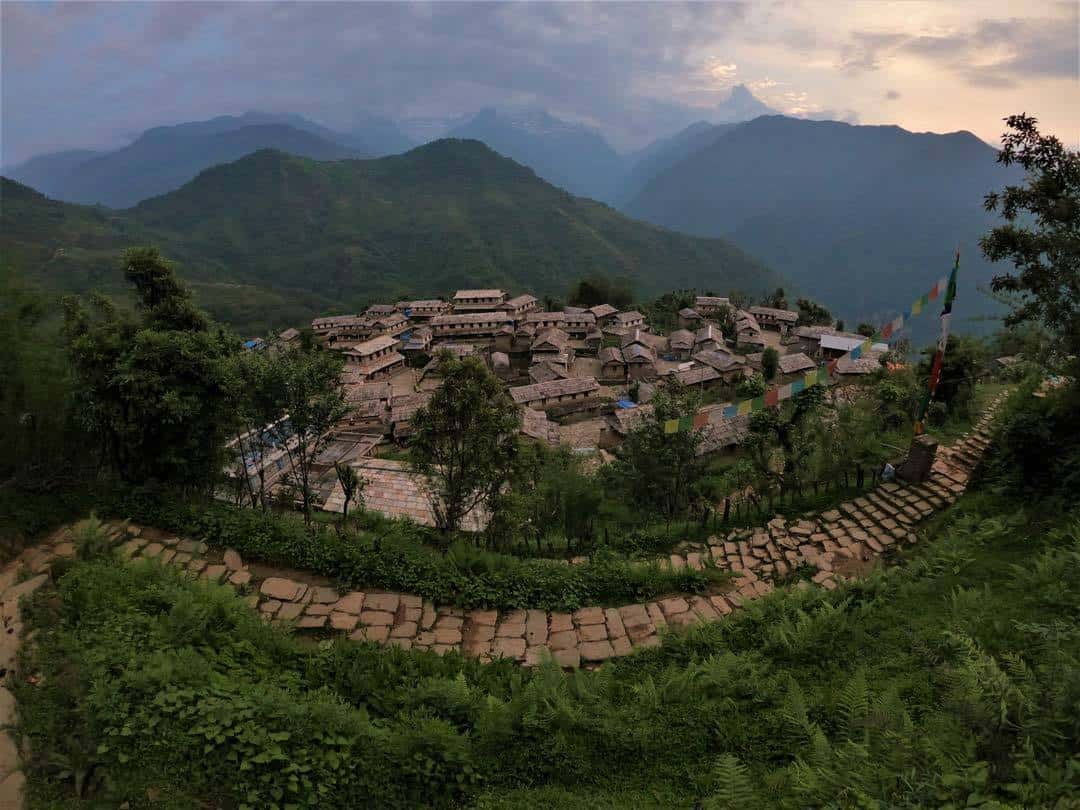
Nepal is arguably the best trekking destination on the planet, and thousands of people flock to this small, landlocked Asian nation every year to head deep into the Himalaya.
While famous hikes such as the one to Everest Base Camp and the Annapurna Circuit bringing in the majority of adventurers looking for extended forays into the mountains, there are a number of shorter hikes that are just as incredible.
I’ve been lucky enough to travel to Nepal quite a few times over the years, and in 2018 returned and managed to tackle the marvellous Poon Hill trek.
Table of Contents
Introduction To Hiking The Poon Hill Trek
What to pack for your hike, day 1 morning – pokhara to hille, day 1 afternoon – hille to ulleri, day 2 – ulleri to ghorepani, day 3 – ghorepani to poon hill, day 4 – ghorepani to ghandruk, day 5 – ghandruk to australian camp, day 6 – australian camp to naudanda, the comedown, how to trek poon hill – guided or independent.
Seeing the Himalaya from a plane I must admit is pretty breathtaking, and I thought that this would be the closest I would ever get to some of the world’s most majestic peaks.
Well I was wrong. Really wrong.
Having previously experienced the Mustang Valley of Nepal, this area we were bound for was completely in contrast to the desolate plains and hills to the west.
We are bound for the Annapurna Conservation Area, a place where everything is lush, waterfalls cascade and mountains glisten with snow and ice.
The Poon Hill Trek is just stunning. Here is my guide on how to trek Poon Hill and all of its surrounds.
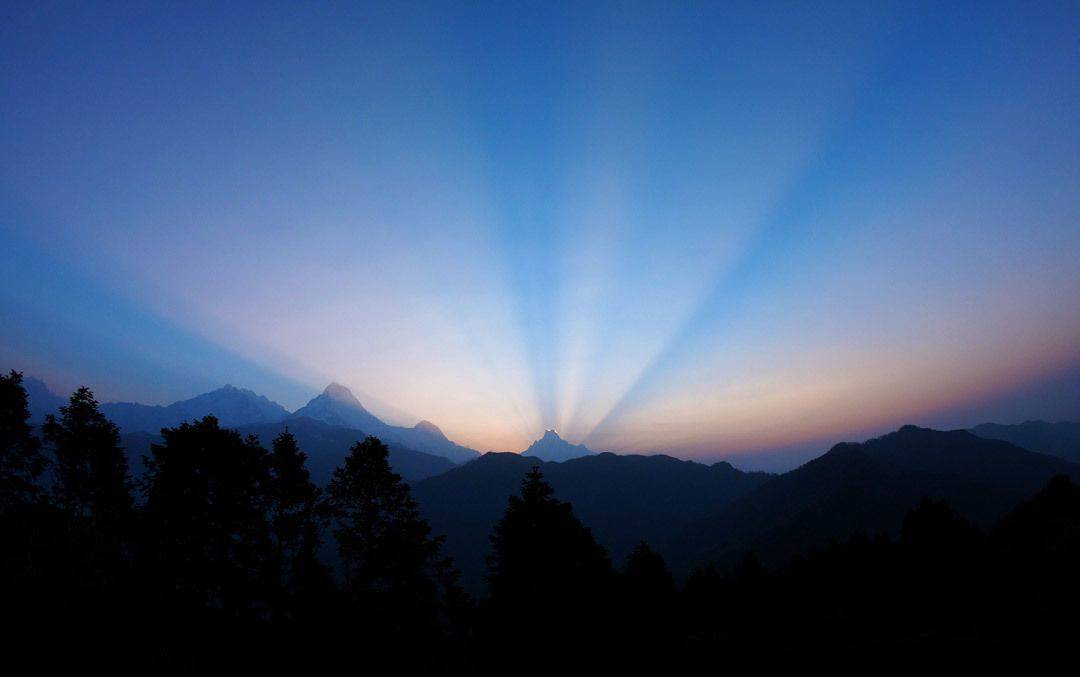
Poon Hill Hike Overview
Here’s a bit of a background information on how to trek to Poon Hill.
- Days Required: 5 to 6 days
- Altitude: 3210 metres (Highest point)
- Best Time To Trek: October to May
- Costs: Depending on whether you choose to use a guide and porters to going alone, the prices will vary drastically.
- Guide and porters: there is no set price where ever you go so negotiations are likely to take place until a price is met.
- Teahouses: prices can vary from teahouse to teahouse but are usually very cheap
- Food: Set menus are in place for many teahouses and are usually cheap.
Besides the basics above, you also need to get some permits.
- Permits: ACAP permit and TIMS card. These both ensure that you are legally trekking and abiding by laws within the area. The general price for a permit is $10 USD. You need to carry both the ACAP and TIMS card on you when hiking and have them checked when an office appears. You can apply for your permits in Pokhara and Kathmandu.
A lot of hardcore hikers think they don’t need a guide or porter, but I highly recommend you get one anyway.
- Guides And Porters: A guide on this trek is a brilliant way to gain further knowledge into the Annapurna Region, but this hike can be done without a guide as tracks are quite straightforward with plenty of maps located at some of the bigger towns along the trail. As for porters, it’s up to you and your fitness; if you choose not to have a guide then you probably won’t need a porter.
It’s important to carry some technical clothing and gear with you when you are hiking in the mountains, and especially in the Himalaya.
The weather can change extremely fast and temperatures can drop to below freezing before you know it. You can buy a lot of (fake) equipment in Nepal.
Because I was coming from Australia, I headed into the local Kathmandu store and stocked up there. They make the best outdoor clothing in Australia and New Zealand, so if you’re from there check with the experts in store.
- Thermal layering including top and pants
- Hiking pants, both long and short, or get convertible pants.
- Waterproof hiking boots
- Quality hiking backpack
- Down jacket – these puffy jackets are essential for keeping your torso warm
- Rain and wind jacket – make sure you get a quality jacket that doesn’t leak
- Sleeping bag and silk liner
- Cold weather gloves – you will need waterproof gloves aswell as a pair of inner gloves to keep your fingers warm
- Plenty of socks (having a pair of dry socks are the best)
- A beanie – keeping your head warm is essential especially at night
- Hiking poles – if you’re not using a porter, hiking poles will help you balance when carrying your bag. They also provide support for your knees.
- Water bottle (2 litres is ideal)
- Sterilization pen or chlorine tablets to keep your water bug free.
My Daily Poon Hill Trek Itinerary
This is a breakdown of what you can expect on the Poon Hill trail, based on my experiences doing it.
You need to get to Pokhara from Kathmandu, and there are daily flights or you can take a 7-hour ride on a local bus.
Once in Pokhara you can organise your trek and head out to the trailhead.
- Time – 2 to 3 hours by bus and jeep
- Start/ Finish – Pokhara / Hille
The next thing we know, the Poon Hill trek from Pokhara had begun as we crammed on board a ‘tourist’ bus while navigating midday traffic in the back streets of Pokhara.
With my head stuck out the window like a dog, it was all happening so quickly, and we were so excited. These things you literally cannot get enough of.
All of a sudden our bus driver steers up a road that is meant to be under construction, but quite frankly it’s just a very wide Khola “creek” which kept speeds down to a very minimum.
Once the bus had reached its destination, still leaving our crew some 20 kilometres from the trail head, a series of jeeps sat waiting for our arrival.
When our bags were bundled to the top of these 1990’s style jeeps we managed to make it a solid 2 kilometres down the hill before becoming stuck on a hair pin corner.
But when you have a team of Nepalese locals and porters becoming stuck is no problem.
Soon enough, there are people standing on the back of the jeep to create extra weight while the driver is revving well into the red zone with reverse placed in gear.
Powered by a fantastic lunch at Birenthanti, which is a junction town situated on the Modi Khola which originates from the Annapurna Himal, we were fuelled up and ready to hit the mountains.
And as the Nepalese would say “ dal bhat power, 24 hour”.
After becoming unstuck and feasting on a fine lunch, it becomes clear of where the trail head will be as the driver hints towards a town situated high up on the Luprung Danda.
My immediate thought was “oh it’s only across the valley; it will take an hour at maximum”. Our jeeps pull up one by one, bags are unloaded and it’s once again time for me to experience Nepal the right way, by foot.
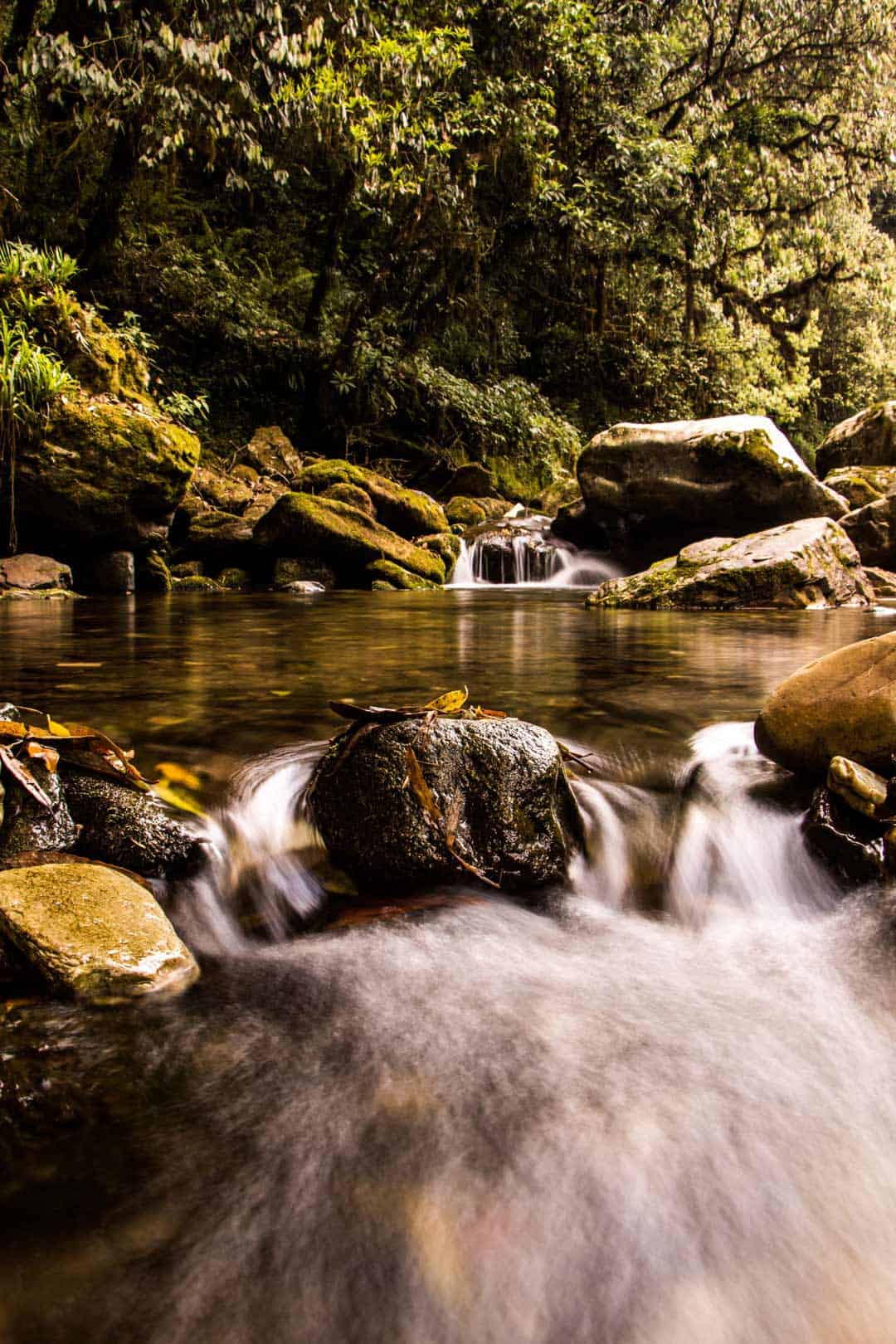
- Time: 2 hours
- Elevation: 600 metres gained
- Start / Finish: Hille/ Ulleri
Our guide, Ram (a common nickname for Nepalese guides) confirms that our night will be spent at the foothills of Luprung Danda which will require a slight incline involving many, many stone stairs.
Immediately waterfalls appeared and cascaded out of dense forest patches, as swing bridges assisted us over Bhurungdi Khola to the lower slopes of Luprung Danda.
From this point, it was all about taking on the stairs one by one, which sometimes was hard to keep one foot in front of the other when views already began to take away my breath away (not the altitude).
Our views were short-lived as a storm passed from the heights of the higher Himalaya turning straight over our heads, leaving our crew to find shelter under a small structure until the storm transited over Nangge Danda.
Not far from Ulleri, a train of mules pass by; taking no interest in my attempts to capture them on film spits of rain begin to collect once again bringing about a light mist shrouding the higher reaches of Ulleri and it looked stunning.
Apparently from here it was possible to see snow capped peaks but that would have to wait until the morning.
Reeling after the continuous rising of stairs, I could have opted for a nap, but there was too much of Ulleri to explore and my anticipation of my long awaited tasting of dal bhat (it had only been 3 hours since lunch) was too close. And that got me excited.
Kamala Guesthouse was our accommodation for the night which was perfectly situated on the slopes of Ulleri. I couldn’t wait for what the views would be like at first light.
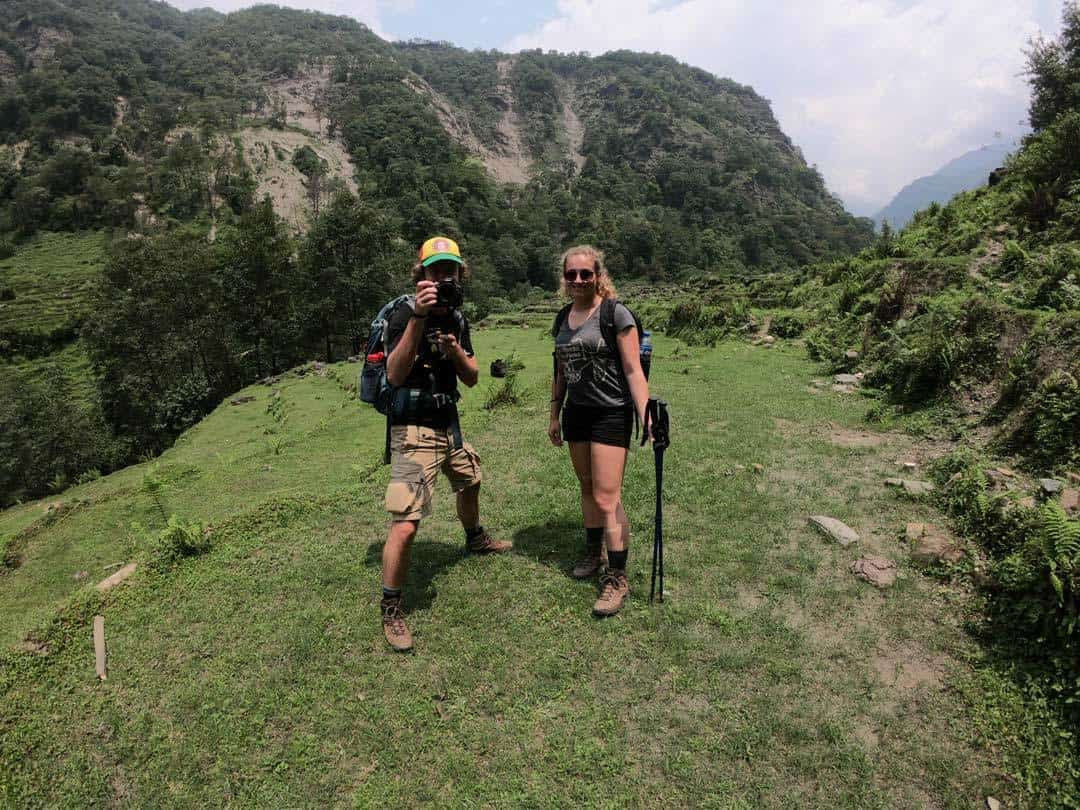
- Time – 5 to 6 hours
- Elevation – 1350 metres gained
- Start / Finish – Ulleri/ Ghorepani
It’s not often you get locked inside your accommodation, and of all the times I wanted to go outside I simply couldn’t unless I did a bit of improvisation which involved cat-like tactics and long arms.
Next thing I know I am walking the cobbled streets of Ulleri to put myself in position for my first sunrise attempt of the trip.
Waking up 3 hours before sunrise certainly didn’t help, considering sunrise was at 7:30 am, which meant I had plenty of time to wander through Ulleri to a few special places.
I caught my first glimpse of the Himalaya with no real idea which mountain was which, but it really didn’t matter.
It was pure magic as I sat on the edge of a corn field, embracing some of the world’s finest alpenglow.
After a solid Nepali breakfast it was time to continue the hike, which would be a day of hiking through Nepal’s famous rhododendron forests that are quite special to the Annapurna Region.
Ram our guide, along with Bodhi the assistant guide, explained where we would be hiking over the next few days, pointing to the higher reaches of Luprung Danda, which looked so far from our current position.
Further along the trail the sounds of Bhurungdi Khola (a raging river) begin to increase, only to realise that the river flowed some 200 metres below us.
It wasn’t until Nangetharti (halfway between Ulleri and Ghorepani) that we crossed back over the river which at the same time provided a stunning spot for a snack and photos.
After another delicious lunch of dal bhat, we entered lush areas of rhododendrons, and although not in flower, the hiking was spectacular and it continued to be so right to the door of our guesthouse named Peace and Excellent View Lodge .
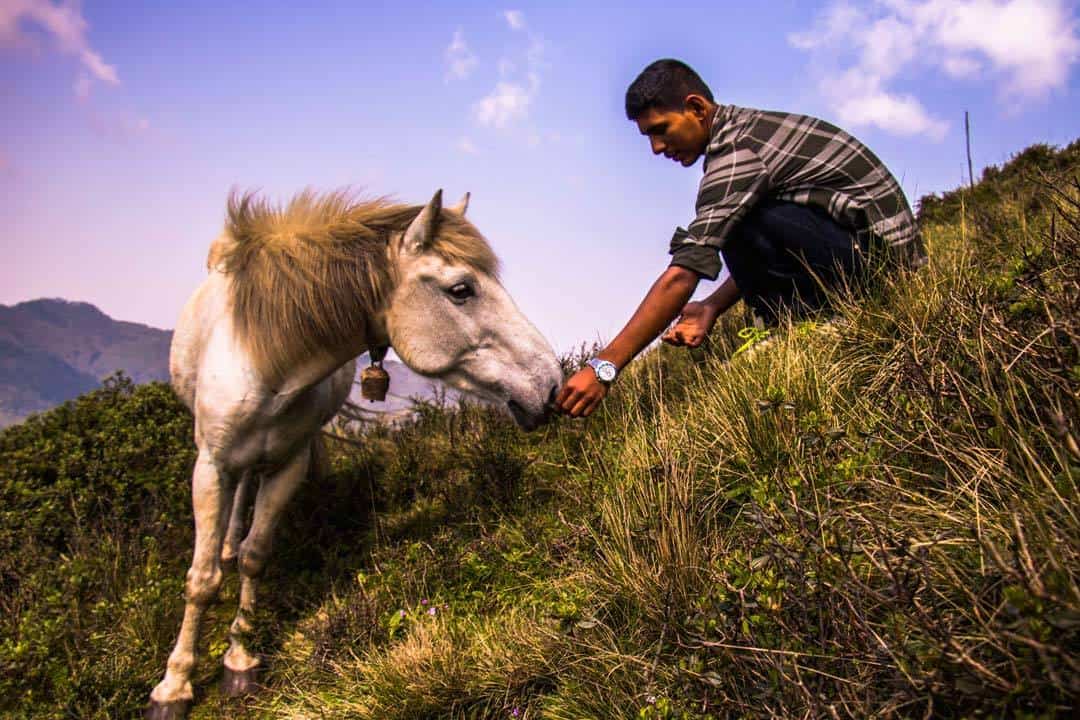
- Time: 30 minutes to 1 hour
- Elevation: 340 metres gained
- Start / Finish: Ghorepani/ Ghorepani
Being based in Ghorepani allowed for a relatively easy trek to Poon Hill to watch sunrise over the Himalaya. Ghorepani to Poon Hill takes about 30-45 minutes depending on level of fitness, and consists mostly of stone stairs.
In order to see one of the best sunrises in Nepal, you’re going to have to rise fairly early – 3:30am is idyllic.
It was worth it, because I never thought that the views from Poon Hill would be breathtakingly amazing!
Although it can be very crowded at the top, there are a few secret spots on either side of the viewing platform which provides a more natural view.
From the top of Poon Hill there are a multitude of mountains to seek including Dhaulagiri, Nilgiri, Annapurna South, Hiunchuli and Machhapuchhare, which are some of the tallest mountains in the world.
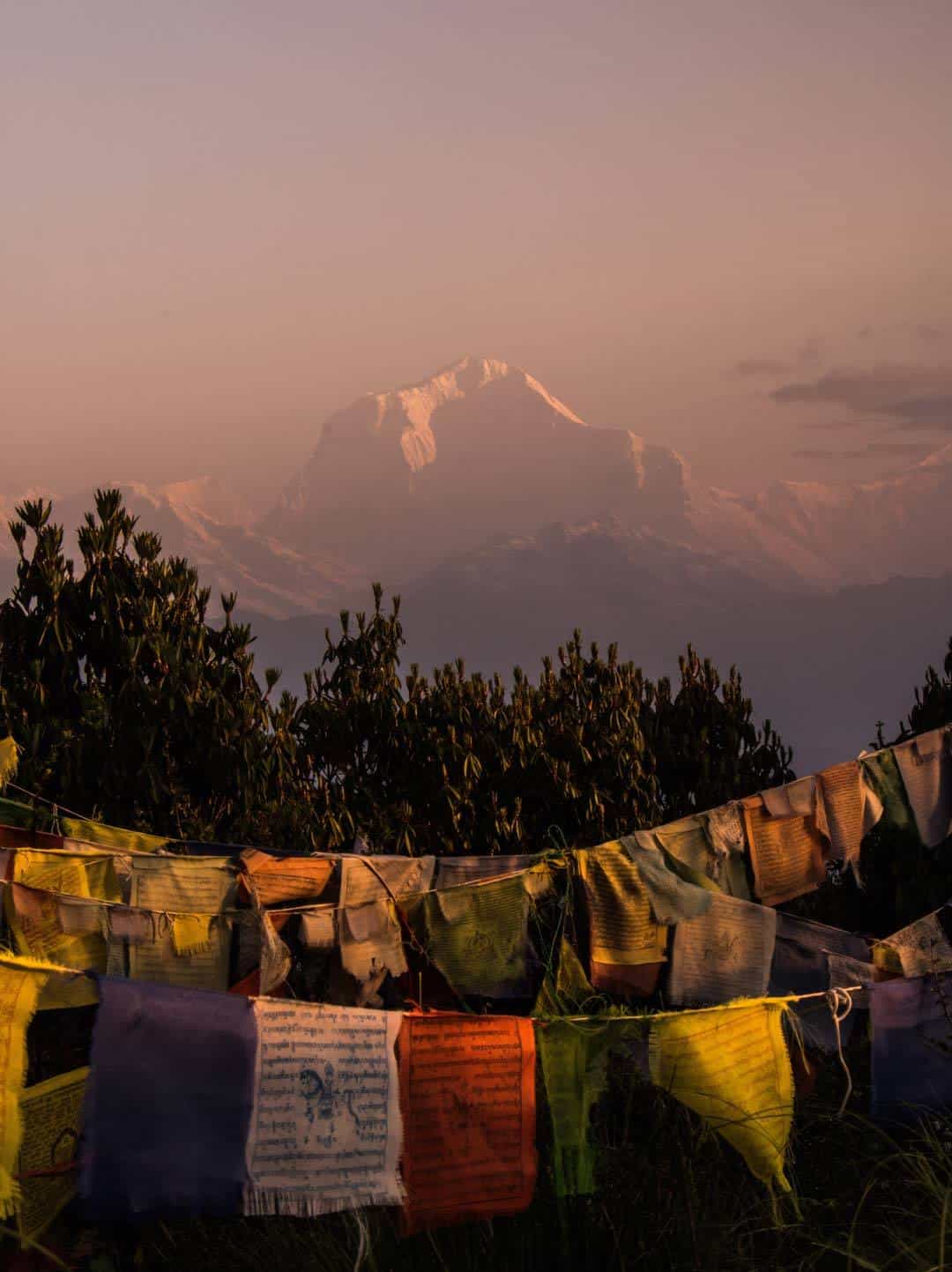
- Time: 7 to 9 hours
- Elevation: 550 metres ascent followed by a 1,440 metre descent
- Start / Finish: Ghorepani/ Ghandruk
After seeing one of the best sunrises of my life on Poon Hill, it was time to hit the trail and head for Ghandruk.
The day starts off from Ghorepani directly followed by a steep ascent to Duerali La about, 45 minutes from Ghorepani.
What’s so cool about Duerali La (‘La’ means pass in Nepali) is that you can see planes flying below you from Pokhara to Jomsom.
All of a sudden the plane disappears into the background where it becomes completely dwarfed by Dhaulagir,i the 7th tallest mountain in the world.
Continuing the hike brings you closer to the ancient, twisted and moss covered rhododendron trees as we enter the ridge lines of upper Luprung Danda.
Unexpectedly a series of 100 or more waterfalls appeared and they were all just magic! It was literally a hiker’s dream seeing pristine, crystal clear water.
Today was the most spectacular and beautiful day by far, and we still had 2 days to go.
Our lunch was spent watching a monkey high up on a cliff face licking some sort of aphrodisiac lichen out of the rocks, but I much preferred my meal of dal bhat and black tea by the litre.
Extremely full from a satisfying lunch, the trail continued downwards to a once hydro plant and to suit, a midday monsoon erupts from the skies making the climb to Tadapani quite exciting!
All of a sudden, our tracks became flooded as the rain continued to penetrate the dense canopy above.
After sheltering at a local teahouse in Tadapani, the rains eased showing a few ridge lines of Annapurna South.
Still some hours from Ghandruk, the trails turned to slosh making it quite difficult to stay on track but things where made easier as we listened to the singing of our youngest porter, Sagar .
Skies slowly began to clear with the odd rumble about the Himalaya; Ghandruk was edging closer as the day had consisted of 6 hours on the trail.
It was clearly time for one of Nepal’s finest Gorkha beers after starting the day at 330am.
Little did anyone know that the views from Ghandruk would be some of the finest in all of the Annapurna, and I’m not just saying that…it was truly amazing and probably the best views you will get on the Poon Hill Trek!
To the left of the vista, Annapurna South connected with Hiunchuli both glowing in the afternoon sun while Ganggapurna and Tare Kang dominated the valley leading to Annapurna Base Camp, and then there was Machhapuchhare and just wow.
All of a sudden, I scramble to pull all of my camera gear together while taking a large gulp of Gorkha beer, because the rest of my afternoon consisted of staring at some of the most beautiful mountains, rice terraces and rolling clouds I had ever seen.
Ghandruk, you are literally the most beautiful place in the world! Simon Guest House you have the best views in the business! So amazing!
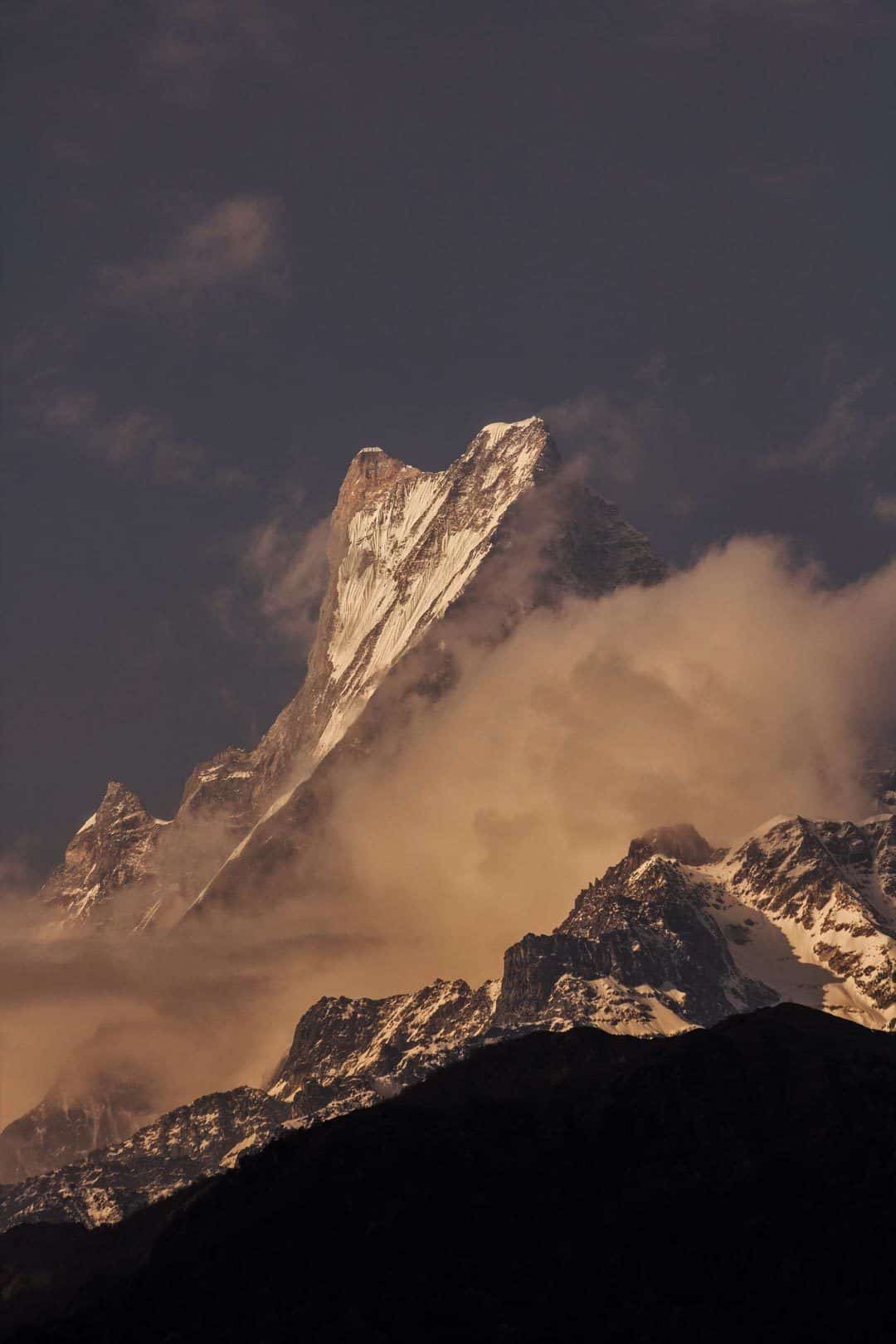
- Time: 7 to 8 hours
- Elevation: 800 metres descent, 550 metres ascent
- Start/ Finish: Ghandruk / Australian Camp
Once again I managed to be the very first person to rise in Ghandruk at the hour of 4:30 am in order to do some exploring before we began hiking again.
Equipped with an extremely oversized lens*, I scrambled out of the hotel onto the cobble stoned streets and made way to Gurung Village some 20 minutes’ walk away.
It was one of the most breathtaking views I have seen as I sat and watched Gurung village from above come to life, listening to the bell of mules followed by a teahouse playing extremely loud Nepali music as a creeping inversion layer began to engulf Annapurna South and Hiunchuli.
On the other end of the scale, Machhapuchhare stood strong as the sun continued to rise, some seriously amazing scenes happened that morning.
Ghandruk is known to be extremely tiring accessing if you are hiking from Modi Khola (river) direction, but getting down to Modi Khola was a tough one.
Stair after stair after stair for 2 hours proved to be a knee killer, but that pain was soon lifted after witnessing some of the happiest school kids on their morning commute to school.
On arriving at Modi Khola, the hardest part of the day was done meaning the rest of it could be enjoyed in comfort despite having to go up another thousand or so steps to Landruk, which is directly opposite Ghandruk except on the other side of the valley.
Landruk provided some stunning views back onto Ghandruk, as well as the surrounding mountains as midday storms began to form.
Shortly before we finished our lunch it began pouring, although soon to clear revealing stunning landscapes.
Some distance into the trek, I came across a lovely Nepali lady who was brewing a fresh batch of Raksi (home brew made from millet) to which she explained to me how she made it and then offered me a coffee cup full of this crystal clear liquid. And it was so delicious!
A short 30 minutes later with keen eyes, I spotted a tree full of white-faced monkeys which soon jumped from tree to tree, quite a spectacle.
Distant rumbles continued to echo throughout the valley as we hiked past rice terraces being ploughed by water buffalo as the sun slowly began to set to the west.
After a quick stop at Pothana to have our TIMS cards checked by officials, it was onto Australian Camp for our last night.
With a cup of Masala tea in hand, water buffalos quickly entered the unused camping ground for a snack of green grass before we ourselves tucked into some fine cuisines under a rainy sky.
As we settled in for the night, rains where upon Gurkhas Guest House with a few faint rumbles of thunder coming down the valley.
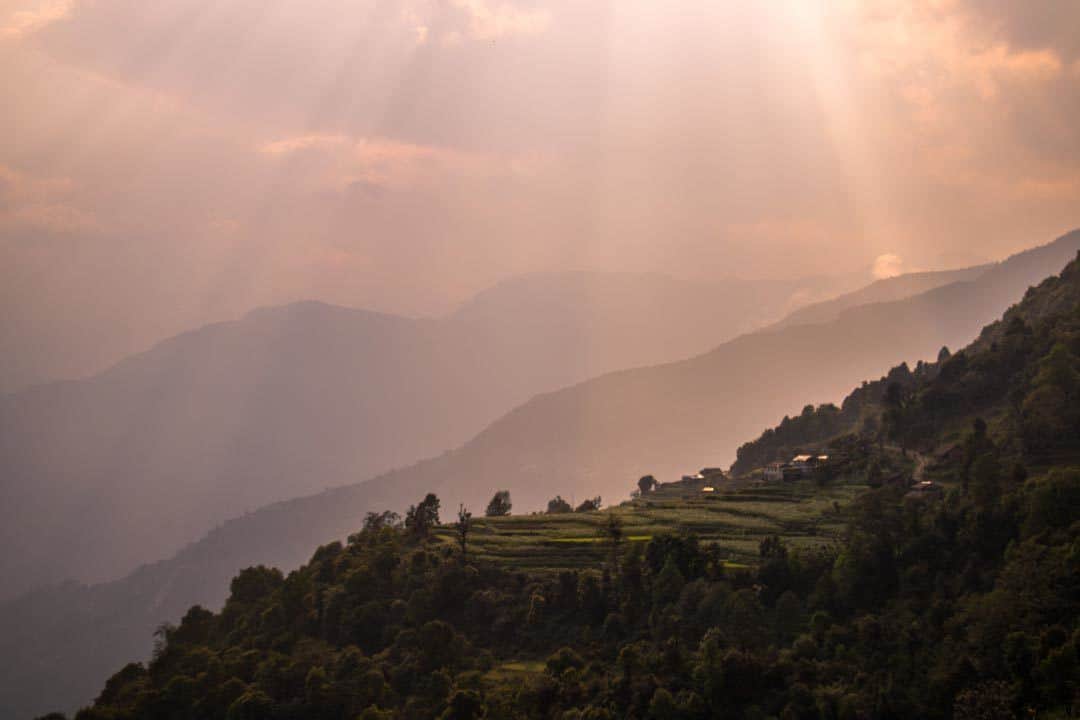
- Time: 2.5 hours
- Elevation: 600 metres descent
- Start / Finish: Australian Camp / Naudanda
For my last morning on the trail, I had planned to rise for a sunrise but the weather had other plans.
Not to dampen my spirits, Tibetan bread was served with a healthy pouring of black tea.
I think the water buffalo could smell just how good the bread was, which resulted in a heard rushing back into the campground to see if they could pinch a bit of our breakfast.
Today there are two options on which route can be taken (dependent on weather conditions) and the weather seemed to be clearing, so it was decided that the so called ‘leech ridge’ would be taken.
Any adventure that involves a dog is a top adventure and we were lucky enough to have two pooches join us, even though both of the dogs had a slight disliking for one another.
They proved to be great guard dogs when a feisty water buffalo got too close.
As the morning rains had passed by, the ground became in sorts a slippery slide which made things super fun!
To our left, Machhapuchhare stood proud and to the right of leech ridge, hills of rice terraces flushed with different shades of green amongst the late morning light.
It would have been 45 minutes before we were scheduled to catch a bus back to Pokhara so Raaj, Sagar (two young porters) and I sat waiting for the rest of the group.
We began talking to an older lady and her husband whose ancestors came from Mongolia, to which she even allowed me to take a portrait of her as her husband stood intrigued by what I had in my hand.
The smiles I received after showing the lady her photo on the small screen were priceless.
Continuing further down towards our pick up point, we had one incredible experience of life in small villages outside of the major city centres.
We watched crops being harvested, children walking the long kilometres to school as cows wandered aimlessly along the cobble stoned streets then suddenly lie down in the middle of the path blocking scooters and passerbys.
After being in the quitter parts of Nepal for the past 5 days experiencing some of the finest views, food and friendly locals it was back to Pokhara with a quick 1.5 hour ride for a well-deserved meal, hot shower and rest.
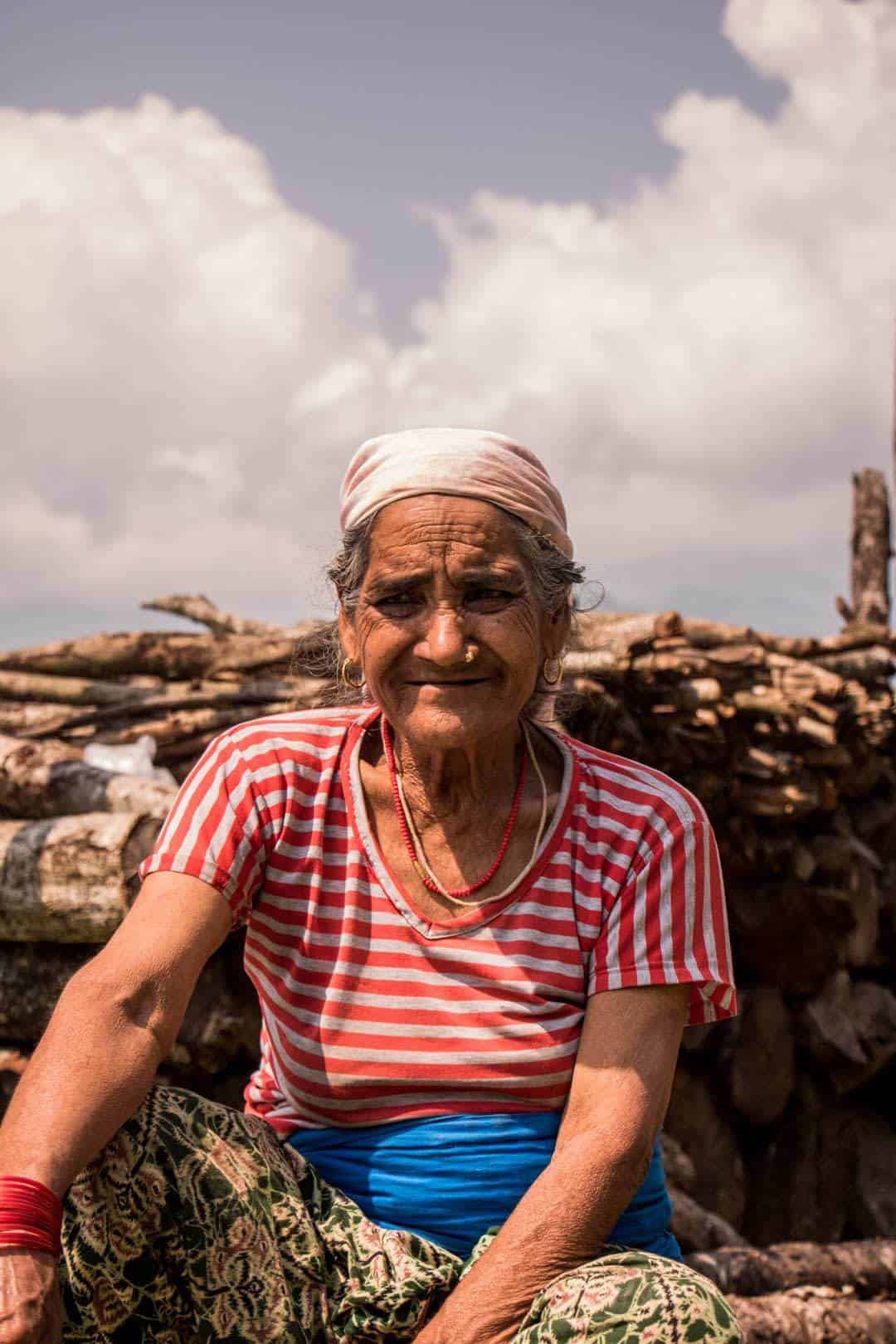
The Poon Hill Trek is one of the most amazing and quite possibly the easiest way to see the Himalaya while also experiencing the teahouse life.
I look back on this trek and realise just how beautiful the scenery is, the smiles of the people, the endless servings of dal bhat and the amount of stairs separating me from point A to point B.
If you want to get a scope for trekking and seeing what Nepal is all about, I would highly recommend doing this trek.
Even if you haven’t done much trekking or if you are the avid day hiker, this could be the start of many adventurous things to come!
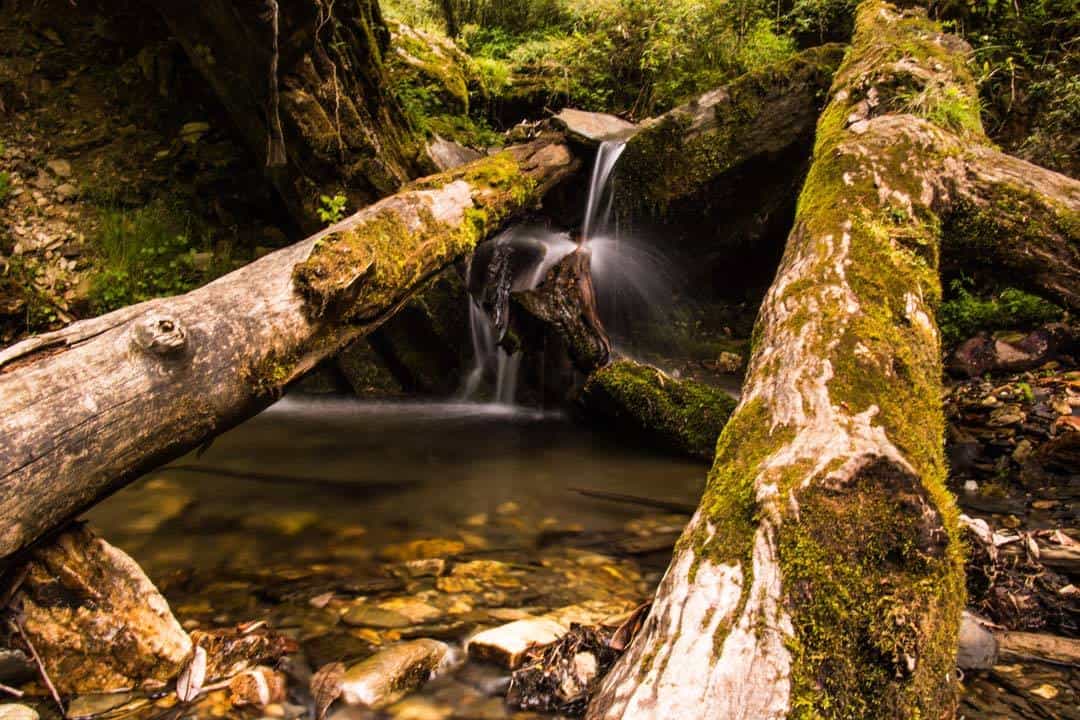
There’s a couple of different ways you can do the Poon Hill trek, depending on your budget, timeframe and hiking experience.
You can either book a fully guided tour from Kathmandu or Pokhara, and this can be a great option if you prefer to have someone else look after the logistics and you want sherpas and an English-speaking guide.
For those of you out there that are really experienced with trekking, it’s always possible to just show up in Pokhara, jump on public transport to the trailhead and then start hiking.
You can book your teahouse accommodation as you go and there’s plenty of places to stop and eat, so all you really need to do is carry money, your clothes, your permits and your camera gear.
I really recommend at the very least hiring a sherpa, even if you don’t think you need someone to carry your gear.
The reason is you are then giving a local job and injecting money straight into the economy, and also because you’ll have some incredible local interactions with them. You’ll learn so much more about the wonderful Nepalese people this way!
Sherpas can cost between USD$15-30 a day, depending on their English skills.
If you want to pre-book your Poon Hill Trek, check out this option on Viator.
Book Your Trek On Viator
[box] I tackled the Poon Hill Trek as a delegate of the Himalayan Travel Mart representing NOMADasaurus. All thoughts, opinions and copious amounts of dal bhat consumed are, as always, my own.[/box]
Calumn Hockey
Hi, We’re Alesha and Jarryd!

We’ve been traveling the world together since 2008, searching for the planet’s best destinations and adventures.
Love Travel?
Sign up for our free weekly newsletter for the best travel tips, ideas and deals!
We respect your privacy. Unsubscribe at any time.
READ MORE...
Getting Around Magnetic Island – ‘How to’ Transportation Guide
The Ultimate GUIDE to the Best MAGNETIC ISLAND BEACHES and Bays
14 Best Day Trips From Reykjavik, Iceland (2024 Guide)
Related Posts
The ultimate guide to skiing in kyrgyzstan (2024 edition), olympos – the jewel of turkey’s mediterranean coast, people of myanmar (burma) – a photo essay, emerald lake lodge – a perfect canadian winter getaway, 6 thoughts on “the ultimate guide to nepal’s poon hill trek”.
The trek looks amazing in the Himalayas.
It does, doesn’t it. We can not wait to get there either.
Just a note – a Porter carries your bags. A sherpa is a member of a particular community. Your porter may be a sherpa but the 2 words are not interchangeable.
Wow what a great trekking adventure. I would love to go to Nepal and experience the country the culture and its people next year. Thanks for sharing your experience and tips.
Calumn wrote a great article for us. We haven;’t been to Nepal yet and would love to one day. It looks absolutely beautiful. Glad you enjoyed the article Jason. 🙂
Leave a comment Cancel reply
Save my name, email, and website in this browser for the next time I comment.
- Skip to content
- Skip to primary sidebar
Full Time Explorer
Nepal Travel Blog
Poon Hill Trek Itinerary – 3, 4, and 5 Days
Trekking in Nepal / December 28, 2021 by fulltimeexplorer / Leave a Comment
The Poon Hill Trek is one of the most popular treks in Nepal due to its short time frame. A common misconception is that it’s an easy trek, however, the Poon Hill trek is surprisingly difficult. Poon Hill is a small hilltop located above the popular village of Ghorepani inside of the Annapurna Conservation Area. It’s located at 3,200 m (10,500 ft), and on a clear day you can see the Annapurna and Dhaulagiri Range. Here’s everything you need to know before setting off on your trip.
Poon Hill Trek Map
Note: This map should not be used for navigational purposes. It is just meant to give an idea of the route and may not be perfectly to scale. Download maps.me on your phone for an accurate offline map that is free to use.
Poon Hill Trek Overview
Trek duration.
The Poon Hill trek can be done in three to four days. While three days is entirely possible, it’s a rushed trek that won’t be very enjoyable. We did the four day route and still found it challenging for a number of reasons. Those who have the time and want a more enjoyable experience should aim for five days.
Poon Hill Difficulty Level
People often think of Poon Hill as an easy trek because it’s only three days long and because so many people do it, but that’s a misconception. The Poon Hill Trek is almost entirely uphill on a steep staircase for the first two days. We met another trekker who turned back on day two. He joked that he was on vacation, and this wasn’t at all relaxing. If you are nervous about the difficulty level, you can add a day to the itinerary to break up the hard parts. Those who are worried about the steep uphill climbs may want to consider hiring a porter to carry your bag as it will make it a lot easier.
Required Permits
This trek requires an ACAP entry permit which costs 3,000 rupees (about $26 USD). You can get this permit at the Nepal Tourism Board office in Kathmandu or Pokhara. You will need your passport and two copies of your passport photo as well as cash.
Trek History
According to locals, the Poon Hill Trek started to become popular in the 70’s and 80’s. It passed through small existing villages which later expanded due to the need for accommodations.
Best Time to do the Ghorepani Poon Hill Trek
All the locals agree that the best time to do this trek is October or November followed by March or April when the rhododendrons are in bloom. This is not a good route to trek in monsoon (May-September) as the small streams become raging rivers, landslides happen along the trekking route, and there are leeches. You can do this trek in the winter however it will be cold at night as there is no heat in the teahouses.
Poon Hill Height
3,200 m (10,500 ft)
Poon Hill Trail Info
The Poon Hill trekking trail starts with a large stone staircase that is steep but manageable if you go slowly. In the areas that aren’t so steep, a wide dirt path runs through the forest. The path is well maintained as it’s one of the more popular trekking routes in Nepal.
Navigating the Poon Hill Trek
While the trail is extremely easy to navigate, I do recommend inexperienced trekkers to take a guide. If you are an experienced trekker and plan to go alone, you can download Maps.me which is a free offline map that shows trekking routes and your live location.
Packing List
I have an entire post for my packing list as it was too long to include in this post. You can check it out here… Poon Hill Packing List
I also have an entire post dedicated to my budget and how much we spent on the trek. You can check it out here… Poon Hill Trekking Cost
Poon Hill Trek Itinerary Options
Poon hill trek 3 days.
A lot of trekking agencies recommend a really difficult three day route to Poon Hill. This itinerary requires taking a jeep past the first major town to save time. Because the jeep will be going off the major highway, it will be more expensive. I only recommend this itinerary for those on a major time crunch as the days are long and difficult. You’ll often leave early in the morning and arrive just before the sun sets. Most of the days are 7 hours of walking (mostly uphill) not including lunch or tea breaks.
Day 1 – Pokhara to Tikhedhungga by jeep. Then, walk to Ghorepani. (6 hours and 30 minutes walking time)
Check road conditions as there are sometimes landslides between Birethanti and Tikhedhungga and you may need to walk part of the way.
Day 2 – Sunrise hike to Poon Hill. Then, walk from Ghorepani to Ghandruk. (9 hours and 45 minutes walking time)
Day 3 – Ghandruk to Pokhara by Jeep.
Poon Hill Trek 4 Days
The four day trek is what we opted to do, and it’s the more popular choice since it gives you more time to enjoy the trek. The main difference between this and the three day trek is that you get to break up the first day.
Day 1 – Pokhara to Tikhedhungga by jeep. Then, walk to Banthanti. (3 hours and 30 minutes walking time straight uphill)
Day 2 – Walk from Banthanti to Ghorepani. (3 hours walking time)
Day 3 – Sunrise hike to Poon Hill. Then, walk from Ghorepani to Ghandruk. (9 hours and 45 minutes walking time)
Day 4 – Explore Ghandruk. Ghandruk to Pokhara by Jeep. Option to walk part of the way back to Pokhara to save money.
Poon Hill Trek 5 Days – Easy Option
If you’ve never gone trekking before, are out of shape, or are not used to walking uphill constantly and are nervous about this trek, you can do a five day variation to make it easier. This itinerary breaks up the first day and the trek from Ghorepani to Ghandruk which is over 9 hours if you include the sunrise trek to Poon Hill. Plus, you’ll get to Ghandruk early enough on day four to explore the picturesque mountain village.
Day 3 – Sunrise hike to Poon Hill and walk from Ghorepani to Tadapani. (6 hours and 45 minutes walking time)
Day 4 – Walk from Tadapani to Ghandruk. (3 hours walking time)
Day 4 – Ghandruk to Pokhara by Jeep
Poon Hill Trek 5 Days – Including Dhampus
If you want to make this trek a little longer, you can add one day going to Dhampus. It’s a long walk, but Dhampus is another popular village with beautiful mountain views. This will mean that day three and four are both long days of walking. You can get a Jeep from Dhampus which will cut down on costs and driving time a little.
Day 4 – Walk from Ghandruk to Dhampus. (8 hours walking time)
Day 5 – Dhampus to Pokhara by Jeep
Poon Hill Trek – Detailed Itinerary Breakdown (4 day itinerary)
Day 1 – pokhara to tikhedhungga to banthanti.
Tikhedhungga Altitude: 1,540 m (5,052 ft)
Banthanti Altitude: 2,210 m (7,250 ft)
Daily Altitude Increase: 670 m (2,198 ft)
Oxygen Concentration: 78% compared to 100% at sea level
Driving Time: 2-3 hours depending on the road conditions and time of year. We went in monsoon and were unable to take the jeep all the way because of landslides. However, there are jeeps that run from Lamdawali up to Ulleri. You just need to walk part of the way to get to them.
Walking Time: 2 hours and 30 minutes from Tikhedhungga to the top of Ulleri. 1 hour from Ulleri to Banthanti. Total time of 3 hours 30 minutes (not including lunch or tea breaks).
Distance: 3 km (1.9 miles) walking distance
Difficulty Level: Very Difficult
Teahouse: Mountain View Lodge in Banthanti
The walk from Tikhedhungga to Banthanti is difficult as it goes almost straight uphill. If you are going in the warmer months, it can also be extremely hot as much of the trail is in the direct sunlight with little reprieve from trees. It’s important to have enough water with you and a good sunscreen. I’d also recommend some electrolytes to stay hydrated.
The good thing about this route is that there are tons of places to stop and rest along the way including many teahouses. The route is well maintained and the uphill sections are stairs made out of large rocks. The route up to Ulleri is the hardest, but it’s not as steep going to Banthanti.
Day 2 – Banthanti to Ghorepani
Ghorepani Altitude: 2,880 m (9,448 ft)
Oxygen Concentration: 72% compared to 100% at sea level
Walking Time: 2 hours from Banthanti to Nangge Thanti. 1 hour from Nangge Thanti to Ghorepani. Total walking time of 3 hours (not including lunch or tea breaks).
Distance: 6.6km (4.1 miles)
Difficulty Level: Moderate
Teahouse: Nice View Lodge
Most people walk from Tikhedhungga to Ghorepani in one day, but it’s not at all enjoyable. By splitting it up, you can have an easy second day. Most of day two is a nice trail going through beautiful woods. You have protection from the sun and get to enjoy passing streams and listening to nature. This was my favorite part of the walk. It is longer in distance but the uphills are not so steep and you can take your time walking it.
You’ll likely get to Ghorepani before lunch and have most of the day there to hang out. Ghorepani is a fairly modern village with a lot of amenities like hot water, bookstores, small shops, and bakeries. You can take a hot shower, hang out and read a book while drinking a cappuccino. It’s not a bad place to spend a little extra time.
Day 3 – Ghorepani to Poon Hill to Ghandruk
Poon Hill Altitude: 3,193 m (10,475 ft)
Ghandruk Altitude: 2,012 m (6,601 ft)
Daily Altitude Increase: 313 m (1,029 ft) up to Poon Hill
Oxygen Concentration: 69% compared to 100% at sea level
Walking Time: 1 hour up to Poon Hill. 40 minutes down to Ghorepani. 5 hours from Ghorepani to Tadapani. 2 hours and 45 minutes from Tadapani to Ghandruk. Total walking time 9 hours 30 minutes (not including breakfast, lunch, tea breaks, or time to take photos at Poon Hill)
Distance: 11.25 km (7 miles)
Hotel: Danda Gaun Hotel
Day three is a long and difficult day. Typically, when trekking in Nepal, you go to viewpoints before the sun rises to ensure a better view as that is when the sky is the clearest. This means leaving your teahouse around 4:30 am to climb to Poon Hill. The route is completely uphill on a stone path. You’ll get there around 5:30 am and have a half hour for photos and to see the sunrise (check the sunrise time with locals as it varies throughout the year). The entry fee to Poon Hill is 100 rupees and there is a tea stand at the top, so bring cash with you.
After the sunrise, it takes about 30-40 minutes to come back down to Ghorepani where you can have breakfast. Make sure to order it the night before so that it’s ready when you arrive. You should be back to Ghorepani by 6:45a m. After you eat breakfast and pack, you should leave for Ghandruk no later than 8:00 am so that you can be in Tadapani at 1:00pm for lunch. If you are really tired when you arrive, you can opt to spend a night in Tadapani.
When you leave Ghorepani, there’s a slight uphill climb to start which offers nice views on a clear day. After you reach the small village of Deurali, you’ll walk along a small river with beautiful waterfalls along the way. We went during monsoon and had to walk a little slow because parts of it are a steep downhill on slippery rocks. The route is absolutely gorgeous though and is my favorite part of this trek.
After the small village of Ban Thanti (a different Ban Thanti than the one you slept in), you’ll go through the jungle with a lot of up and down hills. Some of the route is steep making it more difficult. From there you’ll arrive in Tadapani where you should eat lunch before moving on.
After Tadapani, it’s a small trail through the jungle with a moderate slope which isn’t too difficult. This lasts over an hour until you reach a stone trail that wraps around the outside of the hills. From here you can see Ghandruk in the distance and it’s about an hour walk to “Old Ghandruk”. Overall, this day is difficult because it is so long. We arrived at Ghandruk around 5:00pm and were completely exhausted.
Day 4 – Ghandruk to Pokhara by jeep
Driving Time: 2-3 hours depending on the road. It took us a little longer to get back to Pokhara because there had been a landslide that took out part of the road. They were literally rebuilding it, and we had to park and wait for 45 minutes. We went in monsoon (not recommended), so this likely won’t be an issue other times of the year.
Since you don’t have to walk anywhere, I’d highly recommend spending a little time in the morning walking around Ghandruk. This village is super cute and full of character. There are even two museums in the town which focus on the village’s history and on Gurung people who are native to the area.
Poon Hill Trek Village Guides
Tirkhedhunga Village Guide
Ghorepani Village Guide
Ghandruk Village Guide
You might also like…
Michelle della giovanna.
Writer at Full Time Explorer
I’m just your average New Yorker who quit her job in the fashion industry to explore the world. Come find out what it’s like to trade in five-inch heels for squat toilets.
- Visit Twitter account (opens in a new tab)
- Visit Facebook account (opens in a new tab)
- Visit Instagram account (opens in a new tab)
- Visit Pinterest account (opens in a new tab)
This website uses affiliate links. This means that I may receive a small commission (at no extra cost to you ) if you purchase something through these links. I only link to products and companies that I love. Those companies, in return, reward me for connecting them to you .
Full Time Explorer LLC is a participant in the Amazon Services LLC Associates Program, an affiliate advertising program designed to provide a means for sites to earn advertising fees by advertising and linking to Amazon.com.
Reader Interactions
Leave a reply cancel reply.
Your email address will not be published. Required fields are marked *

Poon Hill Trek – Ultimate Guide to Small Annapurna Circuit
The Poon Hill Trek is a popular and breathtaking trekking route in the Annapurna region of Nepal. It is known for its stunning mountain vistas, diverse landscapes, and rich cultural experiences. This trek takes you through beautiful rhododendron forests, terraced fields, and charming villages, offering a perfect blend of nature and culture.
Poon Hill Trek Overview
Poon Hill Trek is a popular trek in Nepal that takes you through beautiful rhododendron forests, terraced fields, traditional villages, and offers panoramic views of the Himalayan mountain range, including Annapurna and Dhaulagiri peaks.
The trek is typically completed in 4-7 days, Depending on starting and ending in points. The highest point of the trek is Poon Hill, which offers stunning sunrise views over the Himalayas.
The highlight of the Poon Hill Trek is reaching the viewpoint of Poon Hill, which offers panoramic views of the Annapurna and Dhaulagiri mountain ranges, including iconic peaks such as Annapurna I, Annapurna South, Dhaulagiri, and Machhapuchhre (Fishtail). The sunrise view from Poon Hill is particularly breathtaking, with the golden rays of the sun illuminating the snow-capped peaks, creating a magical spectacle.
The trek is considered moderate in difficulty, suitable for both beginners and experienced trekkers. The highest altitude reached during the trek is around 3,210 meters (10,532 feet), making it a great option for those looking to experience high-altitude trekking without extensive acclimatization.
Required Permits:
An Annapurna Conservation Area Permit (ACAP) is required for the Poon Hill Trek, which can be obtained in Kathmandu or Pokhara. Additionally, a TIMS (Trekkers’ Information Management System) card is also required, which can be obtained in Pokhara.
Accommodation:
Tea houses, also known as guesthouses or lodges, are available along the trail for accommodation. These basic lodges provide simple meals and twin-sharing rooms with basic facilities such as beds, blankets, and shared bathrooms. Hot showers and Wi-Fi may be available at an additional cost.
It’s recommended to carry a sleeping bag as the temperature can drop significantly at night, especially during the winter months.
Packing List:
- Clothing : Layering is key, as the weather can change quickly in the mountains. Pack warm clothes, including a down jacket, thermal inner wear, waterproof and windproof outerwear, trekking pants, hiking boots , socks, gloves, and a hat.
- Equipment: Bring a good quality backpack , trekking poles , sunglasses, sunscreen, water bottles, headlamp, and a first aid kit with essential medications.
- Food and Water: Carry snacks, energy bars, and a reusable water bottle. Avoid drinking untreated water and use water purification tablets or a water filter to ensure safe drinking water.
- Miscellaneous: Don’t forget to bring a camera, chargers, cash (Nepalese Rupees), a trekking map, and travel insurance.
Trekking Itinerary for Poon Hill Trek 5 days
- Day 1: Nayapul to Tikhedhunga (1st day of trekking)
- Day 2: Tikhedhunga to Ghorepani (2nd day of trekking)
- Day 3: Ghorepani to Poon Hill (early morning hike for sunrise view) and then to Tadapani (3rd day of trekking)
- Day 4: Tadapani to Ghandruk (4th day of trekking)
- Day 5: Ghandruk to Nayapul and drive back to Pokhara (5th day of trekking)
Tips for a Successful Poon Hill Trek:
Acclimatization:.
Take time to acclimatize to the altitude and avoid ascending too quickly to prevent altitude sickness. Stay hydrated, eat well, and listen to your body. If you experience symptoms of altitude sickness, such as headache, dizziness, nausea, or difficulty breathing, descend to a lower altitude immediately and seek medical attention if needed.
Weather Conditions at Poon Hill:
Be prepared for changing weather conditions, including cold temperatures, rain, and snow. Check the weather forecast and pack accordingly.
Trekking Guides and Porters:
Hiring a local guide or porter is mandatory as per Nepal Government’s Law starting from 1st of April, 2023. A guide can provide valuable information about the local culture, flora, and fauna, and a porter can carry your heavy backpack, allowing you to trek more comfortably.
Physical Fitness for Poon Hill Trek:
Poon Hill Trek is considered moderate in difficulty, but it does require a good level of physical fitness. Prepare yourself with regular exercise, such as walking or hiking, before the trek to build stamina and endurance.
Trail Etiquette:
Respect the local culture and traditions. Be polite and friendly to the locals you encounter along the trail. Always ask for permission before taking photographs of people or their belongings. Avoid littering and use designated trash bins or carry out your waste.
Food and Water:
Stick to hygienic food practices and avoid raw or undercooked food. Drink boiled or purified water to prevent waterborne illnesses.
Safety and Preparedness:
Stay on the marked trail and avoid shortcuts. Be aware of the weather conditions and follow the instructions of your guide, if hired. Carry a comprehensive first aid kit with essential medications and know how to use them. Have a contingency plan for emergencies and inform someone about your trekking plans.
Cultural Experience:
The Poon Hill Trek offers a unique opportunity to experience the local culture of the ethnic communities along the trail, such as the Gurung and Magar people. Interact with the locals, learn about their customs, try local cuisine, and immerse yourself in the rich cultural heritage of the region.
Conclusion:
The Poon Hill Trek in Nepal is a beautiful and rewarding trek that offers stunning mountain views, cultural experiences, and a chance to immerse yourself in the Himalayan wilderness. With proper preparation, including obtaining the necessary permits, packing the right gear, and following safety guidelines, you can have a safe and memorable trekking experience in this beautiful region of Nepal.
Resources: Poon Hill Trek Website
Share this:
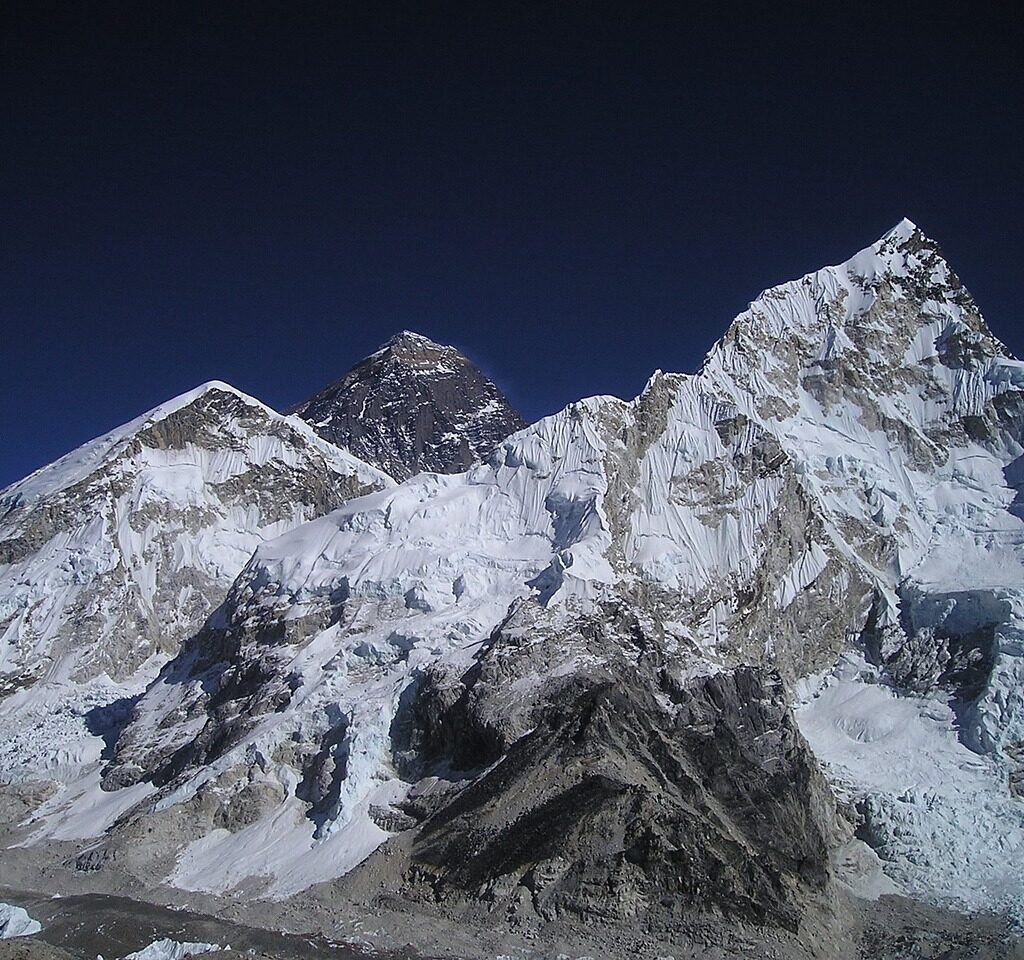
4 Questions Asked About Everest Base Camp Trek

Poon Hill Trek: A Journey to the small summit of the Annapurna Region
Leave a comment cancel reply.
Your email address will not be published. Required fields are marked *
Save my name, email, and website in this browser for the next time I comment.
Notify me of follow-up comments by email.
Notify me of new posts by email.
Sign up for our newsletters
The best of hiking news, in your inbox.

- Best Hikes In The World
- Appalachian Trail
- European Hikes
- Nepal Hikes
- Patagonia Hikes
- See All Hikes
- Mount Kenya
- Mount Kilimanjaro
- Mount Toubkal
- See All Mountains
- South Africa
- New Zealand
- Switzerland
- United Kingdom
- Packing Lists
Ghorepani Poon Hill Trek – The Best View Of The Annapurna Himal
Asia , Nepal
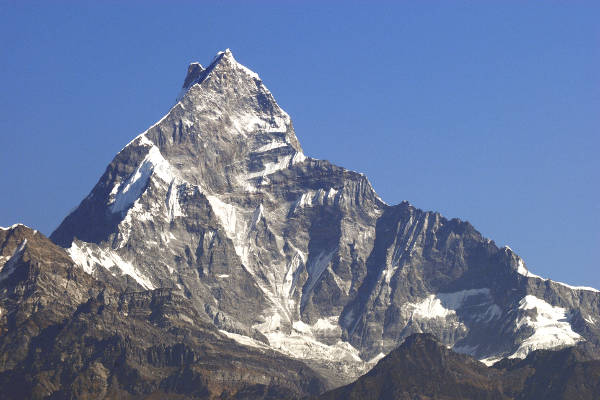
The Ghorepani Poon Hill trek (aka the Poon Hill Trek) is generally regarded as one of the best short treks in Nepal .
Classic treks in Nepal generally require two or three weeks of your time, but one of the great things about the Ghorepani Poon Hill trek is that it can be accomplished in as little as four days, however, most people take five days.
Ghorepani Poon Hill Trek
Several factors contribute to the Poon Hill Trek's popularity: it requires only moderate fitness and is one of the least physically-demanding of Nepal’s treks, making it ideal for families or retirees; there is little risk of altitude sickness (highest altitude is 3,210m); and the accommodation, in the shape of family-run tea houses , is of good quality, so there is no need to cart around tents, sleeping bags (although we do recommend you take a sleeping bag for extra comfort and warmth) and food.
Apart from being a great introduction to trekking for non-trekkers, as well as providing a fantastic experience for those with little time, the main drawcard of the trek is the beauty and diversity of the scenery: one minute there is lush vegetation, the next, terraced rice fields and then alpine areas. All along the trek, the highly attractive fluted peak of Machhapuchhare (Fishtail Peak) dominates the skyline.
Upon reaching Poon Hill, you will be faced by one of the most spectacular mountainscapes on Earth. Poon Hill is 3,210 metres high, and the view at sunrise is a joy to behold, justifying each and every gruelling step you took to get there. From the top of Poon Hill, the snow-capped summits of the Himalayan giants (Dhaulagiri and Annapurna I) are both more than 8,000 metres high, can clearly be seen in addition to many other peaks. When the sun’s rays strike the mountains, they glow like gold.
Having the Himalayas so close, virtually on your doorstep, is breathtaking.
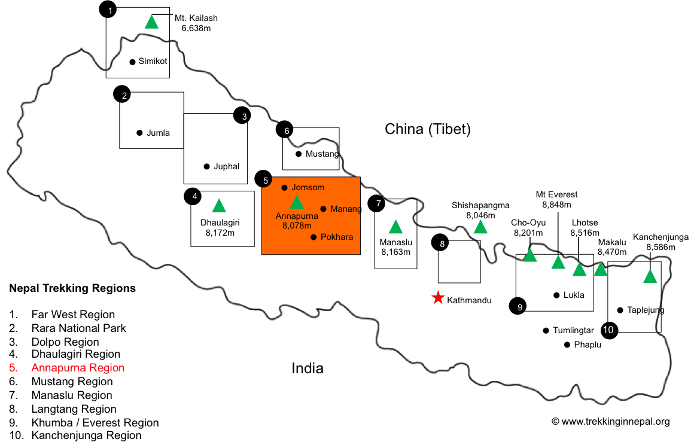
Annapurna Regional Map
The Ghorepani Poon Hill trek is in central Nepal, in the Annapurna region. The nearest big town is Pokhara (see map above).
Recommended Map
Unfortunately, there aren’t many great maps available online. The best schematic we have found is above, from Globe Trekker.
There are, however, some good trekking maps of the Annapurna region that you can purchase online.
Annapurna Map by National Geographic is a detailed trekking map for routes from Pokhara along the Marsyandi River, Thorung Pass, and the Kali Gandaki River in the Annapurna Conservation Area.
We also recommend by Ian P Johnson and Around Annapurna 1: 125 000: Annapurna Conservation Area – Annapurna Sanctuary . It includes detailed trails, walking distances and altitudes.
In terms of a single detailed map we recommend the Himalayan MapHouse’s New Annapurna Trekking Trails Map , which can be bought in Kathmandu, Pokhara or on Amazon UK here (unfortunately it is not on Amazon US yet).
We have also provided links and recommendations to new guides and maps below.
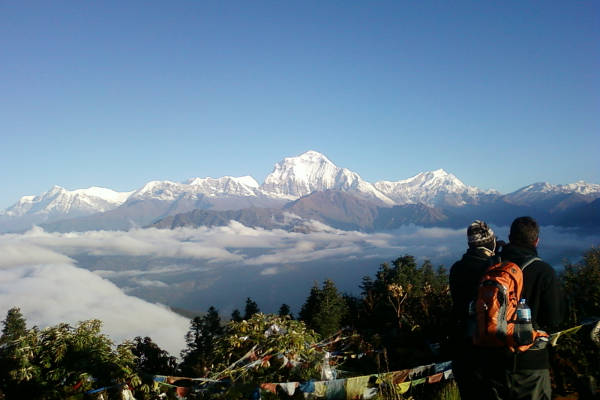
Poon Hill Trek Itinerary
Most people fly from Kathmandu to Pokhara to begin the Ghorepani Poon Hill trek. Flights leave regularly, although weather interruptions / delays are common. The flight takes approximately 30 minutes and will set you back between US$70-US$100. Make sure to sit on the right-hand side on the way from Kathmandu to Pokhara as the views are exquisite. Sit on the left-hand side on the way back.
If you want to save money, you can catch a tourist bus from Katmandu which generally takes 6-8 hours (depending on the condition of the roads and police checkpoints). Expect to pay 300-400 Rupees (~US$6).
Day 1: Pokhara – Nayapul – Tikhedunga
Trekking begins at Nayapul Crossing – the suspension bridge over the Modhi Khola river – following a pleasant one-hour drive from Pokhara. You can either catch a bus or get a taxi (~1,500 NPR) from Pokhara to Nayapul. The Modi Gorge is home to hundreds of bird species.
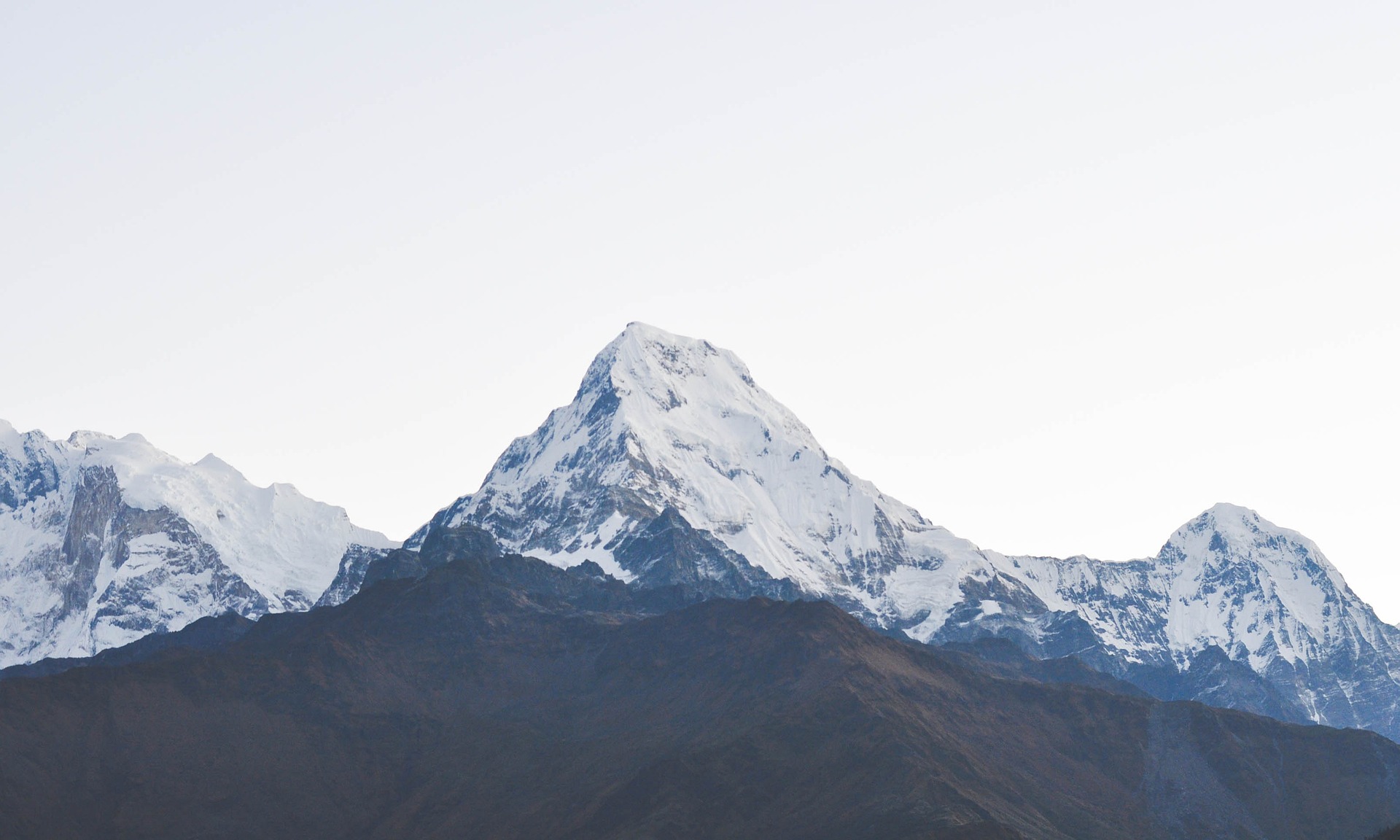
Day 2: Tikhedunga to Ghorepani
On the second day, you will walk, mostly through woods including the world’s largest rhododendron forest, until, after negotiating around 3,500 stone steps at Ulleri Hill, you reach the Ghorepani Village base camp. The name means “horse water” and it was so-called because many ponies would often take water there on their way to or from Tibet.
Ghorepani is festooned with closely packed rhododendron trees, which is appropriate enough given that the rhododendron is the national flower of Nepal. These forests are at their most beautiful when they bloom in spring, bearing red flowers. Around 7-8 hours will be given to walking on day 2, and the first great views of the Annapurna range will be seen on this day.
Day 3: Ghorepani to Ghandruk
The third day commences at dawn (approximately at 5am) in order to catch the first ray of sunlight on Poon Hill. The walk from Ghorepani to Poon Hill takes about 45 minutes. During high season (April-May, Oct-Nov) there are sometimes up to 300 trekkers on this section of the trail. Poon Hill is 3,210m above sea level and marks the highest point on the trek.
From the top, you will experience that view, all 360 degrees of it! Mountains stretch as far as the eye can see – 30 of the devils. The tallest are Annapurna (26 545 feet), Annapurna South (23,684 feet), Dhaulagiri (26,795 feet), Hiunchuli (21 132 feet), Lamjung Himal (22 707 feet), Machapurhre (22 943 feet), Nilgiri (22 769 feet) and Tukuche (22,703 feet). This is a sight you will remember to your dying day.
After spending a good hour or two at the top of Poon Hill, you will descend back to Ghorepani, where you will encounter the green landscapes, local birds, rocks, waterfalls and wild animals you might have missed due to poor visibility on the way up.
After Ghorepani, you will descend to the beauteous Gurung village of Ghandruk, home of the Gurkhas, which sits in the lap of the Annapurnas, foothills of the Himalayas. The Gurungs are one of Nepal’s largest ethnic groups and they have their own dialect, clothing and lifestyle. This village is well-known for its traditional houses, rich culture and great landscape, but it also has an incongruously respectable internet service. If you choose not to partake of the culture at first hand, there is a museum dedicated to it, which is well worth the visit.
Day three is a fairly long affair – approximately 10-12 hours (including time spent at Poon Hill).
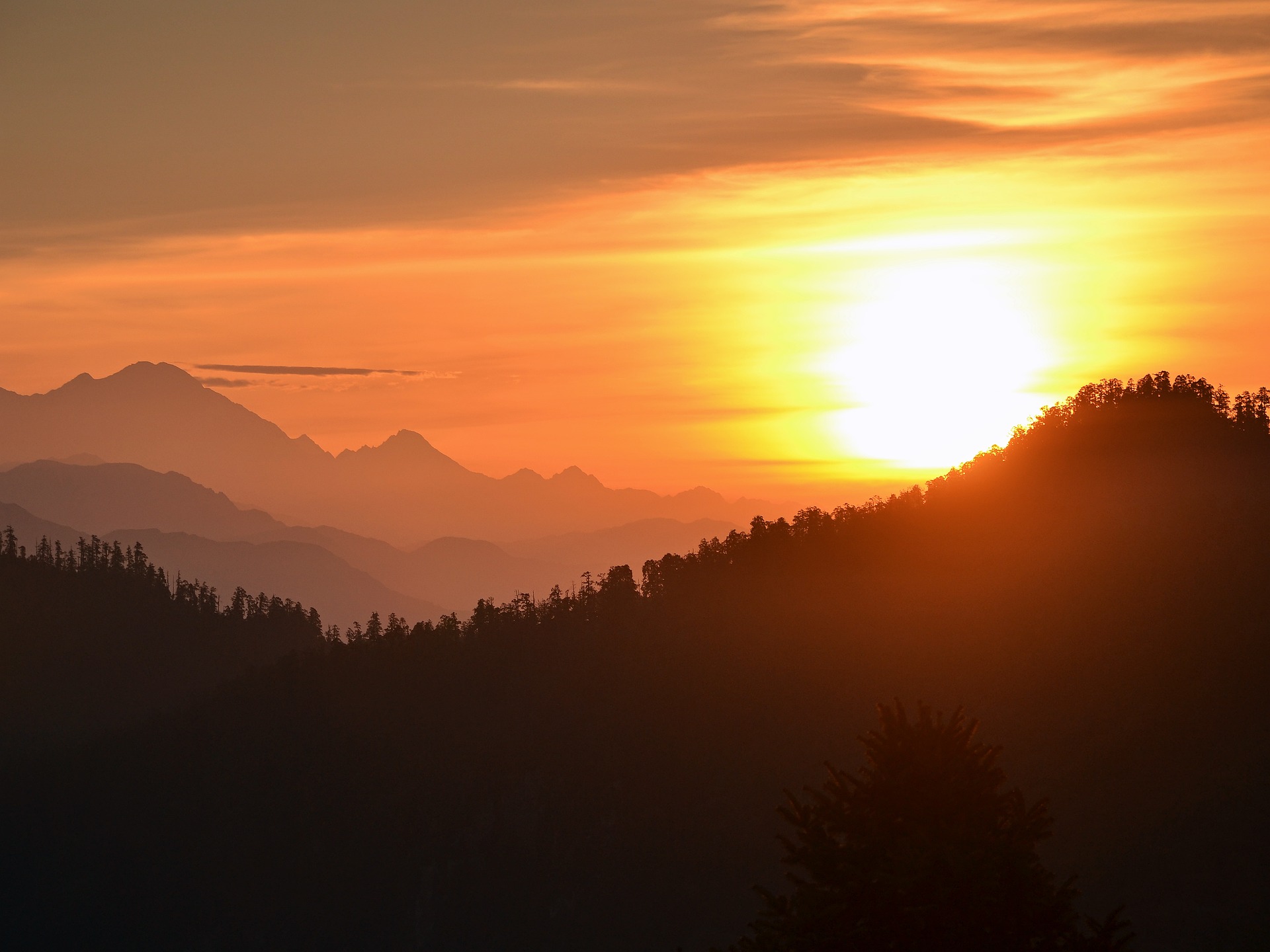
Day 4: Ghandruk to Deurali
On day four, you descend rapidly through forests, which will take its toll on your knees (good idea to have trekking poles for this section of the trek). The trail eases after three-and-a-half hours’ walking. You will end the day at the small village of Deurali, which sits at the end of a forested path, and is in fact not far from a road that could take you back to Pokhara if you were pushed for time.
Total trekking time on day 4 is 8-10 hours. The Hotel Trekkers Inn in Deurali is a cheap and cheerful place to rest your head.
Day 5: Deurali back to Pokhara
The fifth day takes you to a permit check point at Pothana, where there is road access and you can get a taxi back to Pokhara. Some trekkers continue on to the Annapurna Eco Lodge where you can overnight or catch a taxi back to Pokhara via Nayapul. The trek on this day is short (4-5 hours) and mostly across flat land.
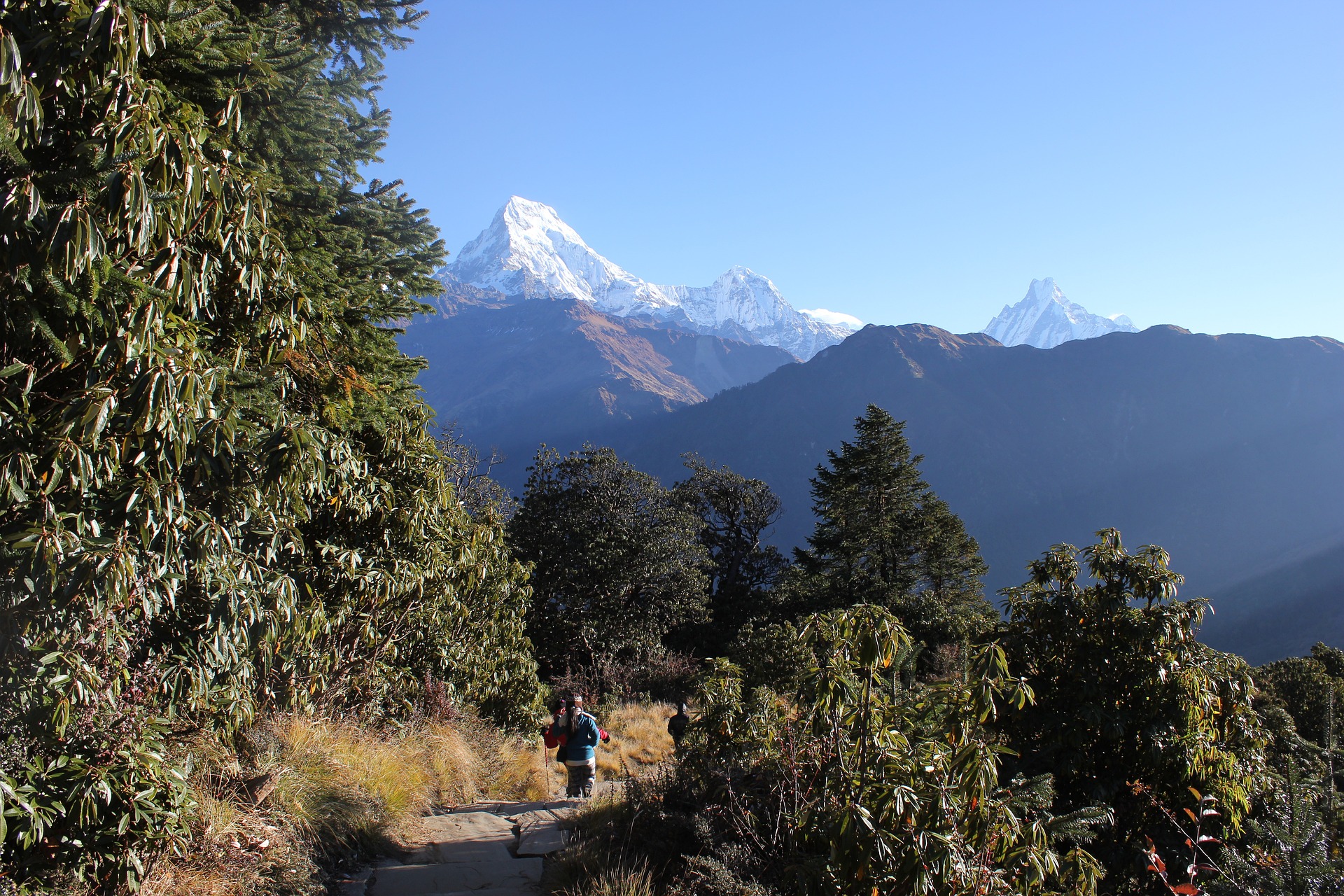
Poon Hill Hike FAQ
How much does the poon hill trek cost.
The cost of a Poon Hill Trek is about $1000 per person . This includes transportation, travel documents, accommodation, food and drinks, hiking gear etc. The cost is ultimately determined by which tour option you choose.
There are essentially three ways to do the Ghorepani Poon Hill trek:
- Unassisted (i.e. no guide or porter)
- Assisted (with a guide and/or porter) and
- With a tour operator
Costs vary depending on which way you choose to organise your trek but generally the following costs can be expected:
- Flights to and from KTM-Pokhara: US$150
- Taxis to and from Pokhara-Nayapul: US$30
- Teahouses (Average of 350 Rupees per night for 5 nights): US$20
- Food (Average of 300-400 Rupees per meal / 15 meals): US$50
- Water (Average of 3 litres a day at 60 Rupees a litre / 15 litres in total): US$10
- Permits (Annapurna Conservation Permit + TIMS Trekking Permit + Commission): US$35
- Guides / Porters (US$25 per day for a guide, US$15 for a porter): US$200
- Rentals of gear (assume US$50 on average): US$50
- Spare cash for miscellaneous things: US$50
- US$600-700 per person on average
You could shave this down to US$200 per person if you went unassisted, used a bus to get to Pokhara and budgeted carefully through-out. You should expect to pay closer to US$900-1300 per person (including airfare and accommodation in KTM and Pokhara) if you used a Nepal trekking company to organise the full tour. If you would like a recommendation on a tour company, check out this article on finding the best trekking agency in Nepal .
Are permits required for the Poon Hill hike?
Yes, two permits are required to undertake the Ghorepani Poon Hill trek: the Annapurna Conservation Permit , costing 1,000 Rupees per person (an earth-shattering US$12), and the TIMS Trekker’s Permit, which will set you back 1,825 Rupees (US$18 per person). These can be secured for you by your guest house or tour operator, who will generally charge a commission fee of 500 Rupees.
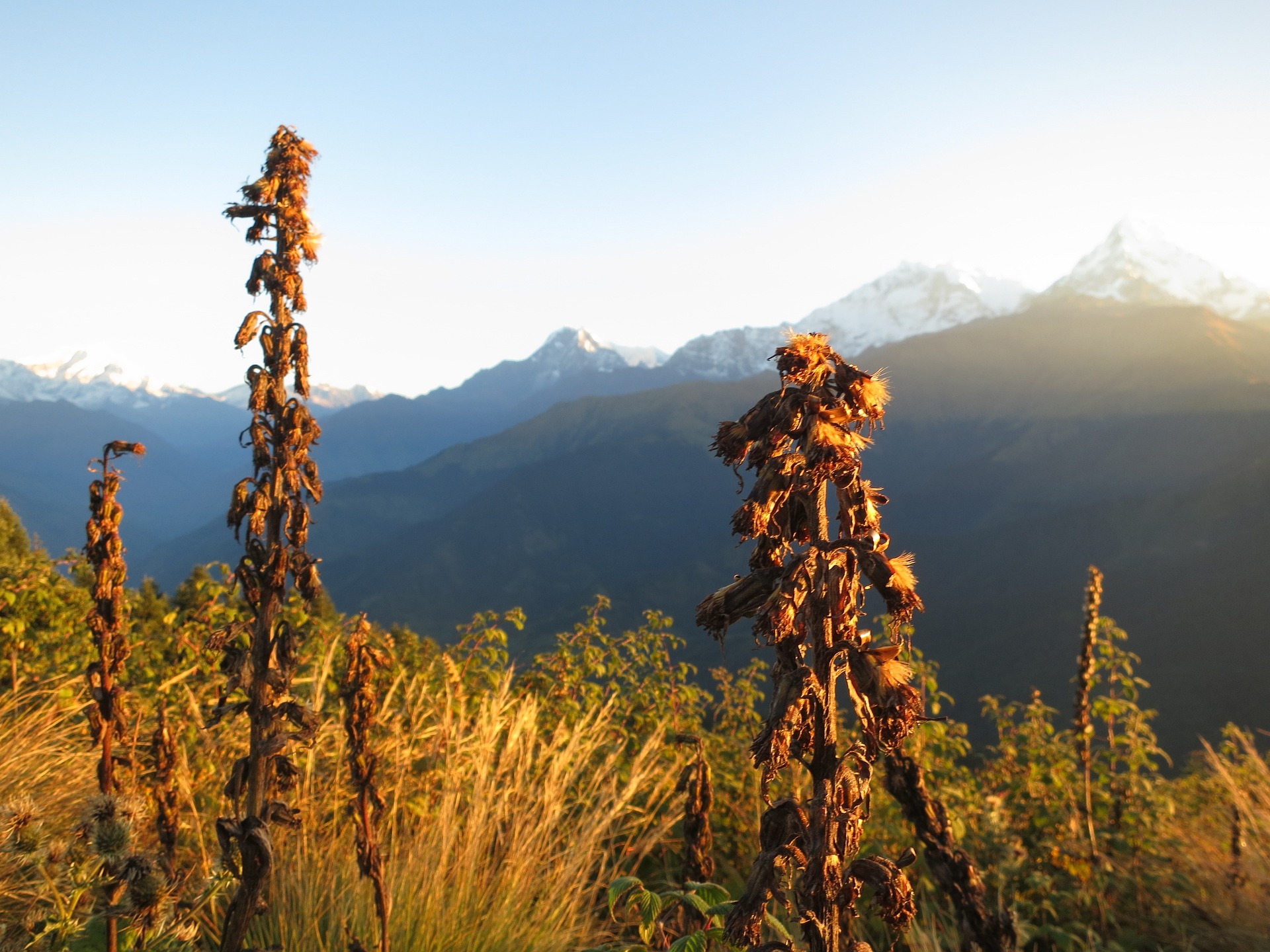
When is the best time to trek to Poon Hill?
The best seasons for Poon Hill trek are spring (March to May), and autumn (from mid-September to mid-December). The weather will be warm by day and the sky clear. Views are outstanding. At night, temperatures can be below freezing. Trekking in winter is possible but less popular.
Towards December, the weather starts getting particularly cold and the routes get distinctly quieter. If you are a hardened trekker a winter Annapurna Circuit (late December through February) can provide a very authentic experience out of trekking season in Nepal .
The main challenge of a winter trek, apart from the cold, is the snow and ice that often obstructs the higher trails and the Thorung Pass. During bad winter seasons, these trails may be closed.
Is altitude sickness a risk on the Ghorepani Poon Hill Trek?
Yes, altitude sickness is a risk on the Ghorepani Poon Hill trek because it ascends to some high-altitude points. At its highest point, you will reach an altitude of 3,210 meters (10,531 feet). There is a steep section on this trek where you will ascend very rapidly.
That's why it is important to have a solid understanding of the risks associated with high altitude trekking and how the body acclimatises to high altitude. We recommend you read our detailed article on Altitude Sickness and Acclimatisation .
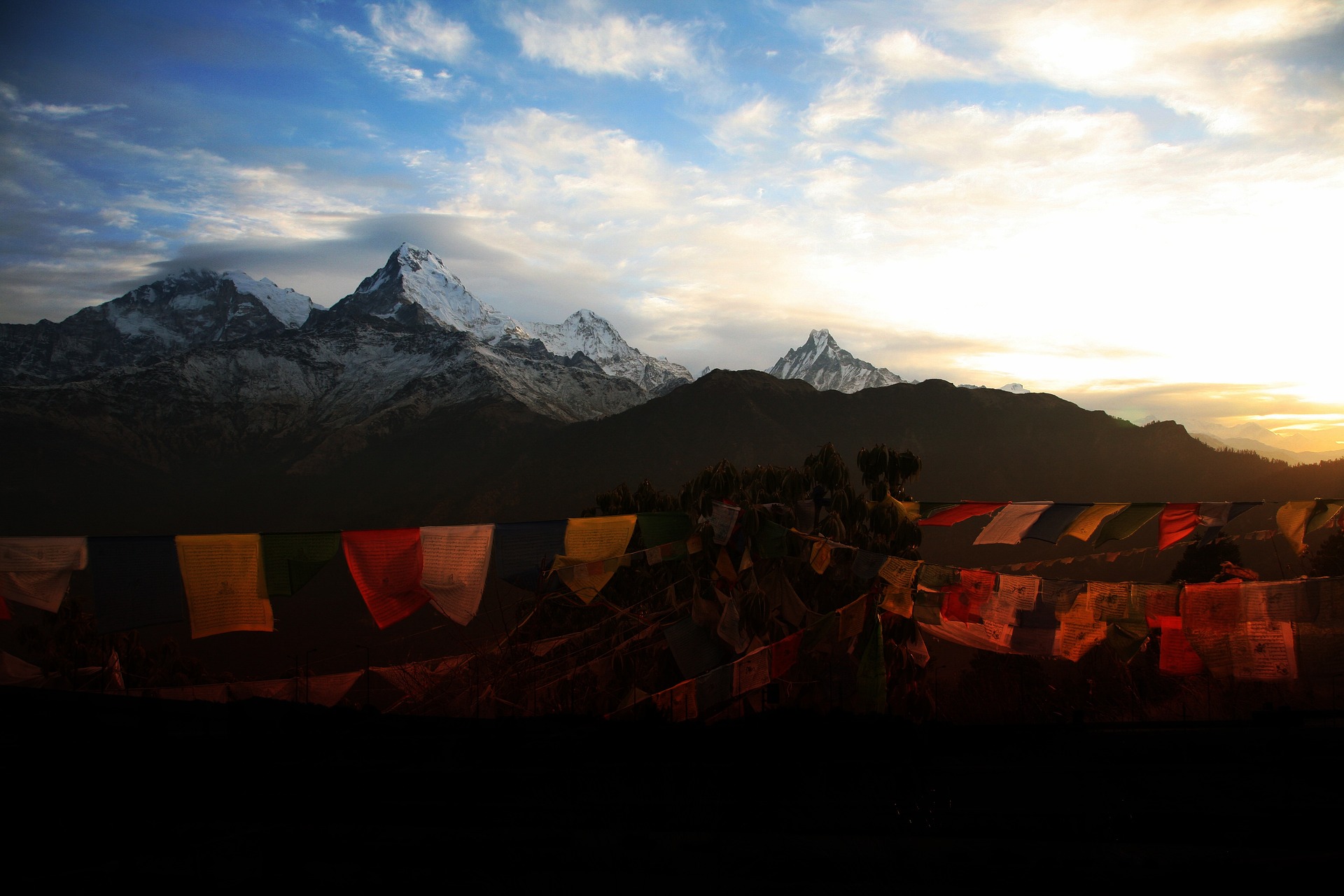
How difficult is the Poon Hill Trek?
The Ghorepani Poon Hill Trek is considered one of the easier treks in Nepal and older hikers and young families often complete the trek. You will need a basic level of fitness as you will be walking for some miles for at least 5 days.
What gear do I need to pack for the Poon Hill hike?
You need a number of essential pieces of trekking gear for hiking the Poon Hill trek.
Much of your gear can be rented or bought in Kathmandu, but we strongly suggest bringing the most important pieces of gear and equipment with you. To help you plan and prepare for your trek, we recommend reading our hiking gear packing list .
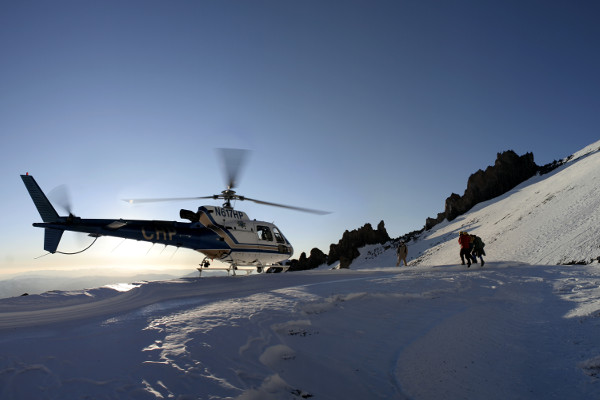
Do I need insurance for the Poon Hill Trek?
Yes, you need trekking insurance for the Ghorepani Poon Hill Trek. If an accident or incident should occur that requires immediate medical assistance and evacuation, you will most definitely want adequate trekking insurance that can cover the costs of air ambulance and treatment.
Make sure you have insurance that covers you for any travel related risks, like lost, stolen, damaged or delayed baggage, interruptions and flight delays and tour operators' default.
Please read our article on Insurance for trekking Nepal , which provides great information on what type of insurance you'd need.
Are there any recommended guidebooks for the Ghorepani Poon Hill trek?
Yes, there are a few guidebooks that we recommend for the Ghorepani Poon Hill trek. There are two excellent guidebooks that provide specific information on the trek and the overall region.
Lonely Planet Trekking in the Nepal Himalaya (Travel Guide) by Bradley Mayhew, Joe Bindloss and Lonely Planet is the best all-round trekking guide for Nepal. It includes 30 detailed itineraries on the most popular routes, including the Ghorepani Poon Hill trek, Everest Base Camp hike and the Annapurna Circuit.
There's also Annapurna: A Trekker’s Guide (New edition – 2013) by Sian Pritchard-Jones and Bob Gibbons, which is the most authoritative guide on the Annapurna region with specific information on the Ghorepani Poon Hill trek.
You are also welcome to have a look at our recommended library of Nepal books and guidebooks for more options.
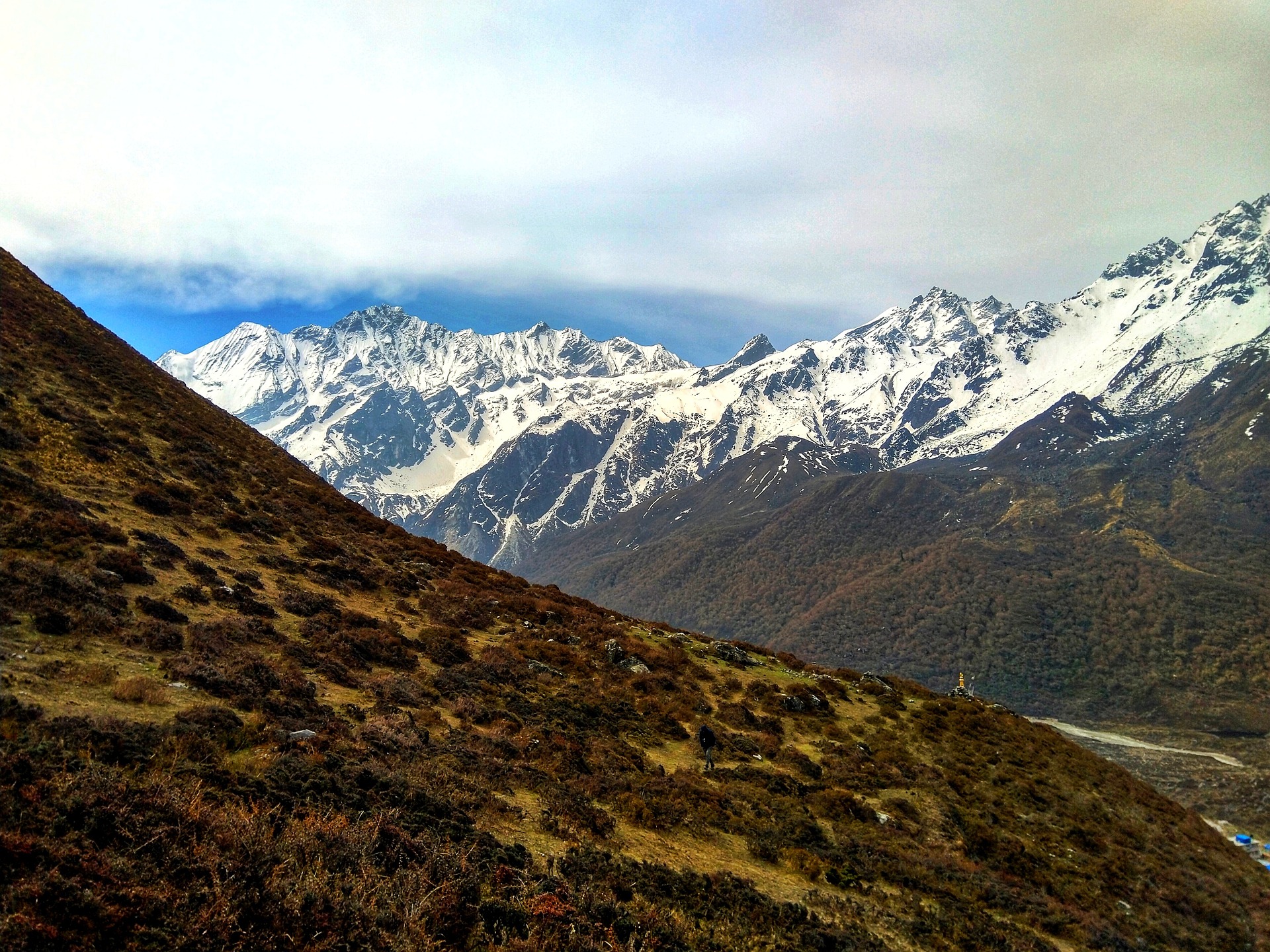
Continue browsing
See more information on Nepal . Or check out these other Nepal hiking articles:
- Kala Patthar Trek
- Island Peak Trails
- Trekking the Rolwaling
- Panchase Hikes
- Trekking the Jomsom Muktinath
- Kanchenjunga Base Camp Hikes
- Rara Lake hike
- Climbing Mera Peak
- Hiking the Helambu route
- Mustang Circuit Trek
- Gokyo Lakes Hike
- Hiking to Makalu Base Camp
- Trekking to Gosainkunda
- Limi Valley hike
About the author
Mark Whitman
Mark has trekked extensively in Asia, Europe, South America and Africa. He founded Mountain IQ in 2014 with the sole aim to be the best online information portal to some of the most popular mountain destinations around the world. When not writing for Mountain IQ, Mark is out exploring the outdoors with his wife!
Leave a Reply
Your email address will not be published. Required fields are marked
Hello I am headed to Nepal in May with a couple friends and we are experienced trekkers. We are looking for a challenging route that can be done in less than 10 days. Any help would be most appreciated.
Hey Aaron, if you only have 10 days then check out the Annapurna Base Camp trek or Langtang Trek. All the best!
We work with local guides to offer great value adventures at unbeatable prices
- +9779851276377
- 977 01 5348594
- [email protected]
- Follow us on:
Ghorepani Poon Hill Trek
Ghorepani poon hill, on the way to tadapani from ghorepani, tourists enjoying at ghorepani poon hill, you can also, things to know before trip, trip introduction.
Ghorepani Poon Hill Trek is one of the most popular treks in the Annapurna region of Nepal it can be completed in a short duration, anytime around the year, and doesn’t necessarily require any experience. It is one of the best short and easy treks which offers panoramic views of the stunning Annapurna Himalayan range while passing through beautiful forests (especially rhododendron forest) and insightful local Gurung and Magar villages.
At a maximum altitude of 3,210 meters above sea level, Ghorepani Poon Hill Trek is one of the most popular nearby short treks in Nepal .
Overview of Ghorepani Poon Hill Trek
Ghorepani Poon Hill Trek starts the next day after you arrive at Tribhuvan International Airport . And sightseeing around the culturally rich Kathmandu Valley. We will then take a scenic drive from Kathmandu to the paradise city of Pokhara. In Pokhara, you can relax at 800 meters with a bottle of beer or while boating on Phewa Lake. And you can see stunning views of snow-capped peaks. Clean and peaceful surroundings with lots of adventure sports to try; Pokhara is the place that captivates you totally with its natural beauty.
Our Ghorepani Poon Hill Trekking journey kicks off as we drive towards Nayapul which is the starting point of the trek. Slowly hiking through waterfalls, small settlements, bamboo, and rhododendron forests, we stay overnight at Tikhedhunga. The journey through nature to Ghorepani and Poon Hill then tests our fitness as we ascend 3,300 steps at Ulleri which rewards us with great views of the Himalayas hiding in the shade of the trees. Capture the perfect picture of landscapes, trees, and the Himalayas at this point. Pushing ourselves further for a couple of hours we arrive at Ghorepani village.
The next day before dawn we hike up to Poon Hill to capture the best sunrise views over the Himalayas. It will be mesmerizing to see the sun’s golden rays slowly rising through the Annapurna Himalayan range. As well as Mt. Dhaulagiri, Mt. Machhapuchre, Mt. Nilgiri, Tukuche Peak, Lamjung Himal, and other neighboring peaks. After sunrise views, we descend towards Tadapani. Further trekking through the insightful cultural and traditional Gurung village of Ghandruk . And we will head back to Pokhara and then finally end our Ghorepani Poon Hill Trek by driving toward Kathmandu.
Who can join this trek and how?
The trek is suitable for any individual or group who loves to explore both the beauty of nature and culture. It is especially recommended for trekkers with inadequate time for long and adventurous treks. Join this short and moderately graded trek with Nepal Mountain Trekkers for a truly rewarding Annapurna trek appropriate to your schedule.
Simply fill out the Inquiry form and let us know about your interest. Or you can contact us directly by sending us an email to join this short and easy trek in the Annapurna Region.
If this itinerary doesn’t suit your requirement or if you want to customize it, please feel free to contact us. This trek could be customized as per your required time frame and budget limits.
- Day 1 Arrival to Kathmandu | Transfer to Hotel
- Day 2 Trek Preparation Day
- Day 3 Kathmandu to Pokhara 200km | 5-6 hours | Breakfast and Lunch | Max Elevation: 823m/2,700ft:
- Day 4 Pokhara - Nayapul -Tikhedhunga 8km | 4-5 hours | Lunch | Max Elevation: 1,540m/5,052ft:
- Day 5 Tikhedhunga - Ghorepani 11km | 7-8 hours | Breakfast, Lunch and Dinner | Max Elevation: 2,840 m/9,318 ft:
- Day 6 Ghorepani – Poon Hill - Tadapani 14km | 6-7 hours | Breakfast, Lunch and Dinner |Max Elevation: 2,700m/8,860ft:
- Day 7 Tadapani – Ghandruk 7km | 5-6 hours | Breakfast, Lunch and Dinner | Max Elevation: 1,940m/6,364 ft:
- Day 8 Ghandruk – Pokhara 11km | 4-5 hours | Breakfast , Lunch and Dinner | Max Elevation: 823m/2,700ft:
- Day 9 Pokhara Sightseeing and Relax | Sightseeing, shopping, massage, and other activities | Max Elevation: 823m/2,700ft:
- Day 10 Pokhara - Kathmandu 200km | 5-6 hours | Breakfast, Lunch and Dinner | Max Elevation: 823m/2,700ft:
- Day 11 Departure to own destination:
Detail Itinerary
Day 1 : Arrival to Kathmandu | Transfer to Hotel :
Just after you arrive in Kathmandu ( Tribhuvan International Airport ), our representative will pick you up in a private vehicle and take you to the hotel where you will be welcomed with a marigold garland. You’ll be staying overnight in there with some refreshments.
Day 2 : Trek Preparation Day :
This day you will be preparing for your trek including packing and arranging equipment. You will get introduced to the team and the trek guide and get a briefing from our experts about the program. In the meantime, you can enjoy sightseeing around nearby places or something like that.
Day 3 : Kathmandu to Pokhara 200km | 5-6 hours | Breakfast and Lunch | Max Elevation: 823m/2,700ft::
This day you will be heading towards Pokhara from Kathmandu via drive. It is about 200 km from Kathmandu which will take you approximately 5-6 hours in the drive. You will enjoy the fascinating scenery and a lot more during this drive. You’ll stay overnight at Pokhara this day.
Dhading | 2 hrs from Kathmandu Breakfast at Hamlet restaurant
Tanahun | 2 hrs from Dhading Lunch at Green Park
Pokhara Dinner and Overnight Stay
Day 4 : Pokhara - Nayapul -Tikhedhunga 8km | 4-5 hours | Lunch | Max Elevation: 1,540m/5,052ft::
Today is your trek day. After breakfast in the morning, you’ll be heading towards Nayapul which is a half-hour drive from Pokhara. From Nayapul, you’ll start hiking toward Tikhedhunga. Now you’re inside Annapurna Conservation Area and you require permits to enter which will consume some time and then we will check in. You’ll be staying overnight at Tikhedhunga.
Lamdawali (1,160m/3,805ft) | 2 and half hour from Nayapul Lunch
Tikhedhunga(1,540m/5,052ft) | 2 and half hours from Lamdawali Dinner and Overnight Stay
Day 5 : Tikhedhunga - Ghorepani 11km | 7-8 hours | Breakfast, Lunch and Dinner | Max Elevation: 2,840 m/9,318 ft::
A long and demanding trek waits for us. After crossing the suspension bridge on the Bhurungdi River, we trek to the Ulleri, a village inhabited by the Magar community, climbing on the stone stairs. We continue our exploration through rhododendron forests, green meadows, cultivated fields, and smaller streams. You may spot one of the several birds such as redstarts, kingfishers, dippers, forktails along the river, and magpies, treepies, and others along with the cultivated areas.
The trail continues through the settlement at Nangethanti to reach the destination of Ghorepani. We have a beautiful view of magnificent mountain ranges including the Annapurna, Dhaulagiri, Nilgiri, Hiuchuli, and Tarke Kang including some other ranges.
Banthanti (2,210m/7,250ft) | 3-4 hours from Tikhedhunga Breakfast
Ghorepani ( 2,840m/9,317ft) | 3-4 hours from Banthati Dinner and Overnight Stay
Day 6 : Ghorepani – Poon Hill - Tadapani 14km | 6-7 hours | Breakfast, Lunch and Dinner |Max Elevation: 2,700m/8,860ft::
One of the most beautiful days in the entire trekking expedition is in store for the trekkers. We start early to watch the breathtaking sunrise from the hilltop of Poon Hill(3,210m/10,531ft). This magical moment when the golden rays of the sun paint the giants of Mt Dhaulagiri (8,167m/26,794ft), Annapurna massif (Annapurna I, Annapurna II, Annapurna III, Annapurna IV, Annapurna South), Mt Machhapuchhre or Fishtail Mountain (6,997m/22,956ft), Dhampus Peak (6,021m/19,753ft), Tukuche Peak (6,920m/22,703ft) and others are beyond description and worth the 45 minutes uphill climb to the top of the hill.
Capturing the moment shall be a treat for the rest of your life. We then descend the hill and continue our trek for Tadapani after lunch. On the further section of today’s trek, we navigate through the colorful rhododendron forest, seen blooming like anything in the spring season. Along the ridge and through the pine and rhododendron forest we reach Deurali and further descent leads us to Tadapani.
Ghorepani ( 2,840m/9,317ft) Breakfast
Banthanti (3,180m/12,500ft) Lunch
Tadapani(2,700m/8,858ft) Dinner and Overnight Stay
Day 7 : Tadapani – Ghandruk 7km | 5-6 hours | Breakfast, Lunch and Dinner | Max Elevation: 1,940m/6,364 ft::
The trek becomes more beautiful as we move further along the trekking trail. We walk down the steep trails initially and pass through the beautiful rhododendron forests. The beauty of this forest, especially when the rhododendron flower blossoms, takes the beauty of the trail to the next level. The blossom of cherries further enriches the trail as we move further and we reach the village of Ghandruk . Ghandruk is the second-largest Gurung settlement in Nepal and provides further insight into the lifestyles of villages that have traditionally provided the backbone of the famous Gurkha regiments. This village provides us with a view of Fishtail, Hiunchuli, and Annapurna South along with the Gurung Museum as the other highlight. Cherish the rich Gurung culture in the village.
Tadapani(2,700m/8,858ft) Breakfast
Ghandruk(1,940m/6,364ft) Lunch, Dinner, and Overnight Stay
Day 8 : Ghandruk – Pokhara 11km | 4-5 hours | Breakfast , Lunch and Dinner | Max Elevation: 823m/2,700ft::
We are already on the other part of the trekking expedition. We shall reach Pokhara via Nayapul today. We start today’s trek by descending to Birethati along the stone steps moving through villages and cultivated lands. We reach Ghandruk on a similar path and to the Modi River. The downhill walk continues as we pass through the small town of Birethanti. Little after the trek, we reach the initial point of our actual trekking, Nayapul. We drive back to Pokhara from this place. This marks the end of our on-foot journey. We can rest along the ever-beautiful Lakeside in Pokhara. Overnight in Pokhara.
Ghandruk(1,940m/6,364ft) Breakfast
Birethanti(1,050m/3,445ft) | 3-4 hours Lunch
Day 9 : Pokhara Sightseeing and Relax | Sightseeing, shopping, massage, and other activities | Max Elevation: 823m/2,700ft::
Well, you can enjoy this day as you wish at Pokhara. There are lots of interesting and must-visit places there which are naturally blessed. Apart from it, Pokhara is also renowned as the city of lakes and the most beautiful city in Nepal. You can have some quality time with your beloved once or enjoy some peaceful moments alone in there. This is one of the best destinations for tourists. You’ll stay overnight in Pokhara this day.
Day 10 : Pokhara - Kathmandu 200km | 5-6 hours | Breakfast, Lunch and Dinner | Max Elevation: 823m/2,700ft::
Today we drive back to the Kathmandu Valley after completing our wonderful trek. Following the same route to the Pokhara Valley, we trace our journey back to the medieval city of Kathmandu. The trail is as beautiful and attractive as it was in the first encounter. The hills and streams, rivers and rivulets, the landscape, and the hospitable locals make our return journey more beautiful.
Pokhara Breakfast
Malekhu | 4 hours Lunch
Nepali Cultural Restaurant, Kathmandu Farewell Dinner and Overnight Stay
Day 11 : Departure to own destination::
With all the memories and experience you’ll go back to your home this day. In the meantime, you can have some souvenirs for your near and dear ones back in your native place. Our representative will drop you at the airport from the hotel. This will be one of the best experiences of trekking for your lifetime.
Price Includes
- Airport Pick-up and drop service
- 3 nights Hotel in Kathmandu ( Hotel Green Horizon or Similar Standard)
- 3 nights Hotel in Pokhara
- Sanitation: The accommodation we provide will be neat and clean with warm hospitality and quality services.
- Single/Twin-sharing Accommodation (as per budget): Your group won’t have to share your accommodation with anyone else so your privacy is protected.
- We provide hygienic and safe meals to re-energize you.
- We request you not waste your meals because transporting food in the rural area is difficult.
- You are not allowed to share your meals with anyone else from another group.
- Transportation costs(Drive): Comfortable Tourist Bus (Kathmandu – Pokhara- Kathmandu) with other driving fares.
- Local Staff: Our guides are locals of the region which ensures that you will surely explore a bit more during the trek than with any other guides.
- Experienced: With an experience of more than a decade of working in this field, our trekking guides possess excellent knowledge of briefing during the trek as well and they are experts in handling all kinds of critical situations that might occur during the trek.
- Insurance: Nepal Mountain Trekkers have an insurance policy for all our trekking staff.
- Local Staff: The porters we hire belong to the same region where we trek to provide employment opportunities to the locals and to make you explore every prospect of the region.
- Trekking Permits: Trekkers’ Information Management System(TIMS) Card and Annapurna Conservation Area(ACAP) fees
- Trekking gear like sleeping bags and down jackets are made available on rent
- T-shirt of Nepal Mountain Trekkers, Duffel bag, and Trekking Map
- Rescue Arrangement Service
- First aid medical box
- All Government Taxes(13% VAT) and 10% Service Charge
- Farewell Dinner
Price Excludes
- Visa fee to enter Nepal ( Visa Information )
- International flight tickets
- Food in Kathmandu and Pokhara
- Extra night accommodation and meal costs in Kathmandu due to any change in the scheduled itinerary
- Travel insurance/ Rescue operation costs
- All personal expenses (Laundries, Electric accessories, Internet, and so on)
- All Soft Drinks and Alcoholic Beverages
- Tips for guides and porters
Trip Gallery
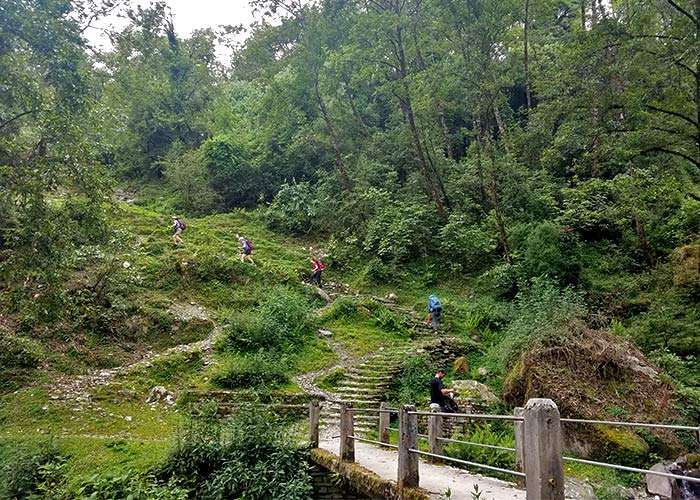
- Sun hat or scarf
- Light balaclava or warm fleece hat
- Sun’s Cream ( 40+)
- Cotton t-shirts or thermals
- Fleece jacket
- Waterproof and windproof jacket
- Down jacket (Light-weighted)
- Lightweight cotton pants (long)
- Waterproof pants
- Underwear and Half Pants
- Thin inner socks
- Thick, warm wool hiking socks
- Comfortable hiking boots
- Light-weighted sandals
Accessories
- Sleeping bag rated to 0°C
- Trekking bag (Rucksack)
- Large plastic bags (for keeping items dry inside trek bag)
- Trekking poles (optional, recommended)
- Water bottle or camel bag
Miscellaneous
- Medicines: We recommend you bring your regular medicines; we will provide a first aid kit from our side.
- Light-weighted Towel
- Swiss Knife
- Passport and extra passport photos
- Water Purifying Iodine Tablets, Drop or Sterilizer
Fixed Departures
- 26/04/2024 2-10 Yes Book
- 09/05/2024 2-10 Yes Book
- 15/05/2024 2-10 Yes Book
- 21/05/2024 2-10 Yes Book
- 18/06/2024 2-10 Yes Book
- 06/07/2024 2-10 Yes Book
Related Trips
You will also like …
- View Details
- Enquire Now
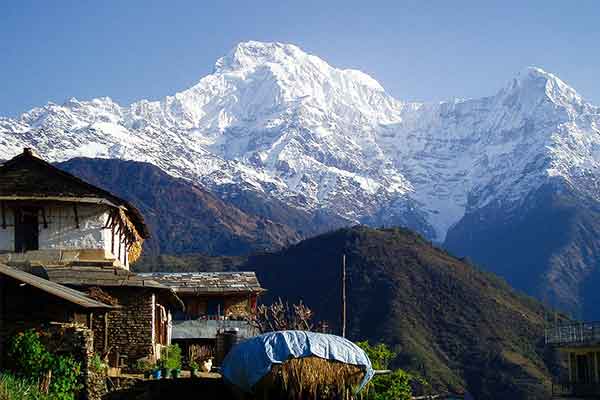
Ghandruk Trek
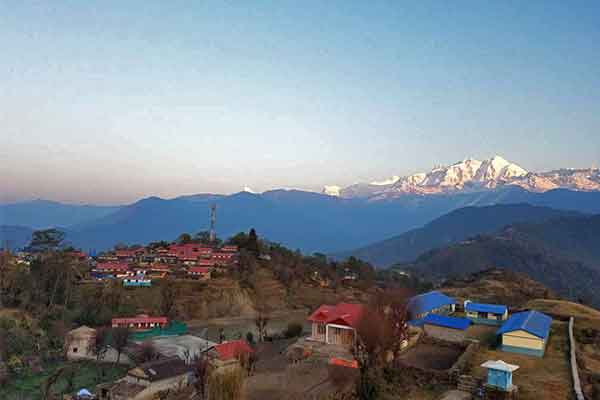
Ghale Gaun Homestay
- Leisurely Plus
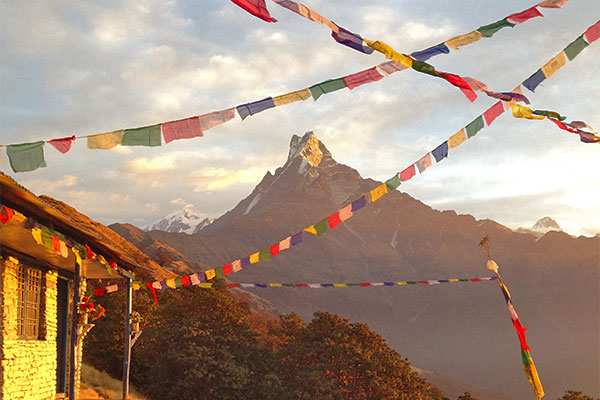
Mardi Himal Base Camp Trek
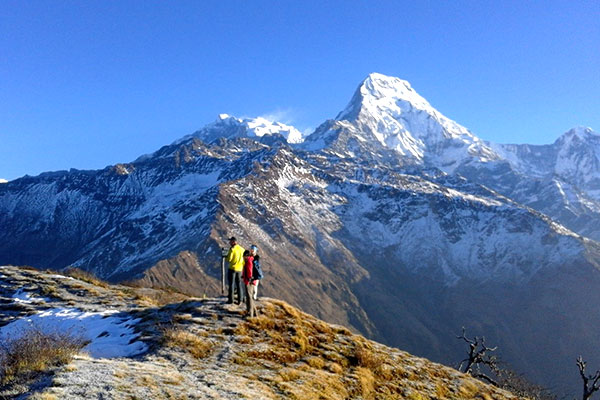
Khopra Danda Trek
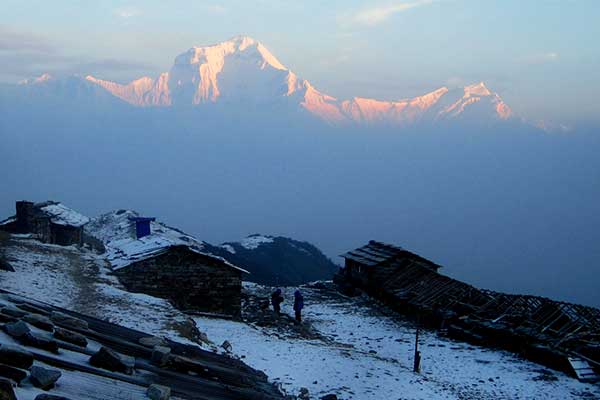
Khayar Lake Trek
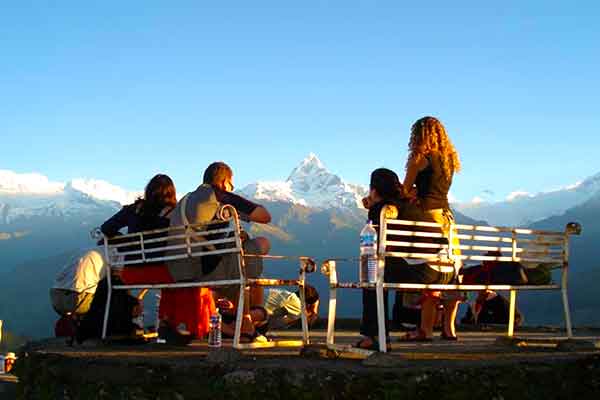
Around Pokhara Day Hiking
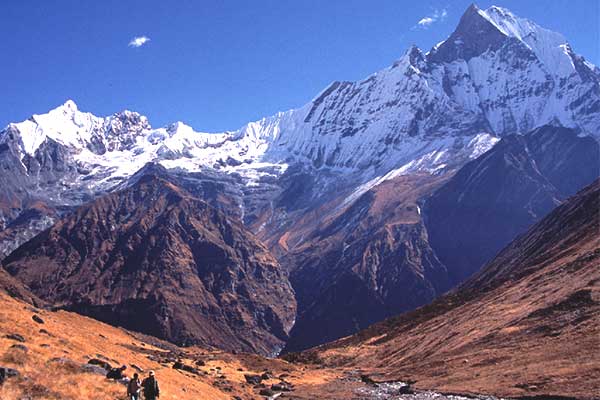
Machhapuchhre Model Trek
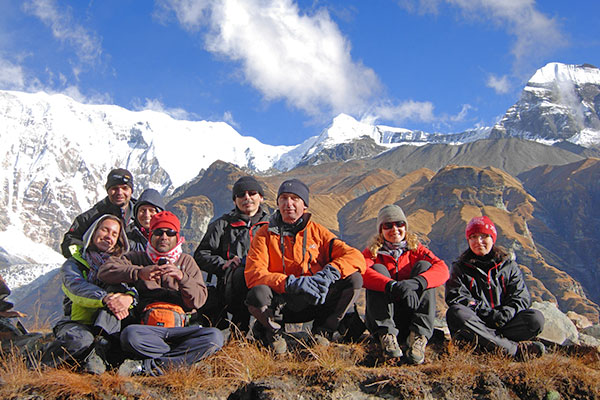
Short Annapurna Base Camp Trek
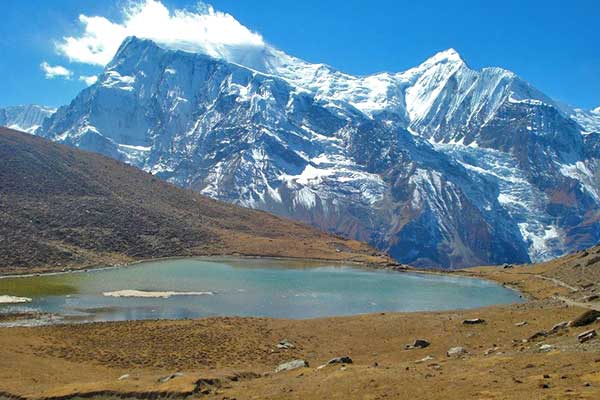
Ice Lake Trek
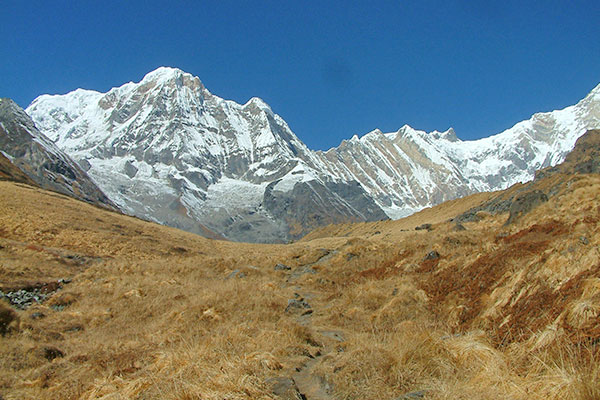
Annapurna Base Camp Trek
Clients review.
What our customers say about us
Poon Hill 4 day Trek
We did a 4 day trek taking in Poon Hill. Great guide and porter. The trek exceeded all expectations.
Steph Christensen
It was awesome.
Thanks for your excellent service.The trips with u guy makes me so happy..full of joy..i got a chance to see and experience new and awesome moments because of your Different amazing Offer.Hats off!
Katherina Müller
The best agency i’ve met.
Very proffessional, well mainained agency with wondelful staff is the point. You can trust these people without any worries !!
Good vibes only
Done the Poon Hill trek with the help of Min and Tn. They were of great help just everytime and they had the solution for everything. Also, Min had a great knowledge that helped the three of us learning more about Nepal during the days we spent together. Really nothing bad to say. I just thank them as we could really enjoy the trek, which is just great. Nepal Mountain Trekkers owner, Ramesh, also helped us planning our days and organized for us other activities. Ask him for assistance if you need some. Just a note: don’t go to Chitwan to ride elephants and make sure to pick a good place over there, ours was terrible. A big thank again to Ramesh, Min and Tn!
You can definitely count on them for a hassel free trip
Did a 10 days trip,trek for 7 days ( poonhill, ghorepani , ghandruk circuit) with 5 kids and 3 mummies.Mr Ramesh ( the owner) is very accommodating and welcoming.He specifically assigned Min ,who is very patient , knowledgeable and experienced in handling family with young children.He has managed to handle the hiccups faced and unforseen circumstances well,not forgetting going all way out to arrange a freshly baked birthday cake for our boy in Ghorepani.We have enjoyed trekking with the awesome team comprising Mr Min, Mr Krishna,Mr Sangame,Mr Manish and Mr Bikash,who constantly ensured our safety and welfare. We are glad we made the right choice in engaging their service.Thumbs up!
dyingforaholiday
Worry free 7 days trek to poon hill.
3 City Moms made it to Poon Hill with 5 young kids ranging from 5-13 years old. All made possible with a great team of guide and porters. The group dynamics were just right. They were able to bond well with the children and there was great team work amongst the team. We had nothing to worry about. From the moment we landed til we depart. Everything was well-thought. Even to the slightest details like planning a surprise cake [in the middle of the a mountain] for a boy who turned 13 during the trip and even making sure that we do not leave our belongings behind when we leave a tea house. These are the fine touches that made a trip an unforgettable one.
Dream trekking with superstar guide
Corinne-op-reis, good for new trekkers.
Being a beginner trekker, I found Mountain Trekkers good as everything was planned out ahead of time so all that was required of me was to walk. Ramesh was very knowledgeable and helped choose an appropriate hiking route that suited me. My guide was helpful and attentive. I recommend Nepal Mountain Trekkers to first time trekkers as it’s a nice introduction to the trekking world.
Amazing Adventure to Poon Hill and Ghorepani
My friend and I had an incredible time on an 8 day trek to Poon Hill and Ghorepani. This being my first trek, I was nervous about how I would go but Ramesh did an excellent job answering all of my questions and planning a very flexible schedule for us. Our guide TB made every part of the adventure feel comfortable, safe and fun. TB is a very experienced guide and has a wealth of knowledge. Hearing him share interesting information and stories about the culture and the beautiful places we were walking through really enriched our journey. Nepal Mountain Trekkers really do go out of their way to cater to your individual needs, their friendly expert guides will ensure you have the best possible time in Nepal. Ramesh and the team are professional and personable in their approach to helping you create the adventure you have always dreamed of.
We were not quite sure if trekking was going to be something for us, especially because we were traveling with our 2,5yr old son. Ramesh gave us many tips, thought out of the box and suggested alternatives should the trip not be what we expected. Min, our guide was the best we could have wished for. He took plenty of time for us, arranged food and drinks, after a day or two Min just knew what we would have for drinks and would order for us so we haven’t had to wait. He chose excellent small hotels to stop along the way, played with our son and was a fine partner to have conversations with. He told a lot about the environment, life in Nepal and his native village where not much was left of it after the 2015 earthquake. We have chosen to do an 8 day trek through Poon Hill, Ghandruk, Landruk, and the hotsprings. The walking days were definitely not too long and the road there is plenty of opportunity for you to catch your breath and enjoy the view. Although we kept asking Min how far we still had to go and when we had our next stop, he kept being all friendly and smiling the whole time. We also hired a porter to carry our heavy bag along the way, it was his first trip though he seemed to enjoy it and ran uphill like he never did something else in his life After trekking we’ve decided to stay for a few extra days in Pokhara, the hotel Nepal Mountain Trekkers had arranged was really good, staff was wonderful and we just loved this city. If in Nepal, you haven’t seen the beauty of this amazing country if you haven’t been trekking. Definitely would recommend Ramesh en Min, and all other guides at Nepal Mountain Trekkers. Good price, excellent service. Would do this all over again when we come back to Nepal.
WE ARE ASSOCIATED WITH
SEND US A MESSAGE

Destinations
Trekking type, poon hill trek: the ultimate hike to a million dollar view, by jan bakker.
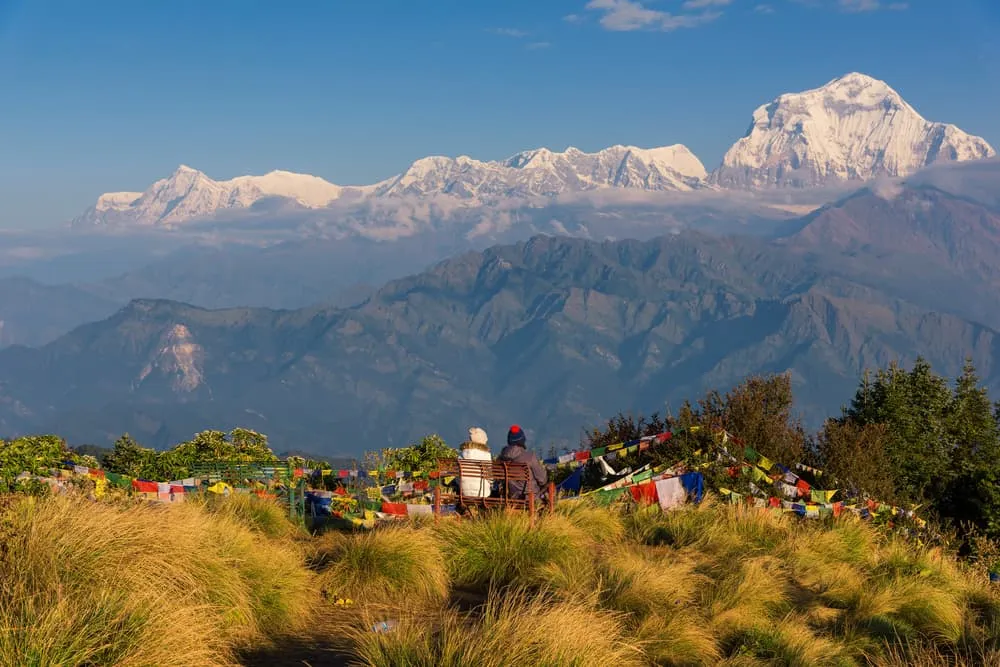
You don’t have to climb a big mountain to have the best view across the Himalayas. The foothills of the Annapurna Range offer some of the best mountain scenery you will ever see. The most famous of them all is the climb up Poon Hill, a 3210 meters high “hill” with a perfect vantage point to see some of the biggest and most beautiful mountains on the planet. No time? No problem! The Ghorepani Poon Hill trek itself can be done in as little as three days. Lace up your hiking boots and head up Poon Hill with us!
At Bookatrekking.com we often get the question what the shortest trek in Nepal is, while you can still see the real Himalayas. No doubt this is the trek up Poonhill. By Nepali standards, the altitude of this hike is modest, and altitude sickness is less of an issue compared to for example the Annapurna Circuit or Everest Base Camp.
Poon Hill Trek: A Short Hike To Nepal's Best Himalaya View
How difficult is the poon hill trek, what is the best season to do the ghorepani poon hill trek, the view from poon hill: which mountains do you see, a 7-day poon hill itinerary, ghorepani poon hill trek map, what permits do i need for the ghorepani poon hill trek, what accommodation can i expect on the poon hill trek, how to identify and prevent ams on the ghorepani poon hill trek, packing list for the ghorepani poon hill trek, where can i book the ghorepani poon hill trek.
Why do we like to go to the mountains so much? Fresh air is most likely one of them. Also, it’s a great environment for exercise. On top of most people’s list of reasons to go to the mountains is probably the mountain views. There’s something irresistible about the sight of something so wild and beyond reach filling the horizon. The most iconic mountain views in the world include the Tre Cime di Lavaredo in the Italian Dolomites, the Cuernos del Paine in Chilean Patagonia and of course the view of Mount Everest from Kalapathar . In that same list of epic views is Poon Hill, an elevated hilltop that looks out on the spectacular Annapurna and Dhaulagiri mountain ranges.
How do you reach Poon Hill? As with all Annapurna treks, the main hub for the Ghorepani Poon Hill trek is Pokhara. The trailhead at Nayapul is less than two hours from the city. The first stage is a good warm up, with charming villages and woodlands along the way. The vertical gain is fairly modest. The climb to Ghorepani on the second day is a tough one with lots of elevation gain. On day 3 the ascent of Poon Hill is on the program. It starts pre-dawn in order to be at the summit for its famous sunrise with the Annapurnas in the background. From Ghorepani, Bookatrekking.com offers two options. Either you head back down to Nayapul the very same day. Or you continue the trek for another couple of days via Ghandruk and make the trek a circuit rather than a linear walk. Regardless which route you choose, you have witnessed one of the most epic mountain views of your life.
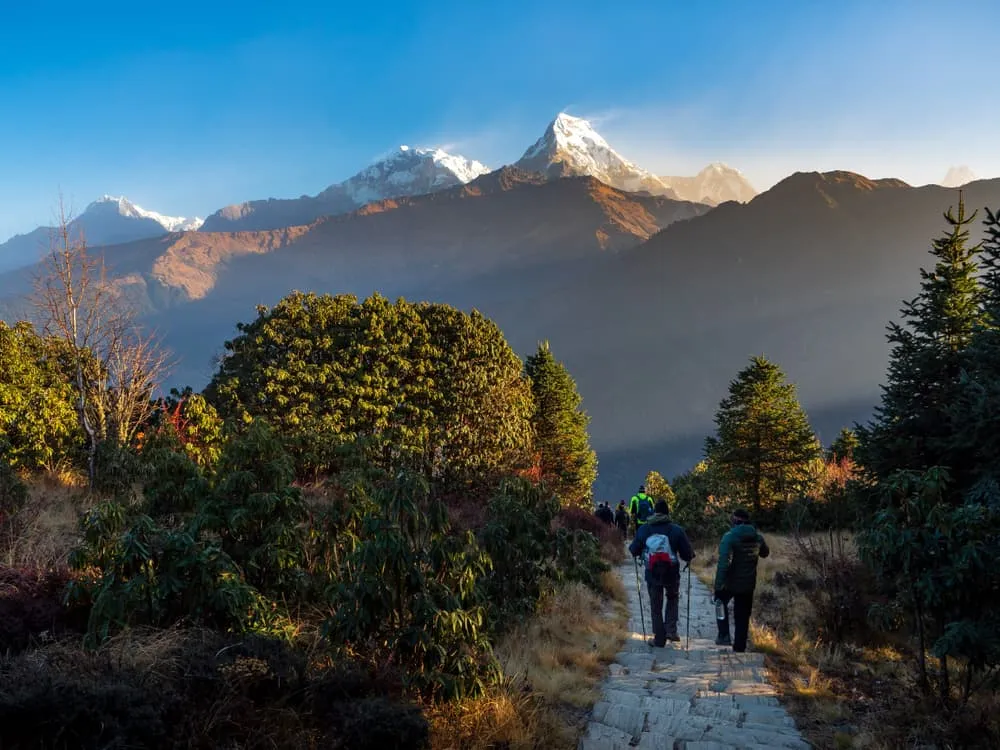
Ghorepani Poon Hill Trek Full

Ghorepani Poon Hill Trek Short
The Poon Hill Trek difficulty is quite low. The path is wide in many places and on the steep parts steps have been created to make the hiking easier. Technically it’s probably the easiest hike we offer in Nepal. However, there is a but. In a short distance there is a lot of vertical gain. On the second stage from Hile to Ghorepani you ascend a whopping 1400 meters in the space of 10 kilometers. That’s an average gradient of 14%! For most people, descending is actually harder than the ascent. If you do the Ghorepani Poon Hill trek in 3 days, the descent is quite extreme with a vertical drop of 2200 meters in one day. Better get those knees trained! Although you may feel the thinner air a little, most trekkers won’t have any problems with AMS as the highest tea house (in Ghorepani) is located below the 3000 meter mark.
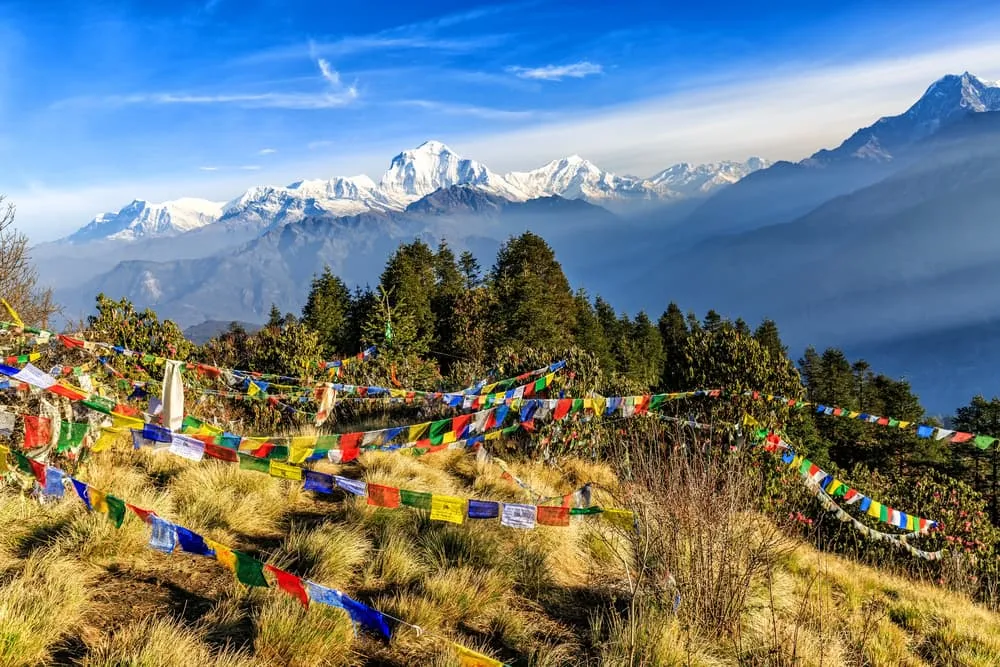
The best season to do the Ghorepani Poon Hill Trek is generally during the spring (March to May) and autumn (September to November). Here's why:
1. Spring (March to May)
- Blooming Rhododendrons: Spring is known for its mild temperatures, and the rhododendron forests along the trail come alive with vibrant colors, creating a picturesque landscape.
- Clear Views: The skies are relatively clear during spring, offering excellent visibility of the surrounding mountains.
2. Autumn (September to November)
- Stable Weather: Autumn is considered the best trekking season in Nepal. The weather is stable, with clear skies and mild temperatures during the day.
- Panoramic Views: The visibility is excellent, providing breathtaking panoramic views of the Himalayan peaks.
- Festivals and Harvest Season: Autumn is also a festive season in Nepal, with various cultural celebrations. The harvest season brings golden landscapes, adding to the beauty of the trek.
While these seasons are generally considered optimal, it's essential to be prepared for varying weather conditions, and it's advisable to check current weather forecasts before embarking on the trek. During the winter months (December to February), the trail may be snowy, and temperatures can be quite cold, making it a less popular time for the trek. But you’ll have the trail to yourself, which could be a very special experience. Similarly, the summer months (June to August) bring monsoon rains, which can make the trails muddy and slippery, posing additional challenges for trekkers.

Poon Hill, the undisputed highlight of the Ghorepani Poon Hill Trek in Nepal, offers one of the most breathtaking panoramic views of the Himalayas. But which mountains can you actually see? Some of the notable mountains that can be seen from Poon Hill include:
1. Dhaulagiri (8,167 meters / 26,795 feet)
Dhaulagiri is the seventh-highest mountain in the world and is part of the Annapurna Himalayan range. It is a massive, snow-capped peak that dominates the skyline.
2. Annapurna I (8,091 meters / 26,545 feet)
Annapurna I is the tenth-highest mountain globally and is part of the Annapurna massif. The view of Annapurna I from Poon Hill is particularly stunning during sunrise.
3. Annapurna South (7,219 meters / 23,684 feet)
Annapurna South is another prominent peak in the Annapurna range, and its rugged appearance adds to the beauty of the landscape.
4. Machapuchare (6,993 meters / 22,943 feet)
Also known as "Fishtail," Machapuchare is a distinctive mountain with a fishtail-shaped summit. It is sacred in the local culture, and its view from Poon Hill is iconic.
5. Nilgiri (7,061 meters / 23,166 feet)
Nilgiri is a striking mountain with a snow-covered peak that can be seen from Poon Hill, adding to the visual spectacle.
6. Hiunchuli (6,441 meters / 21,132 feet)
Hiunchuli is a lesser-known but impressive peak in the Annapurna Himalayan range, and it contributes to the overall stunning scenery.
These are just a few of the many peaks visible from Poon Hill. The sunrise and sunset views from Poon Hill enhance the beauty of these mountains, and it's a popular spot for trekkers and photographers seeking awe-inspiring Himalayan vistas.

If you're stuck for time, but still want to enjoy a beautiful yet punchy trek than the 7-day trip to Poon Hill is your best choice. It involves five days of hiking and is a great first trek to the Nepali Himalayas.
Drive from Kathmandu to Pokhara
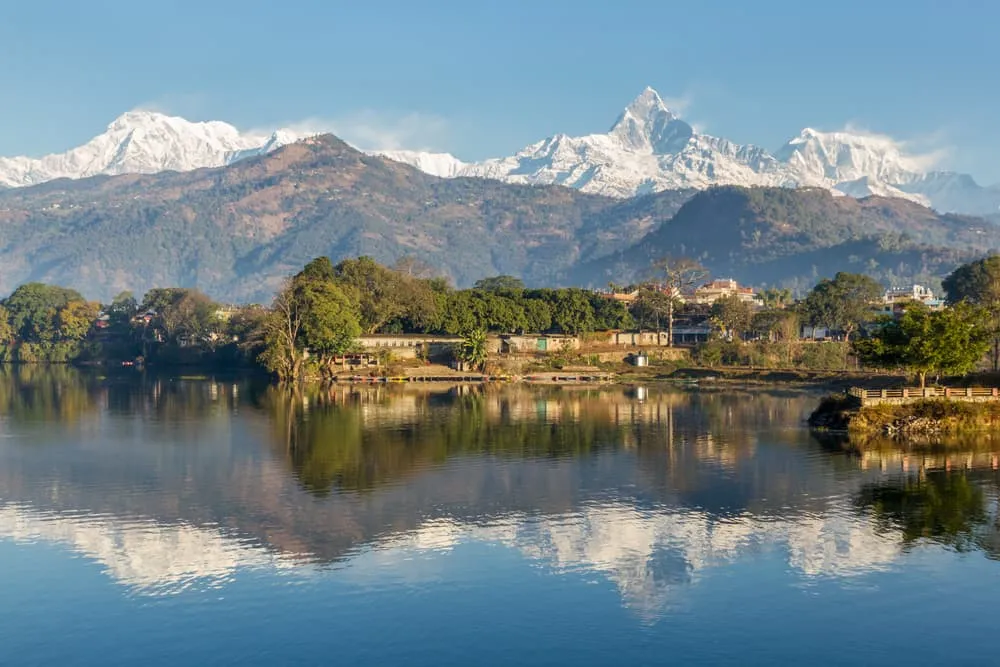
Drive from Pokhara – Nayapul and trek to Tikhedunga

Trek to Ghorepani

Hike to Poon Hill and trek to Tadapani
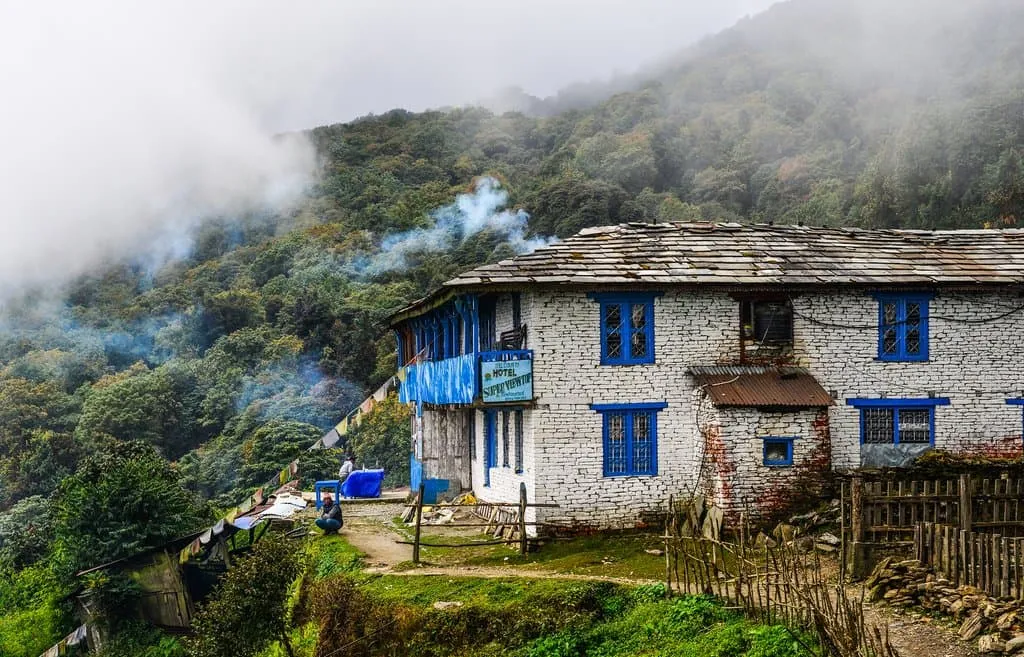
Trek from Tadapani to Ghandruk
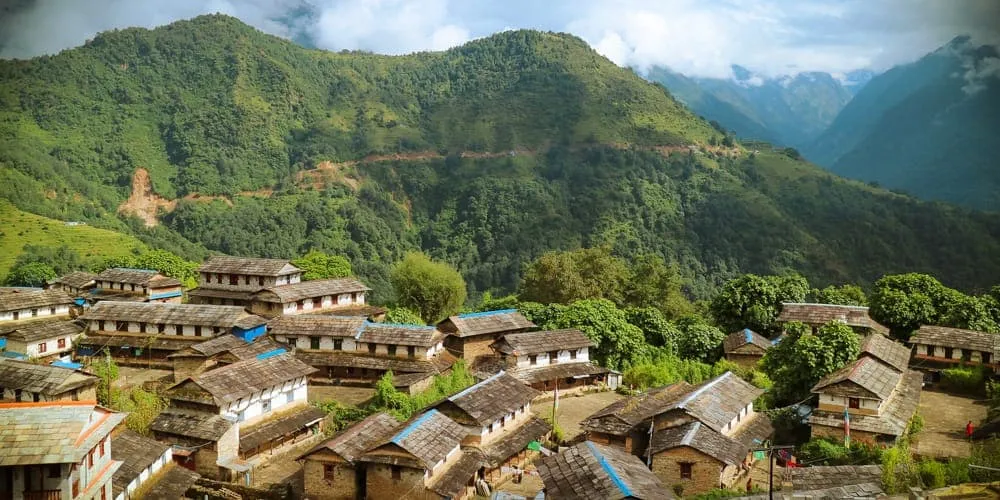
Trek from Ghandruk to Nayapul and drive to Pokhara
Drive from pokhara to kathmandu.
When preparing for a trek to Poon Hill, it is crucial to secure the necessary permits:
TIMS (Trekkers Information Management System):
For any trekker planning to explore Nepal, whether heading to the Everest Base Camp or embarking on the journey on the Annapurna Circuit , the TIMS permit is a mandatory requirement for all trekking routes. The fee for this permit is NRS 2000 per person, which is approximately 17 USD or 15 EUR.
Annapurna Conservation Area Project (ACAP) Permit
An essential requirement for those intending to trek within the Annapurna region, the ACAP Permit is administered by the National Trust for Nature. Its primary goal is to safeguard and preserve the wildlife and natural environment of the region, with the funds collected dedicated to conservation initiatives.
For each individual embarking on a single-entry trek, the cost of an ACAP Permit is Rs. 3000 (roughly USD 25), regardless of the duration of the stay. These permits can be obtained in either Kathmandu or Pokhara, and designated checkpoints along the trail ensure the maintenance of trekking records.
Discovering the charm of staying in traditional villages along Nepal's trekking routes is an integral aspect of the trekking experience, in our view. It represents a harmonious blend of the rugged mountain wilderness and the distinctive mountain culture. Immersing yourself in the mountain villages provides a genuine glimpse into life in the Annapurnas.
During your stay in each village, you will find accommodations in a tea house, the local term for a guesthouse. On our own Nepal trekking adventures, we always aim to reach the next destination early. Why? Because we cherish the tranquility and simplicity of life in the mountain villages. Enjoying a cup of tea while observing the daily hustle and bustle of life in the Himalayas is a favorite activity. Some villages offer opportunities to visit monasteries, and if you're fortunate, you might witness one of the many Buddhist festivals. While the tea houses themselves are generally simple, recent years have seen some upgrades, including flush toilets, warm water, and even WiFi. Fortunately, the delightful dhal bat, a staple in Nepalese trekking cuisine, remains a fixture on every tea house menu. Immerse yourself in Nepal's mountain culture on the Ghorepani Poon Hill Trek!
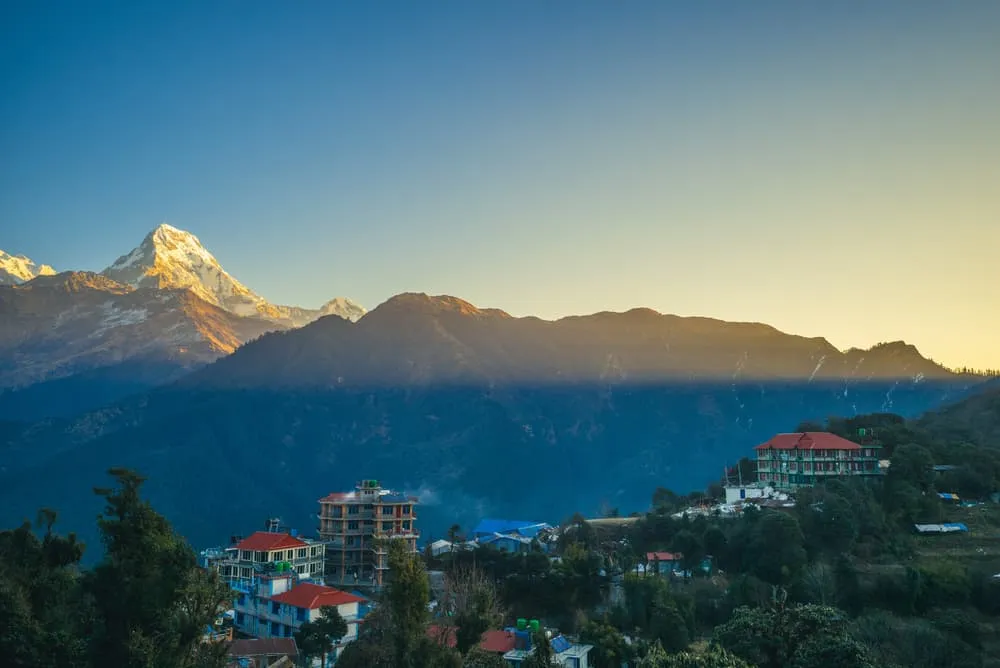
It's essential to understand that altitude sickness can affect anyone, regardless of age, fitness level, or previous high-altitude experience. These days there are several tools to monitor your health at altitude. A widely-used (analog) method is the Lake Louise score card. It ticks the altitude symptoms while keeping the severity in mind. It’s a common tool used by guides. Nowadays, most trekking and mountain guides bring a blood oxygen saturation meter, which also measures the heart rate. These are key indicators whether a person adapts to altitude well or not. AMS can occur when trekking the Ghorepani Poon Hill Trek. Below you can find everything you need to know about altitude sickness.
Acute Mountain Sickness (AMS)
Altitude sickness, also known as Acute Mountain Sickness (AMS) is a health condition that occurs when someone is exposed to low levels of oxygen at higher altitudes. AMS is a serious condition and as the name suggests acute. It needs to be dealt with immediately, as it is potentially life-threatening. Most people will experience some mild symptoms of altitude sickness. It’s important to be aware of these symptoms and act before symptoms become more severe. Below we break down the different forms of AMS and how you can reduce the risk of getting it.
AMS symptoms
It is key to know how to identify altitude illness. You may experience the following symptoms due to the jump in altitude: headache, lack of appetite, breathing difficulties, insomnia, nausea and vomiting. The intensity and severity of these symptoms may increase with altitude and an overall feeling of fatigue will take all your joy away. This may further deteriorate to one of these life-threatening conditions.
High Altitude Pulmonary Edema (HAPE) : HAPE is a condition in which fluid accumulates in the lungs, making it difficult to breathe. Symptoms may include shortness of breath, a persistent cough, chest tightness, and an increased heart rate. It can be a life-threatening condition and requires immediate descent to lower altitudes and, in severe cases, medical treatment.
High Altitude Cerebral Edema (HACE) : HACE is a more serious condition in which fluid accumulates in the brain. Symptoms may include severe headaches, confusion, loss of coordination, and altered mental status. HACE is also a medical emergency and requires immediate descent and medical attention. Below 7 ways of minimizing the risk of AMS:
1. Gradual Ascent
One of the most effective ways to prevent AMS is to ascend gradually. When traveling to high altitudes, try to take several days to acclimatize before going higher. This allows your body to adapt to the reduced oxygen levels. All our treks in Nepal keep sufficient acclimatization into account.
2. Stay Hydrated
Dehydration can increase the risk of AMS, so drink plenty of fluids. Avoid excessive alcohol and caffeine consumption, as they can contribute to dehydration.
Consume a balanced diet with adequate carbohydrates and avoid heavy, fatty meals. Carbohydrates can help your body utilize oxygen more efficiently at high altitudes.
4. Medication
Some individuals may consider taking medication, such as acetazolamide (Diamox), to help prevent AMS. Consult with a healthcare professional before using any medication, and be aware of potential side effects.
Ensure you get enough sleep and rest during your ascent. Fatigue can increase the risk of AMS.
6. Avoid Overexertion
Pace yourself and avoid overexertion. Listen to your body, and if you experience symptoms of AMS, rest or descend to a lower altitude.
7. Descend if Symptoms Persist
If you experience symptoms of AMS, such as headache, nausea, dizziness, or difficulty breathing, it's crucial to descend to a lower altitude. Symptoms should not be ignored or dismissed.

Accessories
At Bookatrekking.com you can book this trek and many others. Our guided options come with experts on the ground, and offer you a convenient, stress-free, safe, and educational way to explore the outdoors. Find our offers here . Our easy-to-use platform allows you to browse and compare different trekking options and find the perfect fit for your interests, abilities, and budget.
If you have any questions about a specific trek or need help choosing the right one for you, our team of trekking experts is here to assist you. Simply reach out to us and we will be happy to provide you with personalized recommendations and advice to help you plan the trekking adventure of a lifetime.
Is this not your cup of tea and are you looking for other epic adventures? Check out one of our blog posts:
Summit climbs
- Climbing Kilimanjaro
- Climbing Triglav
- Climbing Island Peak in Nepal
- Climbing Mount Kenya
- Climbing Mount Elbrus
- Climbing Mount Kinabalu
- Climbing Toubkal
- Climbing Rinjani
- Everest Base Camp Trek
- Annapurna Circuit Trek
- Nepal Travel Guide
- Salkantay Trek
- Peru Travel Guide
Kilimanjaro
- Machame Route
- Lemosho Route
- Kili Travel Guide
Self-guided treks
- Tour du Mont Blanc
- West Highland Way
- Camino de Santiago
Not sure yet or want to discuss your plans for the Ghorepani Poon Hill Trek with one of our trekking experts? Get in touch today and turn your dreams into memories!

Also Interesting
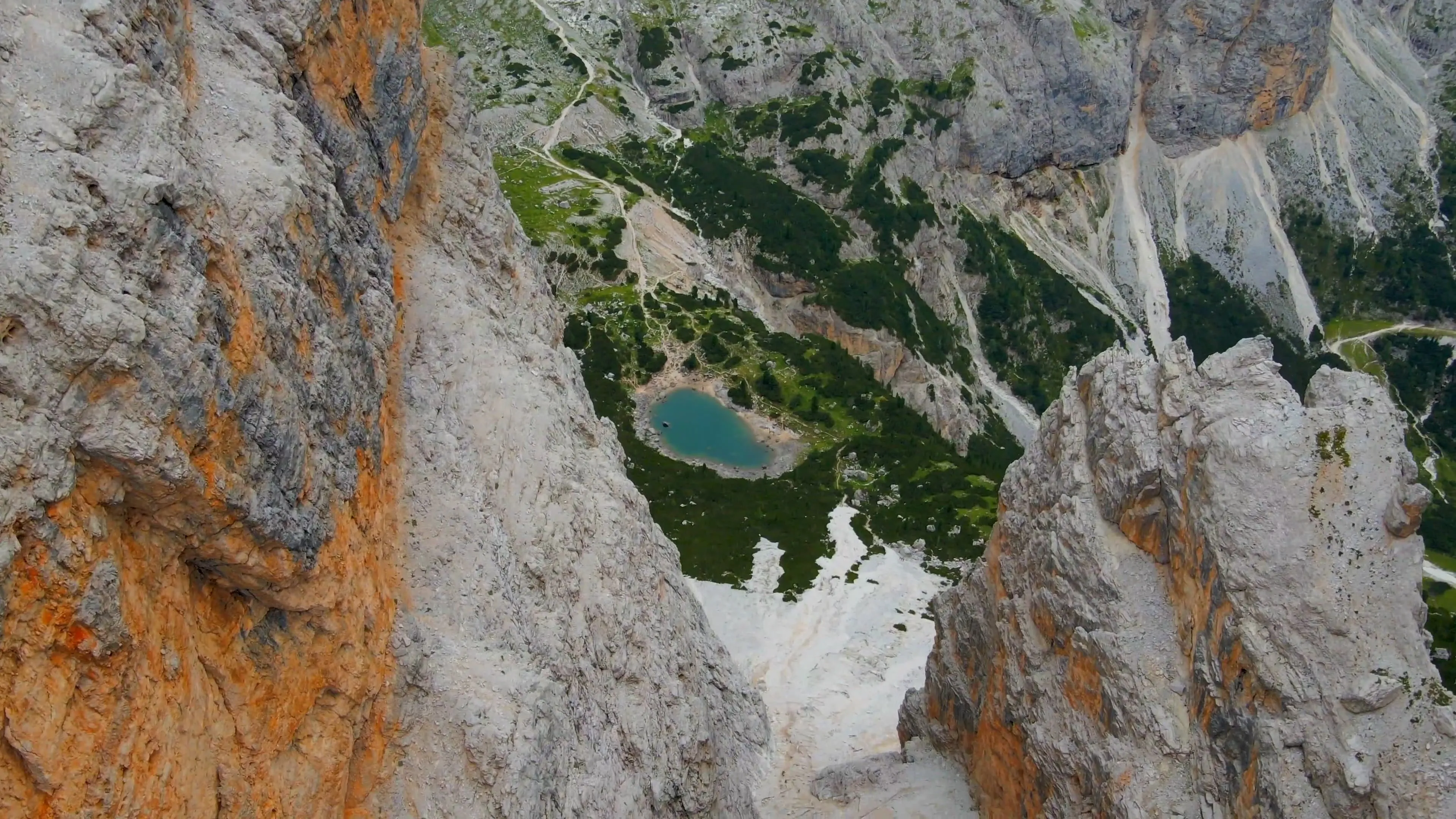
Alta Via 1: Map, Difficulty, and Route on the Italian Dolomites
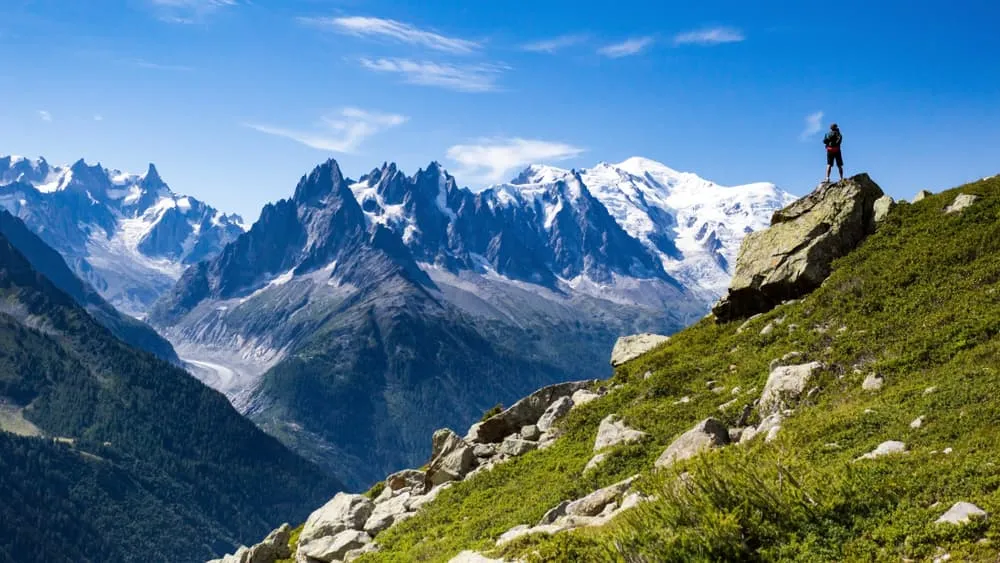
Tour du Mont Blanc: All You Need To Know
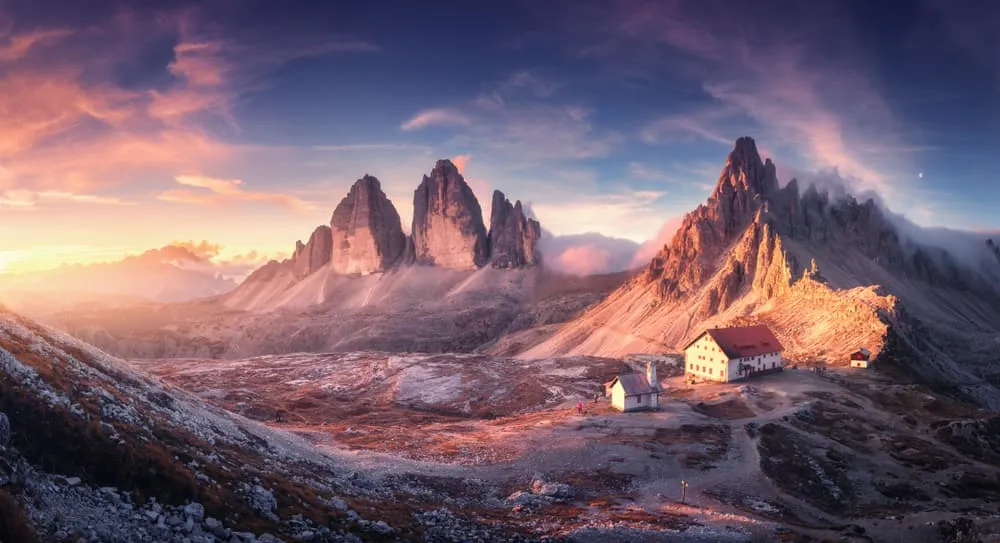
Dolomites Hiking: The 8 Best Options for Hiking Hut-to-Hut in Italy
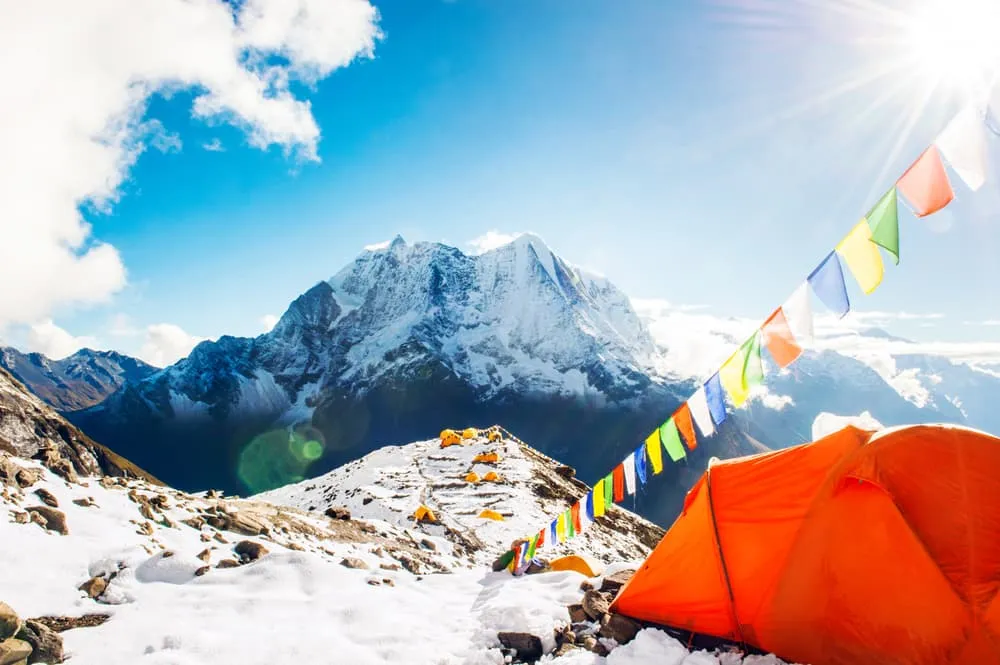
Everest Base Camp: A Trek to The Roof of The World
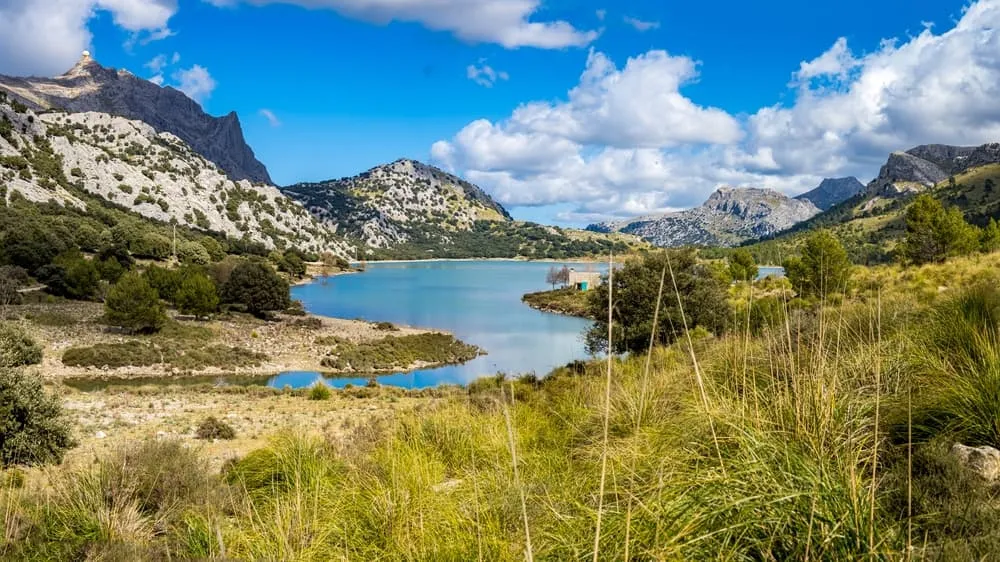
Hiking the GR221 in Mallorca: Everything You Need to Know
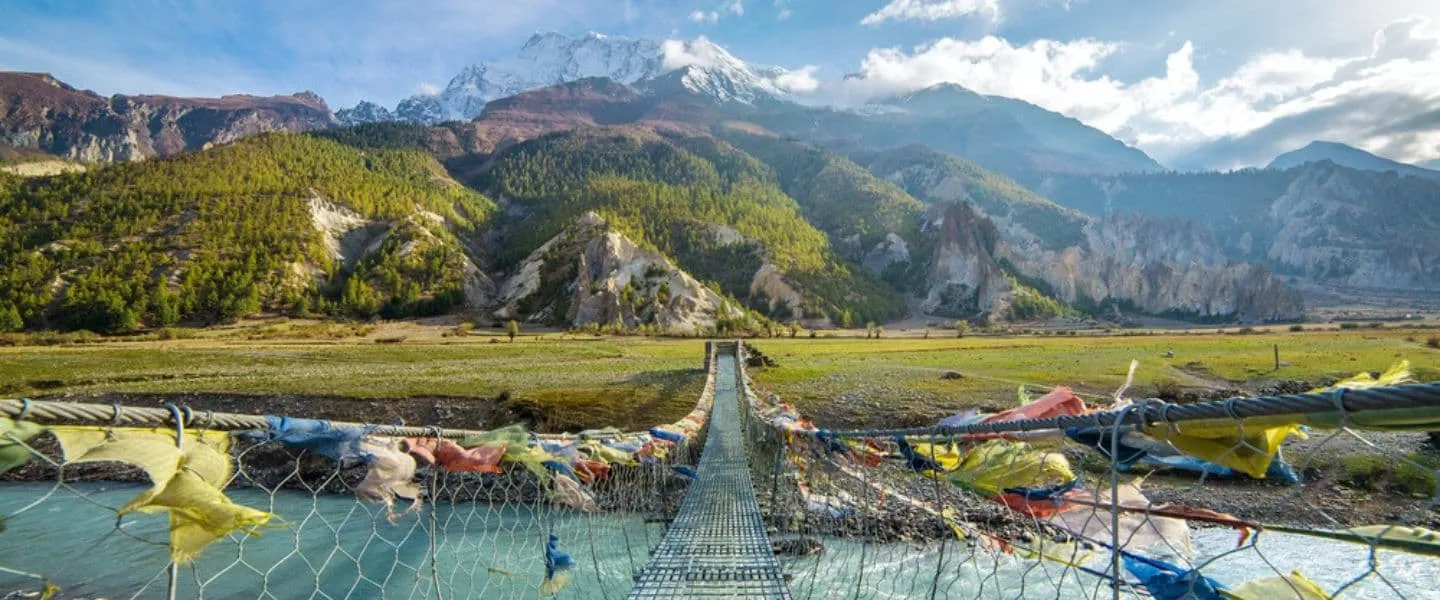
Annapurna Circuit Trek: How to Hike Around the Annapurnas
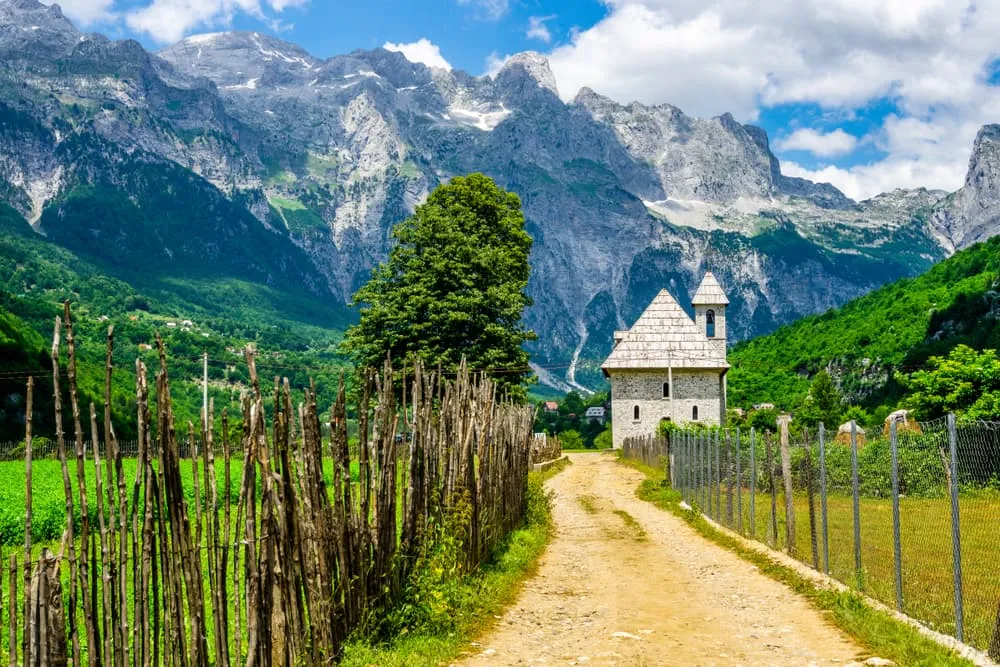
Peaks of the Balkans Trail: All You Need to Know

Hut-to-Hut Hiking in the Pyrenees: The 4 Best Walks
Get weekly inspiration with the best treks.

Himalayan Odyssey Nepal Trek
Best Himalayan Trekking Agency | 2024
Registration No: [74407/067/068]
Write a review on [Tripadvisor]
+977-(986)096-4103
[Available On: WhatsApp & Viber] Please feel free to contact us 24/7 !
Welcome Traveler's

Ghorepani Poon Hill Trek
Ghorepani poon hill trek | 2024.
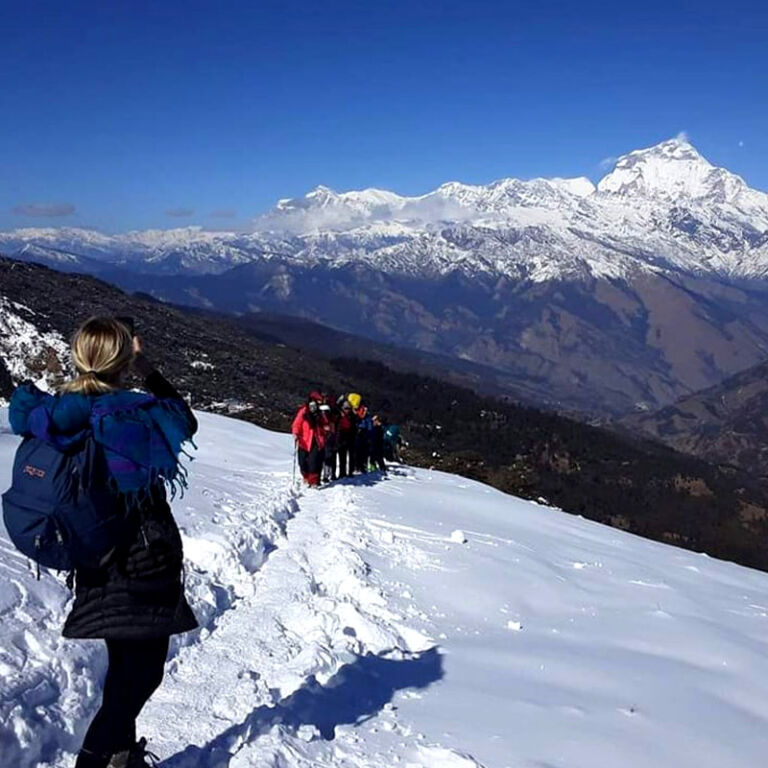
- Trip Duration: 4 Days
- Altitude: 3,210 m / 10,531 ft
- Best time: Mar-May, Sep-Dec
- Grade: Moderate
- Trek Type: Tea House
- Meals: Included
- Accommodation: Hotel & Tea House
Overview of the Ghorepani Poon Hill Trek
The Ghorepani Poon Hill trek is the most popular and shortest in the Annapurna region of Nepal and is suitable for all age groups. This trek offers natural views of the beautiful mountains (Annapurna, Dhaulagiri, Machhapuchhre, Nilgiri, Himchuli, and several other attractive white-capped peaks). Apart from the Himalayan scenery, the sunrise is equally fascinating from Poon Hill over the Annapurna Range, one of the most beautiful mountain ranges in the world.
Highlights of the Ghorepani Poon Hill Trek
- One of the shortest and easiest treks in Nepal,
- Reach Poon Hill viewpoint,
- Famous Ghandruk village in the Annapurna region,
- Enjoy an early sunrise from Poon Hill.
- Walking through Rhododendron forest, rivers, waterfalls, traditional Gurung, and Magar villages.
Outline Itinerary of the Ghorepani Poon Hill Trek
KTM ) Arrival in Kathmandu city, transfer to your hotel
PKR ) Flight or drive to Pokhara city, transfer to the hotel
Day 01 ) Drive to Hile (2 hours), trek to Banthanti (2,210 m) (3/4 hours)
Day 02 ) Trek to Ghorepani (2,874 m) (3/4 hours)
Day 03 ) Early morning hike to Poon Hill (3,210 m), trek to Tadapani (2,610 m) (5/6 hours)
Day 04 ) Trek to Ghandruk (2,012 m) (2/3 hours), drive back to Pokhara (822 m) (2/3 hours)
PKR ) Fly or drive back to Kathmandu, transfer to the hotel
KTM ) Departure to your home
Not satisfied with this itinerary?
Ghorepani Poon Hill Trek: Detailed Itinerary
Ktm) arrival in kathmandu city, transfer to your hotel.
- Meals: Breakfast
- Accommodation: Hotel
- Altitude: 1,400 m, Kathmandu
At Kathmandu Tribhuvan International Airport, you will be received by a Himalayan Odyssey Nepal Trek guide/staff and transferred to your hotel. Stay overnight at the hotel.
PKR) Flight or drive to Pokhara city, transfer to the hotel
- Altitude: 822 m, Pokhara
We can take a bus/car/van/flight to Pokhara from Kathmandu. Free day in Pokhara. Prepare for the trekking. Stay overnight at the hotel.
Day 01) Drive to Hile from Pokhara (2 hours), trek to Banthati (2,210 m) (3/4 hours)
- Meals: Breakfast, Lunch, Dinner
- Accommodation: Lodge
- Altitude: 2,210 m, Banthati
First, drive to Hile from Pokhara, and start your trek. You will pass through a forest and cross the Burundi River to get to Tikhedhunga Village. Next, you will make a challenging climb up Ulleri Hill, which has lots of steps and rocks. Eventually, you will reach Banthati, where we will spend the night in a lodge.
Day 02) Trek to Ghorepani (2,874 m) (4/5 hours)
- Altitude: 2,874 m, Ghorepani
After eating breakfast, we make our way to Ghorepani village. As we enter the forest, you’ll pass waterfalls, small towns, and a few tea houses on the way. When you arrive in Ghorepani, you can get an amazing view of Annapurna South. Stay overnight at the lodge.
Day 03) Early morning hike to Poon Hill (3,210 m), trek to Tadapani (2,610 m) (6/7 hours)
- Altitude: 3,210 m, Tadapani
Wake up early in the morning and hike to Poon Hill without a moment to spare to see the sunrise view over the Himalayas. Poon Hill is the most well-known destination to appreciate close-up perspectives on Annapurna and Dhaulagiri. After spending some time on Poon Hill, we trek back to Ghorepani and, after breakfast, walk towards the east and climb an edge, heading towards Tadapani. The path drops through rhododendron forests and waterfalls before arriving at Tadapani. Stay overnight at the lodge.
Day 04) Trek to Ghandruk (2,012 m) (2/3 hours), drive back to Pokhara (822 m) (2/3 hours)
Today is our final day of the trek. We will be able to see a beautiful sunrise from Tadapani and appreciate the stunning view of South Annapurna and Mt. Fishtail. After breakfast, we trek to Ghandruk village, one of the famous villages in the Annapurna region. After having lunch in Ghandruk village, we take a jeep back to Pokhara. Stay overnight at the hotel.
- Airport pickup and drop-off for arrival and departure
- A total of two nights’ accommodation in Kathmandu (Bed and breakfast) after the arrival and after the trek
- Annapurna Conservation Area Permit (ACAP) fee Trekkers Information Management System (TIMS) card fee
- All government, local taxes, and official expenses
- A government-licensed, experienced trek leader (guide), an assistant trekking guide for 8 or more trekkers, and porters to help trekkers with luggage ( *1 porter for two trekkers; the maximum luggage limit per trekker is 14 kg. )
- Guides and porters costs, which include meals, insurance, salary, lodging, transportation, and other necessary equipment
- Transportation for Kathmandu-Pokhara-Kathmandu on a tourist bus
- A total of two nights’ accommodation in Pokhara (Bed and breakfast) before and after the trek
- Private transportation: (From Pokhara – starting point of the trek) (From the end point of the trek – Pokhara)
- All accommodations during the trek
- Three meals a day (Breakfast, Lunch, and Dinner) during the trek
- Arranging rescue operations in cases of complicated health conditions (funded by travel insurance)
- International flight airfare
- Domestic flight airfare (Kathmandu-Pokhara-Kathmandu)
- On Arrival Visa Fee at Entry Points: [15 days: USD 30, 30 days: USD 50, 90 days: USD 125]
- All accommodation and meals in Kathmandu, before and after the journey
- Extra night’s accommodation and meals in Kathmandu and Pokhara due to early arrival, late departure, or an early return from the trek
- Lunch and dinner in Pokhara
- Personal expenses (shopping, snacks, bottled water or boiled water, hot (tea, coffee) and cold drinks, hot shower, alcohol, Wi-Fi, telephone call, battery recharge fee, extra porters, etc.)
- Personal clothing and gear
- Travel insurance has to cover emergency high-altitude rescue and evacuation, along with medical coverage
- Tips for guides and porters
- Additional costs due to delays caused by circumstances outside company control like landslides, weather conditions, itinerary modifications due to safety concerns, illness, changes in government policies, strikes, etc.
Client Inquiry Form
[natural habitats of the annapurna region].
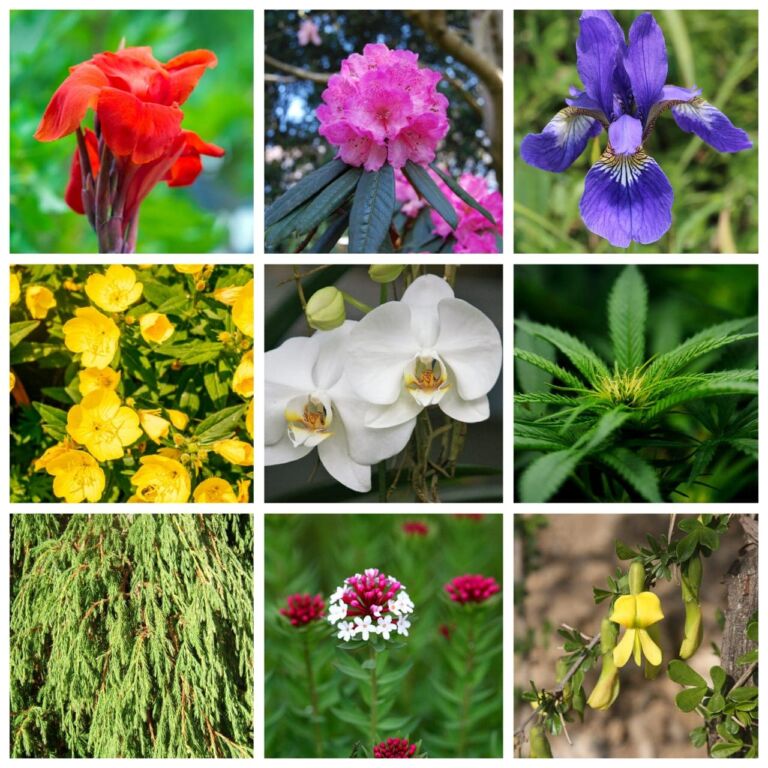
Flora found in the Annapurna region
Row 01: Canna lily, Rhododendron, Iris Row 02: Yellow primrose, White orchid, Marijuana Row 03: Juniper bush, Stellara, Caragana brevispina

Fauna found in the Annapurna region
Row 01: Bharal (Blue sheep), Snow leopard, Himalayan wolf Row 02: Gray langur, Leopard, Jungle cat Row 03: Red fox, Himalayan marmot, Red giant flying squirrel
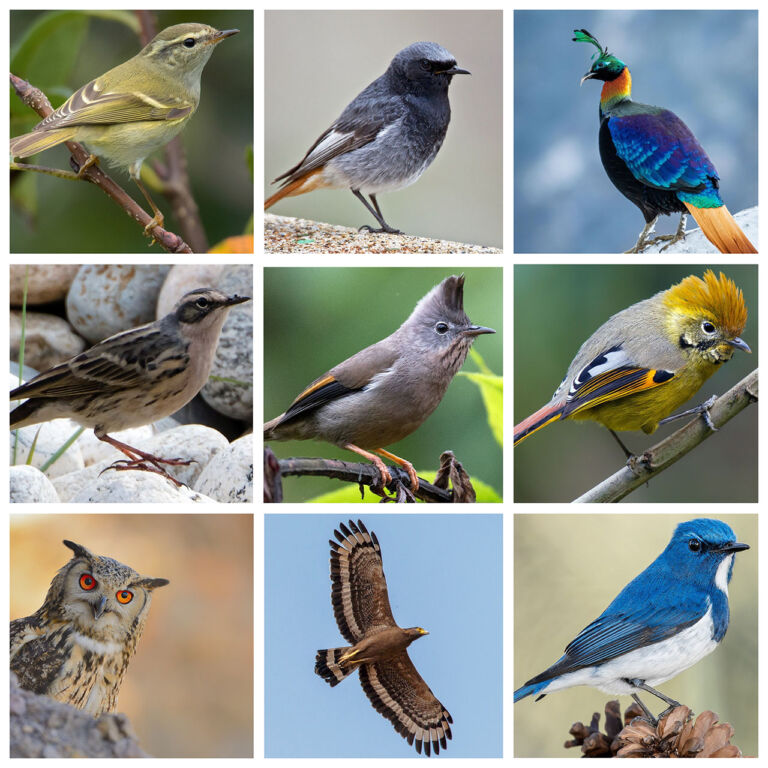
Birds found in the Annapurna region
Row 01: Hume's leaf warbler, Black redstart, Impeyan pheasant Row 02: Rosy pipit, Stripe-throated yuhina, Chestnut-tailed minla Row 03: Rock eagle owl, Crested serpent eagle, Ultramarine flycatcher
Travel Information
All trekkers must provide a copy of their comprehensive travel insurance policy certificate to the Himalayan Odyssey Nepal Trek before starting the trek.
[Note:] The policy must cover medical and emergency repatriation, including helicopter rescue and evacuation expenses at high altitudes.
Trekking permit requirements Two permits are required for the Ghorepani Poon Hill Trek : 1) a TIMS (Trekkers Information Management System) card 2) an entry permit for the Annapurna Conservation Area Project permit
A short clip of the Ghorepani Poon Hill Trek
It is possible to do the Ghorepani Poon Hill trek within 2 days, but it would be a very fast-paced and strenuous schedule. If you are short on time, it is recommended that you be in good physical condition and have previous trekking experience.
Safe drinking water is easily available during the trek. You should carry a water bottle so you can refill the water that is available in every lodge. It will be better to bring purifying tablets for safe drinking during the trek.
Coughs and headaches are normal in the mountains. However, if you suffer from a high-syndrome illness, you have to make your way backward. Visit our Altitude Sickness page for more information.
Yes, cellular networks can be found on the trekking trails of the Ghorepani Poon Hill Trek.
Ask a question ...
Trekking map of ghandruk poon hill trek: 4-days itinerary.
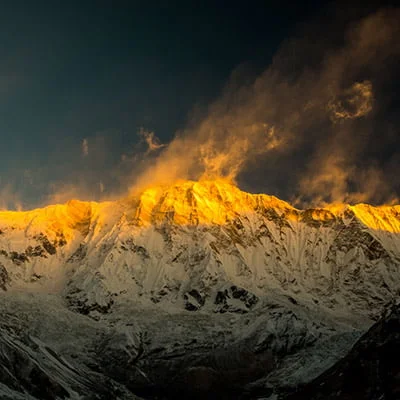
Annapurna Base Camp Trek via Poon Hill
Duration: 9 Days
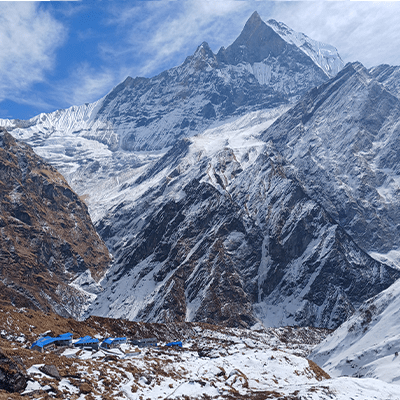
Annapurna Base Camp Trek
Duration: 7 Days
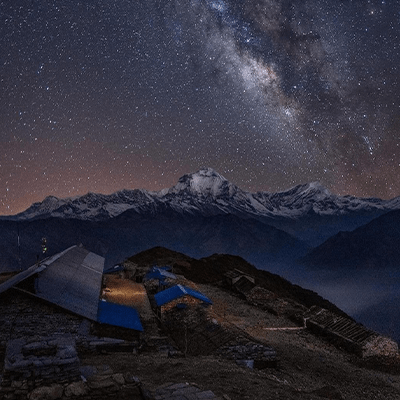
Khopra Ridge Trek
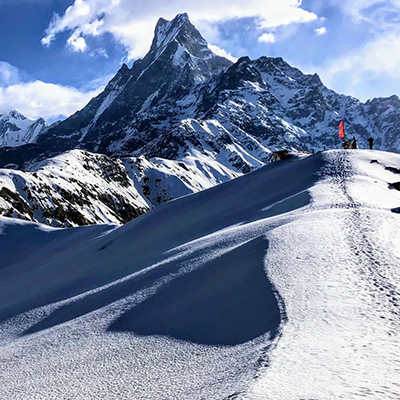
Mardi Himal Trek
Duration: 5 Days
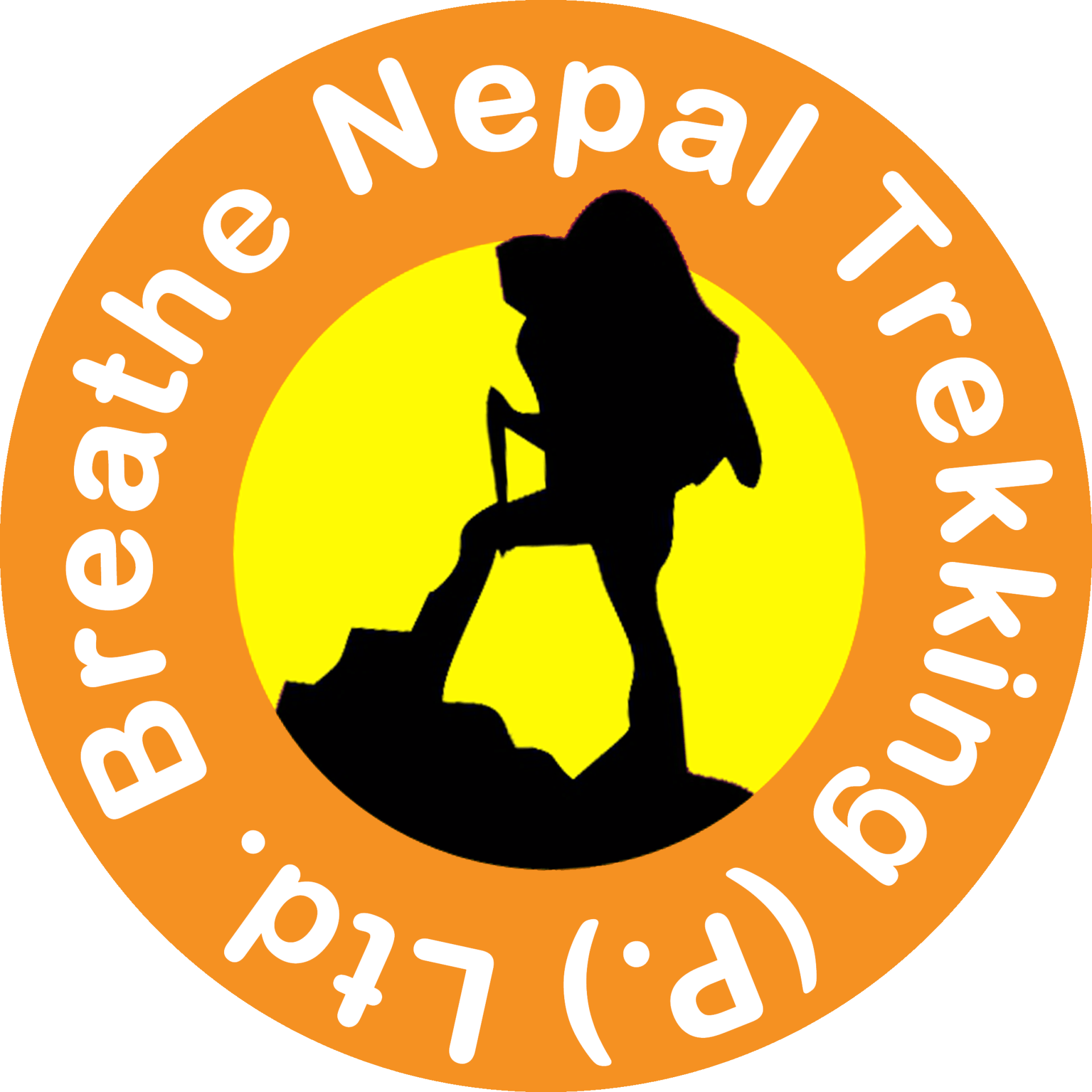
Best Of Annapurna - Poon Hill Trek
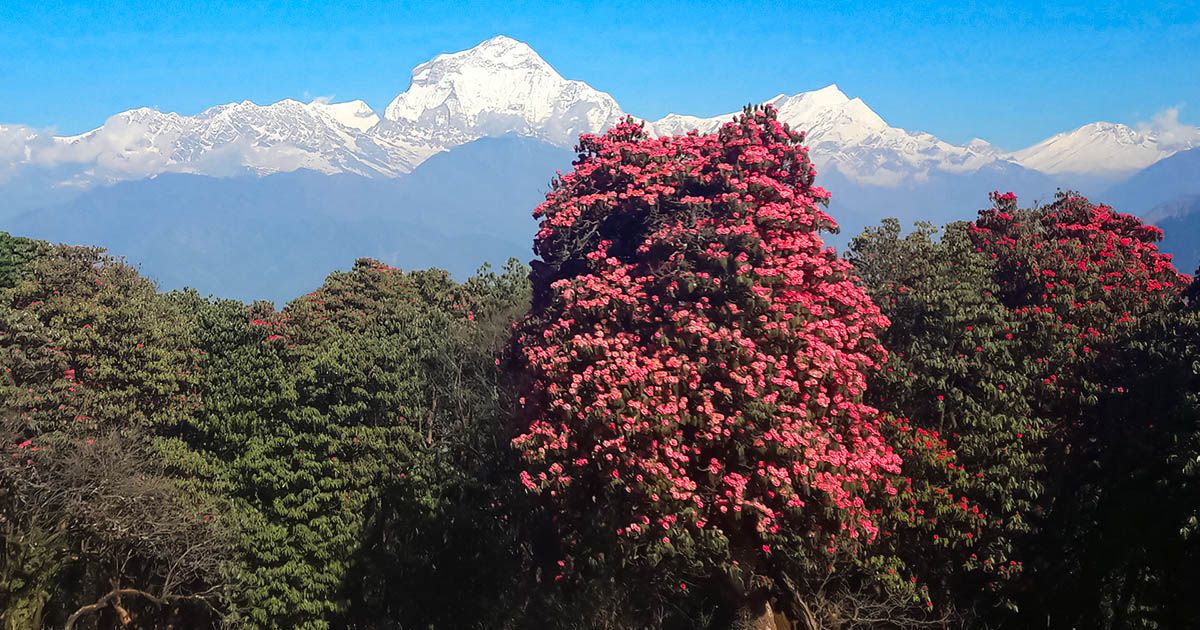
Highlights:
- Sunrise over the Annapurna and Dhaulagiri peaks from the top of Poon Hill (3,210 m)
- Magnificent views of the Annapurna South, Hiunchuli, and Machhapuchhre peaks
- Passing through traditional Gurung villages and terraced farmland
- Encounter with the lively culture and welcoming hospitality of the local people
- Breathtaking rhododendron blossom in March and April
The Poon Hill Trek is one of the most popular trekking routes in Nepal, and offers beautiful views of the Himalayas and a chance to experience the culture and traditions of the local Gurung people. We highly recommend the trek with all its highlights in our "Best of Annapurna" program . Located in the Annapurna region, the Poon Hill Trek takes you through picturesque landscapes and traditional Nepalese villages, culminating in the sunrise at the summit of Poon Hill. The Poon Hill Trek takes 3-7 days to finish.
Trek Description
The Poon Hill Trek begins at Nayapul , a small village located about an hour's drive from the city of Pokhara. From there, the trail winds through terraced fields and dense forests, passing through charming villages along the way.
One of the highlights of the trek is the beautiful Ghorepani village, where you can spend the night in a cozy guesthouse. The village offers stunning views of the Annapurna range and is a great place to acclimatize to the altitude.
The next day, you will make an early morning ascent to Poon Hill (3,210 m ), where you will be rewarded with breathtaking views of the Himalayas. The summit of Poon Hill offers panoramic views of the surrounding mountains, including Annapurna South, Dhaulagiri, and Machhapuchhre. The sunrise over the peaks is truly a sight to behold, and many trekkers consider it the highlight of the trek.
After spending some time at the summit, you descend to Ghorepani and continue on to the beautiful Ghandruk village . Ghandruk is a traditional Gurung village that offers a unique insight into the culture and way of life of the local people. You can explore the village and learn about the Gurung culture and traditions, visit the local monastery, and enjoy the hospitality of the friendly locals.
The Poon Hill Trek is a great way to experience the beauty of the Himalayas and the culture of Nepal. It is suitable for beginners and families and offers a taste of the Himalayan trekking experience without the commitment of a longer trek. The stunning views, charming villages, and warm hospitality of the local people make the trek a must-do for anyone visiting Nepal.
Trekking Seasons
Spring (March to May): With clear skies and mild temperatures (averaging 20°C/68°F), trekkers can expect comfortable conditions and breathtaking panoramas of the surrounding mountain range and valleys. The flourishing flowers elevate the natural beauty, making it the prime time for this scenic journey.
Summer (June to August): The monsoon season (average of 25°C/77°F) brings a lush and verdant landscape, with waterfalls and streams flowing at their maximum. For those seeking a serene and tranquil escape, trekking during the monsoons is a rare chance, away from the busy tourist crowds.
Autumn (September to November): Ideal trekking and sightseeing conditions are provided by the clear skies and mild weather (average of 20°C/68°F). The autumn months are especially breathtaking with the colorful foliage, adding to the already stunning scenery of the trek.
Winter (December to February): Trekking during the winter months (average of 10°C/50°F) presents a peaceful and serene atmosphere, with snow-capped mountains and tranquil trails. The winter landscape can be breathtaking and is an exceptional opportunity for those prepared for the cold to enjoy a winter trek.
The Poon Hill Trek offers a noteworthy natural and cultural experience, but the ideal time to trek varies based on personal preferences, physical ability, and weather.
You can check the weather forecast for Poon Hill by clicking here.
What To Pack
For details on the suitable packing list for the Poon Hill trek, refer to the Trekking Equipment section on our website.
Note: Be sure to check the weather forecast and pack accordingly.
Explore Our Full-Package Offers
Reviews on TripAdvisor:
Poon hill trek map.
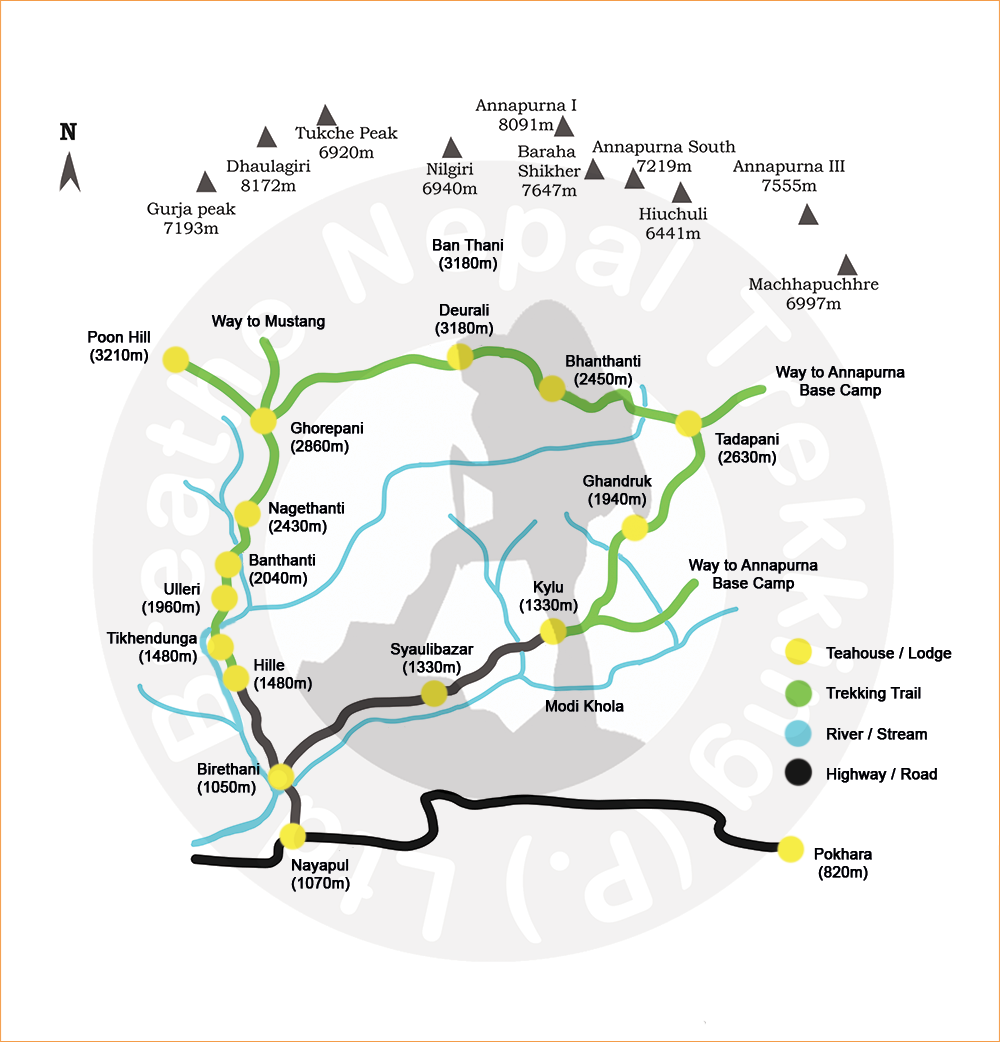
Looking for something else?
No problem! Let us know your preferences through a message, and we'll work to create a tour that's personalized just for you!
CONTACT INFO
+977 9856039350, [email protected], breathe nepal trekking, 6, pokhara nepal, useful links.

Himalayas on Foot
Local Trekking Company in Nepal

Poon Hill Trek 5 Days

Poon Hill Trek 5 days itinerary is one of the short and spectacular trekking to the Annapurna region of Nepal. It offers a wonderful view of Annapurna, Dhaulagiri, Machhapuchhre, and many other Himalayas.
It is an easy 5-day trek that starts from Nayapul, one hour drive from the beautiful city, Pokhara.
Poon Hill is hugely rewarded with magnificent sunrise views of Annapurna and Dhaulagiri ranges to the north. It lies at 3,210 meters high above the sea level. The outstanding sunrise view from Poon Hill makes this place a paradise.
You can witness lowland hills to the south, terraced slopes, and unique villages in this area. In addition to that, you can encounter the wonderful culture and lifestyle of the local people.
Poon Hill is famous for its traditional villages, ethnic communities, and the view of more than ten snow-capped mountains.
The trail of Poonhill Trek goes through beautiful Ulleri and Ghandruk villages. These villages are mostly inhabited by the Gurung and Magar community. This journey leads to the dense forest of rhododendron and oak. Especially, in spring the rhododendron forests beautify the whole trek route.
On this short trip, you get to catch the awesome view of the Himalayas, diverse culture, and varied terrain.
Highlights of Poon Hill Trek-5 Days
- Easy, comfortable, and short trek suitable for all travelers.
- 360 degree of panoramic sunrise view of Annapurna Himalayan ranges from Poon Hill.
- The spectacular mountain view of Annapurna, Dhaulagiri, Nilgiri, Fishtail, and many other high peaks.
- Witness the distinct culture and lifestyle of the Gurung and Magar community.
- Walking through the dense forests, waterfalls, and rivers.
- Exploring the authentic villages with hospitality.
- Hike to the popular 3300 stone stairs of the Ulleri village.
- Contact Number *
- Your Message *
- Please press 5 to submit *
Detailed Itinerary of Poon Hill Trek-5 days

Day 1: Kathmandu to Pokhara to Nayapul and Trek to Ulleri
Maximum Altitude: 1,960 meters, Ulleri
Trek Hours: 5-6 hrs
Our Poon Hill trek starts with a short flight (30 minutes) from Kathmandu to Pokhara.
Poon Hill trek-5 days starts from Pokhara. The journey will start driving all the way from Pokhara to Nayapul. It takes around 1 hour of drive to reach Nayapul.
From this point, it’s all about hiking to a grueling 3000 plus stairs one by one to Ulleri village. It is at 1,960 m height from the sea level.
There are many innate things to explore in this area. We can see outstanding green hills, cascading rivers, and many local villages. We will walk approximately 5-6 hours from Nayapul to Ulleri village.
Overnight stay at Ulleri village.
Day 2: Ulleri to Ghorepani
Maximum Altitude: 2,835 meters, Ghorepani
Trek Hours: 6-7 hrs
In the next morning, we start commencing towards Ghorepani from Ulleri village.
Heading towards to this route, we will cross the Magar village of Banthanti. From here, the views of Machhapuchhre (6,997m), Himchuli (6,441M), and Annapurna South (7,219m) look spectacular.
We will walk through a forest area full of rhododendron, oak, and pine trees. After that, we will arrive at Ghorepani enjoying the view of the forest and natural vegetation throughout the walk.
Overnight stay at Ghorepani village.
Day 3: Ghorepani to Poon Hill and Trek to Tadapani
Maximum Altitude: 3,210 meters, Poon Hill
Trek Hours: 5 hrs
On this day, we will hike uphill to Poon Hill above the sea level.
From Poon Hill, we will see the spectacular view of Annapurna and Dhaulagiri, the two major mountains above 8000 meters. The awesome sunrise view over the Himalayan ranges is breathtaking.
We can also enjoy the panoramic view of Nilgiri Himal, Mardi Himal, and other stunning peaks.
After enjoying all the beautiful moments we will trek back to Ghorepani. Then we leave Ghorepani to reach our next destination to Tadapani village. This trail leads to uphill and downhill through dense and beautiful forests.
Overnight stay at Tadapani village.
Day 4: Tadapani to Ghandruk

Maximum Altitude: 1,940 m, Ghandruk
Trek Hours: 3-4 hrs
Today, we will leave Tadapani village in the early morning and head towards Ghandruk village.
Walking all the way through the rhododendron and oak forests we will arrive at Ghandruk village.
A warm welcome by the local people with their typical culture and traditions will keep you engaged. They will entertain us with the traditional dance in the evening.
You will have a delightful stay in Ghandruk Village.
Overnight stay at Ghandruk.
Day 5: Ghandruk to Nayapul and Drive to Pokhara
Maximum Altitude: 1,940 m, Nayapul
Trek Hours: 4-5 hrs
On the last day of our trek, we will head back to Nayapul from Ghandruk village.
After the astonishing view of Annapurna and Fishtail mountains, we will walk down to Nayapul. This trail is mainly downhill and takes around 2-3 hours to reach Nayapul from Ghandruk.
Modi Khola will follow this downhill trail till Nayapul. We will walk approximately 5 hours on this day.
After we reach to Nayapul, we drive back to Pokhara. Collecting all the beautiful memories, we will end our trek with a scenic drive back to Pokhara.
Gear and Equipment for Poon Hill Trek 5 days Itinerary
- Walking pole – depending on personal preference. It helps so much!
- Refillable water bottle – the area is a no-plastic zone!
- Backpack with waist strap and or back panel – If you are going with a tour company, they would usually provide a duffle. But if they don’t, make sure you have two backpacks. If you need a bigger one, this is highly recommended.
- Waterproof jacket or umbrella – it doesn’t get that cold on the hike but it can rain. So bring either or both. For the waterproof jacket, bring something that’s not too bulky as it can get hot hiking in the rain
- Waterproof trousers –It’s good to have!
- Fleece – more for the evening and at night when the temperature drops. Despite being indoors, it will be pretty cold. Something that can zip up would be ideal .
- Hat – for the sun. Most people wear a cap, but a hiking cap might be better if you are prone to sunburn
- Sunglasses – get a polarising one for the best protection.
- Fast dry towel – maybe a small one – for showers and sweat
- Long socks – there are leeches so it’s best to have long socks
- Sunscreen – high altitude means that the sun is stronger. So it’s best to put on sunscreen!
- Hand sanitizer and or wipes – your hands are going to get dirty
- Toilet paper
- Moisturiser – for your skin because they are going to get battered
- Hiking shoes
- Flip Flops – for evening wear, you can also bring trainers or just sandals as well depending on space.
- Power bank – a lot of the guesthouses charges for charging your devices. Plus, there will be some limited plug space, so bring one with higher voltage storage.
- Head torch – you would need it for the sunrise hike up to Poon Hill, and it’s good for getting around
- Knee brace or support – there are a lot of stairs, so if you have weak knees or need extra support, bring something!
- First aid kit – bring some medical supplies such as painkillers, cold meds, band-aids, etc, especially if you are not hiking with a guide
- Waterproof shell for the backpack – when downpours do happen, you would need to make sure your valuables are well protected!
- Sleeping bag
Food and Accommodations During Poon Hill Trek 5 days Itinerary

Homestays, tea houses, and restaurants are easily available in this trail to Poon Hill. Typical Nepali staple food which is Dal Bhat with seasonal vegetables is basically served.
But, you can also find variation in food like momo, noodles, soup, Chowmein, and so on. Plus, tea, coffee, and drinks are easily available throughout this route.
While for accommodation, you will also get basic to standard accommodations in this trail. In general, tea houses offer a twin-sharing bedroom with an attached bath.
Poon Hill Trek-5 days is a short trek possible for people of all ages. It is popular for short holidays and wonderful sunrise view over the Annapurna and other mountains.
Poon Hill Trek-5 days is an excellent way to explore and experience the culture and nature of the Annapurna region of Nepal. And, take a short break to the Himalayas.
It is also a trip that you can take before you take the Annapurna Base Camp trek or the Annapurna Circuit trek .
For detailed information and questions regarding the trek, please contact us .
You may also like...

Poon Hill Trek Itinerary

Khopra Danda Difficulty

Ghorepani Poon Hill Trek Cost

Ghorepani Poon Hill Trek – the ultimate hiking itinerary
Posted on Last updated: April 25, 2024
Categories Nepal

Namaste! We have just completed our 14-day Nepal trip and are back in Malaysia. The highlight was, of course, our ABC trekking which also included the Ghorepani Poon Hill Trek.
In this article, we will focus on our Ghorepani Poon Hill Trek from the starting point of our hike, that is, Hille, to Poon Hill and then back to Ghorepani. Other articles will be on our ABC trek and places we have visited in Pokhara, Kathmandu, and Lumbini.
We arrived in Kathmandu a day before and spent another day in Pokhara yesterday. Today, after breakfast, we are all getting ready to start trekking.
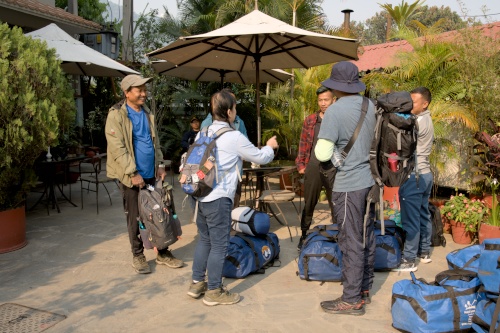
1. From Pokhara to Hille to Ulleri
Day 01, April 10: Drive to Hille and trek to Ulleri (2,050m). Approx. Time: 3-4 hours. Approx distance: 7 KM, Overnight at Super Viewpoint Guest House

On the first day of our ABC trek, we began from our hotel, Mountain View Pokhara. After breakfast, we traveled by jeep to the starting point of our trek, Hille. Our jeep went through a dusty off-road journey, which took slightly more than two hours)
It took us about two hours to reach Hille from Pokhara. Along the way, we passed by Nayapul and continued along the Modi Khola to Birethanti. These two villages used to be the starting points of the trek, but as the road has now been extended to Hille, we will start from there rather than walking on the dusty road used by the jeep.

Beneath the radiant sun and warm temperatures, we opted for minimal clothing, but we were already starting to sweat. It is an easy trek with some occasional high steps.

Once we arrived at the starting point, our porter bundled the two duffle bags together. They are so strong that they are beyond our imagination. The total weight should be about 30kg, compared to our much smaller backpacks, which weigh around 8-10kg.

Tea houses dotted the path, and we stopped once we reached Tikhedhunga, a short trek that took us under half an hour.
At Tikhedhunga (1540m), we paused for lunch at the Chandra Guest House & Restaurant before pressing on towards Ulleri. The restaurant served a variety of local and Western food. This is our first meal along our trip, with expectations set for similar food offerings at subsequent tea houses along our route in the days ahead.

We soon traversed a suspension bridge and continued with our ascent along the trail. The hike was considered easy, although there were a few steep climbs. En route, we were treated to the sight of cascading waterfalls and Nepal’s national flower, the rhododendrons.

In the late afternoon, we reached the picturesque Magar village of Ulleri. Our accommodation for the night was at the Super Viewpoint Guest House, where we checked in and settled for the evening.
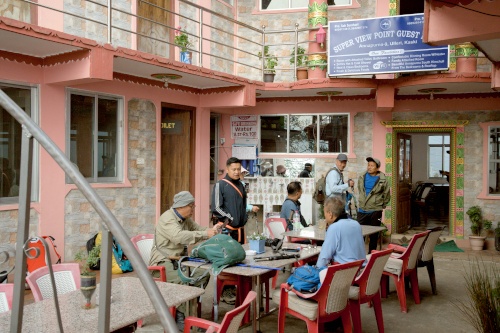
We had dinner and tried the country’s national dish, Dal Bhat, and other local delicacies.

2. Trek from Ulleri to Ghorepani
Day 02, Apr 09: Trek to Ghorepani (2860m), approx 4-5 hours, Approx distance: 8 KM, overnight at Fishtail Guess House

The following day, we continue the Ghorepani Poon Hill Trek on a long hike towards Ghorepani. After having breakfast, we began our trek with full stomachs.

The trail we walked on was a gentle uphill climb that took us through various landscapes, such as cultivated fields, villages, and pastures. Along the way, we were treated to several captivating and stunning views, such as waterfalls, bridges, horses roaming, and locals carrying heavy stuff on their backs.

During our journey, we took a break and had lunch at Green View Guest House, which is located in Nangethant, a small village.

There are guest houses along the way, so finding a restroom is not an issue. This also means we can drink plenty of water without worrying about dehydration.

After lunch, we resumed our journey through the stunning forest trails decorated with blooming rhododendrons.
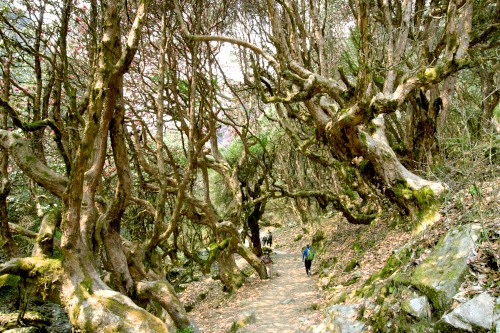
Finally, we reached our destination for the day, Ghorepani. Our tour guide assisted us in registering at the Tourist Police Office Checkpoint, and we spent the night at Hotel Fishtail and Restaurant.

3. Ascending to Poon Hill
Day 03, Apr 10: Early morning hike to Poon Hill and trek to Tadapani (2630m), 6-7 hours, Approx distance: 12 KM

The following day, we woke up early at 4.15 am as we wanted to hike up to Poon Hill before daybreak and witness the breathtaking sunrise. Aware that it was too early for the tea house to serve breakfast, we settled for a simple meal of bread.
We embarked on the ascent to Poon Hill with headlamps—a familiar experience reminiscent of our previous trek up Mount Kinabalu for the same purpose: sunrise viewing.

The trail predominantly comprised uphill stairs with minimal descents, demanding considerable effort from us. However, fueled by anticipation, we forged ahead eagerly.
After a trek lasting 1.5 hours, we finally reached the summit of Poon Hill just moments before the sunrise.
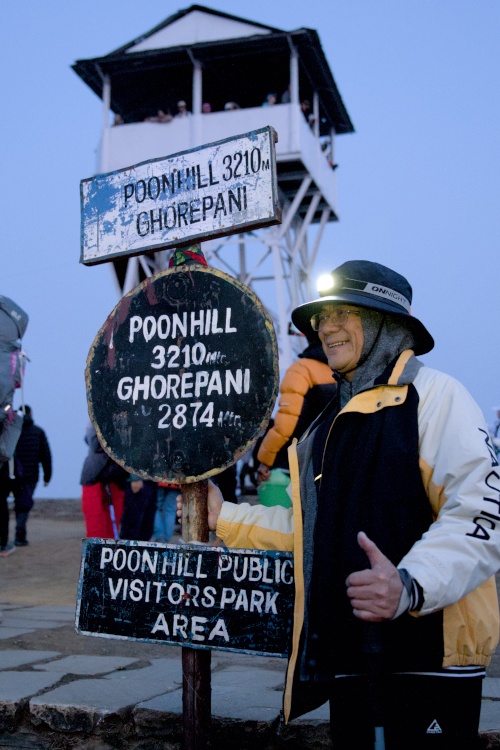
The famous view tower of Poon Hill is located at the height of 3210m, which bestows the jaw-dropping Himalayan panorama of the majestic Annapurna, Fishtail, Nilgiri, Hiunchuli, Annapurna South and Dhaulagiri mountain ranges.

There is a watchtower that offers a stunning 360° panoramic view of the mountain.

There is a shop that sells hot tea and coffee on Top of Poon Hill. However, the queue was too long as now is the peak season, so we decided to skip it.

We met a determined man with an amputated leg who took the challenge of the Ghorepani Poon Hill Trek. His determination is an example for all of us to achieve our goals, no matter how difficult they may seem.

4. Descending back to Ghorepani
After taking multiple photos and video clips, we descended to Ghorpani, following the same path. The descent was demanding on the knees, as some steps were relatively high.

The trail passes through the rhododendron forests, which are now in full bloom, making the journey even more scenic.

Finally, we return to Ghorepani and have breakfast at our tea house.

5. What’s next after the Ghorepani Poon Hill Trek?
This marks the end of our Poon Hill Trek, a journey filled with joy and shared passion for hiking. However, due to my wife’s recent meniscus tear injury, she made the prudent choice to conclude her trek at Poon Hill, opting out of the onward journey for the Annapurna Base Camp Trek. From this point, her itinerary will include visits to Ghandruk, followed by Sarangkot, before circling back to Pokhara,
The rest of us still have much work to do to push ourselves to the limit and reach ABC. Most of us are in our sixties, and we know that our physical strength is even more demanding than that of younger hikers. However, we are determined and will accomplish our dream hike to ABC!
Stay tuned for our next article, where we will continue our hiking story through lush forests, rocky trails, hikes on snow, crossing avalanche areas, and more.
Related articles
- After we completed the ABC trek and returned to Kathmandu, we wrote an article based on our personal experience during the ten-day trek. This article provides valuable insights into what you need to know before embarking on the ABC trek.
- We have created a comprehensive packing list for individuals interested in embarking on an Annapurna Base Camp Trek in Nepal. This list includes essential information to help you prepare for the trek.
VJ Tamang, owner and tour guide of Grande Adventure, expertly organized and made our trip enjoyable. VJ can be contacted at https://www.grandeadventure.com/contact-us/ or through https://web.facebook.com/GrandeAdventures .
Renuka Devi
Thursday 25th of April 2024
What an adventure…. Kudos to both of you. Keep up the traveling & sharing the beauty of each place.
Trekking and Travel Blog Nepal, Tibet and Bhutan
We organize different tours and trekking in Nepal, Tibet, and Bhutan.
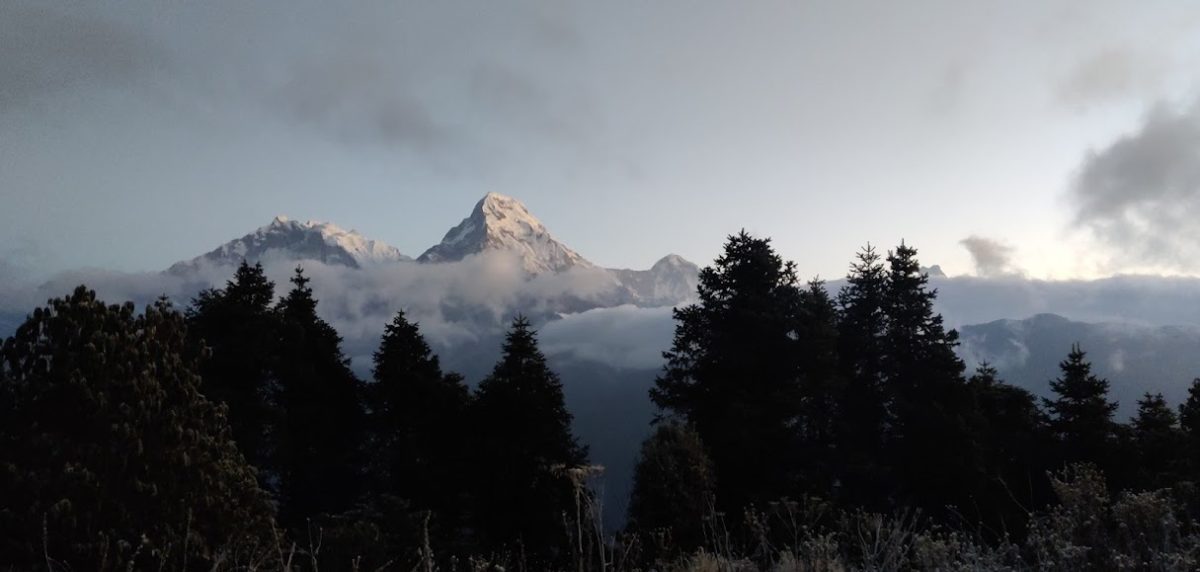
administrator
A complete guide to Poon Hill Trek: Famous Short Trek in Nepal
Poon Hill Trek has been considered one of the most popular trek spots according to its distance as it is considered one of the shortest and most classic treks in the Annapurna region. Poonhill is mainly considered as Ghorepani Poon Hill Trek as it lies among the areas of Ghorepani. The main stairs to Poonhill start from Ghorepani. The night must be spent in Ghorepani before going to Poonhill through which you can enjoy the beautiful mountains and sunrise view.
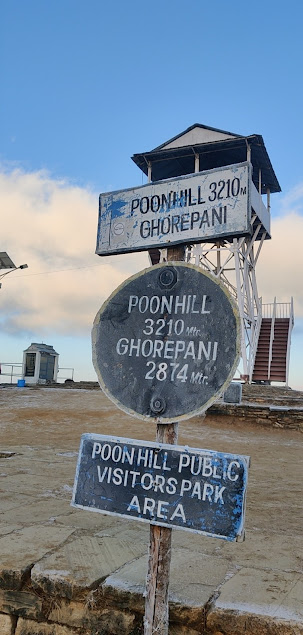
As for panning about the Poon Hill trek, the journey of trekking can be completed between 3 to 5 days depending upon the requirements of the client. Among all the treks in Nepal Poon Hill is considered one of the low-altitude treks which has a maximum altitude of 3210m/10,531.5 feet. The altitude of Poon Hill will be high compared to Ghorepani but the number of hours that you are going to spend on the top of Poon Hill will be less as the main purpose of going that high will be just to enjoy the View of the mountains and the beautiful sunrise around the mountains.
However, most of the time will be spent on Ghorepani where the altitude is just 2874m. The altitude in Ghorepani is casually normal where you are spending your night. The word “Ghorepani” is made up of two terms, “Ghore” and “Pani” because the term “Ghore” is used to represent horses, and the term “Pani” is used to represent water. Therefore, it is also known as a place where horses are watered and rich in water resources.
Where is Poon Hill?
Poon Hill is one of the most loved viewpoints which is located to the northeast of Pokhara where the journey starts with trekking. Poon Hill lies in the north-central area of Nepal. The Hill is very much near Ghorepani which lies in the Dhaulagiri district, So, Ghorepani plays an important role in going to Poon Hill because the steps towards Poon Hill start from Ghorepani.
You can complete your trek to poon hill in 3 to 5 days. If you have the problem of altitude sickness, then you may not worry about that because the time that you will be sending in Poon Hill will be very less because the main purpose of climbing Poon Hill will be to enjoy the beautiful mountain and the sunrise. Rather than that you will mostly spend your time and spend your night in Ghorepani at the altitude of 2874m.
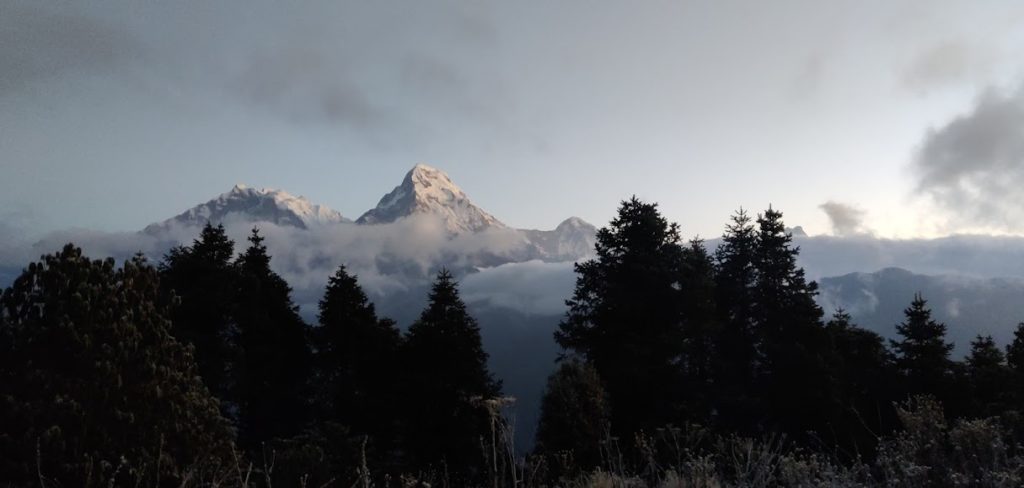
You don’t have to struggle while traveling to Naya Pul because you will be provided busses are jeeps to travel from Pokhara. You don’t need to worry about the routes or getting lost because by the time you reach Modi rive you will meet a junction where you be provided with the map of the Annapurna region that will help you towards your journey.
How long is the Poon Hill Trek?
As we have mentioned that Poon Hill Trek is one of the most classic short treks at an altitude of 3250m at the top of Poon Hill. The duration to reach poon is about 3 to 5 days and you can choose your route from Naya Pul, the place where you will be starting your trekking journey. While starting your journey you can choose your trekking route where you can head towards Tirkhedhunga or from Ghandruk.
If you can walk and want more days to be covered on your journey, then the route from Ghandruk is the best cause you will be able to enjoy the view and the environment of Ghandruk village and see its beauty, then you will be visiting Jhinu Hot Spring through which you will be able to reach Tadapani and then reach Ghorepani.
But if you want to complete your Poon Hill trek in fewer days then you must take your route from Trikhedhung through which you can easily reach Ghorepani. The final spot before going to Poon Hill will be Ghorepani where you have to spend your night and start your journey at 4 in the morning because you don’t want to miss the beautiful scenery of the mountains and sunshine.
How difficult is Poon Hill Trek?
As talking about the difficulties in Poon Hill Trek, this has been considered one of the shortest treks as it covers almost 45 kilometers. The route, roads, climate, and altitude are very much moderate towards the roads to Poon Hill.
Being an interested trekker one must have a will to complete his/her journey. A trekker,/must be active in their journey because going through a long journey one must show interest in it. Similarly, the roads to the Poon Hill trek are very amusing, entertaining, and enjoyable because you will get to experience different views across your journey. You can enjoy different views and sceneries such as the forests covered with rhododendron forest, mountain terrain, and a small waterfall along your way to Poon Hill.
What is the best time for Poon Hill Trek?
According to the views of Nepal, it is best to visit some places according to seasons. Similarly, the Poon Hill trek is one of the most beautiful trekking sites in Nepal where the views of the mountains are worth it. So the best time of the year to visit Poon Hill will be from mid-September to early November.
What to pack for Poon Hill Trek?
- A porter will carry a rucksack or duffel bag, and you will carry a day pack.
- Waterproofs to keep the rain and wind at bay (waterproof bottoms are optional)
- Shirts, trousers, shorts, T-shirts, sweaters, and jackets, as well as caps and gloves, are all available.
- Thin layers help wick away perspiration and keep you warm in the mornings.
- Boots that are comfortable to wear and have a strong sole and ankle support. In the evenings, shift into lighter footwear.
- To have a good night’s sleep at the lodges, bring a warm sleeping bag (3 seasons) (they also have blankets)
- Hard plastic water bottles, not disposable bottles, should be used.
- Toiletries, a towel, and a tiny first-aid kit which is normally provided by the company.
- Sunglasses and Sunhats
- Trekking poles, a jacket, and dry bags are all recommended.
- Phone charges, camera, and extra batteries.
Highlights of Poon Hill Trek
- One of the most well-known short hikes in Nepal—and with good reason.
- You’ll be rewarded with sweeping vistas of Dhaulagiri if you climb 3,381 stairs.
- Spend the night at one of the cozy teahouses along the trail.
- Views of alpine lakes, farms, and mountains, notably Annapurna South, are among the highlights.
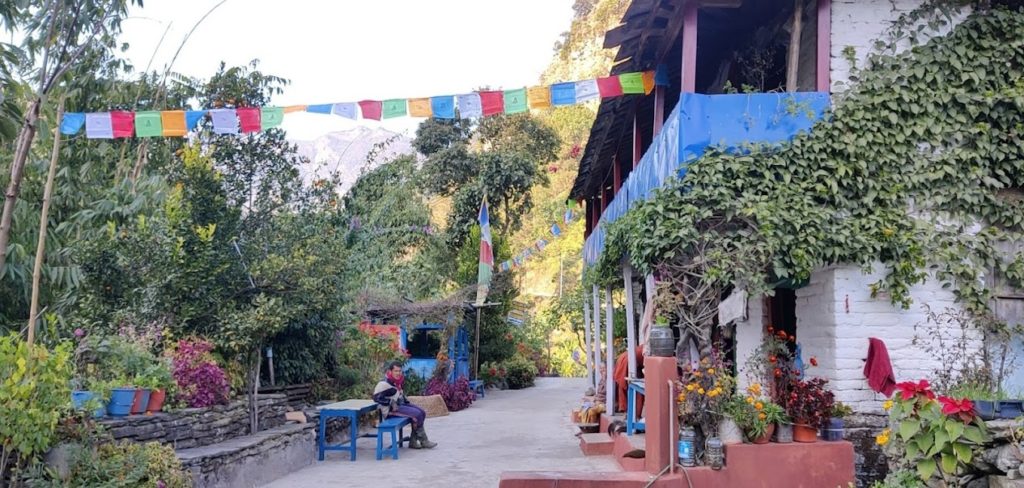
Recommended Poon Hill Trek Itinerary
Day 1: Drive to Pokhara from Kathmandu, then you will be driven from the Hotel in Pokhara to Nayaul to start your trek and end your day at Trikhedunga with a total walking distance of 9.2km
Day 2: You will be starting your day from Tirkhedunga to Ghorepani where you can enjoy the beautiful view of the Annapurna South where you will enjoy different forests covered with oaks and rhododendrons. Throughout your day you will be covering 12.9kms.
Day 3: From Ghorepani to Tadapani. On this day you will be heading towards Poon Hill where you can be admiring a lifetime view of the sunrise over the Annapurna South range. The third day of the trek will be the best one so far because you will be viewing some of the best sights. On this day you will be covering 3km from Ghorepani to Poon Hill and 9.7km from Ghorepani to Tadapani.
Day 4: The fourth day starts with the view of the Annapurna South which you can see from Tadapani. On this day you will be traveling from Tadapani to Ghandruk. The overall distance that you will be covering will be 6.5km but after a short-term climb of about 3.5km, you will be walking for 3 hours, downhill.
Day 5: On the last day of the trek you will have to walk a shorter distance, a total of 2.9km where you will be traveling from Ghandruk to Kimche. The trial that you will be walking will lead towards Nayapul. where you will be driven from Nayapul to Pokhara.
Permit for Poon Hill Trek
- For foreigners, the ACAP try permission charge is 3,000 NPR (about USD 30).
- For SAARC nationals, the ACAP entrance permit charge is 200 NPR.
- Permit for TIMS: 1,000 NPR (about USD 10)
Categories:

We're sorry, your browser does not support some of the features on this website.
Why not try upgrading your browser. Browse Happy
Ian Taylor Trekking PO BOX 5973 Vail Colorado 81658, USA
+1 785 9179436 +353 1 2544011 Email: [email protected]

Latest Blog Posts
Aconcagua: the normal route verses polish traverse route, summit night on aconcagua, 20 things you need to know before climbing kilimanjaro, leave a testimonial.
- [email protected]
- +1 785 9179436
- +353 1 2544011
- +44 20 8123 2876
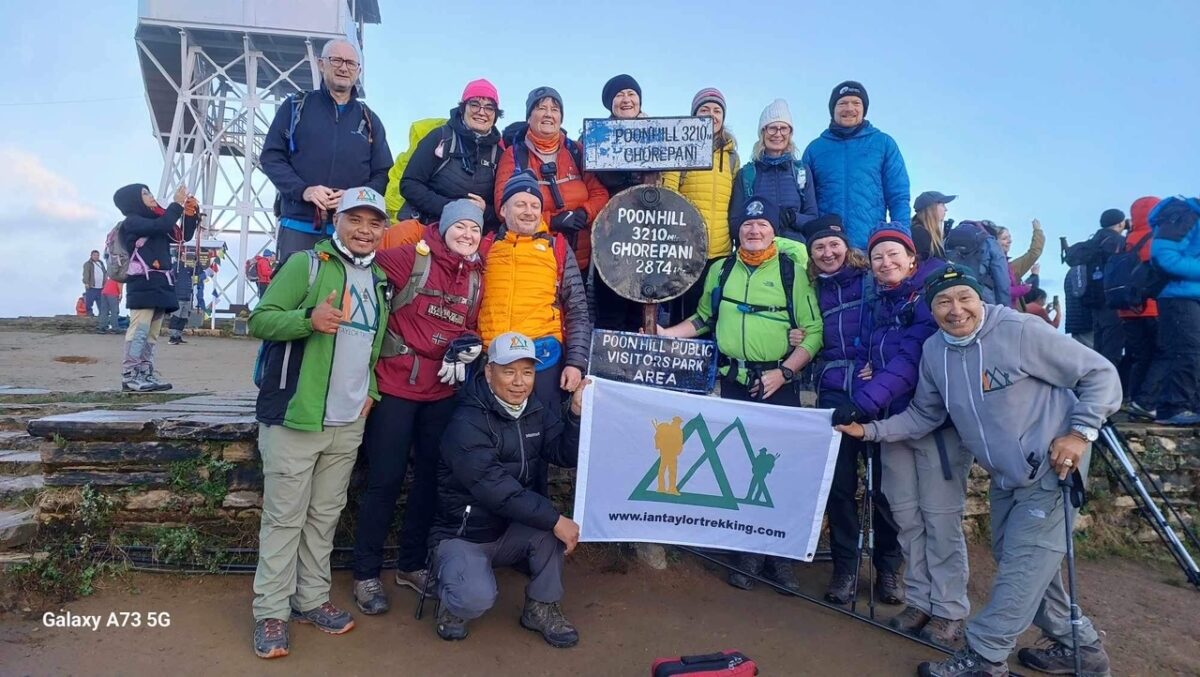
Poon Hill Trek
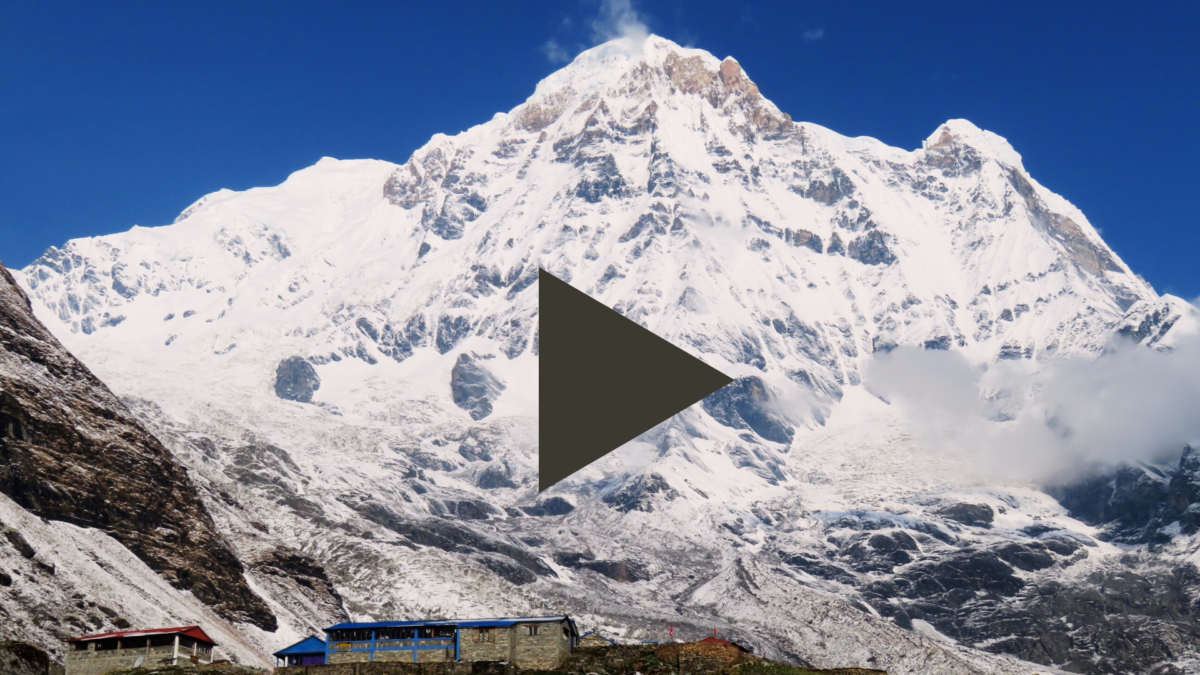
Tips & Advice
1). Our Award Winning Team
We have four guides for every group of ten trekkers on the trail! This sets up apart of other groups. We want to make sure all of our teams have the best chance at safely reaching their goal. With more staff on the trail with your team, they will be able to more efficiently manage your safety on the trail and also give you a better experience along the way. Learn more .
We do not outsource any of our treks and we have our own office in Kathmandu. All of our guides hold current Wilderness First Aid Certificates. They are able to get you the help you need in case of an emergency. Also, our guides will carry satellite and local phones with them. Read some REVIEWS from our treks.
2). Supporting the Local Community
We continue to support the local community in Nepal. In 2015 we helped establish the Goli Village Trust in Nepal. A lot of of staff come from the village of Goli in the lower Everest region of Nepal. We have built two schools in the Goli region and we have placed stoves in over 60 homes. We do need donations and help, therefore if you would like to donate, set up a trek to the village, give funds, clothes or school items, then get in touch. Please let us know and we can help you figure out how you can best help!
3). Expert Training Advice
We offer personal service with training advice for our clients, 5 days a week. A lot of people underestimate Himalayan trekking. We do not want to see this happen with our clients. Therefore, we want to make sure that you have the best information on how to complete the trek safely and successfully.
There are some long hiking days, covering over 600m/ 2,000 feet of up and down hill on steps or stairs while on the trail. We have professional training advice available to you 5 days a week and we can schedule calls with you as often as needed once you sign up to our trips.
4). 25 Years Experience
We have years of experience managing teams on the ground in Nepal. Our head guide has been at the forefront of tourism in Nepal for over 25 years. He is well connected on the ground with access to all the key organization and authorities. He is also passionate about the Sherpa culture, experience and preserving these traditions.
Anyone who has trekked with Dawa Chirri Sherpa will never forget it! Even if you just get to spend time in Kathmandu with him, you will love and cherish the experience. Dawa is married to Kay from Scotland, and they run our office together in Kathmandu. All of our clients joining trips to Annapurna Base Camp will experience the hospitality and quality service we have to offer.
5). 4 Star Hotel in Kathmandu
We include two nights in a hotel in four star hotel in Kathmandu. One night before your trek and one night after. All of our trips are on a shared basis, but if you prefer a single room, this can be offered at an additional cost. We use the Encore by Wyndham hotel in Thamel, which is the main tourist district of the city.
6). More Acclimatization
We have learned after years of experience that people need more time to acclimatize to the lower levels of oxygen, in order to have a safe and successful trip. Therefore, we live to include a trek to Poon Hill 3,210m/ 10,531 feet before heading towards Annapurna Base Camp. This added acclimatization sets you up nicely for for a great trekking experience into lower levels of oxygen. Having more days on the trail and more acclimatization increases safety, success and enjoyment.
7). Celebration Meal
We like to treat all of our teams to a celebratory meal at the end of your trek in Kathmandu! Ian’s favorite restaurant to enjoy after he is in the mountains is Fire and Ice Pizza Restaurant. Most of our teams will have the meal there as you can enjoy some delicious pizza after the trek (maybe even have a delicious mojito). This meal is included in the trip. You will be presented with your Everest Base Camp certificate of achievement and we will enjoy a beautiful meal before heading back to the hotel or a night out on the town.
8). Different Itinerary Options and Small Groups
We have multiple options for itineraries to Annapurna Base Camp . Our most popular itinerary treks to Poon Hill first, then treks to the main Annapurna Base Camp trail and back via the Jhinu hot springs. We can also tailor your trip to suit your needs for a private group. Therefore, if you have 4 or more people joining a trip, we can cater your private itinerary at no extra cost!
We only work with small group sizes. The maximum number of people per team will be 10 people. Some of our groups are even less people with only 6 or 8 team members. This will therefore give you are more personalized experience on the trail to Annapurna Base Camp.
1). Pick the best acclimatization itinerary for your Annapurna Base Camp trek
2). How you should be training to best physically prepare for your trek to Annapurna
3). Get FREE constant advice from our professional team
4). Understand the daily distances you will travel on the trek to Annapurna
5). Have the right clothing and gear for your Annapurna Base Camp trek
6). Pacing each day on the trail is critical to success
7). Why hydration is critical at high altitude and in low oxygen environments
8). Elevation gains on the Annapurna trail . This will help you formulate a better training plan
9). What sort of food will I get on the Annapurna Base Camp Trek
10). Read our Top 10 Tips for a successful Annapurna Base Camp trek
11). When is the best time to trek to Annapurna Base Camp
12). What vaccinations should you consider for your Annapurna Base Camp Trek
13). What type of trekking boots should you have for the Annapurna Base Camp Trek
14). What Insurance do I need for my Annapurna Base Camp Trek
15). What additional expenses will I incur on the Annapurna Trek
16). Here is some additional reading on down hill training
The trek to Annapurna Base Camp is a stunning journey around some of the worlds highest peaks. The trek leads you through the famous Annapurna Sanctuary, giving you a world class mountain viewing trek, from relatively lower altitudes.
Most of your trek to Annapurna Base Camp is spent below 3,000m/ 10,000 feet. However, the terrain is challenging, with thousands and thousands of stairs. This trek is achievable for any trekker who is ready to put in the preparations and training needed. However, you will have to do the specific training to fully appreciated and enjoy this stunning Himalayan Adventure!
Annapurna Circuit vs Annapurna Base Camp
The two trips are very different. Not only is the Annapurna Circuit trek a longer and more challenging trek, but a lot more of the Circuit trek includes more time at high altitude. The Circuit trek goes around the northern side of the Annapurna Mountain Range, ending near Pokhara. You do not actually enter into Annapurna Base Camp when you are on the Circuit trek. Also, you reach an altitude of 5,420m/ 17,782 feet on the Circuit trek, and on the Base Camp trek, the highest point reached is at 4,131m/ 13,553 feet.
Both options are wonderful experiences to take on, however the Circuit trek will definitely be a more physically challenging option. Personally, we love the Annapurna Base Camp trek! Some of the best mountain views in the world are from the Annapurna Valley and around the Annapurna Base Camp. All this viewing is done at lower altitude. Therefore, you will generally have warmer temperatures and less chance of altitude related issues. You do need to be physically prepared as this trek has a lot of stairs up and down hills.
Get the Right Physical Preparations
From the start of your adventure and throughout, you will be walking on stairs up and down. There will be short steps, long steps, up-hill steps and down-hill steps. Especially lower on the trail, as you move up to Ghorepani, Poon Hill and over towards the main Annapurna Base Camp Trail. This trek does require you to come physically prepared so make sure you are doing the right training for this trip. We have completed this journey many times and have the information you need to make sure you come prepared.
Train on Stairs
If you are planning a trip to Annapurna Base Camp, then you need to train on steps up and down. The terrain is steep and filled with steps. Therefore, you need to remember this as you prepare for the trek into this region of Nepal. If you know that you will be going up and down stairs on the trek, then you will want to make sure that this is incorporated in your training. Putting your weighted backpack on, and training going up and down stairs, will be essential to your training.
Read some REVIEWS from our trips and then CONTACT US. We can help you get the correct information about this exciting adventure.
Can I Make this Journey
This trek does require very specific training. Having excellent leg strength, balance, a strong core, and used to walking up and down long sets of stairs with a backpack on, is critical. We encourage you to train on a stair master with a weighted backpack at least four days a week. If you can do this as well as incorporating a longer hike with your weighted backpack, one day a week, you should be ready for this adventure. Make sure you come with the right physical conditioning in the legs so that you can enjoy the trek, not just endure it!
1). Train Before You Go
Come physically prepared. Although this trek spends minimal time at high altitude, it is a difficult trek, and requires preparation. There are thousands of stairs up and down as you make your way through this amazing mountain region. There is very little contouring. You will go up over mountain passes and back down the other side before going back up again. If you decide to sign up to an Ian Taylor Trekking trip we will help you under the terrain and the training required for this trip.
The Annapurna Base Camp Trek is a stunning walk through the world famous trail to Poon Hill and into the Annapurna Sanctuary. It is not a technical trek; you do not need to have any previous technical climbing experience or even any altitude experience to complete this trek. However, you do need to be physically fit and have excellent strength, conditioning and endurance to be able to complete the trek and to fully enjoy the journey. If you have not trained your body to withstand the pressures of constant strain at altitude, then you will find it a very difficult task to complete the trek. We recommend that you spend at least four-five days a week doing some sort of intense physical exercise for approximately six months prior to your starting date of your trek.
We suggest at least four days a week walking up hill on a stair-master. You should do this for one to two hours building up to carrying 10 kilos (22lbs) in your backpack. If possible, then adding in one day a week out in the hills or mountains. You should aim to get 4 to 7 hours on this hike in a week! Doing as similar of an activity in your training that you will be doing on the trek is always going to be best! We cannot stress enough how important this is to your training. You will be building the muscle strength needed in the hills, and the muscle memory needed to complete the task of walking long distances day after day for 12 days continuously.
If you do not have access to mountains or hills to train on, you can always add extra weight to your backpack and just do longer walks on the treadmill or in the gym. CONTACT US and we will help you prepare and train for this amazing adventure.
2).Mentally Prepare
3). get the right gear.
There are many parts of your gear that are essential for your Annapurna Base Camp Trek. While we are not going to go through every piece of gear you need for the trip here, we are however going to highlight some of the specific pieces that are essential. First of all, your feet are one of the most important parts of the body to take care of when trekking. Never skimp on footwear when you are going to be walking multiple hours a day, for ten days in a row. Buy a good, sturdy, waterproof pair of trekking boots and make sure that you break them in before you leave for Nepal.
Secondly, buy yourself a good down jacket that has more baffling and down in it. Fill of down is only the quality of the down. For example, 800 fill is just the quality not how warm the jacket will be. You can watch this VIDEO to learn more about down jackets. Remember that every brand and style is different and if you are questioning your down coat, make sure to ask the advice of a professional before the trip as this piece of gear can be essential during the cold nights and mornings on the mountain.
Thirdly, having both a platypus (ie, Camelbak brand) water carrier and a Nalgene style plastic bottle. Drinking water is essential in the mountains ( See Tip #4 ) and we find that having a Camelbak helps you to drink more water as you do not have to stop to get the bottle out to drink, you can be sipping throughout the walk. We also suggest to carry a Nalgene style bottle on the trip as well so that it can be filled with boiling water on cold nights to help heat your sleeping bag.
Now those few tips are obviously not the only gear you will need on the trip, but these are three essentials that we would make sure to have in your kit bag. If you sign up with Ian Taylor Trekking, then we will send you a complete Kit List and Dossier!
4. Hydration is Key
If there is one essential tip when going to altitude, it is to make sure that keeping hydrated is one of your top priorities. At higher levels of altitude, your body will dehydrate much quicker than it will at sea level. In order to compensate, you will have to make sure you are drinking plenty of water. We recommend that you are drinking four to five liters of water throughout the day while in the mountains. This is where the different types of water bottles come in handy.
The goal is to drink one liter of water in the morning, before you start trekking. Then, you can fill your bladder with two liters of water for your morning trek. Finally, at lunch you can re-fill that bladder with another two liters. This should be enough for the rest of the day! If you can follow this routine each day while in the mountains, then you will keep yourself hydrated and avoid headaches! This process of drinking five liters of water a day can be daunting to many, however, it plays an essential role in your success in the mountains.
5). Don’t be Afraid of a Little Headache
Going to altitude can be difficult for many people. It is almost inevitable that you will get some sort of headache at some stage on the trip. Learning how to manage these headaches, without letting them get worse, or ruining your trip, is very important. One of the best ways to combat these headaches is by listening to the advice of Tip 4. Always drink plenty of water while in the mountains. One of the greatest causes of headaches in the mountains is due to dehydration. Therefore, drinking enough water can greatly help to eliminate or lessen your headaches.
Another way to combat the dreaded headache at altitude is by taking ibuprofen. Ibuprofen is the proven medication to use at altitude as it is an anti-inflammatory. It releases swelling and pressure which is main reason for headaches. These headaches are completely normal to experience at high altitude and they are not something to be too afraid of. However, if your headaches become extreme and are accompanied by another sign of altitude sickness, you may need to descend to lower altitudes for them to be relieved.
6). Slow and Steady
When taking on a challenge like the Annapurna Base Camp Trek, or any long trek/climb, you have to remember that it is a marathon, not a sprint. Acclimatization to the low levels of oxygen in the mountains requires you to take your time, to slowly get your body used to lack of oxygen. All the research suggests, spending more time at 3,500m/ 11,500 feet is essential to going higher. This is absolutely key to your success in the mountains.
Make sure that you pick an itinerary that includes more time acclimatizing, not less. If you want to have a safe and successful trip to altitude, taking the time to acclimatize is essential. You do not want to be on a trip that is trying to rush you up the trail quickly. This is number one reason why people are not successful.
7). Protect Yourself From the Sun
The higher you go up in altitude, the lower the levels of UV Protection you are getting. Some days on the trail, the sun can be brutal, giving you solar radiation from its powerful rays. Staying out of the sun is not only good for minimizing those pesky wrinkles and avoiding skin cancer, but it can also improve your chance of being successful on the trek. When you get sunburned you become dehydrated. As we have said before, dehydration at altitude is one of the main reasons people are not successful. Of course, when you are walking during the day, there may be no cover from those potent rays. However, you need to take as much care as possible to minimize those harsh emissions.
Wearing factor 50 sunblock, and reapplying it throughout the day is essential! The mountains are not the place to top up that holiday tan you are hoping to bring back home! Also, wearing a sun hat and long pants and sleeves will help you protect yourself from the sun. Get yourself a light weight, brimmed sun hat. Wear this on days when the sun is shining and you will save yourself from some of the dreaded headaches you so adamantly want to avoid.
8). If you have Extra Space, Bring Treats for Local Children
9). acclimatization is key.
When taking on a multi-day trek, like Annapurna Base Camp, you have to remember that it is a marathon, not a sprint. Acclimatization to the low levels of oxygen in the mountains requires you to take your time. You have to slowly get your body used to the lack of oxygen. All the research on high altitude suggests that spending more time at the critical acclimatization point of 3,500m/ 11,500 feet is essential. All of our Annapurna Trips include a hike up to the famous Poon Hill. This takes you up to 3,200m/ 10,531 feet, which most other trips do not do.
Make sure that you pick an itinerary that includes more time acclimatizing, not less. If you want to have a safe and successful trip to altitude, taking the time to acclimatize is essential. You do not want to be on a trip that is trying to rush you up the trail quickly as this is number one reason why people are not successful.
10).Remember, you are on Holidays, Enjoy Yourself!
The most important thing to remember is that you are on vacation, relax, have an open mind, and enjoy yourself! There is always a lot of spare time when on a trekking trip like Annapurna Base Camp. You generally walk anywhere from 4-6 hours a day, with the exception of a few longer days. Therefore, you have plenty of time when you arrive in the tea houses to relax, rest, and have a laugh with your fellow trekkers. It is important to have this time throughout your journey. It helps to keep you positive and relaxed, instead of nervous and tense.
Also, keep in mind that you are entering a very different environment than you may be used to at home. Things may not be done in the same manner in Nepal as you may be used to at home. By no means does this imply that things are done wrong there, however they are just different. Keep an open mind. Remember, there will be cultural differences along the way and to respect those who are there to help us reach our goals!
Preparation & Training
After a few days of recovery and relaxation in Kathmandu and Pokhara, it is now time to walk! You will be up early for breakfast and then drive to Nayapul which takes approximately 2+ hours. From there, you will get into a 4WD vehicle and 45 minutes later you will arrive near Tikhedhungga, at 1,577m/ 5,173 feet. Lunch will be served here and then you will start walking up hill on stairs for 2 hours or 2:30 minutes before reaching Ulleri 2,020m/ 6,627 feet. The total hike should take 2-3 hours. You hike down 20m/ 66 feet, and up 443m/ 1,443 feet all on stairs.
Today, you will hike 850m/ 2,427 feet up hill and down hill 50m/ 164 feet. Most of the day will be going up hill on steps and stairs to Ghorepani. From the tea break, it is uphill all the way to Ghorepani. This will take approximately two hours from the tea break up through the rain forest and on mixed terrain and steps, all the way to our lodge at Ghorepani at 2,820m/ 9,252 feet. There are no exposed parts on the trail and there are very few animals. However, there are some donkeys bringing up supplies on the trail. From Ulleri to Ghorepani is a total of 10.3km/ 6.4 miles.
Poon Hill to Tadapani
Today will be an early start with a long staircase up to Poon Hill at 4am. This will take approximately one hour or one hour-fifteen minutes, depending on how many breaks we take. We will move from 2,820m/ 9,252 feet up to 3,210m/ 10,531 feet on the top of Poon Hill. You will enjoy amazing sunrise views over the stunning snow-capped mountains. After spending about an hour at Poon Hill, then we return back to Ghorepani to have breakfast.
After breakfast, the trek will continue climbing up hill and then along the ridges through the forest of pines and rhododendron. The climb brings us to the Deurali Pass at 3,200m/ 10,498 feet and onto Deurali at 2,960m/ 9,711 feet, and we then descend to Tadapani 2610m/ 8,562 feet to sleep for the night. The distances up and down Poon Hill is 2.9km/ 1.8 miles. The full distance for the day is 11/km/ 6.8 miles. You will hike up 830m/ 2,723 feet and down 1,020m/ 3,346 feet today.
The day starts with a steep descent through the rain forest and through some small areas where people live in these mountains. This takes a few hours as we drop down 700m/ 2,296 feet. One thing to keep in mind during this part of the hike is that there can be leeches throughout this area. we will reach a bridge at 1,900m/ 6,233 feet and continue steeply back up hill to the village of Gurjung as the trail eases. We will have a tea break in Gurjung and continue for 3 hours walking up hill to Chhomrung, which is at the elevation of 2,140m/ 7,020 feet, where we stay overnight at a lodge. The hike today is approximately 5 hours and also, the full distance for the day is 11km/ 6.9 miles. You will hike up 240m/ 787 feet and down 740m/ 2,428 feet.
It is worth starting the trek early today as you want to get to the Jhinu Hot Springs early in the afternoon. The hike from Bamboo to Jhinu Danda takes approximately 5 hours. We will stop in Chhomrung for a break or Lunch. Then, from Chhomrung, the trail descends very steeply to Jhinu. You can relax in Jhinu at the nicest lodge in the village. After lunch we will head down to the river’s edge to the Hot Springs. You will hike up 360m/ 1,181 feet and down 900m/ 2,953 feet today.
Today is your final day of trekking, where we will walk the one hour to Siwai, for the jeep pick up. There is some down hill to the river and then back up the other side to a narrow trail that takes us to the pick up point. This is one of the most relaxing and shortest walks of the entire trip. From Siwai we drive all the way back to Pokhara. This drive will take about two to two and a half hours. You will travel 100m/ 328 feet uphill and 100m/ 328 feet down hill today. Once the new bridge is up and running there will be less up and down hill walking.
No matter where your training begins. There are are some keys processes you need to go through.
What Does This Trek Involve
On this trek you will be carrying a backpack with 5+kg/ 12+lbs for hours up and down hills. You will be hiking for 4+ hours each day. Our Poon Hill trek covers over 3,000m/ 10,000 feet of ascent and descent during the journey to Poon Hill. On some days you will be hiking 10+km/ 6.2 miles on uneven terrain up and down hills. All of this will be done in at high altitude between 2,000m/ 6,561 feet and 3,200m/ 10,531 feet. There will be 20% to 35% less oxygen getting to your muscles to help you move.
What Sort of Distances Will you Trek
The daily distances on the Annapurna Base Camp trek will range from 6 to 15km per day. You need to be able to walk 15km a day in your training on a multi day basis as you built up to the trek. On the trail you will need to have a proper back pack with waist strap and you will carry 5kg+/ 11lbs+. With a lack of oxygen in your body you need to building up to training over time. You should be walking similar distances in your training as you prepare for the trek.
How do you Start Preparing for This Trek
You start hiking up above 2,500m/ 8,200 feet. This elevation is high altitude with 30% less oxygen than sea level running through your blood stream and muscles. On our itinerary you have to walk for 7 days before reaching Annapurna base camp at 4,130m/ 13,550 feet. After an amazing experience you have to walk all the way back.
Return hikes back to Jhinu Hot Springs are going to be longer distances. You have to walk 60km+ return trip from Pokhara to Annapurna base camp and back. If you want your muscles and body to cover this distance in this environment, you need to train and condition your muscles prior to arriving in the Himalaya’s. You need to be getting this muscle conditioning or muscle memory in your body. This training needs to be done prior to the trek.
Use the Stair Master
I like to head out once a week walking 3 – 5 hours up and down hills. The key is building the weight in my back pack from 5kg to 10kg (11lbs to 22lbs) over a period of time. This should usually be 3 to 5 months before the trek. I also add in 3 to 4 other training sessions per week depending on time available. These will range from 6k to 10k jogs, weight training, walking up hill with weight on a stair master. Bike sessions all using a weighted back pack.
The key is getting active and trying to get as much hill work in as possible. I hike at a slow and steady pace. I try and stick to my optimal heart rate . Trying to drink a liter of water for each hour of exercise. Let us help you prepare as we know most of you are coming from sea level with limited or no access to hills to training on. I hope this training advice for your Annapurna Base Camp Trek makes a difference. If you need specific advice for your circumstances do let us know.
Going to Altitude
Picking the right itinerary is critical. We have added extra days on our Annapurna base camp treks for your safety. Giving your body time to acclimatize to the low levels of oxygen is critical for your success. These extra days help you adapt to the low levels of oxygen. Training on similar terrain to the Annapurna region is helpful. I can tell you there are a lot of stairs.
Making your body work harder at sea level is important in your training. If you are working harder on the trek you will not enjoy it. Conditioning your muscles for a harder work load when we have a lack of oxygen in the body at high altitude. I hope this makes sense. If not pick up the phone a call us . We can take you through this key training advice for our Annapurna base camp treks. This specific training will help lesson the muscle fatigue at altitude. It will help your recovery time at altitude so you can get back out on the trail fit and ready for the next day, and day after that.
You Should be Doing Multi Day Training
Training advice for your Annapurna base camp trek requires multi-day training or hiking prior to your Annapurna base camp trek. It is really important the closer you get to your trek. You will be walking for many hours at a time with 3 liter of water. You will also carry a down jacket or fleece depending on the day. Every day you will have rain gear, snacks, camera, medical kit, valuables and sun cream. All this should add up to 6kg+/ 13+lbs. If you haven’t been training with this weight, plus additional weight you are going to feel it. You will have sore legs, back, shoulders and generally feel like crap.
You need to consider getting out training on a multi-day basis at least 12 to 16 weeks prior to you trek. These back to back hikes and training sessions will help your fitness a lot. This specific physical conditioning is needed to make a safe and enjoyable journey to base camp. You have invested the money to do the trek. Bought all the gear. You should take our training advice seriously so you can enjoy your Annapurna base camp trek.
Not everyone will have access to hills, but this is the best way to train your body and legs for down hill hiking. Depending on your chosen adventure you do need to assess the level of downhill. We have elevation gains available for all of our key trips. I encourage you to review the daily elevation drops and what type of terrain you will be walking on.
For example, on our Inca trail treks you will be drop 700m/ 2,296 feet to 1,000m/ 3,280 feet on different days all on steep rocky stairs. On Kilimanjaro you will drop 2,800m/ 9,186 feet in one day on scree and rock and this is very challenging on your legs and joints.
You have just walked for days on end you have reached your goal but not you have to retrace your steps, often in a quicker time frame. Hiking downhill will take its toll on your joints. Fore sure, the downhill hike will take more wear and tear on your joints and muscles than the uphill.
You do need to use effective training techniques to minimize the impact on your body. Descending using good technique means that you move faster and feel lighter. Remember, 80% of accidents happen on the way down.
Keeping Knees Healthy
We live in Eagle-vail Colorado with amazing access to altitude and a wide range of mountain terrain to train on. In Colorado we can train all year round on hilly terrain preparing for Kilimanjaro, Himalayan trekking and mountaineering trips. I know most of you are joining our trips from sea level and with minimal access to hill training. I encourage you to get out to Colorado doing some multi-day hiking in preparation for your chosen adventure.
If you do not have access to hills and mountains, you must figure out other ways to prepare your knee joints to handle downhill stress. From a knee perspective, downhill hiking means eccentric loading and typically thousands of repetitions of it. Eccentric loading (the lengthening phase of a contraction) is especially challenging to what is called the patellofemoral joint of the knee. This is where the knee cap, meets the femur. Inadequate strength, poor mechanics and lack of exposure to this type of loading can turn downhill forces into injury producing stress. Prior to your trekking trip you need to start implementing sport specific training into our general preparedness programming.
Hiking Uphill and Downhill
Hiking uphill is all concentric muscle action (muscle active while shortening) at the knee joint without any eccentric loading (loading while muscle is lengthening). Concentric only exercises tend to cause less mechanical stress, load and pain to joints and tendons than do exercises that have eccentric phases. What goes up must come down.
You must prepare our body and specifically your knees to handle downhill hiking. Depending on the trip, you really need 6 months of some sport specific training into our general preparedness programming.
The strength movements below are similar but slightly different in specific ways. We purposely only hit each one once per week because too much volume of these exercises could quickly lead to an over training injury, so be careful. I would recommend adding in additional hip flexor and quadriceps mobility work at the end of your training sessions as well to maintain good length tension relationships and to protect your spine.
The Point of These Exercises
Increase vertical loading volume of the knees with a sight posterior to anterior (back to front) force vector. Get exposed and accustomed to decelerating the vertical and forward forces using primarily a knee strategy. Transition from doing most lunges and squats with a 3 points of contact foot position to a more heel elevated position where we contact and press through the forefoot.
The 3 points of contact foot position is the most stable position for the foot and encourages a balance of hip and thigh musculature – great for general preparedness training. Transitioning to a heels elevated position where the forces are applied through the forefoot places most of the stress on the quadriceps and knees – optimal for downhill hiking training.
Exercises for Downhill Hiking
You should consider adding these movements into your weekly training 2 times per week. Add 3-5 sets of 10-15 repetitions (per leg)
1). Heels Elevated Goblet Squat 2). Forward Alternating Lunge with Farmers Carry Loading 3). Forward Alternating Drop from Box Lunges 4). Banded Posterior to Anterior (PA) Forward Lunges
Carrying Weight
One of the best ways of mitigating the risk of musculoskeletal issues is by carrying a light pack. Then build up the weight you carry over time. An overly heavy backpack is not recommended in the early stages of your training.
Extract its biggest toll on your body during steep and/or long downhill sections, so a hiker should always aim to travel as lightly as the dictates of their skillset and the environment into which they are venturing allow.
If you are carrying weight on longer hike you should slowly build up the weight you carry. You should also consider carry water uphill and dump as much water/ weight as possible for your downhill. Always assess the weight you are carrying for each hike and always build up slowly over time. You do not want to get injured.
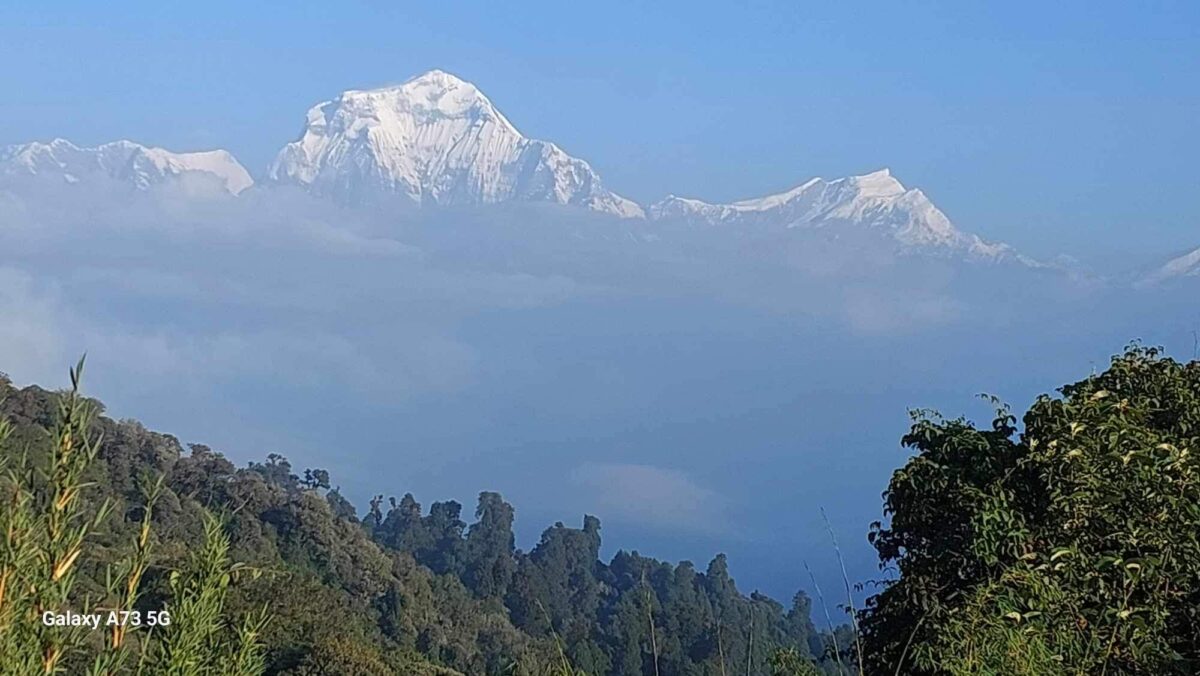
Daily Distances
Arrive at Kathmandu International Airport, some people may choose to fly in a day early to have an extra day in Kathmandu enjoying this fast-paced city and help after the earthquake. You should aim to arrive in the morning. There are plenty of sights to visit and explore and you can pick up any last-minute items on the streets of the Thamel district. Two nights’ accommodation in Kathmandu is included in the cost of the trip. One night before and one night after the trek
Today we fly to Pokhara. After having breakfast in the morning today, we will head back to the airport and take the short 25-minute flight to Pokhara. On arrival in Pokhara, you can enjoy the quiet and slower paced city and lakeside area. Pokhara sits at 850m/2,788ft above sea level and we will stay the night in a hotel in the city.
Today the actual trekking begins! We will wake early for breakfast and then drive from Pokhara to Tikhe Dhunga (1,577m/ 5,173ft), which takes approximately 3 hours. Once we arrive in Tikhe Dhunga, we will start hiking to the large Magar Village of Ulleri (2,070m/6,791ft). This will be approximately a 2 hour hike which is steep uphill on steps and stairs. It can be quite warm on this hike.
Trek from Ulleri to Ghorepani 2,869m/ 9,412 feet – 5 Hours. Today we will trek from Ulleri to Ghorepani, which will be approximately a five-hour trek. Our trail ascends more gently from this point through fine forests of oak and rhododendrons towards Banthanti 2,250m/ 7,381feet After walking for a couple of hours, we arrive in Ghorepani at 2,869m/ 9,412 feet, where we stay overnight.
Hike up to Poon Hill 3,210m/ 10,531 feet and trek to Tadapani 2,610m/ 8,562 feet – 4 Hours. Today, we will be up early in the morning and start an hour’s hike to Poon Hill (3,210m/ 10,531 feet), which is one of the best viewpoints in the Annapurna Region. Poon Hill offers the best opportunity to witness the stunning panorama of the beautiful peaks including Annapurna and Dhaulagiri. You can enjoy amazing views of sunrise over the stunning snow-capped mountains. After spending about an hour at Poon Hill, we return back to Ghorepani to have breakfast. After breakfast, we continue climbing along the ridges through the forest of pines and rhododendron. The climb brings us to Deurali at 2,960m/ 9,711ft, and we then descend to Tadapani 2,610m/ 8,562 feet to sleep for the night.
Trek from Tadapani to Chhomrung 2,140m/ 7,020 feet – 5 Hours. We start our steep downhill walk today through the forests of rhododendrons. Leaving Tadapani and descending through the forests, we will reach the Gurung village of Gurjung as the trail eases. After Gurjung, we eventually walk to Chhomrung which is at the elevation of 2,140m/ 7,020 feet where we stay overnight at a lodge. The hike today is approximately 5 hours.
After breakfast, we will continue towards Jhinu for our final night’s stay in the mountains! It is a steep downhill trek with uneven stairs and steps all the way to Jhinu. The lodge sits in a beautiful Valley with the option of visiting the local Hot Springs that afternoon. The hike is approximately 3 hours.
Today we make our way back to Pokhara. From Jhinu, we will begin our final hike of the trip before returning to Pokhara. Depending on the road conditions the hike today will either be a one hour hike or a three hour hike to the vehicle pick-up point. You will be brought back to the White Pearl hotel in Pokhara to enjoy your success!
After another night in Pokhara we will return to the airport for the 25 minute flight back to Kathmandu and we will transfer you to our hotel in Thamel. We include an evening dinner.
Final Departure. We will transfer you to the airport for your return flight home or onward journey.
Award Winning Team
In 2019 we won the International Tourism Award in Nepal. We won this award because we have invested in our team, having full time staff on the ground in Nepal, running better itineraries, with better service and acclimatization. We have also built 4 schools and added over 200 stoves to homes in the remote village of Goli, Nepal. Our Poon Hill trek is designed for people looking to sample trekking in Nepal and people who are limited on time. With our expertise and experience and unique itinerary, we will provide you with all the necessary information you need to make your trip a success. You need to be training hard and getting prepared to make it a successful and enjoyable adventure. We are available to help you get prepared both physically and mentally, helping you receive the best training advice. Our team will provide you with a detailed gear and equipment list for your Poon Hill trek and we are available 5 days a week in support of your trip.
When you are picking your trekking boot, you want to make sure they fit some important criteria. Firstly, they should be comfortable and waterproof. Next, they need to have good ankle support as well as a more rigid sole.
1). La Sportiva TXS GTX
This is a new boot from La Sportiva, that has replaced our beloved Trango Trek GTX. We prefer a more rigid sole under foot and these boots do a great job. They breathe well, are lightweight and waterproof. Some of our Sherpa and Kilimanjaro guides wear these boots as well. This boot would be a great option for your trek to Annapurna Base Camp or Machu Picchu !
2). Scarpa Zodiac Plus GTX
Scarpa has come out with a new lighter weight option in the Zodiac. These boots are Gore-Tex, so a waterproof boot to keep you dry if you experience moisture on the trail. They also have good ankle support and lacing system. These boots, similar to the La Sportiva TXS, have a more rigid sole. This is ideal for the stairs you will encounter on the trek to Annapurna Base Camp. Scarpa are always re-inventing trekking boots and if they fit your foot correctly, then they may be the right boot for you. They work great and last a long time. Also, if you decide on another adventure after the Annapurna Base Camp trip, we would also recommend these boots for an Inca Trail trek or the Everest Base Camp trek.
3). Lowa Renegade GTX Mid
The Lowa Renegade GTX Mid boot has been around for a long time and worn by many trekkers around the world! These are a perfect boot for the Annapurna Base Camp Trek. They are waterproof, have good ankle support, and also have a semi-rigid sole. The grip of these boots and the more rigid sole is ideal for the many stairs you will encounter. The negative of these boots is that they do have a lot of stitching on them, making them more susceptible to wearing out faster than other options. However, if you treat this boot well, you can enjoy them for many trips to come!
4). Merrell Moab Mid 2 Waterproof
The Merrell Moab Mid 2 Waterproof Trekking Boot has been around for years and there is a good reason for that, they are a great boot! These boots boast a waterproof membrane, good ankle support, comfortable and sturdy fit. The Merrell boot may be the option for you if you have a slightly wider foot or need more room in your toe box. This boot is a reliable and durable option that will be ideal for your Annapurna trek! We would also recommend this boot for Kilimanjaro, the Inca Trail, or Everest Base Camp.
5). Salewa Mountain Trainer Mid GTX
Salewa has been coming out with a lot of new and very high quality boots over the past few years. While we have not personally worn this boot yet, however, we do have a lot of clients wearing these boots to Annapurna Base Camp. We have had very good feedback on this option! They have Gore-Tex in the boot, so they are waterproof and also have a good amount of ankle support. This lightweight, but durable boot would be a great option for your trek to Machu Picchu as well.
If you have signed up to an Ian Taylor Trekking, Poon Hill trek, we send you a comprehensive Dossier on the trip. The dossier will give you a complete kit list and all relevant information on your journey to Nepal.
What Ian will Pack
We understand the clothing that will work best for all conditions you may encounter on your trek to Poon Hill. Ian has made the journey to Poon Hill and Annapurna Base Camp over 10 times, stood on the top of Everest and led hundreds of treks in different conditions. This is the gear and clothing will vary depending on the month you are trekking.
No One Size Fits All
Packing for the Poon Hill trek is very personal. Some people feel the cold in different places than others and others don’t feel the cold at all! Likewise, some trekkers may have specific pieces of gear that they like to hike in. You may need warmer layers, different hiking boots, thicker or thinner socks, layers, or gloves. We are here to help you make the right decisions on what gear you will bring on your trek. So, feel free to GET IN TOUCH today, and we can help you get the right gear for your Poon Hill trek.
Q). Is the Poon Hill trek easier than Everest Base Camp Trek?
A). The Poon Hill trek is more manicured with more stairs. The trails are better maintained. There are less people on the Poon Hill Trek and Pokhara is much nicer than the dusty streets of Kathmandu. Our Poon Hill trek is at much lower elevation which makes it much easier to manage. The Annapurna region is much easier to access and sees far fewer people than the Everest Base Camp. The journey offers incredible views of Machhapuchhre mountain and across the Annapurna range. The trek also encounters considerably less problems with AMS and altitude sickness, in comparison to the Everest trek. We consider it easier than the Everest Base Camp Trek.
Q). What is the best approach?
A). After years of running a range of itineraries. We have settled with our itinerary that drives higher and offers better access to the region. This gives the best views, acclimatization and overall experience. This is one of our favorite trekking itineraries.
Q). How much does a visa cost to enter Nepal?
A). Visa entry for Nepal costs USD $50 for a 30 day visa and USD $100 for 90 day visa.
Q). How much is a meal in Kathmandu?
A). An average meal in Kathmandu is approximately USD $10 – $15 per meal.
Q). How much should you tip your guides after a trek?
A). The tip given at the end of a trek should be roughly USD $150 – $200.
Q). Can I leave spare luggage in the Kathmandu hotel while I am on the trek?
A). Yes, the hotel we use in Kathmandu and Pokhara both have a luggage storage room for any travel clothes or spare items you want to bring with you to Nepal, but not on trek.
Q). Where do I get water from on a trek ?
A). You should use water purification tablets in the 4/5 liters of water you will be drinking each day. Avoiding water borne illness on the trek is imperative! You can buy these in Kathmandu. Bottled water (plastic) has been outlawed since 2019. Therefore, you will not be able to purchase bottled water anywhere along the trail any longer. You will want to make sure that you have adequate amounts of water purification tablets with you for the entire trek. 30 minute treatment is ideal. We will have access to water all the way along the trail.
Q). When is the best time to trek to Poon Hill?
A). Some of our favorite times to be in the region are February, March and April. You can also trek in May but it gets much warmer. We also highly recommend trekking in October, November and December.
Q). When is the Poon Hill trek quiet?
A). The quietest time to visit Annapurna region is January, February March, November and December.
Q). When is the warmest time to trek to Poon Hill?
A). May and September are usually the warmest time to visit However, while we normally see warmer temperatures in May, we have also seen years where it has snowed in Annapurna Base Camp in May. You never know what the weather will be like in the region, but generally May is a warm time to be there.
Q). Can we trek in the monsoon season?
A). Yes, however trails, rocks and stairs can be wet and slippery. It can be warm and muggy along with poor mountain viewing.
Q). How should I be training?
A). Always a hard question. This will depend on a wide range of factors. We can help you develop a training plan. Learn more .
What people said about our Annapurna Base Camp Trek
Joan lindsey.
Annapurna Base Camp and Tent Peak 2014
I trekked to Everest Base Camp with Ian Taylor in 2012, I met some amazing people and just had to return to Nepal. The scenery was outstanding. I just loved Pokhara and will return here again. The experience was once again a great one, the lodges, food, hotel, staff were all amazing and really can not recommend Ian and team enough.
Lauren Ciarallo
Annapurna Base Camp Trek 2019
My husband and I participated in a trek to the Annapurna Base Camp with Ian Taylor Trekking and had one of the best experiences of our lives. Ian and Laura are the best in the business. The pre-planning details and recommendations that they provided are thorough, incredibly relevant and set us up to have the perfect trekking adventure. The travel logistics in Nepal were flawless and Dawa and Kay made us feel right at home in Kathmandu. Our guides and porter on the trek were friendly, knowledgeable, professional and supportive. We are already exploring options for our next trek with Ian Taylor Trekking.
Ready to go?
We pride ourselves on making sure that our clients have every opportunity to succeed in the mountains, including professional training advice, gear lists and video links on how to pack your bag, and much more. Get in touch today and let Ian Taylor Trekking help you make the next step at reaching your goal of trekking to Poon Hill!
We are always available to answer any questions you may have by email, phone or Whatsapp, so contact us today!

Ace the Himalaya
Trekking in Nepal, Peak Climbing, Mt Biking and Tours in Nepal, Bhutan and Tibet
- Everest Base Camp Trek - 14 Days
- EBC Trek with Helicopter Return - 12 Days
- Everest Base Camp Luxury Trek - 14 Days
- Everest Base Camp with Island Peak - 19 Days
- Everest Three Passes Trek - 20 Days
- Annapurna Base Camp Trek - 13 Days
- Annapurna Circuit Trek - 19 Days
Ghorepani Poon Hill Trek - 9 Days
- Manaslu Circuit Trek - 15 Days
- Gokyo to Everest Base Camp Trek - 17 Days

Ghorepani Poonhill Trek is the most popular short trek in Nepal for its magnificent Annapurna Panorama and sunrise view from Poonhill.
Highlights of the Poon Hill Trek
- Picturesque drive on the way to Pokhara.
- Enthralling sunrise views over the Himalayas from Poon Hill.
- Discover Gurung culture in Ghandruk village.
- Walk through colorful rhododendron forests.
- Magnificent views of the mighty Annapurna.
Ghorepani Poon Hill Trek Overview
The Ghorepani Poon Hill Trek , starting and ending in Pokhara, transforms into a vibrant tapestry of color during spring and a snowy wonderland during winter.
This unforgettable adventure delves into the heart of the Annapurna region, offering a delightful contrast between peaceful valleys and challenging climbs.
Imagine traversing picturesque valleys adorned with terraced fields and dense mossy forests. But the true spring spectacle unfolds as you enter the vibrant rhododendron forests.
Blooming in a kaleidoscope of colors, these beautiful flowers create a breathtaking natural archway above your path.
Every turn on the trail offers a tantalizing glimpse of the high mountains, their snow-capped peaks teasing you with their grandeur. Poon Hill, the crown jewel of this trek, rewards you with unobstructed panoramic views of the majestic Annapurna and Dhaulagiri range.
Witness the sunrise paint the mountains in a mesmerizing display of golden hues, leaving you speechless with its raw magnificence.
The Ghorepani Poon Hill trek is an ideal option for those seeking a short yet rewarding Himalayan experience.
Completed within a week, this trek offers a diverse landscape – from charming villages inhabited by Gurungs and Magars to refreshing river crossings and tranquil valleys.
The trails, though including uphill and downhill sections, are generally considered easy, making this trek accessible to a wider range of adventurers like you.
Poon Hill Trek Itinerary
Arrive at Tribhuvan International Airport in Kathmandu (1,400 m) and transfer to hotel. Overnight at hotel.
Drive to Pokhara (900 m) in a Tourist Bus – 7 to 9 hours. Overnight at a hotel in lakeside.
Drive to Birethanti (1,039 m) – 2 to 4 hours and Trek to Ulleri (2,020 m) – 4 to 5 hours. Overnight at a guesthouse.
Trek to Ghorepani (2,810 m) from Ulleri – 5 to 6 hours. Overnight at a guesthouse.
Early morning hike up to Poon Hill (3,210 m) & back, and then Trek to Tadapani (2,610 m) – 6 to 7 hours. Overnight at a guesthouse.
Trek to Ghandruk (1,940 m) from Tadapani – 4 to 5 hours. Overnight at a guesthouse.
Trek to Syauli Bazaar (1,170 m) from Ghandruk – 3 to 4 hours, Drive back to Pokhara – 2 to 4 hrs. Overnight at the hotel in lakeside.
Drive Back to Kathmandu (1,400 m) – 7 to 9 hours. Overnight at a hotel.
Transfer to the International Airport for Your Final Departure.
Please be advised that extensive road construction along the Prithvi Highway from Kathmandu to Pokhara has resulted in increased traffic congestion and air pollution. As a result, the journey, typically taking around 6-7 hours, may now require approximately 8-9 hours. We appreciate your patience and understanding during this time.
Our standard itinerary might differ slightly due to unpredictable happenings and events out of our control. Factors such as flight cancellation/delay, unfavorable weather, natural calamities, newly implemented government rules, political affairs, trekkers’ health conditions, etc., are possible. Evaluating the situation’s possible solutions allow the trekking to resume as much as possible based on the best alternatives. In these times, we look for your cooperation and flexibility.
It is advised you arrive a day before the trip starts date so you can rest and it also gives you time to buy clothing equipment and gear required for the trek. Also, it is best if you book your international flights with spare days in Nepal before and after your trek in case of any flight delays or cancellations due to technical reasons. Moreover, you have options to customize this trip where you can add on a sightseeing tour in Kathmandu, Pokhara, other adventure sports or day trips around the country before or after the trek.
Departures & Availability
Our groups are small with maximum 14 people. We create groups of independent travelers, friends and families which maintains close interpersonal connection, engage more and get into depth of the journey. Choose a date from the calendar to reserve your spot.
Looking for personalized experience? We organize privately guided journey which is mainly designed to fit your taste and interest. Please fill out the form below to get started.
Departure Date
- Lead Traveler's Full Name *
- No. of Travellers * No. of Travellers 1 2 3 4 5 6 7 8 9 10 11 12 13 14 15 16 17 18 19 20 20+
- Country Country Afghanistan Albania Algeria American Samoa Andorra Angola Antigua and Barbuda Argentina Armenia Australia Austria Azerbaijan Bahamas Bahrain Bangladesh Barbados Belarus Belgium Belize Benin Bermuda Bhutan Bolivia Bosnia and Herzegovina Botswana Brazil Brunei Bulgaria Burkina Faso Burundi Cambodia Cameroon Canada Cape Verde Cayman Islands Central African Republic Chad Chile China Colombia Comoros Congo, Democratic Republic of the Congo, Republic of the Costa Rica Côte d'Ivoire Croatia Cuba Cyprus Czech Republic Denmark Djibouti Dominica Dominican Republic East Timor Ecuador Egypt El Salvador Equatorial Guinea Eritrea Estonia Ethiopia Faroe Islands Fiji Finland France French Polynesia Gabon Gambia Georgia Germany Ghana Greece Greenland Grenada Guam Guatemala Guinea Guinea-Bissau Guyana Haiti Honduras Hong Kong Hungary Iceland India Indonesia Iran Iraq Ireland Israel Italy Jamaica Japan Jordan Kazakhstan Kenya Kiribati North Korea South Korea Kosovo Kuwait Kyrgyzstan Laos Latvia Lebanon Lesotho Liberia Libya Liechtenstein Lithuania Luxembourg Macedonia Madagascar Malawi Malaysia Maldives Mali Malta Marshall Islands Mauritania Mauritius Mexico Micronesia Moldova Monaco Mongolia Montenegro Morocco Mozambique Myanmar Namibia Nauru Nepal Netherlands New Zealand Nicaragua Niger Nigeria Northern Mariana Islands Norway Oman Pakistan Palau Palestine, State of Panama Papua New Guinea Paraguay Peru Philippines Poland Portugal Puerto Rico Qatar Romania Russia Rwanda Saint Kitts and Nevis Saint Lucia Saint Vincent and the Grenadines Samoa San Marino Sao Tome and Principe Saudi Arabia Senegal Serbia Seychelles Sierra Leone Singapore Sint Maarten Slovakia Slovenia Solomon Islands Somalia South Africa Spain Sri Lanka Sudan Sudan, South Suriname Swaziland Sweden Switzerland Syria Taiwan Tajikistan Tanzania Thailand Togo Tonga Trinidad and Tobago Tunisia Turkey Turkmenistan Tuvalu Uganda Ukraine United Arab Emirates United Kingdom United States Uruguay Uzbekistan Vanuatu Vatican City Venezuela Vietnam Virgin Islands, British Virgin Islands, U.S. Yemen Zambia Zimbabwe
- How did you find Ace the Himalaya? * How did you find Ace the Himalaya? Google Search Yahoo Other Search Engine Facebook Twitter Newsletter Ace Blog I m a Previous Client Friend Recommendation Lonely planet Trip Advisor Magazine Advertisement Brochures/flyers I met you in Trade shows I am your Trade partners From North American Representative From European Representative From Australian Representative The Clymb Groupon Travel Zoo Scoupon From Other Deal Sites Others
- I agree to Ace the Himalaya Terms and Conditions
- Prove your humanity : eleven plus 5 =
- Comments This field is for validation purposes and should be left unchanged.
Price Includes
- All (international and domestic) airport transfers on a tourist vehicle
Twin-sharing/double accommodation in a 3-star hotel in Kathmandu (2 nights) and Pokhara (2 nights) including breakfast
Twin-sharing or dormitory guesthouse accommodation during the trek in the Annapurna region for 4 nights
- All your standard meals during the trek (Breakfast, Lunch, and Dinner) including one hot drink and seasonal fruits
- Experienced, first-aid trained, government licensed, English-speaking Ace the Himalaya's trekking guide
- Permits for Annapurna Conservation Area and TIMS (Trekkers' Information Management System)
- Porters during the trek for carrying luggage (1 porter for every 2 clients)
- Wages, accommodation, meals, gear, insurance, and medications for all staff
- Filtered water in the trails using Water Filter or using water purification tablets
Tourist bus between Kathmandu and Pokhara and private tourist vehicle from Pokhara to Birethanti and from Syauli Bazaar to Pokhara
- 1 Ace the Himalaya’s duffel/kit bag, trekking map, sun hat, Buff (Neck Gaiter) and trip completion certificate
- A farewell dinner on the last night in Nepal
- All administrative expenses and government taxes
Price Excludes
- Meals (lunch and dinner) in Kathmandu and Pokhara
- International flight fare and airport departure tax
- Any beverages including bottled and boiled water
- Travel insurance along with high-altitude emergency evacuation coverage
- Tips to trekking staff and driver
- Nepal Entry Visa (Visa can be acquired easily after your arrival at Tribhuvan International Airport in Kathmandu with a fee of USD 50 for 30 days visa and USD 125 for 90 days visa)
- Personal Trekking gear and equipment
- Any expenses other than the Price Include section
Ghorepani Poon Hill Trek Itinerary
Day 01: arrival at tribhuvan international airport in kathmandu and transfer to hotel.
One of our officials will greet you at the Tribhuvan International Airport, Kathmandu, upon your arrival. We will take you to the hotel in our private tourist vehicle. Pre-trip meeting will be done and you will meet with your trip guide. Make sure to confirm your queries about trekking in the mountains.
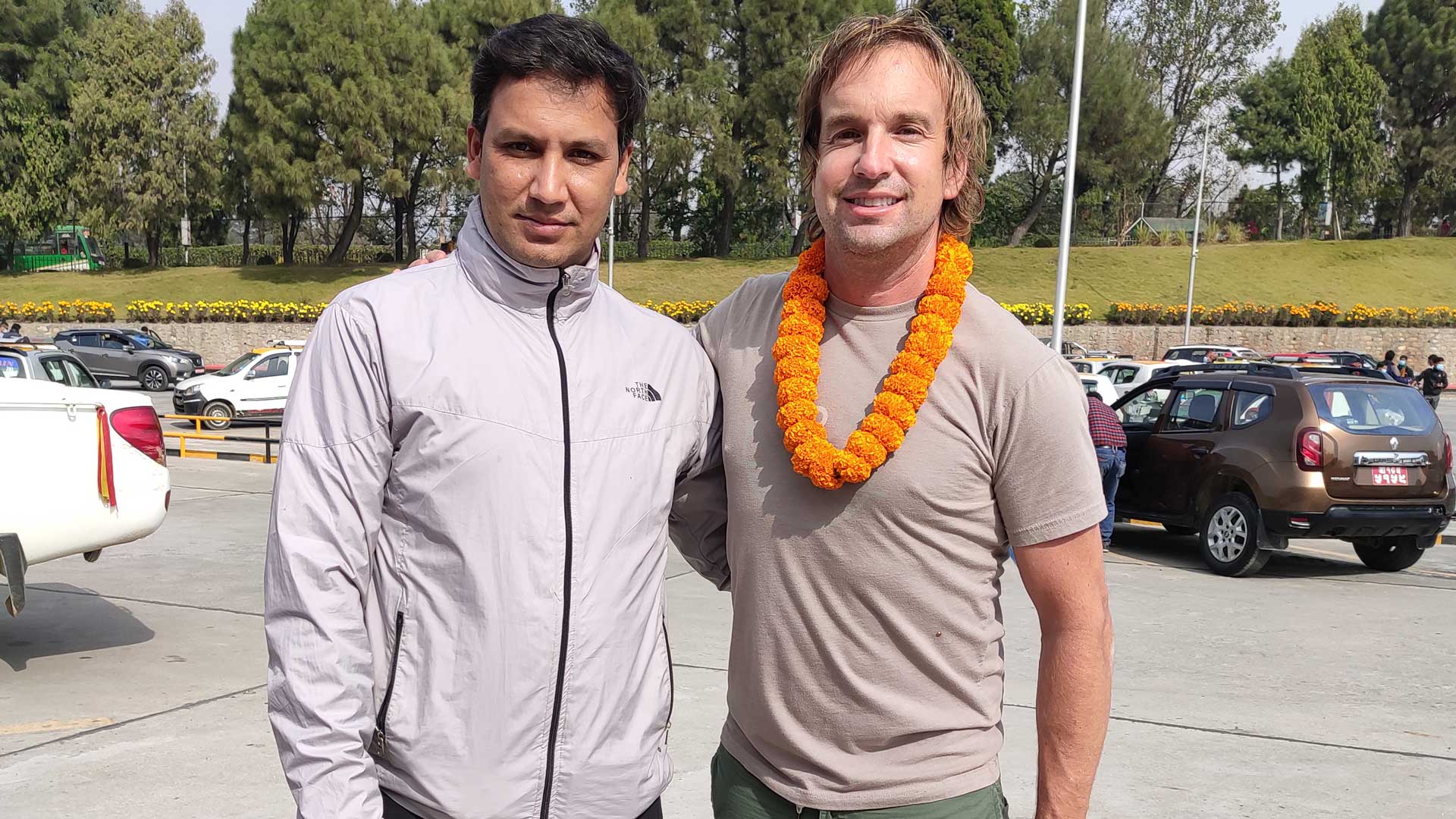
Note : Pre-trip meeting will be done at the office if you arrive before 4 pm and in your hotel itself if you arrive later in the evening. Be sure to bring two copies of passport-sized photos and a readable copy of your travel insurance policy to the meeting. These documents help to acquire trekking permits and related documentation during the trek. Pay the remaining balance of your invoice and sign in the legally binding trip form and non-liability disclaimer.
Day 02: Drive to Pokhara in a Tourist Bus
Our trekking staff will pick you up from the hotel at 6:30 am and escort you to the tourist bus station. The bus to Pokhara leaves at around 7:30 am. Pokhara is a beautiful valley set on the banks of the Phewa Lake.
Pokhara Road Update
Please be advised that extensive road construction between Kathmandu and Pokhara has resulted in increased traffic congestion and air pollution. As a result, the journey, typically taking around 6-7 hours, may now require approximately 8-9 hours. We appreciate your patience and understanding during this time. Alternatively, there is the option to take a 30 min flight from Kathmandu to Pokhara and vice versa. The cost for a one-way flight is USD 130 per person.
The city is also known for its panoramic views of Annapurna and Machapuchare (shape of fish tail) in the north, Dhaulagiri in the west, and Lamjung Himal and Manaslu in the east. It is smaller and much less hectic than Kathmandu, hence providing the perfect starting point for our Ghorepani Poon Hill trek.
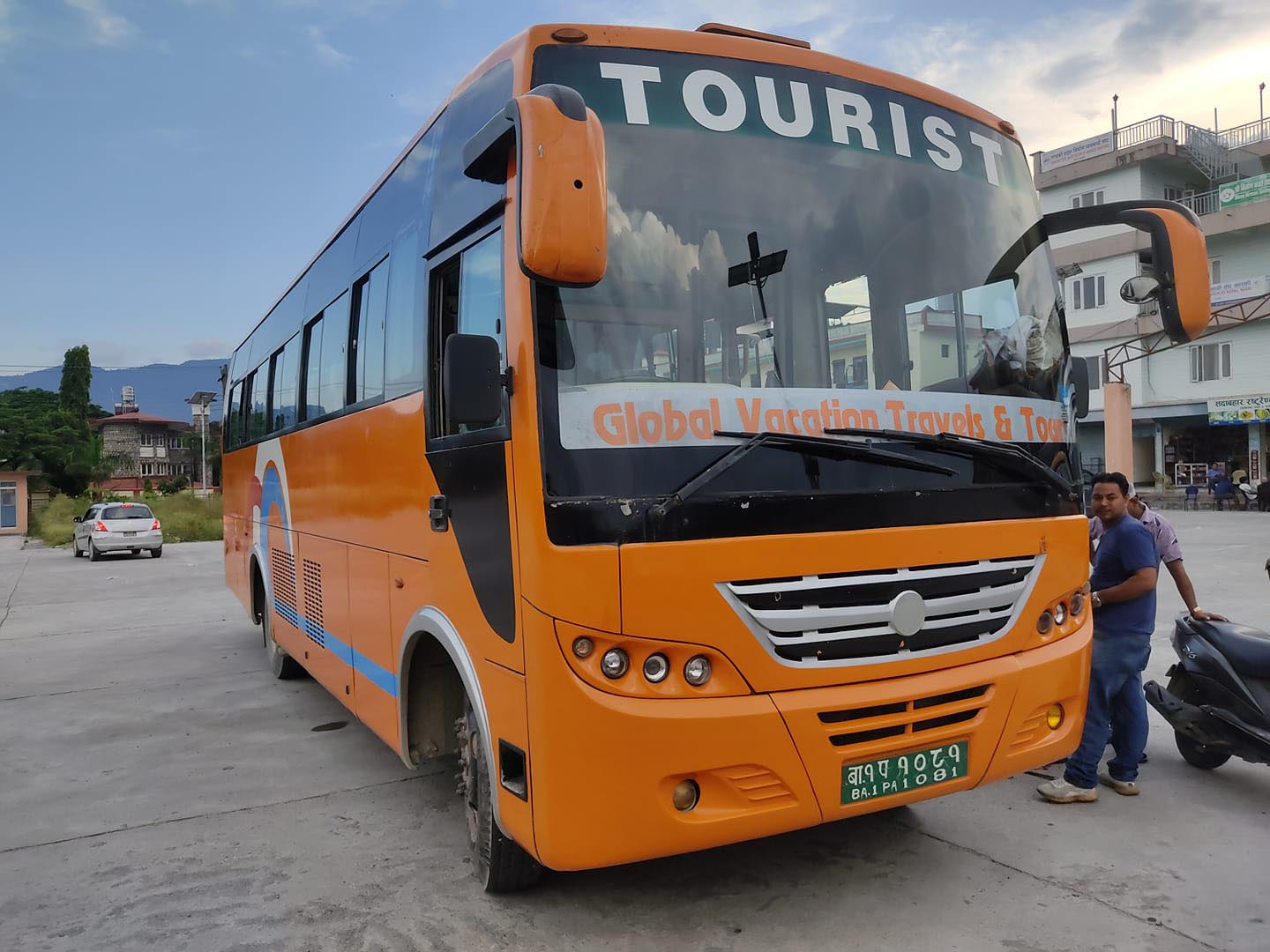
Day 03: Drive to Birethanti and Trek to Ulleri
On this day, we head out of Pokhara in a private vehicle. After two hours drive, we reach Birethanti (1,039 m/3,409 ft). After a couple of hours’ hike, we reach Hile (1,495 m/4,905 ft), a large village with many shops and teahouses.
From there, the trail continues through the village and follows the north bank of the Bhurungdi Khola. The route declines somewhat at first as you continue your journey from Hile. But soon after, you must trek a long, arduous ascent uphill before reaching Ulleri.
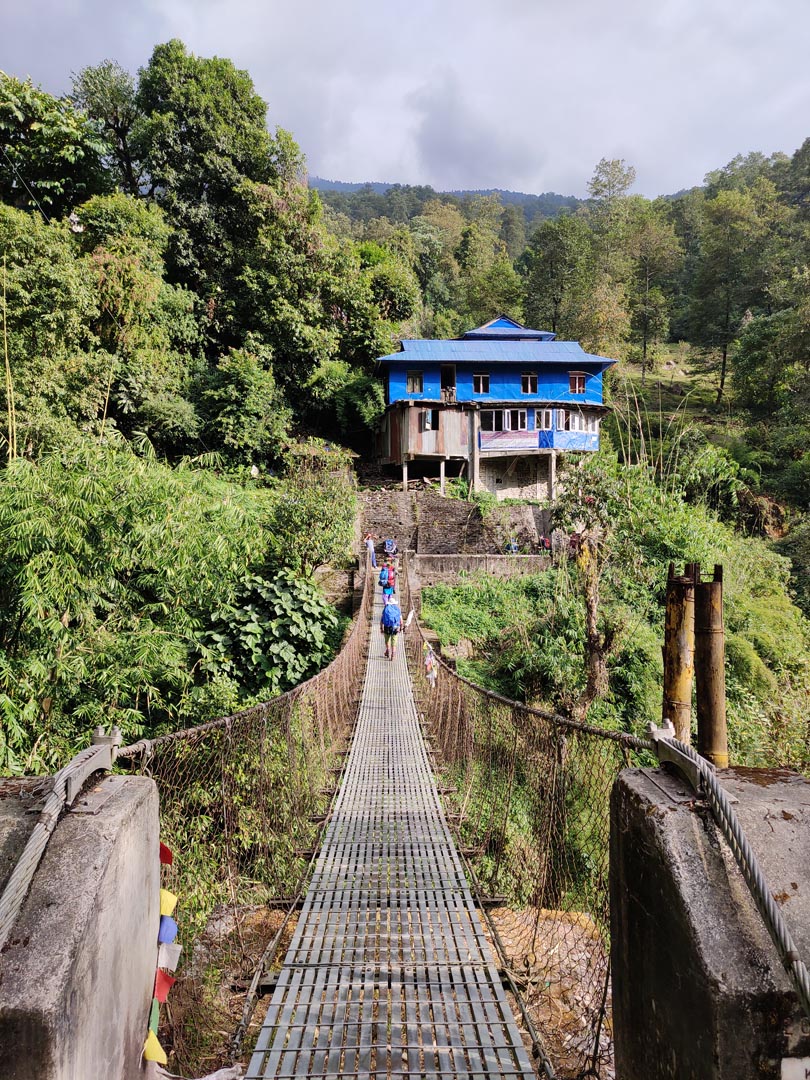
Day 04: Trek to Ghorepani from Ulleri
We move on towards the steep climb to Ulleri, a large Magar village at an altitude of 2,070 m/6,791 ft. The trail ascends more gently from this point, through fine forests of oak and rhododendrons, towards Banthanti at 2,250 m/7,382 ft. Then we trek towards Nangethanti at 2,460 m/8,071 ft. After an hour’s walk, we arrive at Ghorepani (2,810 m/9,219 ft).
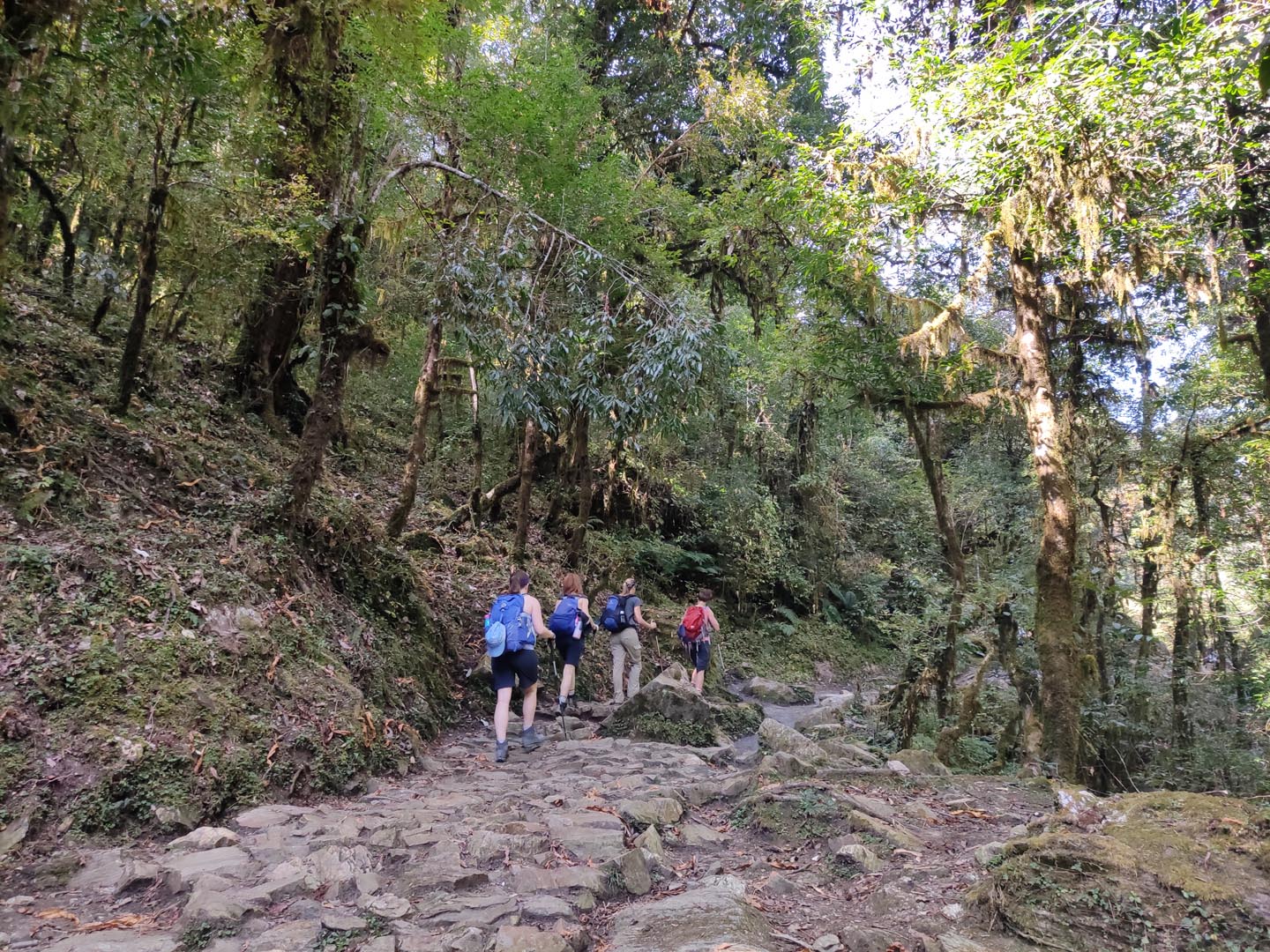
Day 05: Early morning hike up to Poon Hill & back, and then Trek to Tadapani
Today, very early in the morning, we start an hour hiking to Poon Hill at an elevation of 3,210 m/10,531 ft, a brilliant mountain range spectacle; this vantage point provides an unobstructed view of the sunrise over the high Himalayas.
We spend about 1 hour there and return to Ghorepani for a hot breakfast. Then we climb along ridges, and through pine and rhododendron forests, towards Deurali (2,960 m/9,711 ft). After that, we descend to the Banthanti and then turn off to Tadapani.

Day 06: Trek to Ghandruk from Tadapani
From Tadapani, the trail descends through forests to Ghandruk, a village of Gurung people, one of the ethnic groups of Nepal. They have their own dialect, culture, costume, and lifestyle.
Ghandruk is also home to many Gurkha soldiers. It is a famous destination for trekkers because of its beautiful mountain views. In addition, it is within easy reach of Pokhara and Kathmandu. We have the afternoon to visit Annapurna Conservation Office and museums and explore the village.
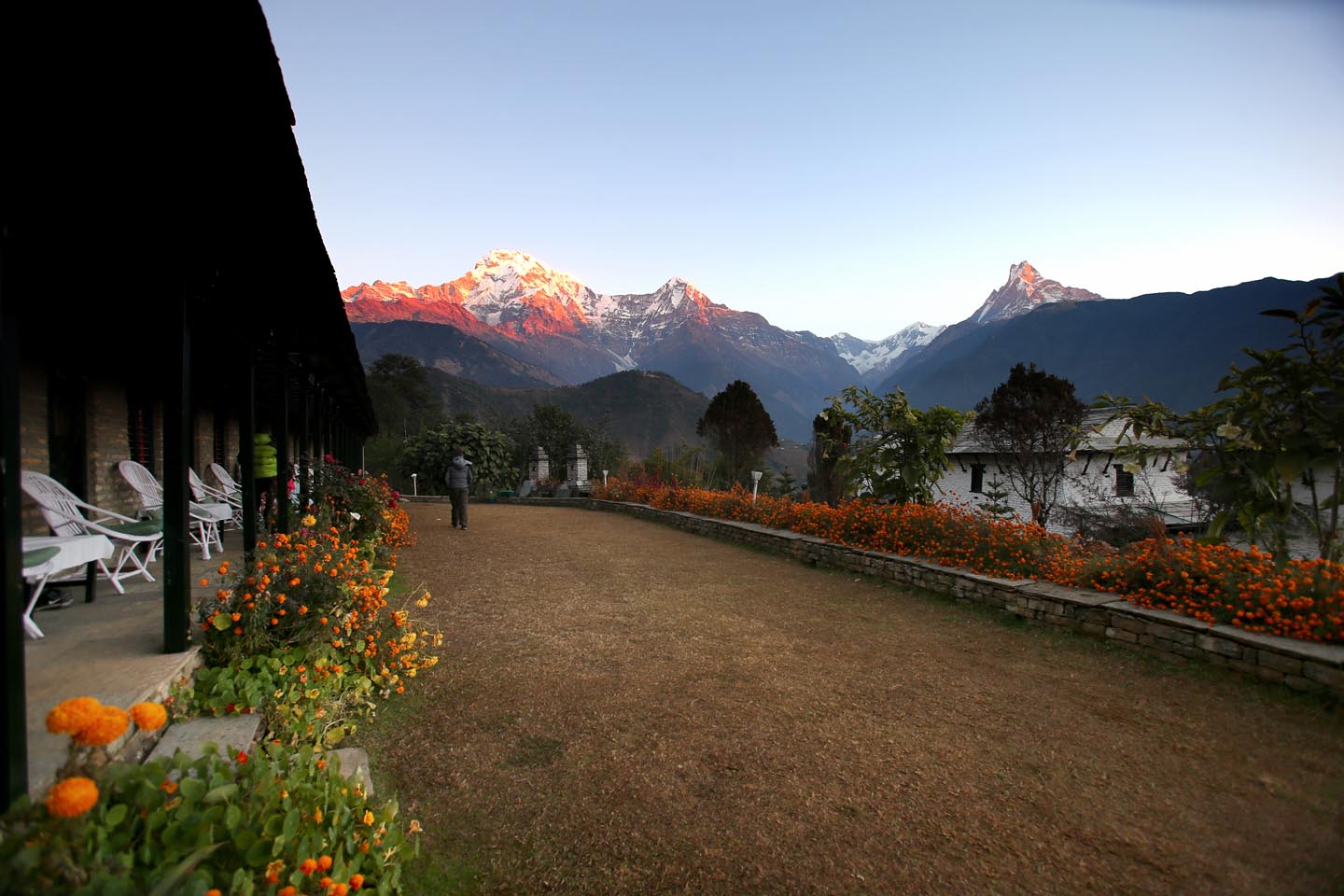
Day 07: Trek to Syauli Bazaar from Ghandruk and Drive back to Pokhara
Today, the trek begins along the agricultural terrace farms and stone-paved pathways. Reaching Syauli Bazaar marks the end of our trek, followed by a short drive back to Pokhara. After reaching Pokhara, you can have a relaxing afternoon and stroll around the lakeside.
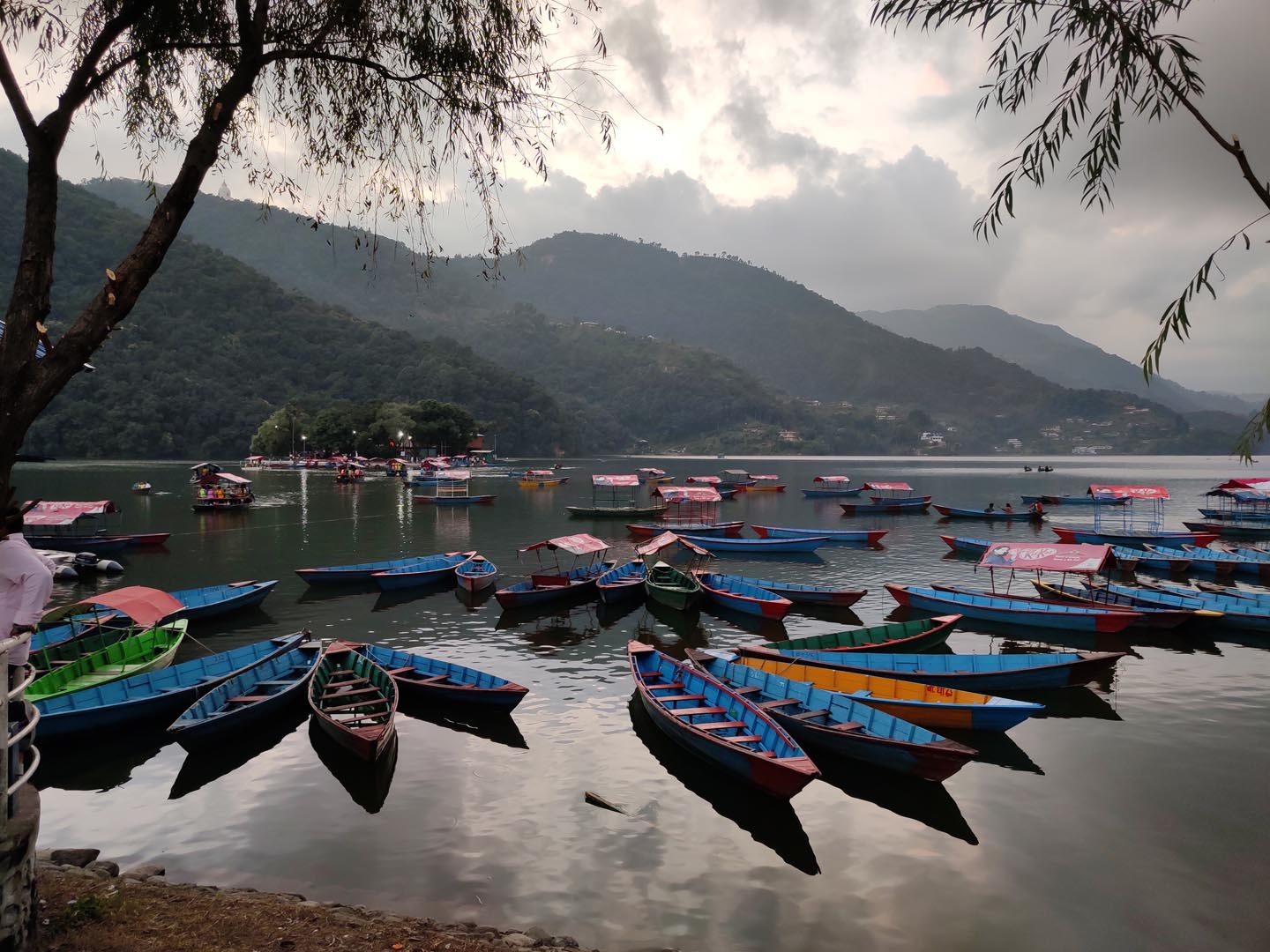
Day 08: Drive Back to Kathmandu in a Tourist Bus
We will be driving back to Kathmandu in the morning. In the evening, we host a farewell dinner in a fine restaurant. (Your guide(s) and an office staff will accompany you).
Day 09: Transfer to the International Airport for Your Final Departure
Our Ghorepani Poonhill trek concludes today. Our airport representative will drop you at the international airport in Kathmandu for your flight departure from Nepal.
Packing list for Ghorepani Poon Hill trek
Here is a list of what you might want to pack for the hike. Please take this as a starting point. You’ll need layers of warmer clothing during the winter. We provide a 75 liter duffel bag for you to use for the trek. It will be given to you during your pre-trip meeting in Kathmandu. The duffle bag is yours to keep. Also, you can rent sleeping bag and down jacket with us at the additional fee of USD 25 for each once you are in Kathmandu.
- Puffy down jacket ( We have rental jackets available for an additional USD 25)
- Daypack (35-45 liters recommended) with rain cover
- Sun hat or cap (We'll provide you with a free Ace the Himalaya baseball cap.)
- Knitted hat/Beanie
- Scarf or neck gaiter
- Technical fabric base layer (light for warmer months, heavy for colder months)
- Technical fabric short (2) and long sleeve (2) shirts
- Waterproof, windproof shell
- Fleece jacket or pullover
- Hiking pants (2)
- Comfortable pants for inside the teahouses
- Waterproof/windproof outer shell pants
- Hiking shorts
- Wool or technical fabric liner gloves
- Hard-shell outer gloves (insulated for colder months)
- Wool or technical fabric warm socks
- Hiking socks
- Liner socks (optional such as silk)
- Trekking/hiking boots (waterproof recommended)
- Ice Cleats /Micro Spikes (For trekking from November to March, it's recommended to include Ice Cleats/ Micro Spikes to prevent slipping on icy or wet surfaces.)
- Casual shoes
Undergarments
Note: The quantity of each article of clothing can be adjusted to suit the preferences of each participant.
- Technical fabric/quick drying is best for underwear (opportunities to launder during the trip)
- Sports bras (women)
- Pajamas or sleeping clothes
First Aid Kits and Medications
- ( Note : Guides carry medications and first aid kits during the trip. However, personal kits and medications are highly recommended.)
Other Essentials
- Extra copies of passport-sized photos
- Reusable water bottle
- Toiletry kits
- Water purification tablets or UV water purifier (if you plan to treat water)
- Hydration bladder
- Toilet paper (2 rolls)
- High protein snacks (such as protein bars or nuts)
- Waterproof/dry bags for carrying important documents and money
- Airline tickets (Please leave a copy at our office in Kathmandu. This can be useful if there is a change in the date of the flight.)
Once in Nepal, if you have the time, you can purchase supplies and gear for hiking. Thamel, Kathmandu’s tourist hub, is home to many shops where you can get a variety of reasonably priced trekking equipment.
- Power bank or extra batteries
- Cameras and mobile phone
- Pee bottle/ pee funnel for women
- Trekking poles
- Thermos for hot water
Important Information
- We give you a free duffel bag and baseball cap during your pre-trip meeting in Kathmandu. The duffel bag will be used to pack your trekking supplies.
- For every two participants, we assign one porter. The duffel bag, which should weigh around 10 kg/22 lbs, will be carried by the porter throughout the walk.
- To carry your daily necessities like cash, crucial papers, a water bottle or bladder, a camera, toiletries, sunscreen, a notebook, clothing, etc., you must have your own daypack (with a waterproof cover).
- You can store your luggage (non- trekking items) at the hotel in Kathmandu.
- Down jacket with a hood is a must for altitudes above 4,000 m to keep warm. You can rent a down jacket for USD 25. Please note that in case of loss or damage, you need to reimburse the cost of USD 100 per item.
- You can rent a 4-season sleeping bag for USD 25. Please note that in case of loss or damage, you need to reimburse the cost of USD 100 per item.
Note: Some clothing, especially form-fitting, figure-hugging items made of elastic material (like yoga pants), may offend locals. Therefore, if you choose to wear these clothes for comfort, please make sure to wear something over them.
Ghorepani Poon Hill trek Map & Elevation
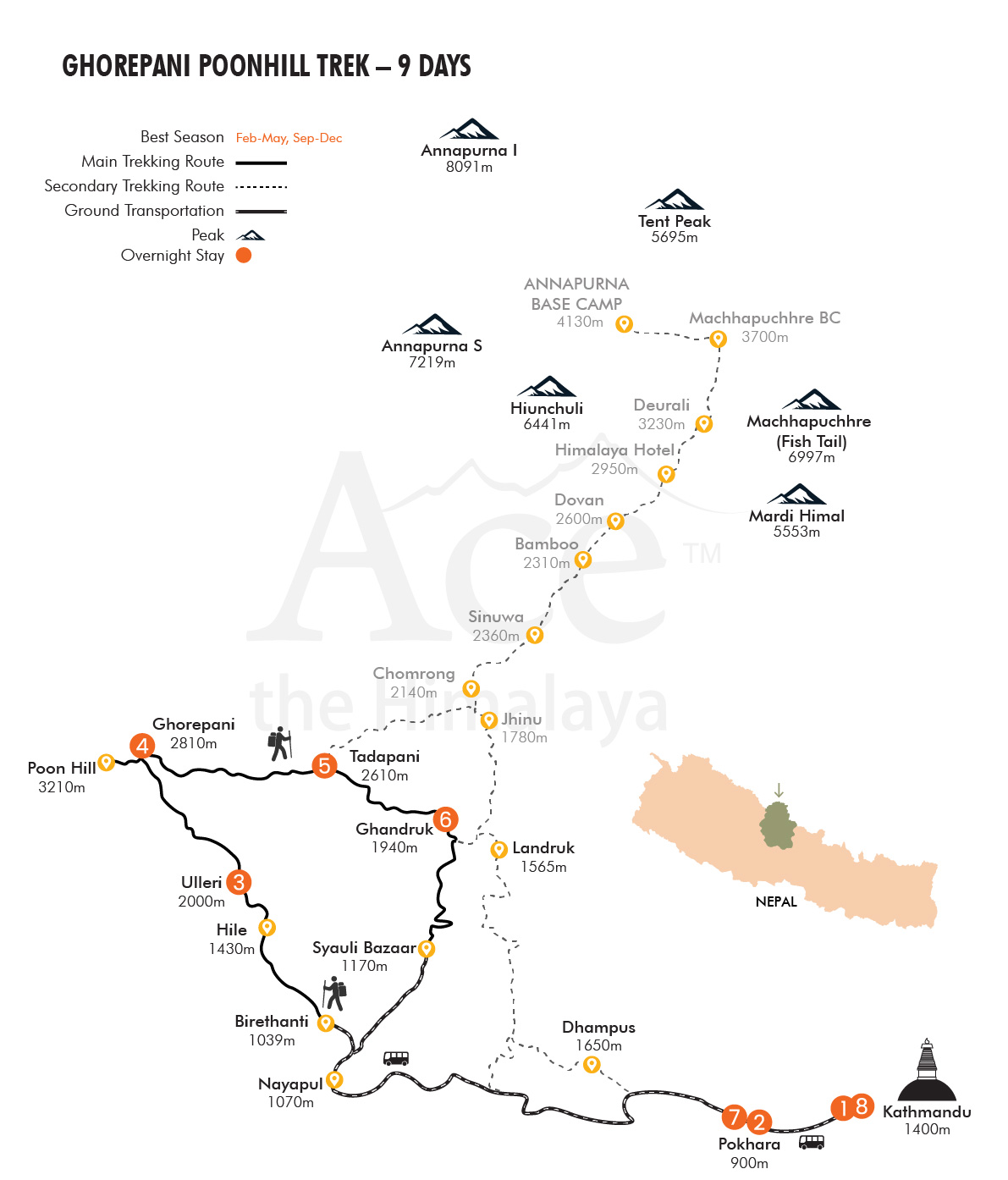
FAQs for Ghorepani Poon Hill Trek
Why trek with ace the himalaya.
Ace has a reputation for successfully leading treks with knowledgeable leaders and staff taking care of all your travel needs. We are a certified sustainable travel company that also endorses the idea of giving back to the community by participating in various philanthropic activities. Here are 17 reasons why you should choose Ace the Himalaya for your next adventure!
Is Nepal open to travelers following the Covid-19 pandemic?
Indeed, Nepal is entirely open. Travelers are welcome in Nepal without any restrictions. Arriving travelers can obtain a visa on arrival at the Kathmandu airport as well.
What are the conditions to travel to Nepal post Covid-19?
Traveling to Nepal is now hassle-free. You don’t need a vaccination certificate or negative PCR test, but check with your airlines and transit countries for any specific requirements.
We suggest you look at the Nepal immigration site https://www.immigration.gov.np for the most up-to-date information.
What additional documents do I need?
- Two passport-sized photos (2×2 inch) to give to our office staff
- A copy of your international flight ticket to give to our office staff
- A copy of travel insurance to give to our office staff
Do we book our own international flights to and from Nepal?
Yes, you need to book your own international flights. We are a local agent and it would cost you significantly higher to book through us. Please find more information in the International Flight page .
Is hiring a guide necessary even if I have trekking experience?
You can hike without a guide. A guide is there to assist you in going forward and making alternative plans and arrangements when unanticipated occurrences happen or when things get difficult. Our hiking leaders are qualified experts. When talking about their trip, our guests frequently remark on how much fun they had and how crucial their guide was to make it successful.
Can the guide speak English?
Our guides are fluent in English. All the guides that we assign speak and understand English. They’ll share with you the fascinating stories, traditions, and folklore of the mountains. The guides will also help you communicate with the locals since many shopkeepers and hosts of teahouses don’t speak English.
Weather and Temperature
What is the best season for this trek.
Our trekking season extends from mid-September to May. From early September, the monsoonal rains decrease. By end of September to December, the weather is usually stable with mild to warm days, cold nights. February, March, April, May, June, October, November, December is the best time to do this trek.
What kind of weather and temperature can I expect while trekking?
One of the most unpredictable elements of the mountain is the weather. If you’re not properly prepared for the twists, turns and volatility of the conditions that can occur in this breathtaking region, you might find yourself in an uncomfortable and unpleasant situation. Here are some weather basics to help ensure that you come to the Himalayas as well equipped and prepared to face anything.
Generally speaking, the nights are much cooler than the daytime hours in the Annapurna region. Many first-time trekkers are surprised to learn about the incredible range that may occur in a given day. During the day, the thermometer could reach temps as high as 25 degrees C (77 Degrees F), only to dip down as low as -5 degrees C (23 Degrees F) in less than 24 hours. While there’s no way to know exactly what each day in the mountains will bring, the weather and temperature ranges tend to be somewhat predictable based on the month and season.
Spring – March / April / May / June
Spring happens to be one of the best times of the year to visit the Annapurna region. That is why, it can become somewhat crowded. The beautiful clear blue sky can be seen and the many different species of flower are visible in the lower altitude.
During springtime, the average temperature is 20 degrees C (68 Degrees F), with a maximum of 25 degrees C (77 Degrees F), during sunny days and a minimum of 0 degrees C (32 Degrees F), in the morning and at night for areas above 2500 meters.
July / August Through Mid-September is Monsoon Season
This season is not really recommended to travel as it rains in the lower altitudes. However, there are positive sides of trekking during the monsoon months. The excess rainfall can provide ample chance to see spectacular views of the waterfall and it’s also the best season to avoid the crowds.
During this time, the average temperature is 25 degrees C (77 Degrees F), with a maximum of 30 degrees C (86 Degrees F), during sunny days and a minimum of 5 degrees C (41 Degrees F), in the morning and at night for areas above 2500 meters.
Autumn – End of September / October / November
Similar to springtime, autumn in this region is also a crowded season. But it’s one of the best times to trek. While it lacks the beauty of flowers, the clear blue sky can be seen, affording incredible views from just about every angle.
The average temperature during the fall is 20 degrees C (68 Degrees F), with a maximum temp of 25 degrees C (77 Degrees F), during sunny days and a minimum of -5 degrees C (23 Degrees F), in the morning and at night, for areas above 2500 meters altitude.
Winter- December/ January/ February
Winter start from mid-December till mid-February in this region. People still like to trek in this month due to fewer crowds.
The average temperature during the winter is 10 degrees C (50 Degrees F), with a maximum temp of 17 degrees C (62.6 Degrees F), during sunny days and a minimum of -10 degrees C (14 Degrees F), in the morning and at night, for areas above 2500 meters altitude.
The temperature mentioned above is based on the outdoor temperature of the guesthouse temperature. No need to worry about the cold temperature as we provide the sleeping bag plus an additional blanket to make sure our clients are warm enough during the time of need.
What is the temperature rating of the sleeping bag that you lend to trekkers?
The temperature rating of the sleeping bags that we rent to trekkers is about -10°C (14°F). Also, our guides can obtain extra blankets if needed at the teahouses.
Arrival and Visas
Is it possible to obtain a visa for nepal upon arrival at the airport.
Yes, you can obtain a Nepal visa upon your arrival at the airport. There are kiosks in the arrival hall that you use to complete the necessary forms. The cost is USD 30 for a 15-day tourist visa, including numerous entries, or USD 50 and USD 125 for a 30-day or 90-day tourist visa including numerous entries respectively. You should carry cash (USD) with you to pay your visa fees quickly and easily, as digital payments are frequently unavailable.
Who will come to pick me up at the airport upon my arrival?
Our staff will be waiting for you outside the airport terminal with our signboard (Ace the Himalaya). You will be accompanied to a hotel in a private tourist vehicle.
Payments and Extra Costs
How much additional money do i need per day.
Typically, USD 15 to 20 per person per day will be sufficient. This is to purchase water, tea/espresso, snacks, and hot showers in the mountains and for lunch or dinner in Kathmandu. Additionally, if you want to buy souvenirs or native Nepali goods, you can bring extra cash with you.
Is it possible to use credit cards in the places I visit during the trek?
In Kathmandu and Pokhara, yes – to some extent. Once you are out of the cities, all you need is cash. Please change the currency in local Nepali Rupees before you go to the mountains.
Is it possible to reserve a trip now and pay a deposit later, or do I have to pay a deposit at booking/reservation?
When you book, you must pay a 30% deposit to secure your itinerary. The remaining balance can be paid upon your arrival at Kathmandu or before arrival. US Dollars cash and credit cards (Visa, Master, and American Express) are accepted once in Nepal. Please note a 4% transaction fee will be added for all credit card transactions.
How are the ATM and money exchange facilities in Kathmandu?
There are ATM and money exchange facilities almost every few meters in Thamel, where you will be staying in Kathmandu. So, you can easily use your cards to cash out limited sum of money to which a minimum charge is deducted by the ATM facility itself. You can easily exchange your foreign currencies in currency exchange centers for an exact rate.
How do I pay the remainder of my balance upon arrival in Kathmandu? US Dollars cash or credit card?
You can make payments via US Dollars cash or credit card (Visa, Master, and American Express). A 4% transaction fee is added if paying with a credit card. Thus, we encourage you to pay with USD cash if you are planning to pay upon your arrival in Kathmandu.
We prefer you pay with larger bills (USD 50 or 100). Please note that the cash should not be older than 2009 and in good condition, as banks do not accept worn, torn, or crumpled bills.
Who Can Trek?
How difficult is the ghorepani poon hill sunrise trek for beginners.
The Ghorepani Poon Hill Trek is considered a moderately easy trek, making it suitable for beginners with a basic level of fitness. The trail offers a gradual ascent with well-maintained paths and well-marked trails.
While there are some uphill sections, they are manageable for most hikers, and the trek includes plenty of rest stops along the way. The highlight of the trek is the rewarding sunrise view from Poon Hill, which serves as an excellent motivation for trekkers of all levels.
With proper preparation and acclimatization, beginners can confidently enjoy this mesmerizing adventure in the Annapurna region.
Are there any age requirements for mountain trekking?
Our treks have no age restrictions if members are healthy and willing. We have had families with kids as young as 5 years do the treks along this region, and our oldest adventurers have been in their late 70s.
Is trekking to mountain regions safe for solo female travelers?
It is safe for a female to trek alone in Nepal. Nepal is usually regarded as a safe nation for female visitors traveling alone. It is entirely safe for a solo woman to trek with Ace the Himalaya on any of our treks.
Physical Fitness
What kind of physical training is necessary for trek preparation.
For trekking, you must prepare your body to walk over uneven, hilly landscapes while carrying a backpack. Walking at an incline, jogging, cycling, and going for long-distance hikes are all good ways to exercise. You should work out for at least one hour four to five times a week for at least two months before trekking.
How quickly do you walk on the trail?
The average walking speed for a reasonably fit person is 4 kilometers per hour. At higher elevations, it is highly recommended that you walk slowly to help with acclimatization.
What are the physical standards that I need for the trek?
Participants in good physical condition should be able to complete this trek. If you are not physically active, we advise starting an exercise regimen two months before the trek that includes at least an hour of walking at an incline, running, or biking four to five times a week.
Incorporating hiking into your workouts is ideal. It is advised to speak with a doctor before making travel arrangements if you have any health conditions that could affect your ability to complete the trek.
Trek Preparation and Packing
What are the procedures after i make my deposit.
After making the deposit, one of our staff will email you for further information. We will require a copy of your passport photo page and your arrival/departure flight details. We will also provide you with additional trip information.
What sort of insurance do I need? How can I obtain a policy?
Travel insurance is mandatory for our hiking itineraries. We require your policy have medical evacuation coverage for the maximum elevation of your itinerary. Insurance may also cover additional costs in the event of a flight delay or cancellation caused by bad weather, medical costs, theft, loss, and damage to your items while traveling.
Travel insurance can be obtained online by one of several travel insurance companies. Please note that insurance obtained from an airline at the time of booking your flight may not cover medical evacuation coverage.
What are the necessary items that I should pack for my trip?
You can find the necessary items to pack for the trek here on the Equipment section. Gear and equipment can be bought or rented upon your arrival in Kathmandu. If you plan on buying or renting gear in Kathmandu, please allow extra time.
Do you provide sleeping bags or down jackets for rent?
Yes, we do provide sleeping bags or down jackets for rental costs of USD 25 each. Do let us know before initiating the trek and we shall provide items.
What type of bag will the porters carry?
We provide you with a free duffel bag of 70 to 80-liter capacity that our porters will carry. The maximum weight that porters can safely carry is 30kg, and each porter is assigned to two people.
What type of daypack should I bring?
We suggest a 30 to 40-liter capacity daypack. Wider straps and hip belts are recommended to assist you in carrying weight evenly and reduce pain.
What about my passport, medications, and belongings?
Bring copies of your passport, insurance papers, and other essential items in your carry-on during your flight. If you need to take medications daily, keep them in your daypack with your other essential possessions. You can store other non-trekking essentials in the office of Ace the Himalaya or at the hotel in Kathmandu.
Will there be a place to store items/clothing not required for the trek?
The hotel in Kathmandu and Pokhara does provide the free storage services. So, you can leave all your items that are not required for the trekking at your hotel.
Do you use porters on the trek or do we carry all of our own gear?
Whilst on the trek, our porter will take care of your luggage. All you need to carry is your small day bag for your personal belongings like camera, water bottle, sun cream etc.
Accommodation
What kind of lodging is available in kathmandu, pokhara, and on the trek.
In Kathmandu and Pokhara, we use three-star hotels including breakfast. We use Hotel Thamel House, Gaju Suite Hotel, Hotel Jampa, or comparable-class lodging in Kathmandu. Teahouses with clean rooms are used during the trek. For further information see Teahouses in Annapurna region .
Are the guesthouses heated?
The guesthouse does not facilitate with heater or air conditioner. However, as it gets colder above 3,500m, they do have facility of hitting the dining area by providing kerosene or metal heater. USD 1 to USD 3 per person would be applicable to use this service and this is payable directly to the guesthouse.
What are the Toilet facilities in the tea house/guesthouse?
Most of the tea houses do have western style flushing toilet however in higher elevation you could find the squat toilets made of either a ceramic basin on the ground or few planks precariously positioned over a hole in the ground which is always outside of the room.
Is it possible to have private rooms while trekking or while in Kathmandu?
A private room in the teahouses cannot be guaranteed during peak season. During the non-peak season, the teahouses may provide a private room without any additional cost. The accommodation during the trek will remain very basic with twin sharing rooms and occasionally dormitory rooms for our trekkers.
We can arrange for a private room while in Kathmandu and Pokhara for an additional cost of USD 35 per room per night.
Is it necessary to bring toilet paper for the trek?
You can buy toilet paper in the guesthouses during the trek, but it can be expensive, so we suggest you bring some with you. You also need to bring personal items such as towels, soap, hand sanitizers, and so on.
Where do we go to toilet along the trail?
There are toilet facilities in the teahouses/lodges during the trek. Trekkers can also find private areas along the trail for emergencies.
What sort of food can I expect in Ghorepani Poon Hill trekking?
Most teahouses (lodges) in Ghorepani Poon Hill trek trails cook a delicious range of mostly vegetarian fare. Pasta, tuna bakes, noodles, potatoes, eggs, daal bhat (rice and lentils), bread, soup, fresh vegetables (variety depends on the season) and even some desserts like apple pies, pancakes, and some interesting attempts at custard.
You will find a lot of garlic on the menu because it assists with acclimatization – eat some every day. In many villages, you may find some meat items on the menu. You can always get hot chocolate, tea, and hot lemon drinks, as well as soft drinks, and treats like chocolate and crisps.
Each day dinner and breakfast will be at a lodge you’ll stay at while for the lunch you would be stopping by on the way where you can order your meals as per your choice. Guide will help you to stop by at best possible places to eat.
I'm a vegetarian. Is that a problem?
Most of the teahouses in the mountains offer vegetarian meals. So, being a vegetarian is not a problem. Vegetarian meals are preferable to avoid food poisoning and indigestion.
Is the food in the mountains prepared to international standards in terms of safety?
Indeed, the guesthouses follow international guidelines while setting up the food and serve you clean, protected, and warm meals .
Is the water available drinkable? Do I need to bring purifying tablets/filter?
The trip price included the drinking water for the all Bhutan trip. You don’t need to bring any bring purifying tablets/filter or pay for the water.
Can we get hot or boiled drinking water? Does it cost extra?
Yes, teahouses do provide hot boiled water for an extra charge of USD 2 to 5 per liter. The cost varies and increases at higher altitudes.
Can I shower/bathe during the trek?
At the lower altitude the guesthouses provide the facilities of hot shower.
And in rest of the places (at higher elevation), warm water in the bucket will be provided for shower.
For all above showers, it would cost you extra about USD 5 to 8 per shower. The higher you go the hot shower would be expensive.
What happens if I end up staying an extra night/s in Kathmandu due to an unforeseen delay or cancelation?
In case of unforeseen circumstances such as flight cancellation, your health, or for any reason you decide to discontinue the trip and arrive early in Kathmandu then you will need extra accommodations in Kathmandu. The cost of the teahouses in the mountains is not equivalent to the cost of a hotel in Kathmandu. In such cases, we will arrange your accommodations, but you will need to pay a supplemental charge.
Can I charge my electronic equipment during the trek?
Yes, you can charge your equipment during the trek for an additional cost. The cost will vary but is around USD 1-5 per charge. Two pins (type C) and three pins (type D) adaptors are highly recommended. Bring these adaptors or purchase them while you are in Kathmandu.
Health and Safety
Do your guides have the trekking guide certificates from the hotel management and tourism center have they received first aid training for high altitudes.
We provide licensed trekking guides with fluent English. Our guides are certified by the Hotel Management and Tourism Center after receiving 45 days of training. Similarly, the guides receive high-altitude training from Kathmandu Environmental Education Project (KEEP).
What are safety measures in place? What safety equipment do your guides carry on the trek to deal with sickness/accidents?
Our guides are well trained and certified in first aid. Throughout the journey, our guides will evaluate your condition and your oxygen level using an oximeter. Our head office receives continuous updates on your condition and location through the guides. In places without a phone signal, your situation will be updated through a satellite phone during emergencies.
How do you allocate guides and porters in a group?
We allocate one guide for groups of up to 8 participants. For groups of over 8 participants, we allot an associate guide. As per the size of the group, we may add more guides or divide them into sub-groups.
We provide one porter for every two clients. Two clients’ duffel bags will be carried by one porter. The weight limit is 30kg or 15kg for each client. For an additional cost, we can arrange for one porter to carry one participant’s duffel.
Is Ace the Himalaya's staff insured?
Our company insures all our trekking staff members, including guides, cooks, Sherpa, and porters. Please browse through our legal docment page to view insurance details.
What vaccinations will I need?
- Typhoid vaccination is recommended but not required
We suggest you have a dental checkup before your trip and know your blood type. It is helpful if you inform us of any medical condition that is relevant so we may convey this information in the event of an emergency. Ace the Himalaya keeps your medical condition confidential unless treatment is necessary.
What if I am very sick in the mountain?
Our guides are 24 hours available for the services during the trek. They are trained to use first aid kit and have knowledge to use Oxy meter. They are very much aware that higher the altitude the oxygen level gets lesser so to get updated on the oxygen level of our client and to know whether they are fit enough or needs extra precautions to continue.
Guides carry local sim cards both Nepal Telecom and Ncell in order to update whereabouts and situation of our every client. During the time of emergency our guides are alert and keeps updated to head office in Kathmandu that is available 24 /7 to arranging from horse to mules or helicopters in the must needed cases especially when client is seriously sick in the mountain and needed to be hospitalized.
What is necessary for sun protection during the trek?
Even when the sun isn’t shining, sun protection is essential. UV rays are reflected by the snow and the harshness of the sun will damage your skin before you notice it at high elevations. Therefore, proper clothing and sunblock are necessary. Hat, sunscreen, sunglasses, clothes, etc. are vital for sun protection.
What kind of trekking boot would be best for the trek?
An important piece of equipment is your trekking boots. Invest in a durable and comfortable pair, preferably with water-proof lining. Boots that provide ankle support on rough ground and have stiff soles are recommended.
Do you guys have a PAC (Portable Altitude Chamber)?
Yes, we have access to a portable altitude chamber in case of an emergency. It is not essential to carry during the trek. Though, we can use arrange it upon request for an extra cost of USD 200.
Practical Matters
What is your cancellation policy.
Notice should be provided 20 days before the trip start date in case of cancellation. The trip can be canceled for justifiable reasons. Once the trip is canceled, a fee of 30% of the trip cost is retained for administrative costs.
However, the trip amount is entirely non-refundable if the cancellation is not made before the 20 days as per our terms and conditions. For submitting a claim to your insurance company after the cancellation, we can assist with documentation such as a receipt of monies paid. Refund will not be provided for unused accommodation in case of trip cancellation caused by personal reasons/sickness/weather.
More information about our cancellation policy can be found here in Terms and Conditions page.
Do I need to tip my guide and porter? How much would that be?
Tipping is expected and appreciated. You can tip your trekking guides and porters based on your satisfaction and enjoyment. We suggest you spend at least 10% of your total trek cost for tipping staff. You’ll learn more about how much to tip your group’s guides and porters during our pre-trip briefing in Kathmandu.
Is there any communication while we are trekking?
Yes. The guides carry local cell phones, so you can use their cell phones if necessary and reimburse them. Assuming you have brought your cell phone, you can obtain a local SIM card and use it. Our guides or representatives can help you get a local SIM card after your arrival. There is the availability of Wi-Fi at most teahouses for an additional cost. We utilize satellite telephones for emergencies.
Does it cost an extra amount if I am a solo traveler?
If you are a solo traveler and book one of our published dates, there is no additional fee. If you sign up for a private trip or change the trip date from one of our published trip dates, you will be charged an additional fee.
Is there a provision for a refund policy if I don't accomplish the trek?
Trekkers occasionally fail to complete the journey for medical or personal reasons. In this situation, be aware that we do not issue any refunds for products purchased or unused trek days. We must pay our administration staffs, guides, and porters, purchase trekking permits, and all other booked accommodations in advance, so our expenses remain the same.
Who else will be joining my trekking group?
If there are any, you will be allocated to a trekking group. The details of the personal data of your group members cannot be disclosed. However, feel free to contact us if you have queries about other trekkers in the group and we shall give you a general idea of the ages, nationality, and sex of your group members. Chances are you will be trekking with others unless you have booked a private trip.
Can I add extra days to my trekking trip?
You can extend your trekking trip for an additional cost. Potential arrangements will be made if we get a request from your guide. This is applicable for private or solo trips as the itinerary can be easily adjusted. The addition of extra days is bound by time when you are in a group. Therefore, discuss with your group and guide, what changes can possibly be made.
I want to extend my holiday, any recommendations?
Yes, you can extend your holiday. Ace the Himalaya offers many options and alternatives for your holiday extension. For more information, you can visit our Day trips pages.
Transportation and Flights
Do i need to book my international flights for the travel to nepal.
Yes, you must book your international flights. We are a local agency and do not make international flight arrangements. You can easily browse through flight tickets in airlines sites to book ones most feasible for you.
Are all your departure guaranteed to run?
YES, all our trips are guaranteed to run. We never cancel the trip due to not having enough participants; we can arrange the trip for one person as well as a private trip at a very minimal additional cost. Please inquire about this during the time of booking.
What form of transportation do you utilize?
We utilize private tourist vehicles for touring, city visits, and airport pickups. Based on the group size, we use cars, minibuses, or vans. We use 4WD when necessary.
Traveler Reviews
These full and frank reviews are from travelers who have traveled with Ace the Himalaya previously. The reviews and experiences shown here are from reputable travel websites like TripAdvisor, Google, Facebook, and Trust Pilot, etc.

Google Reviews

What makes this trip different ?
Our csr with sambhav nepal.
- Ace the Himalaya believes in giving back to the communities that surround and support tourism in Nepal. Ace provides logistical support and, if needed, cash donations to the projects of Sambhav Nepal (a local NGO).
- Sambhav Nepal and Ace work together to plan volunteer programs that will bring in foreign volunteers and make use of their enthusiasm, time, and talents in a variety of projects.
Sustainability and Responsible Tourism
- Of the few Travelife Partners in Nepal, Ace the Himalaya is one. We respect the procedures for sustainable tourism. Our excursions are socially and environmentally conscious, leaving the lowest possible impact in the Himalayas.
- About 80% of Ace the Himalaya’s staff members are natives of the regions where our trips are organized. It is one of our sustainable and responsible efforts to help local communities, support small businesses, and promote regional culture and way of life.
Similar Trips
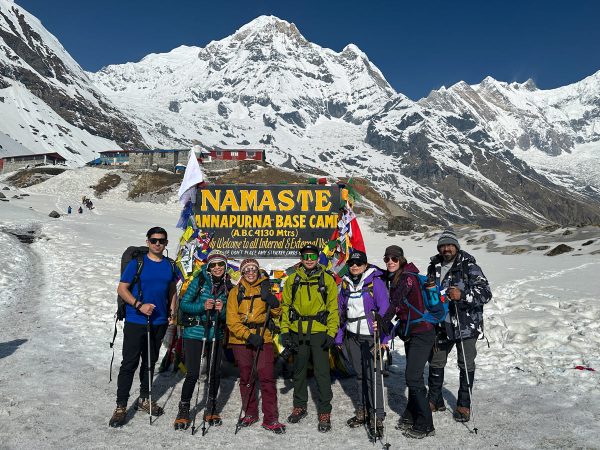
Annapurna Base Camp Trek
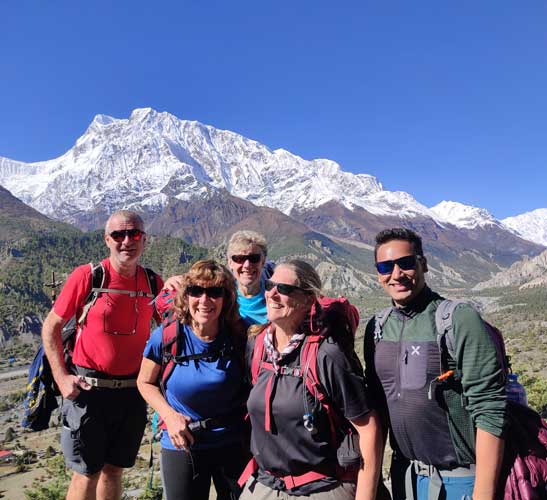
Annapurna Circuit Trek
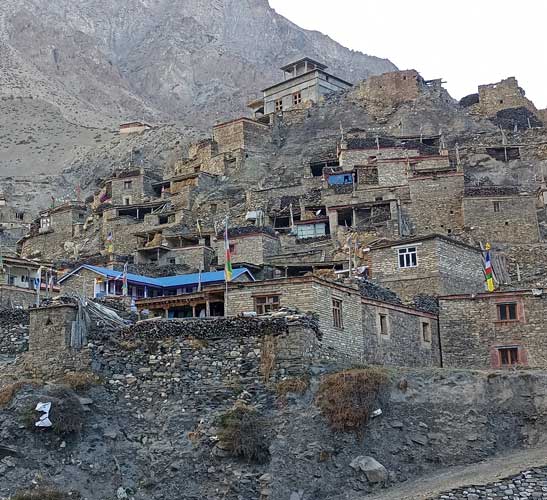
Nar Phu Valley Trek with Annapurna Circuit
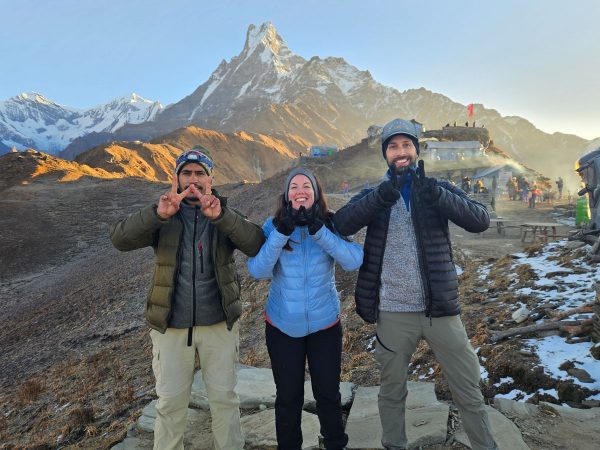
Mardi Himal Trek
Speak to an expert.

- Availability
Make An Inquiry for
- Full Name *
- Nationality * Nationality Afghanistan Albania Algeria American Samoa Andorra Angola Antigua and Barbuda Argentina Armenia Australia Austria Azerbaijan Bahamas Bahrain Bangladesh Barbados Belarus Belgium Belize Benin Bermuda Bhutan Bolivia Bosnia and Herzegovina Botswana Brazil Brunei Bulgaria Burkina Faso Burundi Cambodia Cameroon Canada Cape Verde Cayman Islands Central African Republic Chad Chile China Colombia Comoros Congo, Democratic Republic of the Congo, Republic of the Costa Rica Côte d'Ivoire Croatia Cuba Cyprus Czech Republic Denmark Djibouti Dominica Dominican Republic East Timor Ecuador Egypt El Salvador Equatorial Guinea Eritrea Estonia Ethiopia Faroe Islands Fiji Finland France French Polynesia Gabon Gambia Georgia Germany Ghana Greece Greenland Grenada Guam Guatemala Guinea Guinea-Bissau Guyana Haiti Honduras Hong Kong Hungary Iceland India Indonesia Iran Iraq Ireland Israel Italy Jamaica Japan Jordan Kazakhstan Kenya Kiribati North Korea South Korea Kosovo Kuwait Kyrgyzstan Laos Latvia Lebanon Lesotho Liberia Libya Liechtenstein Lithuania Luxembourg Macedonia Madagascar Malawi Malaysia Maldives Mali Malta Marshall Islands Mauritania Mauritius Mexico Micronesia Moldova Monaco Mongolia Montenegro Morocco Mozambique Myanmar Namibia Nauru Nepal Netherlands New Zealand Nicaragua Niger Nigeria Northern Mariana Islands Norway Oman Pakistan Palau Palestine, State of Panama Papua New Guinea Paraguay Peru Philippines Poland Portugal Puerto Rico Qatar Romania Russia Rwanda Saint Kitts and Nevis Saint Lucia Saint Vincent and the Grenadines Samoa San Marino Sao Tome and Principe Saudi Arabia Senegal Serbia Seychelles Sierra Leone Singapore Sint Maarten Slovakia Slovenia Solomon Islands Somalia South Africa Spain Sri Lanka Sudan Sudan, South Suriname Swaziland Sweden Switzerland Syria Taiwan Tajikistan Tanzania Thailand Togo Tonga Trinidad and Tobago Tunisia Turkey Turkmenistan Tuvalu Uganda Ukraine United Arab Emirates United Kingdom United States Uruguay Uzbekistan Vanuatu Vatican City Venezuela Vietnam Virgin Islands, British Virgin Islands, U.S. Yemen Zambia Zimbabwe
- Phone Number *
- Email Address *
- Prove your humanity : 10 plus two =
- Email This field is for validation purposes and should be left unchanged.

- Name This field is for validation purposes and should be left unchanged.
Trekking in Nepal
Climbing and expedition, cultural tour and sightseeing, cycling and mountain biking, luxury treks, luxury tours, multi country tours, voluntourism trips, extend your trip.
- Everest Panorama Trek – 9 Days
- EBC Trek with Helicopter Return – 12 Days
- Everest Base Camp Trek – 14 Days
- Gokyo Lake Trek – 13 Days
- Gokyo and Renjo La Pass Trek – 14 Days
- Everest Base Camp Trek without Lukla Flight – 17 Days
- Gokyo to Everest Base Camp Trek – 17 Days
- Everest Base Camp with Island Peak – 19 Days
- Everest Three Passes Trek – 20 Days
- Everest High Passes and Island Peak – 23 Days
- Classical Everest Base Camp Trek – 21 Days
- Langtang Valley Trek – 10 Days
- Langtang Valley Ganja La Pass Trek – 14 Days
- Langtang Helambu Trek – 17 Days
- Ghorepani Poon Hill Trek – 9 Days
- Mardi Himal Trek – 10 Days
- Annapurna Base Camp Trek – 13 Days
- Himalayan Highlights – 13 Days
- Nar Phu Valley Trek with Annapurna Circuit – 18 Days
- Annapurna Circuit Trek – 19 Days
- Tilicho Lake Trek With Thorong La Pass – 19 Days
- Khopra Danda Trek – 11 Days
- Shivapuri-Chisapani Trek – 4 Days
- Upper Mustang Trek (Drive & Trek) – 16 Days
- Tsum Valley Trek – 16 Days
- Manaslu Circuit Trek – 15 Days
- Dhaulagiri Circuit Trek – 21 Days
- Upper Dolpo Trek – 25 Days
- Kanchenjunga Base Camp Trek – 29 Days
- Yala Peak Climbing – 13 Days
- Island Peak Climbing – 15 Days
- Mera Peak Climbing – 19 Days
- Everest Base Camp and Lobuche East – 18 Days
- Tent Peak Climbing with Annapurna Base Camp – 18 Days
- Pisang Peak and Thorung La Pass – 21 Days
- Ama Dablam Expedition – 29 Days
- Kathmandu Cultural Heritage Tour – 3 Days
- Kathmandu Heritage – 3 Days
- Inheritances of Kathmandu – 4 Days
- Glimpses of Kathmandu & Nagarkot – 5 Days
- Kathmandu and Pokhara Unveiled – 5 Days
- Explore Kathmandu – 6 Days
- Glimpse of Nepal – 8 Days
- Nepal Heritage Tour – 10 Days
- Nepal Adventure Tour – 11 Days
- Nepal Multi Sports Adventure – 11 Days
- Nepal Vista – 10 Days
- Nepal Highlights – 14 Days
- Experience Nepal – 15 Days
- One Day Biking Trip – Kathmandu – 1 Day
- Annapurna Circuit Biking – 14 Days
- Upper Mustang Biking – 16 Days
- Kathmandu Valley Rim Biking – 8 Days
- Annapurna in Luxury – 9 Days
- VVIP Everest Base Camp Trek – 10 Days
- Everest View Luxury Trek – 11 Days
- Everest Base Camp Luxury Trek – 14 Days
- Everest Base Camp Deluxe Trek – 16 Days
- Mt Everest Base Camp to Gokyo Trek – 19 Days
- Kathmandu Luxury Tour – 3 Days
- Kathmandu and Pokhara Luxury Tour – 5 Days
- Nepal Multi Sport Luxury Adventure – 11 Days
- Best of Nepal – 14 Days
- Trishuli River Rafting – 1 Day
- Everest Base Camp Helicopter Tour – 1 Day
- Everest Base Camp Heli Tour with Gokyo Extension – 1 Day
- Langtang Heli Sightseeing – 1 Day
- Pokhara and Annapurna Heli Sightseeing – 1 Day
- Paragliding in Nepal (Pokhara) – 1 Day
- Scenic Mountain Flight (Everest Flight) – 1 Day
- Ultra Light Flight – 1 Day
- Jamacho Day Hike-One day hiking trip – 1 Day
- Kathmandu Uncovered with Nagarkot – 1 Day
- Day Tour to UNESCO Heritage Sites – 1 Day
- Nepal and Tibet – 15 Days
- Nepal and Bhutan – 15 Days
- India, Nepal and Bhutan – 19 Days
- Nepal, Tibet and Bhutan – 20 Days
- Arupokhari School Volunteer Program – 14 Days
- Rebuild Home Volunteer Program – 9 Days
- Bardiya Jungle Safari – 4 Days
- Chitwan Jungle Safari – 3 Days
Trekking in Bhutan
Festival tours, motorcycling.
- Druk Path Trek – 8 Days
- Chomalhari Trek – 12 Days
- Laya Ghasa Trek – 18 Days
- Bhutan Vistas Tour – 5 Days
- Cultural Heartland Tour – 10 Days
- Hidden Valley – 11 Days
- Bhutan Multi Sports Tour – 11 Days
- Paro Tshechu Festival – 8 Days
- Punakha Tsechu – 9 Days
- Trongsa Lhuntse Tshechu – 9 Days
- Bumthang Tangbi – 11 Days
- Bhutan Ura Yakchoe – 12 Days
- Tamshingphala Choepa – 12 Days
- Mongar and Trashigang – 16 Days
- Bhutan Biking – 8 Days
- Bhutan Motorcycle Tour – 12 Days
Trekking in Tibet
- Tibet Advance Everest Base Camp – 21 Days
- Cho Oyu Expedition – 45 Days
- Shishapangma Expedition – 47 Days
- Everest Expedition via North Side – 63 Days
- Kathmandu and Lhasa Tour – 7 Days
- Tibet Heritage Tour – 8 Days
- Overland Tour to Everest Base Camp – 10 Days
- Mount Kailash Mansarovar Lake Tour – 15 Days
- Everest Base Camp Biking Tour – 21 Days
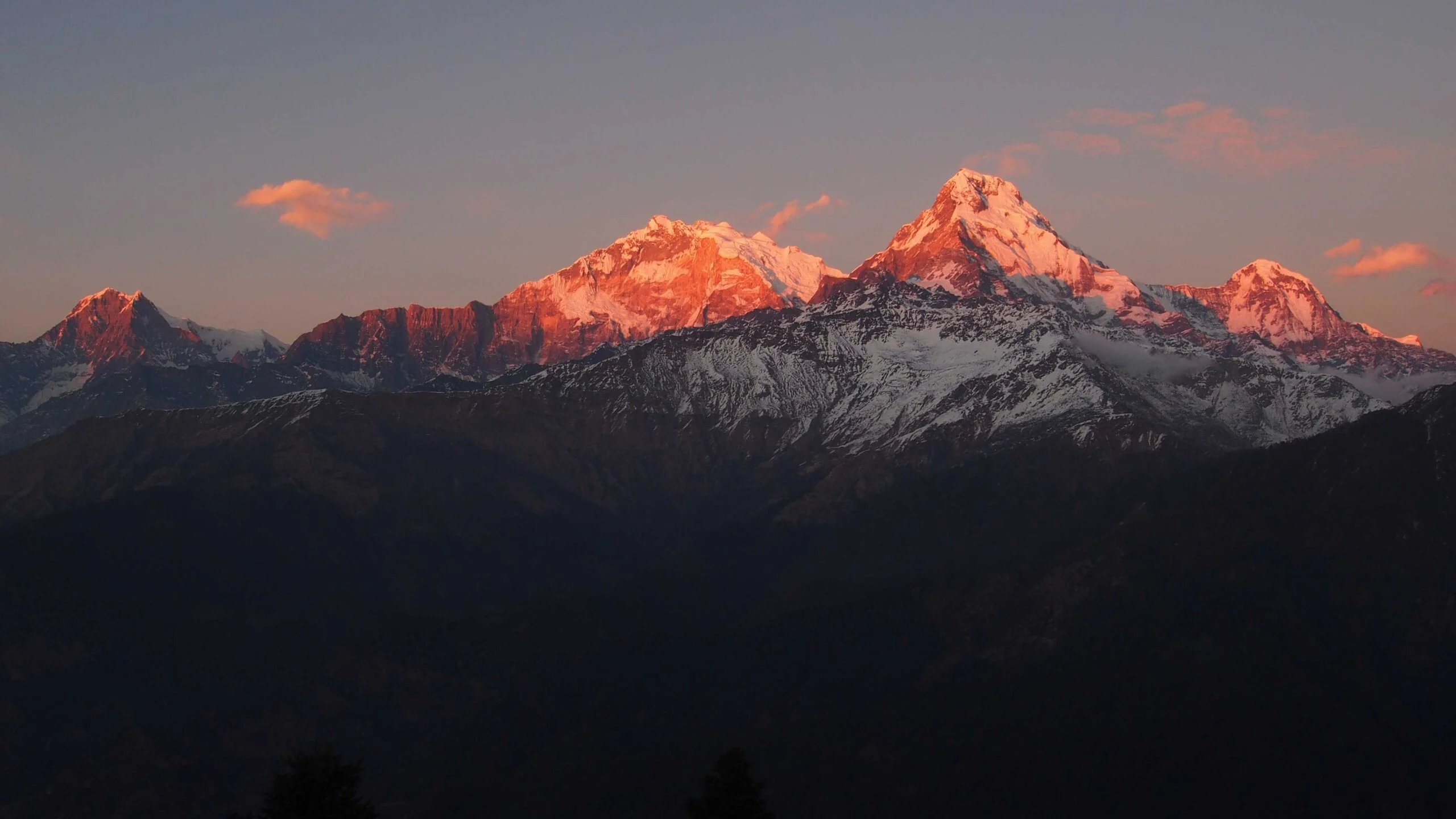
Ghorepani Poon Hill Trek
- Duration 8 days
- Difficulty Easy
Ghorepani Poon Hill Trek is the first choice trekking route for all ages. You spend four straight trekking days in the Annapurna trekking region and bring back a memory for a lifetime.
Poon Hill Trek is a great attraction for nature lovers, adventure seekers, and those who want to see the beautiful views of the Himalayas of Nepal. This trekking trail takes you through the dense forest with stunning views of mountains and other landscapes.
It also takes you through some of the most remote villages in the region with their unique Nepali cultural heritage.
Start and End of Ghorepani Poon Hill Trek
The Sunrise trek or the Annapurna Sunrise Trek is Nepal’s classic trekking route in the Annapurna trekking region.
The trekking to Ghorepani starts from Pokhara, but the hike starts from Nayapul to Tikhedhunga until you reach Ghorepani. On the way, you cross suspension bridges over Bhurung Khola and pass through quaint villages of Ulleri and Ghorepani.
The sunrise from the Poon Hill viewpoint is breathtaking, witnessing the sun touching the snow-capped Himalayas. In addition, you can enjoy Annapurna’s panoramic views, including Dhaulagiri, Hiunchuli, Machhapuchare, Nilgiri, Manaslu, Ganesh Himal, Annapurna South, and Lamjung Himal.
Ghorepani Poon Hill treks end at Pokhara. On the return path from Poon Hill, we follow the trail that traverses through the dense forest of Deurali to Tadapani, further descending to the beautiful village of Ghandruk.
What to expect during Ghorepani Poon Hill Trek?
Walking through the Annapurna Sanctuary en route to Ghorepani Poon Hill, you walk through the lush green Rhododendron forests and witness the diversity of flora and fauna nature offers. The trails are well maintained and marked by local guides.
Ghorepani Poon Hill trek is available throughout the year. Nevertheless, trekking during the Monsoon season (July to August) might result in disappointment. Nevertheless, if you want to reach the place during the rainy season, pack your bags with a rain poncho or rain jacket.
To enjoy the beautiful lush forests covered in Rhododendron, trekking in the spring season (March to April). Spring is the peak season, too, and you see a lot of trekkers en route.
Not to worry, though. There are plenty of tea houses and guesthouses on the way. You can enjoy hot drinks or cold drinks during the stopover according to your preference. Make sure you carry a water bottle to hydrate yourself. Furthermore, you can expect flush toilets at tea houses.
Things to carry Ghorepani Poon Hill Trek
Aforementioned, the trek is relatively easy, so no special pieces of equipment are required. However, to capture the magnificent views of the sunrise, a camera is recommended. With the breathtaking views of the Himalayas and walking through the Annapurna Sanctuary toasting the beauty of nature, you would want to keep the memories alive for the future.
In addition to regular trekking gear such as a good pair of hiking boots or hiking poles, don’t forget your trekking Permits daily medicines you need.
- Airport Pickup and Drop
- Accommodation of two nights in Kathmandu
- Accommodation of two nights in Pokhara
- Tourist Bus between Pokhara and Kathmandu
- Private, round-trip land transportation between Pokhara and Trekking start Point
- Tea house accommodation and three meals a day while trekking
- English-speaking guide
- Porter service 2:1
- All necessary paperwork & trekking permits TIMS card
- Government taxes
- First aid kit
- Mountain Routes T-shirt
- Items of personal consumption (coke, alcoholic beverages, laundry, etc.)
- Travel Insurance
- Medical evacuation in case of emergency
- Personal gears & clothing (available on hire)
- Personal expenses: phone calls, laundry, hot shower, drinks, tips etc.
- Lunch & Dinner in Kathmandu
- Lunch & Dinner in Pokhara
Ghorepani Poon Hill Trekking Itinerary Map
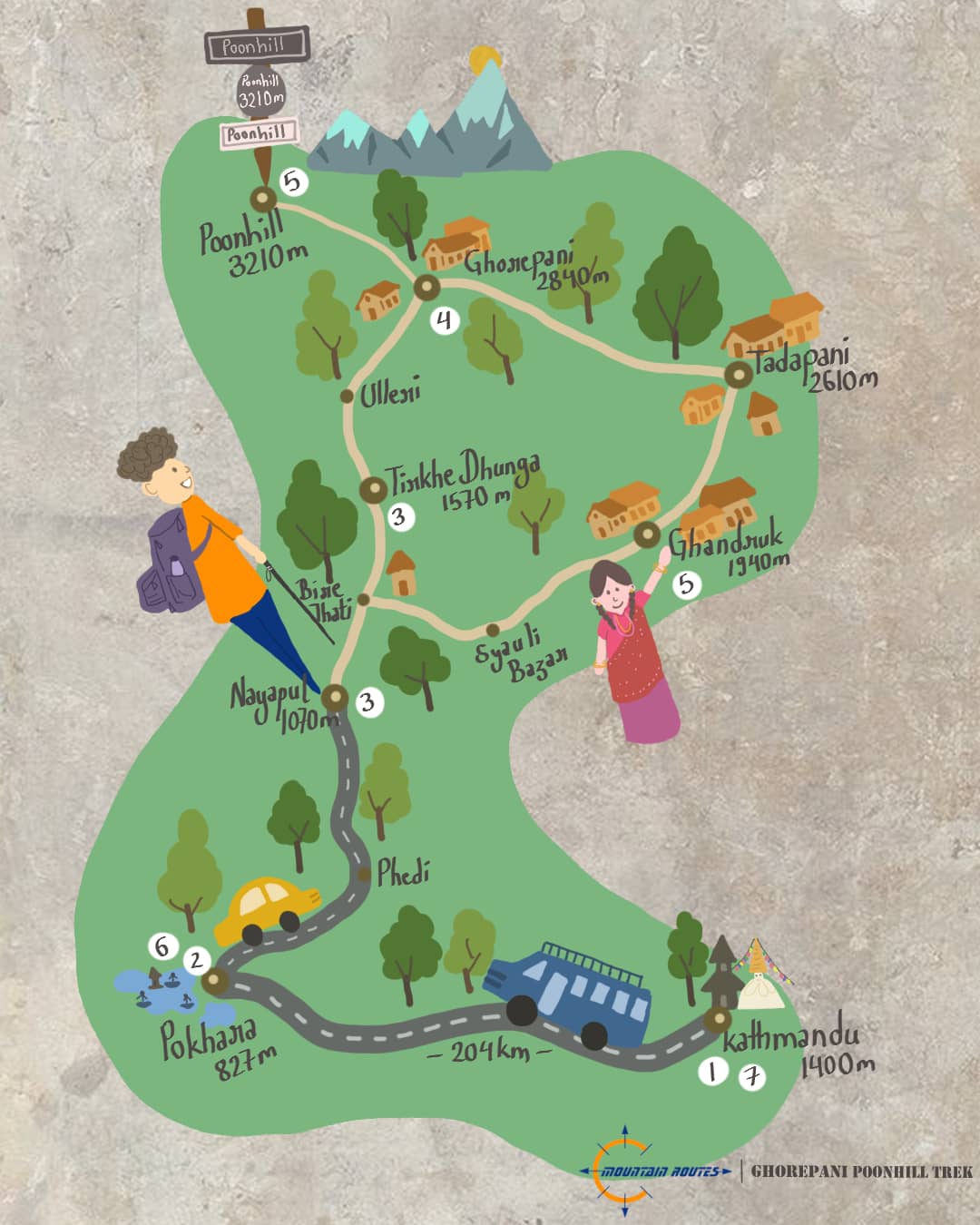
Arrival at Kathmandu(1350 m/4430 ft)
Kathmandu to Pokhara (827 m/2713 ft) Distance: 210 km / 130 miles Time: 06:30 Hrs Drive
Pokhara to Nayapul to Tikhedhunga (1570 m/5150 ft) Distance: 9.2 km / 5.7 miles Time: 01:30 Hrs Drive / 04:30 Hrs walk
Tikhedhunga to Ghorepani (2840 m/9317 ft) Distance: 12.9 Km / 8 miles Time: 06:00 Hrs walk
Ghorepani to Poon Hill viewpoint (3210 m/10532 ft) to Ghandruk (1940 m/6365 ft ) Distance: 19 Km / 12 miles Time: 07:30 Hrs walk
Ghandruk to Nayapul to Pokhara (827 m/2713 ft) Distance: 8.6 km / 5.3 miles Time: 03 Hrs Walk / 1:30 Hrs Drive
Pokhara to Kathmandu (1350m / 4430ft) Distance: 210 km / 130 miles Time: 06:30 Hrs Drive
Depart Kathmandu

Detailed Itinerary
Day 1 : arriving in kathmandu (1350 m/4430 ft).
On the first day of our Annapurna region trekking, you will arrive at the capital city of Nepal – Kathmandu. Our representatives will pick you up from the airport and take you to your hotel. They will explain the route and schedule along the way. You can have lunch upon reaching, and then go out to explore the beautiful city of Kathmandu.
Day 2 : Kathmandu to Pokhara (827 m/2713 ft) trip Trip Duration: 6-7 hours
On the second day of the trip, we will be traveling from Kathmandu to the city of Lakes – Pokhara. We will be traveling by jeep, and it will take us about 6 to 7 hours. There are a lot of places to explore in Pokhara. So, upon arriving in Pokhara, we will head straight out to avoid missing any key attraction points. We will then explore the amazing nightlife of Lakeside and then head back to our hotels to rest for the day.
Day 3 : Pokhara to Ulleri via Nayapul Trip Duration: 6-7 hours
Our third day of trekking in the Annapurna region of Nepal begins with traveling from Pokhara to Nayapul. We will travel by jeep, and it will take us about 1:30 hours. Upon reaching Nayapul, we will begin our hike to Ulleri. From Nayapul, our trail leads us to Birethati, a junction point for Annapurna sanctuary and our trek route. I
t is a motorable offroad trail. We will then walk 4 hours further, following the banks of Bhurung Khola to reach Tikhedhunga and have lunch.The trail will first cross the stream of Bhurung Khola, then lead us to a Magar Village called Ulleri.The trail from Tikhedhunga to Ulleri is steep uphill which is one of the hurdle of this trek.(aprox 3500 stairs ).we will stay overnight at ulleri.
Day 4 : Ulleri to Ghorepani (2840 m/9317 ft)Trip Trip Duration: 6 hours
4th day of our Annapurna region trek begins with an early breakfast at Ulleri and then heading out to reach Ghorepani. On our way, we will walk through rhododendron jungle and beautiful waterfalls. Upon further walking along the trail, we will traverse pastures and cultivated fields, Rhododendron, and oak forests, reaching Nangethati. We will have our lunch there. After having lunch there, we will head to Ghorepani, which will only take about 2 hours pleasant walk. We will stay the night at Ghorepani.
Day 5 : Ghorepani to Poon Hill viewpoint (3210 m/10532 ft) to Tadapani )Trip Trip Duration: 7-8 hours
Today is one of the best parts of the trek, where we will be heading out early to Poon Hill for an early sunrise view. It will take us about 40 minutes to reach Poon Hill. We will have a stunning panoramic view of mount Dhaulagiri, Annapurna range, Nilgiri range, Machhapuchhare, and other peaks. As the sun’s rays slowly kiss the tips of the mountains, we will slowly run out of words to describe the moment. After viewing the sunrise, we will follow the trail, which traverses through the dense forest of Deurali and then descends to Tadapani and stay overnight
Day 6 : Tadapani to Ghandruk to Nayapul to Pokhara (827 m/2713 ft)Trip Trip Duration: 3 hours walk + 1.5 hour Drive
On the 6th day of our Annapurna region trekking, after having breakfast at Tadapani, we will admire the place one more time and then head out to reach out to Ghandruk. It is a straightforward climb down, which will only take us about 3 hours. Upon reaching Ghandruk, we will have our lunch there and rest. Then, we will have short 30min walk to old Gurung village of ghandruk , We will then catch jeep to Nayapul from the ghandruk bus station . Finally, we will have dinner at Lakeside, Pokhara. We can also enjoy the beautiful Lakeside during the nighttime. A good night’s sleep is all you need for the day.
Day 7 : Pokhara to Kathmandu (1350 m/4430 ft) trip Trip Duration: 6-7 hours
We will start the day at Pokhara with breakfast and then take a jeep to return to the capital. It takes us about 6-7 hours. We can travel via plane, saving us time and only about 35 minutes. Upon reaching Kathmandu, we will explore the city around a bit. We can also do some shopping, and at night, we can enjoy Thamel’s beautiful nightlife.
Day 8 : Departure
On the last day of our Annapurna region trek, you will be heading home. Our representatives will pick you up from your hotel and drop you at the airport. We will share goodbyes, and you will be going back home with unforgettable and beautiful memories of the trek.
Ghorepani Poon Hill Trekking: Frequently Asked Questions
Where is poon hill situated.
Poonhill is situated in Northern Central Nepal in the Annapurna Trekking Region which lies in the Annapurna Conservation Area Project.
How fit do I need to be for Poon Hill Trekking?
Poonhill Trekking is considered one of the easy trekking trails in the Annapurna region. Anyone with an average level of fitness can complete this trek. Trekking to Ghorepani Poonhill is usually 6-7 hours per day.
How to reach PoonHill?
The most popular and regularly followed route is Nayapul- Tikhedhunga- Ghorepani. However, there are two other options as well. One is Ghandruk- Tadapani- Ghorepani route and another is Tatopani- Shikha- Ghorepani.
I have seen variable days options for the Poon Hill trek, but what minimum days are required for the Poonhill trek?
Since there are few alternative trekking routes for Poonhill Trek, the days depend on which route you prefer. But the minimum number of days to do this trek is three days.
Do you provide a guide and porter, or will both be in a group?
You get a porter to carry the baggage of 2 trekkers and one guide.
Is there any chance of High Altitude Sickness?
Since Poonhill trekking is the low altitude trekking of 2855m height, there is no chance or minimum chance of high altitude sickness depending on the individual.
What is the weather like in Poon Hill?
The weather in Poonhill is quite windy. HavingTherefore, carrying a wind stopper will help minimize the cold.
Is Poonhill trek safe for minors?
Poonhill trekking is the best for family trekking. You spend 4-5 hours hiking daily, which means even children can trek. However, we suggest that parents guide the minors throughout the trek.
What kinds of accommodation are available on the Poonhill trek?
You can expect a clean private room that has Wi-Fi attached bathroom with hot shower facilities.
Do you have a group joining Trip to Ghorepani Poonhill Trek?
There are multiple departure dates for trekking that may be suitable for you. You can also request your departure date if our date does not match your schedule.
What will be the transportation be like for this trek?
We travel by tourist bus from Kathmandu to Pokhara and vice versa. But from Pokhara to the trekking start point, we travel in a private vehicle. So we can also arrange fight/private transportation at an extra cost.
Do you provide trekking equipment for this trek?
No, we don’t provide trekking equipment for this trek. However, you can hire or purchase the equipment from the market in Thamel.
What kind of meals do we expect during this trekking?
You can expect continental menus and soups and dishes of rice and noodles. You can also have soft drinks and beers at your own cost in the tea houses.
Is it safe to drink tap water during the trek?
Although tap water is safe to drink, we recommend to use purification tablet or liquid. Nevertheless, bottled water is better. You can buy bottled water in tea houses which may be expensive, but they’re worth it.
Your Message
Why Mountain Routes ?
- Local Support
- Instant Response
- Customized Packages
- Friendly and Professional Guides
Not satisfied with what we offer ? We can customize the trip for you.
Request Custom Trip
SIGN UP FOR EMAIL
Be the first to know about new offers & other very nice things.
Approved by
- Cultural Activities
- Expedition / Climbing
- Jungle Safari
- Heli Tour / Mountain Flight
- Local Experience
- Multiple City Tour
- Responsible Tourism
- Adventure Sports
- Sightseeing
- Walking / Hiking
Trekking Regions
- Dolpo Region
- Everest Region
- Manaslu Region
- Langtang Region
- Mustang Region
- Annapurna Region
- Kanchenjunga Region
Travel Guide
- Guide to Manaslu Trek
- Guide to Mardi Himal Trek
- Guide to Narphu Valley Trek
- Guide to Langtang Valley Trek
- Guide to Annapurna Circuit Trek
Trekking Maps
- Annapurna Base Camp Trek Map
- Annapurna Circuit Trek Map
- Khopra Danda Trek
- Mardi Himal Trek Map
- Nar Phu Valley Trek Map
- Ghorepani Poon Hill Trek Map
- EBC and Gokyo Trek Map
- Everest Base Camp Trek Map
- Everest Cho La Pass Trek Map
- Everest Panorama View Trek Map
- Everest Three High Pass Trek Map
- Classic Everest Base Camp Trek Map
© 2020-2024 Mountain Routes
- Privacy Policy
- Data Policy
- Refund Policy
Powered by : itsadim
Insert/edit link
Enter the destination URL
Or link to existing content
- Annapurna Region Trek
- Everest Region Trek
- Langtang Region Trek
- Manaslu Region Trek
- Kanchenjunga Trekking
- Dolpo Region
- Mustang Trekking
- Départ fixe

Full Name Email Address Phone Number Departure date Number of Person
Ghorepani Poon Hill Trek
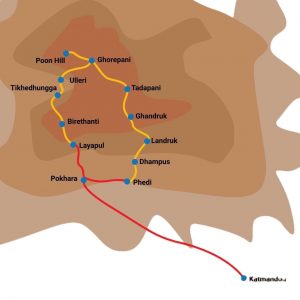
Day 01: Arrive in Kathmandu Airport transfer to Hotel. Day 02: Kathmandu – Pokhara Tourist bus (7h, hotel) Day 03: Pokhara to Nayapul and trekto Ullari (1900m (5h walk ,1 taxi) Day 04: Ullari to Ghorepani (6h walk 2780m) Day 05: Early morning climbing Pon Hill(3210m sunrise) trek to Ghandruk 6hwalk Day 06:Ghandruk to pokhara (5h walk nayapull 1h taxi pokhara) DAY 07: Drive Pokhara to Kathmandu. 6h, TouristKathmandu hotel DAY 08: Depart Kathmandu Airport (3 h before)
- Departure From Kathmandu
- Departure Time 06:00AM
- Return Time Approximately 8:30 PM
- Included All needed transportation By Bus.Hotel pick up / drop by taxi Mountain Food (Breakfas t / lunch / Dinner) Tea, coffee During a Trek Mountain Accommodation (Tea Houses) Excellent Guide (Food, Salary, Insurance, Equipment, Two person 1 Strong Porter , Kathmandu Sightseeing with car Government License Holder). All needed Mountain Trekking Permit TIMS
- Not Included Beer, cola, mineral water, hot water, Wi-Fi, battery charges, hot shower etc Kathmandu Sightseeing entrance fee. Your Travel insurance,Tips for Guide and porter
My experience Khopra Danda & Ghorapani Poon Hill trek with Nepal Aventure was fantastic from start to finish. I ask a lot of questions and Rabin was there to answer all of them! Himal was my group’s guide and was an absolute pleasure to hang out with the entire time. He is ridiculously knowledgeable about the surrounding areas and just a really nice person in general. Definitely request him for your trek! Khopra Danda Trek,,Ghorapani Poon Hill trek is beautiful and the scenery is breathtaking. From A-Z provided an incredible experience for our group. Overall, they did a wonderful job and we felt taken care of the whole time. Thank you
We had a great experience on the Poon Hill trek. Our guide, Himlal & Nikesh was fantastic, he really made the whole trip memorable and easy with his encouragement and experience. Poon Hill is a good 3 days Poon hill trek is the best option if you have short time only 3 /4days for the Ghorepani Poon Hill trek. The trek starts from Pokhara Ulleri (1960m with jeep and ends Ghandruk back with bus or jeep at Pokhara. Stunning mountains view, amazing hospitality, friendly peoples in my life good experience. Thank you for Nepal Aventure Pvt (Himlal Trek) https://himlaltrek.com/ or http://www.nepalaventure.com/
We just finnished our (3 night 4 day ) Ghorapani poon Hill trek , we paid $300 per parson. Amazing!!! We had a fantastic guide (Nikesh) who was really friendly and we could decide our own pace witch made the trek a lot easier! I want to thank very much for (Nepal Aventure) Himal he had English side also https://himlaltrek.com/ best of lock for every one trekking in nepal
Georges Himlal bonjour de France à toi et à ta famille , ici le temps est sec et froid le printemps n’est pas encore arrivé. Le temps que nous avons passé ensemble a été extraordinaire , encore merci pour tout , ta gentillesse ,ton enthousiasme et ton sérieux . Bonjour himlal le Balcon des Annapurnas :le coin pour voir la chaîne des Anapurna au lever du soleil.poon hill est un un magnifique point de vu. a condition que le brouillard ne s’invite pas ça a été mon cas. mais il vous en coûtera 45 min de marche pour y aller. la bas vous pourrez vous restaurer et boire qq chose chaud. http://www.nepalaventure.com/le-balcon-des-annapurnas/ à bientôt Polo et Syvia ,Georges Alexandre
Bonjour himlal nous sommes très heureux d’avoir de tes nouvelles. oleg et moi pensons et parlons souvent de toi et des merveilleux moments passés avec toi. merci encore Ghorapani Poon Hill Trek .J’ai eu la chance de voir le lever de soleil sans trop de monde autour de moi. La montée est rude mais vaut la peine ! http://www.nepalaventure.com/ Amitiés oleg et nicolas
J’ai effectué un trek en mars 2020 dans le balcon de l’Annapurna au Népal en compagnie d’Himlal, guide francophone. Je tiens à le remercier chaleureusement car j’ai vraiment apprécié sa compagnie, il parle bien français, il est toujours de bonne humeur et très souriant et il connaît très bien les montagnes népalaises et les parcours qui sont magnifiques ! Il pourra vous guider sur votre choix de trek et tout gérer lors de celui-ci, logements, nourriture, itinéraire, permis etc… Je vous recommande vivement d’effectuer un trek avec lui vous ne serez pas déçu !
Himlal – Fondateur de l’Agenc Népal Aventure Pvt. Ltd Gongabu ,Baniyatar, Suryadarshan Height, Kathmandu.House No :562 Contactez WhatsApp +9779841939224 Téléphone Portable : +977-9841939224
Balcon des Annapurnas Bonjour à tous, Je tiens à partager avec vous une expérience innoubliable vécue au Népal ! date d’expression 7 février 2024
Le balcon des Annapurnas Profitez de magnifiques panoramas sur les massifs des Annapurna lors d’un trekking à l’itinéraire soigné Christine
Write A Review Cancel reply
You must be logged in to post a comment.
Similar Tours
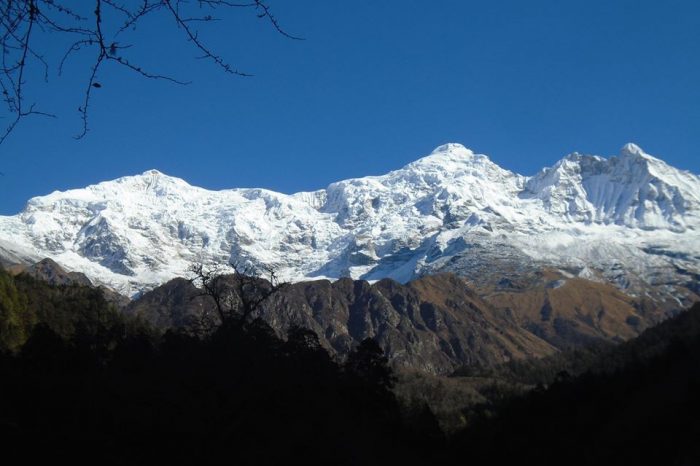
Tsum Valley Manaslu Trek
Manaslu Region
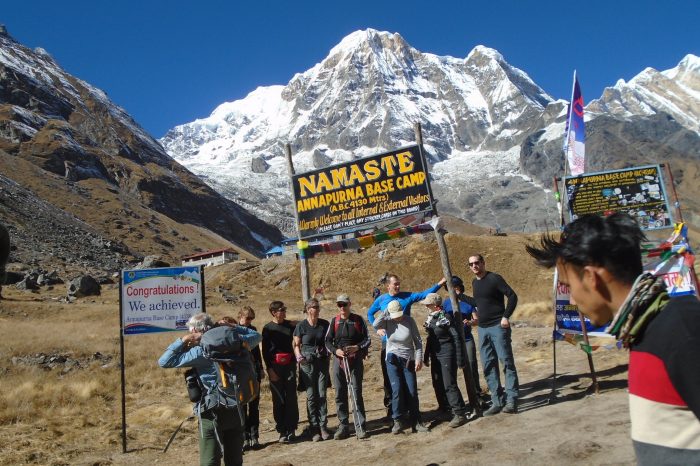
Annapurna Base Camp Trek
Annapurna Hiking, Nepal
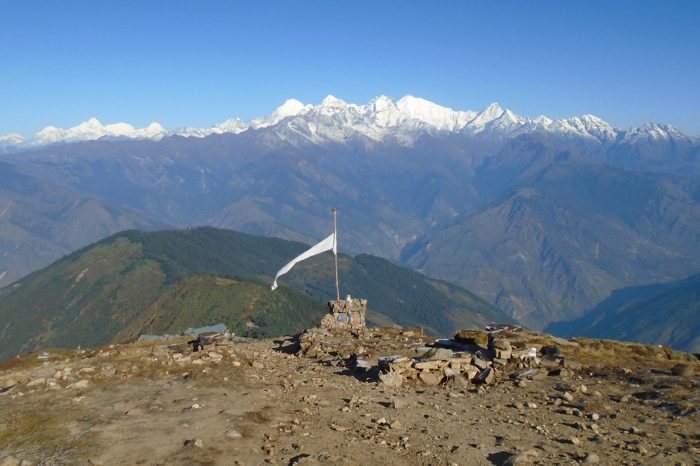
Langtang Helambu Trek
Langtang Region, Short Trek
About Company
Travel guides.
- About Nepal
- Nepal Visa Information
- Trekking Equipments
- Weather and Climate
- Customes & Culture
Recommended on

Affiliated To

Official Contact
Tokha-3, Gongabu, Kathmandu.
+977 98419 39224 [WhatApp]
SUN - SAT: 24 Hours
- Chitwan Tour

IMAGES
COMMENTS
Poon Hill Trek 2024 and 2025 dates are from Pokhara to Pokhara. We can also make the trek itinerary seven days from arrival to departure. The 7-day Trek includes meeting you in Kathmandu, staying at a hotel, and transferring to Pokhara. Our four days Poon Hill trek is from Pokhara to Pokhara. Poon hill trek Guide
CAMINO DE SANTIAGO; Poon Hill trek - a 2023 guide & itinerary. ... A meal on the Poon Hill trek costs between NPR 400/US$3 and NPR 600/US$5 per person depending on what you order. Meat dishes are more expensive. Vegetables and eggs are cheaper. A cup of tea is about 100/US$1. A pot of hot water (1l) - NPR 150/US$1.
POON HILL WEATHER: WHEN TO DO THE POON HILL TREK. The peak trekking season for Poon Hill is between September - November and then March - May. It's still possible to hike in December and January, but be mindful that winter conditions will make for an icy adventure (temperatures can drop below -15c during peak season!), while May is the start of the monsoon season and signals an increase in ...
As Poon Hill Trek is a short trek, the value of the entire trek is relatively cheaper than other commercial treks in Nepal. On average, a 5-day trip to Poon Hill prices about US$ 200-400, including accommodation, meals, and transportation. Accommodation in Poon Hill Trek is comparatively cheap, ranging from US$ 2 to 3 on a sharing basis ...
Day 4: Ghorepani - Poonhill - Tadapani. 13 kilometers, 7 hours. The third day of the Poon hill trek itinerary is all about the sunset on Poon Hill. This means an early wake up around 3:30 AM. Even in the dark, the trail is easy to follow as there will be lots of other hikers.
The Poon Hill Trek is an unforgettable 4-day journey through the Himalayas. You'll see views of the majestic mountains as soon as you leave Pokhara and head to the starting town of Nayapul. Along the way, you'll walk along flat, paved roads, rocky terrain, about 3000 stone steps (yes, 3000), and through lush forests and fields of rhododendrons.
Poon Hill Hike Overview. Here's a bit of a background information on how to trek to Poon Hill. Days Required: 5 to 6 days Altitude: 3210 metres (Highest point) Best Time To Trek: October to May Costs: Depending on whether you choose to use a guide and porters to going alone, the prices will vary drastically. Guide and porters: there is no set price where ever you go so negotiations are ...
The Poon Hill Trek is one of the most popular treks in Nepal due to its short time frame. A common misconception is that it's an easy trek, however, the Poon Hill trek is surprisingly difficult. Poon Hill is a small hilltop located above the popular village of Ghorepani inside of the Annapurna Conservation Area. It's located at 3,200 m ...
What to Expect of the Ghorepani Poon Hill Trek. The Ghorepani Poon Hill trek, one of the most popular and easiest treks in the Annapurna region, is suitable for every age, requires only a moderate level of fitness to complete, and the max elevation is 3,210 meters (the risk of altitude sickness is minimum), the distance is around 51 km (32 mi), and it can be done all year round.
Poon Hill Trek is a popular trek in Nepal that takes you through beautiful rhododendron forests, terraced fields, traditional villages, and offers panoramic views of the Himalayan mountain range, including Annapurna and Dhaulagiri peaks. The trek is typically completed in 4-7 days, Depending on starting and ending in points.
Poon Hill is 3,210m above sea level and marks the highest point on the trek. From the top, you will experience that view, all 360 degrees of it! Mountains stretch as far as the eye can see - 30 of the devils. The tallest are Annapurna (26 545 feet), Annapurna South (23,684 feet), Dhaulagiri (26,795 feet), Hiunchuli (21 132 feet), Lamjung ...
Breakfast. Ghorepani ( 2,840m/9,317ft) | 3-4 hours from Banthati. Dinner and Overnight Stay. Day 6 : Ghorepani - Poon Hill - Tadapani 14km | 6-7 hours | Breakfast, Lunch and Dinner |Max Elevation: 2,700m/8,860ft:: One of the most beautiful days in the entire trekking expedition is in store for the trekkers.
Blogs. Poon Hill Trek: The Ultimate Hike to a Million Dollar View. You don't have to climb a big mountain to have the best view across the Himalayas. The foothills of the Annapurna Range offer some of the best mountain scenery you will ever see. The most famous of them all is the climb up Poon Hill, a 3210 meters high "hill" with a ...
Outline Itinerary of the Ghorepani Poon Hill Trek. KTM) Arrival in Kathmandu city, transfer to your hotel. PKR) Flight or drive to Pokhara city, transfer to the hotel. Day 01) Drive to Hile (2 hours), trek to Banthanti (2,210 m) (3/4 hours) Day 02) Trek to Ghorepani (2,874 m) (3/4 hours)
The Poon Hill Trek is one of the most popular trekking routes in Nepal, and offers beautiful views of the Himalayas and a chance to experience the culture and traditions of the local Gurung people. We highly recommend the trek with all its highlights in our "Best of Annapurna" program.Located in the Annapurna region, the Poon Hill Trek takes you through picturesque landscapes and traditional ...
Day 1: Kathmandu to Pokhara to Nayapul and Trek to Ulleri. Maximum Altitude: 1,960 meters, Ulleri. Trek Hours: 5-6 hrs. Our Poon Hill trek starts with a short flight (30 minutes) from Kathmandu to Pokhara. Poon Hill trek-5 days starts from Pokhara. The journey will start driving all the way from Pokhara to Nayapul.
2. Trek from Ulleri to Ghorepani. Day 02, Apr 09: Trek to Ghorepani (2860m), approx 4-5 hours, Approx distance: 8 KM, overnight at Fishtail Guess House. The following day, we continue the Ghorepani Poon Hill Trek on a long hike towards Ghorepani. After having breakfast, we began our trek with full stomachs. The trail we walked on was a gentle ...
Among all the treks in Nepal Poon Hill is considered one of the low-altitude treks which has a maximum altitude of 3210m/10,531.5 feet. The altitude of Poon Hill will be high compared to Ghorepani but the number of hours that you are going to spend on the top of Poon Hill will be less as the main purpose of going that high will be just to enjoy ...
Our Poon Hill trek covers over 3,000m/ 10,000 feet of ascent and descent during the journey to Poon Hill. On some days you will be hiking 10+km/ 6.2 miles on uneven terrain up and down hills. All of this will be done in at high altitude between 2,000m/ 6,561 feet and 3,200m/ 10,531 feet.
Drive to Birethanti (1,039 m) - 2 to 4 hours and Trek to Ulleri (2,020 m) - 4 to 5 hours. Overnight at a guesthouse. Day 04 : Trek to Ghorepani (2,810 m) from Ulleri - 5 to 6 hours. Overnight at a guesthouse. Day 05 : Early morning hike up to Poon Hill (3,210 m) & back, and then Trek to Tadapani (2,610 m) - 6 to 7 hours.
What to expect during Ghorepani Poon Hill Trek? Walking through the Annapurna Sanctuary en route to Ghorepani Poon Hill, you walk through the lush green Rhododendron forests and witness the diversity of flora and fauna nature offers. The trails are well maintained and marked by local guides. Ghorepani Poon Hill trek is available throughout the ...
Poon Hill is a good 3 days Poon hill trek is the best option if you have short time only 3 /4days for the Ghorepani Poon Hill trek. The trek starts from Pokhara Ulleri (1960m with jeep and ends Ghandruk back with bus or jeep at Pokhara. Stunning mountains view, amazing hospitality, friendly peoples in my life good experience.